 Leading Blog | Posts by Category |
 Leading Blog | Posts by Category |
12.16.24

The Wisdom of Charles Handy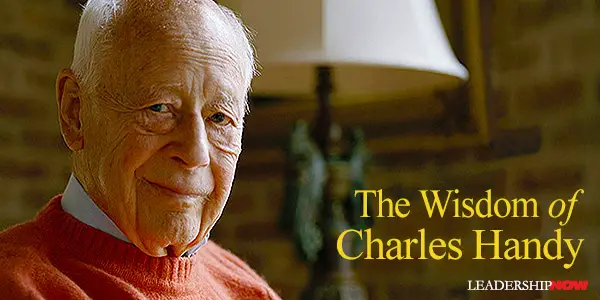
SOCIAL philosopher Charles Handy died at 92 on December 13, 2024. He specialized in organizational behavior and management. From his books, The Hungry Spirit, The Age of Unreason, and 21 Letters on Life and Its Challenges are a selection of his wisdom.
Posted by Michael McKinney at 08:39 AM
11.04.24

The Secret Ingredients to Successful Leadership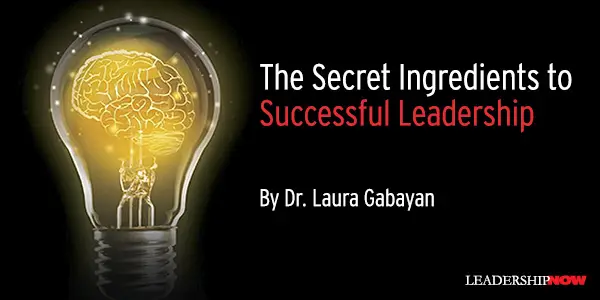
EFFECTIVE leadership is an art. Leadership requires keeping several balls in the air at once. Alongside managing the technical aspects of running their company, leaders also have a responsibility for the well-being of those with whom they interact. To be effective, they must not only earn the respect of their employees and communicate skillfully but also inspire team members to do their job effectively. In an attempt to narrow down which skills are required for being a successful leader, I uncovered eight secret ingredients. Drawing from my background as a physician and scientist, I designed The Wisdom Research Project, which involved interviews with 60 wise adults to find common denominators in their approach toward life. After scientifically analyzing our compiled data, we determined eight qualities that are common to wise people and successful leadership. They involve: 1. Resilience: This is the ability to endure difficulties and “bounce back.” For a leader, resilience is especially important as it involves being flexible, resourceful, and diligent. A resilient leader is able to turn an obstacle into a learning opportunity that will further their knowledge and enable them to thrive. Giving up isn’t an option as it would mean forsaking the company and their career. 2. Kindness: Being friendly, generous, and considerate are all traits associated with kindness and are valued across all societies and organizations. Kind leaders are more effective in inspiring and motivating their employees. Being empathetic is another form of kindness as it involves concern for others’ values, feelings, and priorities. Being kind is professional as it comes from confidence, calmness, and sound judgment. All leaders, at one time or another, must make some tough calls, but incorporating kindness in communicating unpopular decisions helps leaders preserve the respect they’ve earned while taking some of the sting out of their decisions for those involved. Employees want to be part of a company headed by a kind leader as they feel “seen.” As Mark Twain said, “Kindness is the language that the deaf can hear and the blind can see.” 3. Positivity: Being positive in life comes from maintaining an optimistic perspective. Knowing that all the eight elements of wisdom are interrelated, positivity plays into resilience by allowing a leader to approach and view every situation as a learning opportunity. A positive leader looks for opportunities to gain knowledge, and hence become a better leader. Positivity benefits both the leader and company. Leaders who are positive create an air of enthusiasm, openness, and high morale among employees. Workers feel privileged to be there. They’re excited to be part of a team. 4. Spirituality: The idea of spirituality and successful leadership seem to be at odds, but they are intrinsically interconnected. A belief that there’s something greater than oneself, even though it can’t be explained or seen, empowers leaders to govern from a place of purpose, which in turn inspires and motivates employees. Leaders who embrace spirituality influence the team to work from the heart. As a result, team members understand that their purpose transcends material goods and material compensation. They follow the example of their leader’s belief in the mission of the company and are willing to go to great lengths to ensure its success. 5. Humility: As author C.S. Lewis explained in reference to humility: “It’s not thinking less of yourself, but thinking of yourself less.” Humility has been recognized throughout time as an important virtue. Having humility is especially important for effective leadership. A writer for The Economist once stated, “If leadership has a secret sauce, it may well be humility. A humble boss understands there are things he doesn’t know. He listens.” The willingness of such leaders to listen to employees’ ideas magnifies their success as they realize employees often have a better perception of consumers’ needs and priorities. 6. Tolerance: Respecting the beliefs and practices of those around us that differ from our own is a hallmark of tolerance. It involves approaching difference through an unbiased and open-minded lens. A tolerant leader seeks feedback, invites diverse opinions, and is genuinely interested in other perspectives. In this way, they are able to learn from others. Tolerant leaders lack ego, while at the same time conveying confidence. They believe the company’s success is more important than appearing to have all the answers. 7. Creativity: A creative leader looks at scenarios from a different or new perspective. This ability is an important attribute of effective leadership. Leaders who are creative are better able to problem-solve and lead their company on a path of greatness. Such leaders have vision and a sense of innovation. They imagine and think without bias, boundaries, or judgment, which leads them to finding innovative solutions. 8. Curiosity: Curiosity is the foundation of all the elements of wisdom and is essential to effective leadership. At its core is a desire to learn and to pursue new ideas. Curiosity is the component that enables a company to move forward and grow. It invites questions, the pursuit of solutions, and reliance on diverse perspectives — all leading to innovation and success. While the eight elements intrinsic to wisdom make up the secret ingredients to successful leadership, they take time and intention to effectively implement. Keep in mind that incorporating these elements is a continuous undertaking. Be patient. Know that having an awareness of their importance in leadership is the first step.  
Posted by Michael McKinney at 10:35 AM
09.25.24

10 Habits of a Peacemaker
LAW professor Steven Collis is no stranger to polarized arguments. He specializes in the First Amendment. But he has found a way to have constructive discussions without them devolving into shouting matches or accusations. In Habits of a Peacemaker, he provides practical habits and skills to talk about hard topics in a productive way. These habits are more than tactics. They are a way to approach life and see other people. HABIT ONE: Intellectual Humility and Reframing Collis begins where all relationship (leadership) discussions should begin—humility. He states, “Most of us need to recognize that, most of the time, we don’t know what we’re talking about. That may seem offensive, but the sooner we recognize it, the sooner we can open our minds to open our minds to peacemaking and close the door on the kind of contentious behavior that damages relationships.” This is the foundation of all that follows. Judging others creates discord. We should know, too, that when we judge others, we don’t have all of the facts or context. We should take it slow. Conversations must be framed in such a way as to acknowledge the fact that we don’t have all of the information, and the interaction is really about seeking more information and not proving a point. “If someone else brings up the topic in a way that will inevitably lead to fighting, you can move to reframe the issue.” HABIT TWO: Seek Real Learning Building on Habit One, we need to learn from both those around us and from those who have come before us. It means that “we cannot be in a state of constant conflict with either group.” We are all subject to misinformation (really!). We get caught up in catchphrases that circumvent critical thinking. They are often misleading and imprecise, lacking in the intended meaning and nuances. We think we know what they mean by them, but most likely don’t. “It’s entirely probable that both you and the person invoking them place different meanings on them. It’s entirely probable the person invoking them knows exactly what the catchphrase means and has thought long and hard about that meaning. But it’s also likely that a person repeating the catchphrase isn’t sure they know what they mean by it.” Most catchphrases we hear have become an “unsophisticated argument for a sophisticated problem.” We need to diversify our sources of information. Understand the biases coming out of the sources you agree with and those you don’t. It will improve your understanding and knowledge and strengthen your position. And importantly, “Part of seeking real learning is recognizing that whatever conclusion we have reached may be proven wrong as we learn more than we know now.” HABIT THREE: Assume the Best about People Assuming positive intent is assuming the best about people and their intentions. Ask questions. By asking questions, we can better understand others and help them to understand their own views. “In all your inquiries, it’s important to remember why you’re asking questions. Remember: you are not trying to prove a point. You are trying to understand them better so that the two of you can seek ideas and solutions that will speak to both of you.” People act on what they know and understand, which may be very little. “What they have learned about humans is that we tend to reach conclusions based on our gut reactions to any given set of facts, then reason backward to justify conclusions.” We all have insecurities, and we are all subject to confirmation bias. We often project onto other people what we think about them, instead of discovering what they actually think. When we’re dealing with someone who we think is assuming the worst about us, our first step should be to ensure we aren’t just heaping upon them our own insecurities. HABIT FOUR: Don’t Feed People’s Worst Fears Kindness goes a long way and has more constructive powers than sarcasm and anger. Controlling our own emotions is key but not always easy, especially on certain topics that have a powerful hold on us. “The challenge, then, is not to change who you are. It is to reach a point where the topics no longer affect you as much.” Peacemakers are slow to state strong opinions. Listen more than you speak. HABIT FIVE: Hunt for the Best Argument Against You I love this point. Those who disagree with you generally have strong arguments for their position, but by seeking those arguments out “it will force you to better understand, articulate, and defend your own opinions. It may even cause you to—gasp—change your mind.” Peacemakers are not afraid of arguments or facts that challenge their worldview. They seek them out. They analyze them. If arguments or facts make them uncomfortable, they seek to understand why. Seek to learn where you might be wrong. HABIT SIX: Be Open to Change All of these habits come to nothing if you are not willing to consider the need to change your views. “With intellectual humility comes the recognition that there may be more to learn about any topic and that as we learn, our positions may change. Peacemakers do not fear that.” HABIT SEVEN: Spend Time with People The author confesses that he struggles with implementing this on a consistent basis because, as a law professor, he enjoys thinking about some of the hardest topics—constitutional law—of the day. The advice is simple: “Spend time with people doing uplifting things and talking about topics other than the hardest issues of the day.” Considering the delegates that drafted the Constitution of the United States, he observes: “In an environment where hostility could have easily prevented anyone from getting along, the delegates worked well with each other because they were forced to spend time together outside the debating framework. In short, they became friends. It’s hard to hate or discount the people you know well.” We are all on a journey. Key lesson: When we spend time with others and truly get to know them and the circumstances that led them to behave as they do, we tend to be less judgmental of them and more understanding of who they are and why they make the decisions they do. HABIT EIGHT: A Sliver of Humor Humor disarms your listeners. Not everyone finds everything funny. There are different types of humor. Collis lists five. It is important to figure out what kind of humor your audience prefers. Read the room. “While humor can be an effective tool, you must know when it is appropriate. Humor is like social media; use it deliberately, at least in the context of discussions about hard topics.” HABIT NINE: Seek Inner Peace “Peacemakers take the time in their lives to engage in habits that cultivate inner peace, which then permeates outward into the rest of their lives.” You can achieve this through practices like mindfulness, prayer, journaling, and reading. Schedule time to engage in any or a combination of these practices. HABIT TEN: Embrace the Discomfort of Non-Closure Human beings do not like to leave things open-ended. We lean into black-and-white thinking. This kind of thinking can lead us down the wrong path and into toxic discussions. Get comfortable in the gray areas and savoring differences. Obtaining education is not the same as obtaining degrees. True education, not mere degrees, seems to be able to soften our tendency toward dichotomous thinking. It allows us to bask in new information and in new discovery. That said, there are things we can be certain about. But keep in mind, “The decided are always gentle.” That means “there is a calmness and tranquility that comes to us once we have already made up our minds on a particular issue. We need not revisit it again and again every time we face it.” A life rule to follow: “Resolve to behave toward other people with a selfless desire to lift them up regardless of the consequences or who they are.” We can all strive to make other people’s lives better and brighter. 
Posted by Michael McKinney at 12:02 PM
04.22.24

Four Essential Behaviors for Every Leader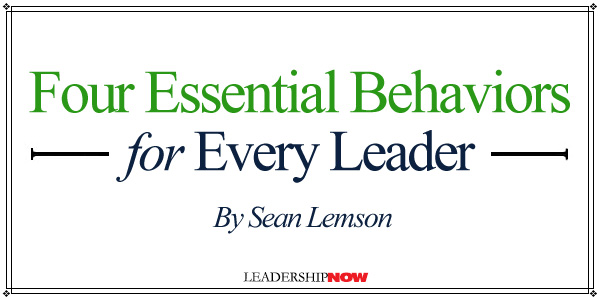
HUMAN BEINGS are complex. Throw in complex organizations operating in complex markets, and you’ve really got to marvel at how it all comes together every day. In the face of all this complexity, there are four basic behaviors that leaders can adopt that will drastically improve their leadership and, by extension, the experience of those they lead. 1. Create Effective Organizations A very common mistake I see leaders make is to conflate the terms effective and efficient. Efficiency is a focus on process, maximizing outputs while minimizing resources. In business, this often looks like keeping employees busy. Ken Rubin, an agile leadership visionary, has a fantastic analogy that I refer to often to explain the concept. In relay racing, there are four runners, with only one running at a time. One hands off the baton to the next. Rubin likes to say that if we treated relay races the way we treat our team members, we’d tell them, “I’m not paying you to stand here. I’m paying you to run. So go run up and down the bleachers while you wait for the baton.” However, the team that wins the relay race is the team that gets the baton across the finish line first, not the team that had runners running the most. The winners in business are the ones that deliver value the fastest. Efficient organizations focus on the runner. But, effective organizations focus on the baton. Leaders who get this wrong design team formations to keep everyone busy while completely missing that the baton is on the ground much of the time. Ironically, the busier employees are, often, the slower their baton moves. Packing a freeway to 100% capacity is an efficient use of the pavement, but it’s a very ineffective way to move cars. Great leaders never lose sight of the baton. They don’t obsess over employee utilization as much as they obsess about value delivery, and they create organizations and workflows that support that focus. 2. Lead Ethically Unethical behavior by a single employee is often easy to spot and deal with. But when it begins to spread slowly across an organization, it can quickly become the norm for that company’s overall culture. Take this common excuse as an example: “C’mon, everyone does it — it’s the only way to get ahead here.” This slow spread of unethical behavior is called ethical fading. It’s usually the result of an incentive or reward combined with a person who sees no way to achieve the outcome without cheating a little. One unpunished sellout can cause a trickle-down of shrugging and excuse-making. Before you know it, the entire company is now behaving unethically. Great leaders set and hold the bar on ethics. They don’t allow their organizations to slip into ethical fading because they recognize that it’s one of the fastest pathways to a toxic culture. These toxic cultures, in turn, bring with them far-reaching implications for the company that are much larger than the original reason for the unethical behavior. 3. Connect People with Meaning There are always parts of our jobs that we don’t enjoy. But what makes us persevere is knowing that our work has meaning. It’s that sense of meaning that inspires us to think of new, innovative ways to do the work. Great leaders have contagious and persistent connections with the meaning of the work — and hopefully, it’s more than meeting quarterly earnings goals. These leaders continually remind everyone — from the janitors to the developers at the company — of how their company is making a positive impact on the world and the role each individual plays in that impact. Additionally, great leaders can spot the fire in us and learn to harness that fire for the company. They take a chance on our ideas and make it safe for us to fail while encouraging us to try. They see something in us that we may not yet see in ourselves. They connect our work to something we already enjoy. 4. Coach, Don’t Play Good leaders stay off the field and let the players do the playing. They use the unique perspective afforded to them by their spot on the sidelines, combined with their knowledge of the game, to help the players make better choices. There’s a reason that professional sports teams pay millions of dollars for a coaching team. Coaches improve everyone’s performance on the field and, ultimately, the outcomes for the team. One mistake I see companies make is trying to put their coaches in the game. I once worked with a company that decided to collapse its engineering organization by turning Engineering Managers into Managing Engineers, and oh, what a difference the word order makes. Managing Engineers are expected to have their hands on a keyboard most of the time. They’re super talented developers, so why not have them coding? There are two good reasons:
This solution is an efficient one. It’s just not an effective one. Keep your coaches on the sidelines and use their afforded perspective to help the teams play better. These four key behaviors help leaders keep teams engaged, motivated, focused, performing, and innovating. If that isn’t a key goal for the leadership at your company, what is?  
Posted by Michael McKinney at 08:31 AM
09.18.23

Approaching Leadership Excellence Through New Angles
ABOUT 400 years ago, Isaac Newton probably experienced an epiphany when he figured out how prisms work. His experiments showed that when light hits glass at an angle, it not only slows down but also bends as it enters the glass and bends again when it exits, thus leaving the glass at a new angle. The physics of a prism can also be applied to leadership: In an agile work environment, it is valuable to slow down and reconsider which leadership angle to take in particular situations. The PRISM Model offers five angles to leading people and forms the bedrock of leadership excellence. P = Purpose People have an intrinsic need to know that what they do day in and day out has personal meaning for themselves and is meaningful to others; that what they do, in essence, has a positive impact on others and purpose. Most average leaders I have met can recite their company's mission statement but aren't necessarily in tune with their values – solid and unwavering values that drive them toward something bigger and serve as a lighthouse when faced with tough decisions. Excellent leaders live their personal and professional lives in alignment with their core values, which provide their employees with stability, transparency, and consistency. Their employees don't have to waste time and energy playing guessing games about their supervisor because they know from the outset what is important to them, and just as important, they know what contribution they make as the team or company strives toward this purpose. What is your purpose in life? Does it align with your core values? Have you shared it with your employees? R = Relationships Leadership excellence means building and fostering healthy relationships with employees and coworkers. This means taking responsibility for creating a climate where people enjoy coming to work, whether in a virtual setting or on-site. They feel safe not only in expressing their opinions but also know that their opinions are appreciated and valued by you and their coworkers. There is a climate where no negative gossiping or online chats about another person takes place. It's a climate where issues are not swept under the carpet but addressed openly, respectfully, and timely. Teams spend more time together from Monday to Friday than with their families. The workplace can be seen as an extended family. If people work day in and day out in a toxic environment – gossiping, lack of trust, hurting each other – they will not perform at their best. In fact, toxic work environments lead to quiet quitting, burnout, and increased resignations. When leaders have meaningful conversations with their employees, ask open questions, truly listen to them, and nip any toxicity (such as gossiping) in the bud, they are well on their way to fostering trust and building relationships. I = Instilling Energy Emotional contagion is a fact of life. We "infect "people with our energy – be it toxic or positive – within a matter of minutes. Research indicates that the person in the room with the highest power is the one who spreads the energy. Ideally, this is the leader. In some situations where a toxic team member has hijacked the team or derailed a meeting, this individual spreads the energy. In such cases, feelings of fear, anger, frustration, and intimidation are spread. If, however, the leader has built a climate of psychological safety and put a stop to toxicity, their energy is spread. Leaders need to be mindful of their energy when they enter a room or dial into a call. This will be instilled in their team if they are stressed, angry, or distracted. This will be instilled if they are open-minded, positive, and appreciative. Before entering a room or joining a call, reset your mindset to create the atmosphere you want to have. S = Strength Spotting It is a fact of life: the brain is programmed to spot the negative things first, a term which is called the negativity bias. We see the weaknesses and development areas of others before we see their strengths and positive attributes. But when we consciously look for our employees' strengths and give them a chance to use them on the job, studies show that engagement increases, stress is reduced, innovation and agile thinking is fostered, and self-confidence grows. What tasks are your employees performing when they are filled with energy, drive, and motivation? What do they do naturally? If you are unsure, have a conversation with your employees and ask them. Questions such as "What makes for a really good day on the job? ", "What kinds of things give you energy here at work? ", and "What are you doing when you are at your best? "are great door-openers to finding out more about your employees and strengthening your relationship with them. M = Growth Mindset Cultivating a growth mindset in employees is one of the biggest assets any leader can accrue in their team. A growth mindset is one where employees value feedback (vs. taking it as a personal attack), grow from setbacks (vs. blaming others for their failure), are open to challenges (vs. trying to avoid them), and learn from others (vs. being jealous of their success). Rome wasn't built in a day, nor is a growth mindset. Coaching employees and helping them shift from a fixed to a growth mindset takes time and patience. The return on investment, however, is enormous: psychological safety, self-confidence, trust, motivation, innovation, and engagement – just to name a few benefits – skyrocket. In our fast-paced VUCA world, the PRISM Model offers five angles to leading people and forms the bedrock of leadership excellence. As Gen Z is entering the workforce, more employees are demanding a remote or hybrid work set-up, and the number of burnouts and quiet quitting are reaching unforeseen numbers. Today's leader is faced with unique challenges and opportunities. A PRISM approach – purpose, relationships, instilling energy, strength spotting, and a growth mindset – is, quite frankly, not rocket science. It allows leaders to approach leadership excellence from various angles and foster a climate where people enjoy showing up for work and making a valuable contribution.  
Posted by Michael McKinney at 03:23 PM
03.06.23

Good Power: Changing a Life. Changing Work. Changing the World.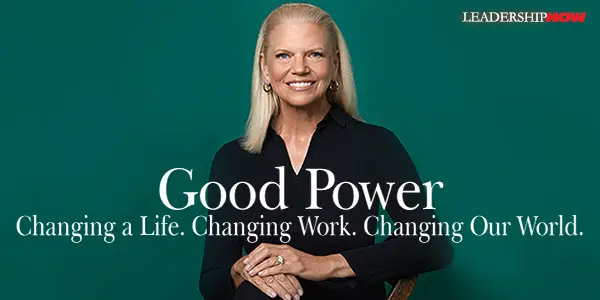
THE TIME TO THINK about power is before you get it. Power is part of leadership, and it can be used in the service of others or for personal gain. In Good Power: Leading Positive Change in Our Lives, Work, and World, former Chairman and CEO of IBM Ginni Rometty redefines power as a way to “drive meaningful change in positive ways for ourselves, our organizations, and for the many, not just the few.” Using her life experiences and lessons learned, she draws out principles that define good power. She observes that power that doesn’t produce tangible results is pointless. “Power is necessary to change things for the better, and that power can be good when it’s wielded respectfully, when it navigates tensions, and when it strives for progress over one person’s idea of perfection.” Rometty divides the book into three parts that correspond with our own journey as we grow into adulthood: the power to change me, the power to change we (a group or organization), and the power to change us as a society. She says that while some clients appreciated her perfectionist tendencies, it sometimes left her colleagues cold. “My drive for perfection often meant I only focused on what needed to change without acknowledging the positive. This could keep people from trusting themselves. It would take me a while to learn that just because I could point something out didn’t mean I should.” The soul of good power is “being in service of others,” which she differentiates from the act of “serving others.” Being in service of others is not a means to an end, but a means in and of itself. It manifests in how we act and the behaviors we choose in moments of preparation, interaction, and follow-up. Being in service of others means delivering value, which involves self-control and empathy—understanding who you are serving. Listening is a big part of that. I discovered that listening breeds knowledge, knowledge breeds creditability, and credibility earns trust that allows relationships to flourish. And when delivering bad news, use a velvet hammer. How do we do that? Speaking about tough truths in affirmative tones let critiques land constructively. So did beginning a difficult conversation by emphasizing something positive, as well as citing facts instead of opinion to support a controversial conclusion, and ending on a note of optimism and with potential solutions. When we move beyond just developing ourselves to developing others, it signals that we are transitioning from the power of me to the power of we. We grow a company when we grow its people. Being in service of others is the why and building belief is the how for bringing people on a change journey, she writes. Building belief is about moving people to embrace an alternate reality for themselves and others, and then to willingly participate in creating it. It’s the first major step if you want people to change, because they have to understand and believe in the change. When CEO Sam Palmisano stepped down at the end of 2011, there were several qualified replacements, including Rometty. The senior vice president of human resources told her, “ Ginni, if you want the opportunity to be CEO of IBM, don’t try to run for office. She says, “I translated his sage advice to mean put your focus on followership, not politics.” One of the best chapters for me was Knowing What Must Change, What Must Endure. If we want to make changes for me or the we, we must understand that certain behaviors are required to bring about certain outcomes. New thinking brings about new behavior resulting in different outcomes. We must give people the tools—the how—to change. When moments of reinvention arrive, innovating the “how” can be overlooked in favor of focusing on the “what.” Indeed it is not enough to just tell people to deliver a different outcome. We have to cocreate a new way of working, give people permission to change, and create an environment that encourages and rewards new behaviors and skills—all at scale. In any transformation, balancing the old and new is always a challenge because it is hard for people to wrestle with this tension. Even with major changes, some things don’t change. “Transforming a really large entity also means reconciling the pace of change in the market with the rate and pace of change the organization can withstand.” In addition, “once we figure out what endures, even if it must be modernized, we have a platform from which we can bridge to the future.” What doesn’t change? If an organization is to meet the challenges of a changing world, it must be prepared to change everything about itself except the beliefs on which it bases all its policies and actions. What is your foundation “upon which the hurricane of change” can happen? When there are setbacks and critics, you need to have built some resilience. Resilience results from a number of factors, but two in particular—relationships and attitude. Both are under our control. Rometty doesn’t ignore critics. She asks herself if they have legitimate points and anything she might learn from their perspective. “Critics may inform me, but they don’t define me.” To help us in applying good power to the us—society—one way is to look “at big problems as big systems to be transformed.” Thinking systematically, “good power at scale can help build belief in a movement; cocreate new solutions; let go of what’s wrong; and modernize what’s right.” 
Posted by Michael McKinney at 06:53 AM
11.04.22

The Steward Leader: Giving the Gift of Lift
IN 2016, I was meeting with Gail Miller, one of the wealthiest women in the United States, as well as one of the most wise and generous. Gail was nearing completion of the transfer of her sole ownership in the Utah Jazz to a trust she had carefully designed to keep the team in Utah well into the future. During the course of reviewing various documents with her, I asked, “Gail, does it bother you at all to give away your ownership in the Jazz?” Gail looked up from the documents and said flatly, “I don’t own the Jazz.” Her response surprised me and gave me pause. “But you actually do own the Jazz,” I replied. I will never forget her response. “No. I don’t,” she reiterated, sitting back and looking me straight in the eye in a way that told me she knew exactly what she was saying and doing. “I’m a steward of the Jazz.” Her simple yet powerful reply has reverberated in my mind ever since and launched me on a journey researching, studying, and exploring the essence of stewardship and how it can be a transformative and freeing way to both live and lead. At their essence, stewards are women and men who are fully invested in something bigger than themselves. They combine both deep personal engagement with a bigger-than-them transcendent perspective that allows them to make lasting impacts in the lives of others. In the course of looking at Gail’s life and the lives of other stewards I studied, I came to identify four unique and powerful ways in which stewards lead in a fundamentally different way. 1. Stewards Use a Because/Therefore Model for Life. Because stewards have a clear knowledge of who they are, what they value, and what they believe, they are able to use a distinctive model for leading. Most of the non-steward world operates within an “if/then” mindset. In other words, if I do X, then Y will happen, or if I do A, then the world/others will do B. This mindset renders life mechanical, transactional, and outcome-based. In contrast, stewards lead with a “because/therefore” view of the world. This unique perspective makes life infinitely more relational, intentional, and transcendent. “Because” (transcendence) leads to “therefore” (deep personal investment). Their personal transcendence is the driver, and stewards are the agents, investing their energies in something bigger than themselves. The expectations are on the self, not on the outcome: because I value X, I expect myself to do Y. A because/therefore orientation also makes decision-making easier. As Roy Disney once said, “it’s easy to make decisions once you know what your values are.” 2. They Care More About Their Successors Than They Do Their Success. One of the most distinctive characteristics of steward leaders is their connection with the timeline of life. They see their role as a temporary one. This perspective makes them both forward-thinking and openhanded, allowing them to take on goals and projects they cannot accomplish alone or within their own lifetimes. Stewards aren’t concerned only with how their group or organization functions while they are alive and in charge; they look to the life of their business, family, organization, community, and even their country after they are gone. This perspective makes them intentional about how they allocate their time, talent, and treasure. It also makes them generous and openhanded when it comes to investing their resources and encouraging others to do the same. 3. They Are All About Purpose, Not Possessions. In the field of positive psychology, a major focus of research today is on the concept of purpose and how it affects the way we view and approach life. Researchers have come to the general consensus that purpose should be defined as follows: “Purpose is a stable and generalized intention to accomplish something that is at once personally meaningful and at the same time leads to productive engagement with some aspect of the world beyond the self.” As you may note, within this modern definition of purpose, we find both of the building blocks of stewards. Transcendence involves the focus on “some aspect of the world beyond the self,” and investment relates to the “intention to accomplish something,” which leads to “productive engagement.” Steward leaders know that, unless we are incredibly careful, what we own tends to own us back. Whether it’s our businesses, our homes, properties, all come at a cost. Stewards are unique because they aren’t held down by anything because they are owned by nothing but their purpose. This makes it much easier for them to sell assets, change positions, allow others to get credit, or even step down, as long as their overarching purpose is advanced. 4. Steward Leaders Don’t Seek Balance. They Seek Counterbalance. Counterbalances are used in a wide range of everyday devices, such as elevators, cranes, drawbridges, and even metronomes. The purpose of a counterbalance, or counterweight, is to provide a strong opposing force so that a machine can more effectively accomplish the task for which it is designed. Far from acting to limit or diffuse its opposing force, a counterbalance is meant to bring added strength, focus, and direction to the force it is countering. Steward leaders counterbalance transcendence (their why) with investment (their how) and allow the force of each to magnify the other. In addition, because stewards adopt the long-term perspective that goes along with taking on something bigger than themselves, their lives acquire a deliberate cadence, which allows them to move at a measured and intentional pace without burning out. Conclusion The path of the steward leader is both challenging and rewarding. It is, at the same time, both deeply personal and outwardly expressive. Those who embrace the way of the steward leader not only find the peace that comes from having a clear direction that comes from counterbalancing transcendence and investment, they also leave an indelible mark on the lives of their employees, friends, families, and communities—and on the world itself.  
Posted by Michael McKinney at 09:30 AM
09.23.22

Leadership Truisms: Road-Tested Lessons for Leading During Complicated Times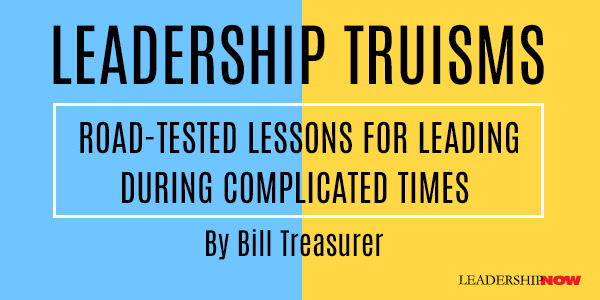
THESE are exceptionally complicated times to be a leader. The world is fraught with touchy political divisions, economic disparities, generational tensions, and racial disharmonies. Magnifying the challenges are the ever-shifting dynamics of today’s workplace. More leaders are leading remote teams across larger geographic distances, presenting unique challenges in terms of onboarding new employees, giving performance feedback, building esprit de corps, and nurturing healthy relationships. The traditional stability of consistently applied practices and processes has been upended. Now individual exceptions and customized deals are common, tailored to flexibly accommodate each person’s extenuating life realities. It’s a struggle to treat everyone fairly yet individually. Letting one person work from home three days a week to care for an immuno-compromised parent will look like good leadership to that person, but it will smack of favoritism to the healthy single person required to be onsite every day. Leaders will simultaneously be seen as exceedingly fair or unfair, depending on who benefits from policy exceptions that today’s realities require leaders to allow. Despite being a particularly challenging time to lead, leaders can use some road-tested tactics to navigate through today’s choppy waters. Leadership fitness is a function of three disciplines: leading yourself, leading others, and leading work. Leading Yourself Leadership starts with self-awareness and self-discipline. You’ve got to know what your good at, and what you’d be wise to hand off to others. You’ve got to have a deep value system that can help you weather tough people and situations. You’ve got to manage and prioritize your time. If you can’t lead yourself, what qualifies you to lead others? Here are some two-word truisms that will help you lead yourself well: Know Thyself: Leadership starts with self-awareness. Identify the formative experiences that helped shape your beliefs about leadership. Who were your earliest leadership role models? What did you learn by watching them? Also identify your sunshine and shadows: your strengths and the shadows those strengths cast when you overuse them. For example, are you a persuasive communicator? But does that cause you to often hog the limelight? Model Principles: Having deeply held values leads to inner strength. Leadership is hard and having strong inner character will help you withstand inevitable headwinds. Be clear about what you stand for — and against. List your deepest held values. Which ones do you embody? Which ones do you need to improve on? Aspire Higher: Leadership has everything to do with elevating performance — your own and others. In big ways and in small, you should be improving every day. Doing that means setting stretch goals, investing in your own development, and actively seeking out feedback from those impacted by your leadership. Practice Humility: People want to be led by leaders who are confident and humble. Always remember that you’re no better than the people you’re privileged to lead. Never be arrogant. Practice humility by asking people for their input and then listening to, and heeding, their advice. Cultivate Composure: Leaders bear a heavy burden of responsibility, which is stressful. Often that stress gets externalized in the form of anger. Don’t be a hothead. When you freak out, people lose confidence in you. Start your day with some quiet reflection. Ask yourself, what good do I want to do in the world today with my leadership influence? Leading Others Leaders can’t, and shouldn’t, do everything themselves. Your success as a leader is contingent upon how successful you help others become. Focus your leadership influence on helping each individual you work with to add more value — literally help them become more valuable. That requires investing time in their development, giving them your focused attention, and drawing out the leader in them through your coaching and feedback. Here’s how: Trust First: Trust bonds followers to leaders. Yet too many leaders fold their arms waiting for people to first prove that they can be trusted. They start from a place of skepticism and guardedness. Switch the equation. Focus first on being worthy of the trust of others. Never shade or couch the truth. Keep people updated and informed. Deliver on your commitments. Create Safety: Innovation is the lifeblood of business. People will extend themselves, experiment, and take risks if you make it safe to do so. Don’t bite people’s heads off when they make forward-falling mistakes. Don’t intimidate or stoke people’s fears. Invite feedback and thank people when they give it to you. Psychological safety is just as important as physical safety. Nurture Talent: Developing your people is a prime responsibility. Invest at least 15 minutes every two weeks with each person who reports to you. Don’t focus on the status of projects and tasks. Instead, check in with them, asking how they’re doing, how things are on the home front, and what you can do for them. The 15 minutes will dramatically strengthen the relationship and build mutual respect and loyalty. Promote Inclusion: If you care about great results, you’ll promote diversity, equity, and inclusion. Your job is to foster an environment where every person can bring their full selves to work and be totally engaged. Welcome, encourage, and foster diversity in all its expressions. Leading Work Leading yourself and others will help you ensure the final area of leadership fitness: leading work. Leaders are judged by the results they get. The whole point of leadership is to produce positive outcomes that didn’t exist before. You and your team need to deliver effectively and consistently. Leadership has everything to do with results. Here’s how to get them: Love Business: Business can be intimidating. The more experience you gain, the more business-minded you’ll become, and the less intimidating business will be. Talk to leaders you admire. Have them share the big decisions they faced and the factors they considered when facing them. Join a professional association and broaden your network. Keep an ongoing journal to document your leadership lessons. Master Management: Great managers make for great leaders. The more you master management fundamentals, the more equipped you’ll be to face complex situations. Set clear plans, goals, and milestones. Intently review progress. Equip people with the tools and resources they need. Provide coaching and feedback. Reward stellar performance. Be fiscally disciplined. Lead Up: Support your bosses’ success. Earn their respect by being candid, keeping them updated, and giving them helpful feedback. Look for stuff that they might be missing. When they give you an assignment, overdeliver. You don’t have to be a kiss-up or yes-person. You can be loyal to your boss and loyal to yourself at the same time. Despite being a particularly challenging time to be in a role that has always been challenging, if you’re disciplined about leading yourself, if you honor the responsibilities that come with leading others, and if you consistently produce great results by leading work, you’ll not only enjoy leading, but you’ll be fully fit to lead!  
Posted by Michael McKinney at 07:03 AM
08.29.22

Leadership Lessons from Coach Nick Saban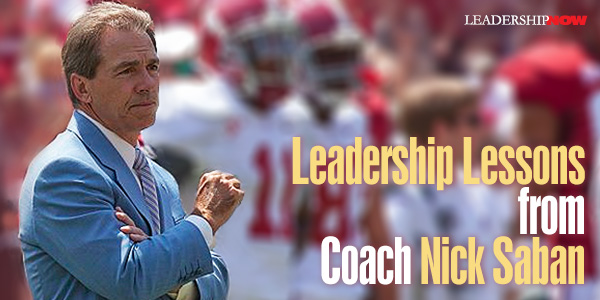
ON August 25, Chris Low posted an ESPN interview with 70-year-old Nick Saban, who just signed a new $93.6 million contract extension that runs through the 2030 season. Here are a few of the highlights that provide us with some leadership lessons: Think like a freshman. “You have to be flexible. I think that’s one of the most important things about competitive sports … If you don’t sort of study the game and know the impact of these things and use them to your advantage, you’re going to just completely get bypassed by a lot of folks.” Success is a choice. Take responsibility for your choices. “I heard it said that none of us are born winners, and none of us are born losers. We’re all born choosers. So choosing the right things that are going to help you be successful ... that doesn’t really change.” Focus on what you can become. “The one thing, because of the brand that we have here, that players can see, is they can earn a tremendous amount of money because of the brand and because of the image that they can create using that brand to promote themselves, which has happened. The players that we’re recruiting are not coming here because of the money we’re giving them to come here. They’re coming here because of what they can earn being here because of the history that we have of guys creating value for themselves.” Hold yourself to a high standard. “I wouldn’t want to coach someplace that didn’t have a high standard.” Good leadership means continual growth. “I think I’ve become a better teacher. I think yelling and screaming at players in this day and age really goes in one ear and out the other. If you want them to really resonate on what you’re saying, you just need to teach it, and sometimes, it works better if you do it individually than if you do it in front of other people. That’s not something I considered in years past, several years past.” Build a good team. “We don’t have a lot of what I call energy vampires, guys that take all your time because they’re not doing what they’re supposed to do. We have a team that has bought in, and they’re all trying to do the right thing.”
Posted by Michael McKinney at 09:31 AM
07.18.22

Leading with Heart: Five Conversations that Unlock Creativity, Purpose, and Results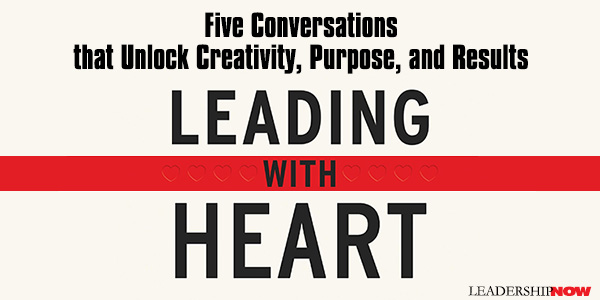
THERE ARE FIVE core characteristics that help leaders connect at an authentic human level with their people: they are aware of other people’s needs, they confront their people’s fears, they understand their own desires and what drives their people, they leverage their gifts, and they connect with purpose. These leaders lead with heart. They are “simply the most relentlessly curious, caring, and insightful about themselves and their people.” John Baird and Edward Sullivan explain in Leading with Heart that they do it by engaging in conversations about what we really need to feel safe and creative. The five questions are designed to remove the barriers that have kept us from leading with heart: 1. What do you need to be at your best? When a houseplant wilts, we don’t yell at it, offer it more money, or put it on a performance improvement plan. We give it more water, move it closer to the sun, and make sure it’s getting the nutrients it needs until the leaves perk up and regain their color. The same goes for us as people. To lead with heart means we need to have conversations about not only our physical (diet, sleep, and exercise) and emotional needs but also the physical space we function in—the environment. Often our belief systems keep us from doing what we should be doing to be sure our baseline needs are being met. And then we ac out. “Some clear tells that we ourselves ou our teams are not getting their needs met: irritability, disagreements, anxiety, lack of motivation, and lack of creativity, all of which make us susceptible to being triggered into fear responses.” 2. Which fears are holding you back? We create negative or self-limiting stories about ourselves. By uncovering what frightens us and by getting radically serious about the fears of our teams, we can begin ridding ourselves of blocks, untruths, and old defeatist stories that weigh on us, as well as all the unhelpful behaviors we engage in when we are triggered in response to our fears. What are my fears is the most challenging conversation to have and to create change around. Naming your fear(s) and embracing them in order to choose different behaviors is the first step. People around us are acting out of fear all the time. Compassion and curiosity for that fear are your first line of defense. 3. Which desires drive you, and which might derail you? Our deepest desires can be incredible sources of motivation. Feeling like we are winning, like we are contributing, like we have influence—these can get us out of bed in the morning. But if we let our desires get out of hand, we can get derailed. Leaders who fall from grace most often have a desire problem because they satisfy a short-term desire without considering the long-term consequences. We can create blindspots around our desires as we rationalize what feels good to us. It is crucial for leaders to be very clear about what their values mean in practice. Transparency can be conflated with having no privacy. Honesty can be conflated with oversharing. And inclusion can be conflated with consensus. 4. What are your greatest gifts? The greatest leaders have an uncanny ability to find the unrecognized gifts in their people. They see past what people think they are good at and find something instead that they are great at. Our gifts sometimes come from curious places. From our grief, our flaws, and even our darkest moments. Sometimes our flaws are the overuse of our gifts. When a gift is overused, we and those around us fail to derive the potential that is there to contribute. You will find your gifts and superpowers in your painful experiences. “Many of the most successful and impactful adults had childhoods that were compromised in some way by neglect or abuse. The first step in claiming the gifts we derive from painful experiences is to reframe the stories we tell ourselves about those experiences.” Leading with heart includes helping people see their own gifts and expand their sense of what they are capable of. Social scientists have been telling us for years that positive reinforcement is the best way to get others to adopt new behaviors. Yes, we really are just waiting for someone to say, ‘Good job!’” 5. What is your purpose? Conversations around purpose are really about what impact we seek to have on the world. What am I (or we) here to do? Who am I (or are we) here to serve? Conversations around purpose are perhaps the most important because while we have conversations about our needs, fears, desires, and gifts, if we don’t have a clear sense of purpose, “we don’t have a place to put all that clarity and energy.” Someone who is living without their critical needs being met is often not able to make space in their life for service to others, which is what finding your purpose is all about. These five conversations become your organizational culture. Your culture is a “manifestation of how you as an organization help each other see and understand your needs, fears, desires, gifts, and purpose.

Posted by Michael McKinney at 01:32 PM
04.20.22

You Don’t Need a Cape to Be a Hero to Your People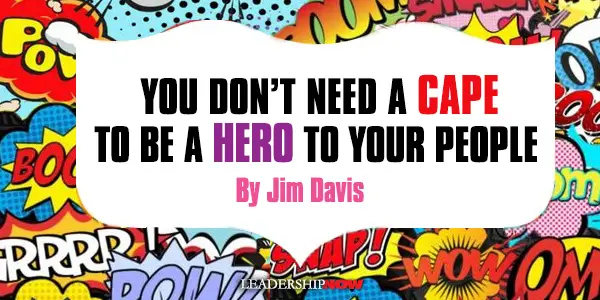
HERO can be a relative term. It can conjure images of stilled action in the pages of a comic book or computer-generated images on the big screen of good versus evil. For those who live in the real world, the relevance is much more practical and actual. Heroes lift the souls of those who read about their stories of bravery and the causes they champion at every turn of the page. Villainy must be vanquished, just as the challenges in everyday life we all face. No cape required. There are nine “superpowers” each aspiring leader can employ that will help him or her be the champion people need and deserve. 1. The Power of Vision It all starts with something better. Or, at least, it should. That’s the power of vision. Vision is simply a snapshot, or image, of a preferable future. It’s the way things can be, ought to be, and will be, if impassionedly pursued. The concept of heroes and their sense of idealism represents something more. Something better. It can help us see beyond the now into our best tomorrow. Vision is the ability and awareness that prompted non-powered individuals to create, invent, and otherwise shape the future in truly remarkable ways. 2. The Strength to Win No matter the story, foe, or situation, each hero, we believe, will eventually prove to be the champion we all knew he or she could be. The certainty and anticipation of victory is tied to the strength every hero displays, even in the face of dire straits or great adversity. This is just one reason heroes are so celebrated and revered. The strength to win is an attitude and a spirit that will not allow a person to live under the circumstances but rise above them with a resilient refusal to lose. 3. The Value of Trust Trust is not automatic. It must be earned, not given. We trust another because we learn, over time, that he or she is worthy of it. We know they will do the right thing, every time. We trust those who come through, over and over, and we freely relate with, absent of any doubt, those who work hard to protect and cherish that confidence. We confide in another because we’ve given ourselves permission to do so. Otherwise, we simply look elsewhere or, if given no choice, offer as much trust as the situation deserves and hope for the best. For the heroic leader, trust is the foundation on which everything else is built. When trust is secure, communication is healthy, productivity is higher, as is morale, and the opportunities for group success are more readily available. 4. The Price of Prowess You have to give up to go up—John Maxwell. Leadership is a skill that can be taught and developed. It’s not magic. It’s not mystically bestowed. Every leader possesses some prowess, but it’s not easily or lazily expanded. Measure of influence is determined by the current degree of leadership. We all have a ceiling that doesn’t, and shouldn’t, remain permanent. Many never leave what could be described as entry-level or positional. Don’t get stuck. Challenge your competency and work to grow. 5. The Passion of a Just Cause Everyone needs a cause. Everyone needs a calling bigger than self, a passion that will not only energize their life but change someone else’s. Without it, the sense of merely existing takes hold, and one simply takes up space until the end. Not enough are driven by a strong sense of mission, purpose, or a reason that produces a call that must be answered with enthusiasm and passion on a daily basis. While each life has a definite purpose, causes can be presented at various times in alignment with one’s mission and calling. Every life is a story waiting to be told. A great commitment to a great cause will build a great life and speak volumes to the world about who you are, what you believe, and the difference you want to make. Never make a first-class commitment to a second-class cause. 6. The Reality of Hope You can survive 40 days without food, three days without water, and eight minutes without air. You can’t honestly survive a single second without hope. Hope is as vital as the air we breathe. Without it, life becomes an exercise in finding as many ways as possible to cope or just get by. People no longer thrive. They merely survive. Every leader can authentically present the reality of hope that will spur their team forward despite, and even because of, hard seasons. 7. The Honor of Fighting Fair Conflict is inevitable. It can’t be avoided. When people attempt to, with a head in the sand approach, the conflict that inevitably surfaces is worsened by a lack of readiness. The typical manager spends 25–40% of his or her time dealing with workplace conflict. Another term for this is putting out fires. While conflict can’t be eluded, it doesn’t have to be ruinous. Disagreements, if handled properly, can make a team better, not bitter. This requires attacking the issues, however, not each other. 8. The Leveling of Calm No one gets to choose when moments of stress and difficulty occur. While we can’t control when bad moments will strike, one can control what to do with them and what happens next. This is what separates the mature leader, the heroic leader, from the average person who never rises above impulsively reacting to bad situations instead of carefully responding. 9. The Heart to Serve Heroic leadership is not power over people, but power with people. It’s paradoxical, but true greatness comes from proving to be the least, in so much as expressing a willingness to consider others as much as self. People hate pretense and can usually see through a façade. Serving others, especially those you lead, must be genuine. The main question is, “Do I care about the people I’ve been blessed to lead, or do I only care about getting the job done?”  
Posted by Michael McKinney at 08:15 AM
03.22.22

The Six Mindsets That Distinguish the Best Leaders from the Rest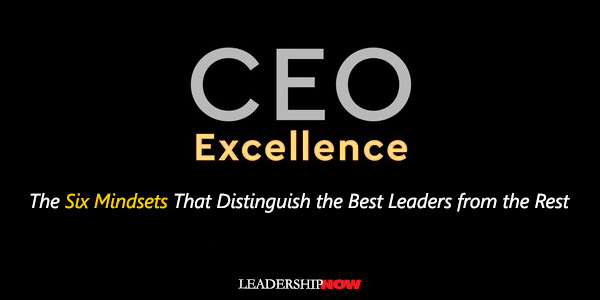
WHAT differentiates the best CEOs from the rest? There are timeless mindsets and practices that make the difference. In CEO Excellence, McKinsey partners Carolyn Dewar, Scott Keller, and Vikram Malhotra, spell out these mindsets and practices. The culmination of what they found leads to the fact that these leaders help others to achieve things they never imagined they’d be able to. So there are lessons for all leaders at any level in this book. Through their research—they found 146 CEOs that excelled in the CEO role to study but then cast a wider net to round it out to 200 top-performing CEOs—they determined that there are six mindsets that differentiated the best leaders of the twenty-first century from the rest. These mindsets enable them to navigate the dominant features of their environment—new competition, disruptive change, digitization, pressing social and environmental issues, or economic meltdowns—with wild success, while others wallow in mediocrity. The simple fact is that the top of the pack think differently, which causes them to take profoundly different actions day in and day out. The Six Mindsets The best CEOs may not be the best in these mindsets, but they are the best at integrating all of these responsibilities simultaneously. “For a CEO, what’s important is that you can balance everything together,” said KBC’s Johan Thijs. Assa Abloy’s Johan Molin added, “As CEO, you need to realize that you’re only one person, and you’re not the best person because you’re such a generalist. You’re not going to be not trying to be the smartest of the smart, but you can give good advice, facilitate, and encourage people to work.” Each mindset is associated with three practices. Setting the Direction Rather than hedging their bets, the best CEOs are bold. “They’re less a taker of their fate and more a shaper—constantly looking for and acting on opportunities that bend the curve of history.” Vision: They reframe what success means. “The best CEOs often dig back into a company’s history to find out what originally made it successful and then take that central idea and expand it in ways that open up new opportunities.” They add, “what matters to them is to have a clear and simply articulated North Star for the company that redefines success, influences decisions, and inspires people to act in desired ways.” Strategy: Move early and often. “Excellent CEOs are always looking to the next S-curve while ensuring the current one is delivered on.” Resource Allocation: Budgets are not based on last year’s budget. Resources are zero-based and then solved for the whole. “No investment is taken as a given—every investment is scrutinized, alternatives explored, and approval justified by how it helps deliver against the company’s strategy and vision.” Aligning the Organization Once the direction is set, execution is not inevitable. The problem is more than intellectual. It is an emotional one. “You have to fix both sides as the CEO: The easy part is technical; the difficult part is people.” Culture: Align the culture: reshape the work environment, make it personal, make it meaningful, and measure what matters. CEO must embody the change. Organizational Design: “When a CEO sees an organization tilted one way, there’s a temptation to tilt the opposite way—and, like the pendulum of a clock, the swing back and forth between the two polarities is perpetuated. The best CEOs rarely make radical swings from one extreme to the other.” Talent Management: “Your people decisions are really where all your leverage is,” says GE CEO Larry Culp. You must clearly define high-value roles, look for the left tackle positions that protect and enable value to be created, find the unusual suspects, and actively build the bench. Mobilizing Through Leaders The best CEOs and less concerned about what their leaders do together and more concerned about how their leaders work together. “They obsess with solving for the team’s psychology and let the mechanics of coordination and execution follow.” Team Composition: “A group of high performers only become truly high performing if its members are complementary and connected to one another and not simply working side by side.” The best CEOs staff the team with an eye to aptitude and attitude, act fast but fairly regarding those who don’t belong, stay connected while keeping their distance, and build a leadership coalition beyond their immediate team. Teamwork Effectiveness: Those on the top team have a responsibility to the organization over their own units. “I’m on the team so I can represent the company to my function or business.” Operating Rhythm: “When a CEO creates a clear and effective operating rhythm, every member of the top team can sync the rhythm of their specific area with that of the company as a whole.” As CEO, you have a 30,000-foot view of the organization. You need to make sure your team members have the advantage of that perspective. “If the CEO is not making the gears mesh together, dysfunctions quickly become hardwired.” From Microsoft’s Satya Nadella: People say the job is lonely. I realized that it’s an information asymmetry problem. Nobody who works for you sees what you see. And nobody you work for sees what you see. That’s the fundamental problem of a CEO, which is you see it all, and nobody else around you sees it, so you can get very frustrated. Engaging the Board “The best CEOs help the board chair run the board so that the directors can help the CEO run the business.” Board Relationships: The best CEOs build and maintain trust by choosing radical transparency, building a strong relationship with the board chair, reaching out to individual directors, and exposing the board to management. “Trust is not about charisma or friendship. Trust is based on delivery,” says David Thodey CEO of Telstra. Board Capabilities: Be clear about the role the board should play and make sure they understand the business. Encourage the chair to evaluate board performance. Board Meetings: Focus on the future. Serve on a board yourself to get a perspective on what it is to be a board member. Never get involved in board functions. Connecting with Stakeholders “Research shows that a company’s relationships with external stakeholders can influence as much as 30 percent of corporate earnings.” Social Purpose: Be sure your organization has a powerful reason for why they exist. We live in a time where stakeholders want to hear the CEO or organization take a stand on various social issues. “The best CEOs don’t confuse their personal passions for their company’s principles.” Stakeholder Interaction: Getting it right is not always easy, but the best CEOs share these commonalities: they contain the time spent Outside, they understand the other party’s why, they gather as many good ideas as possible from the interactions, and they maintain a single narrative across all stakeholders. Former Best Buy CEO Hubert Joly explains: The key with any stakeholder is to get the “say-do” ratio right: the ratio between what we say we were going to do and what we actually did. That’s how you get credibility. And if you’re doing what you are saying you will do, they’ll actually want to see less of you. They’ll want you to be spending your time working on the business and delivering on your commitments. Moments of Truth: Have a crisis playbook that you can tailor to each situation. When a crisis hits, maintain a long-term perspective to keep driving the business forward. Ahold Delhaize’s CEO Dick Boer says there are three lessons for CEOs when dealing with a crisis: First, do not chair or lead your crisis team. Let them report out to you. This gives you the space and time to oversee all the elements of the business, not only the crisis. Second, show confidence in your organization—show that you’re in control, that you know what you’re doing, and that you’ll take care of your people and your customers. Third, think of what’s next even when the storm is still around you, because there’ll be opportunities and other situations you have to manage as a consequence of the crisis that you might not have thought about. Managing Personal Effectiveness Leading yourself is essential to be physically and psychologically fit, and not even the best CEOs have this figured out. One executive coach said, “No one has ever lived to outwork the job. It will always be bigger than you.” Office: Managing your time and energy involves keeping a tight but loose schedule, compartmentalizing, infusing energy into your routine, and tailoring your support staff to your needs. “With so much on a CEO’s plate, one of the most challenging aspects of the job from an emotional perspective is to move from meeting to meeting without letting what happened in one spill over to sabotage the next.” Leadership Model: Show a consistency of character—authenticity. “Being consistent doesn’t mean that CEOs should be inflexible. Without betraying their core values, the best are willing and able to modify how they lead if the circumstances demand i. It’s important to figure out what kind of CEO the company needs.” Perspective: Stay grounded. The best CEOs don’t; make it all about them. They embrace servant leadership. They create a kitchen cabinet that can speak truth to power and keep them humble, and they display gratitude for the opportunity to sit in the CEO chair.

Posted by Michael McKinney at 04:33 PM
02.04.22

Simple Truths of Leadership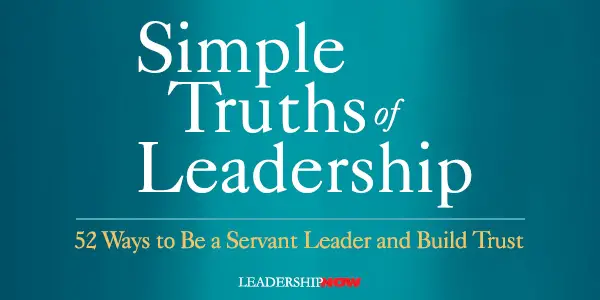
COMMON sense never seems to be common practice. To address this problem, Ken Blanchard and Randy Conley wrote Simple Truths of Leadership—52 of them. We wrote this book because we know a lot of people aren’t applying commonsense principles in the workplace. The format of the book is simple. On the left page, we identify a Simple Truth about servant leadership or trust. On the right page, we describe the puzzling lack of the use of the concept and briefly explain why it is important. The final element is a call to action for readers—“Making Common Sense Common Practice”—where we break down the concept into ideas that leaders can easily apply on the job. Some of the more memorable truths are: #1: Servant leadership is the best way to achieve both great results and great relationships. #5: The key to developing people is to catch them doing something right. #7: When people are off track, don’t reprimand them—redirect them. #9: Effective servant leaders realize they have to use different strokes for different folks. #12: Create autonomy through boundaries. #13: You get from people what you expect. #23: Servant leaders love feedback. #30: Someone must make the first move to extend trust. Leaders go first. #33: Fear is the enemy of trust. #41: #Trust is always trending. Doing the right thing never goes out of style. #44: The most important part of leadership is what happens when you’re not there. #48: Building trust is a journey, not a destination. #50: Apologizing is not necessarily an admission of guilt, but it is an admission of responsibility. The only truth that I think needs further explanation is #46: “People don’t resist change; they resist being controlled.” It’s true. If people feel controlled, they will resist. And their prescription is spot on: “It is important that they know the reasons the change is needed and the anticipated advantage of effectively implementing it.” Absolutely. People are more likely to change when they have faith in the promised outcome—the why. It is interesting, though, as studies have demonstrated, people who have had life-threatening heart conditions, when told that they need to change their lifestyle and eating habits, don’t. In his book Change or Die, Alan Deutschman tells us that Edward Miller of John Hopkins University has reported that if you “look at people after coronary-artery bypass grafting two years later, ninety percent of them have not changed their lifestyle.” They would rather die than change even though they are fully aware of the stakes. Perhaps the Simple Truth should be, “People are likely to resist change when they don’t know the why of the change.” The problem, of course, is that with all 52 of the rules, we know these things intellectually, but making them a part of how we lead is difficult because it requires some introspection and intentional forethought. And then action. You know, change. That often seems harder than the status quo. Or, we begin to make the change but tire of the effort. Nevertheless, we all benefit by reviewing these truths and, better yet, discussing them with our peers and co-workers. We can’t fix what we don’t think about. And we can use the support of others. These 52 Simple Truths will help us to move in the right direction. 
Posted by Michael McKinney at 07:56 AM
09.20.21

What Does Equitable Leadership Look Like?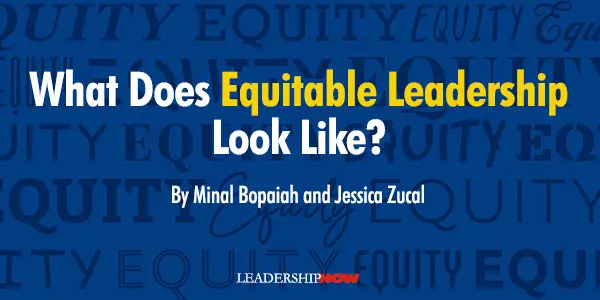
DURING the pandemic, one of us became a bit of a Star Trek fan. Minal was never really into science fiction, but she ran out of shows to watch and found herself intrigued when Stacey Abrams, who is famously a Trekkie, said that Voyager was her favorite Star Trek show, even though Deep Space Nine is considered the political allegory. Still, Abrams cited Voyager, and we can’t help thinking it was because of Captain Janeway. In Voyager, women finally had a realistic representation of female leadership aboard a Star Trek vessel, one that was determined and decisive but also empathic and willing to listen. Still, Janeway doesn’t seem like such a big deal until Minal had finished watching all the Voyager episodes and decided to dip into Star Trek: The Next Generation (referred to as TNG among Trekkies, we’re told). The first season is almost shocking in how Patrick Stewart’s Jean-Luc Picard carries himself. He’s brash and bossy and vents his frustration by shouting at children, particularly poor Wesley. In Picard, the recent revival of the Star Trek franchise, it’s clear the character evolves since season one of TNG. But we don’t think Captain Janeway would need to evolve as much if they revived her character. In fact, she’s almost a prescient paragon of what good leadership looks like in the 21st century. For decades, outdated models of Western leadership have prevailed, primarily centering White culture and male energy: someone who’s certain of himself, who has all the answers, who takes up space, shows no weakness, and knows how to win. But in a world turned upside down — by a pandemic, by climate change, by a reckoning with systemic injustice — what does winning even look like now? Leaders have been getting an inkling that things are changing, that the old tools aren’t working. They have tried to lead their staff through these changes by emphasizing we are more alike than different, that anyone who works hard can succeed here, and have been befuddled when staff respond with outrage or anger. So what exactly is going on? The definition and expectations of leadership have changed. Talented staff no longer want a general leading them into battle; they want a coach nurturing the best out of each of them. They want someone with the courage to be vulnerable and say, “I don’t know, but I’m committed to figuring it out with you.” They want an equitable leader. Someone who sees the system. Someone who is not tolerant of difference but rather so comfortable with it that they are willing to embrace it and make it a feature, not a bug of the workplace. They want someone who understands that great organizations encourage everyone to play to their strengths instead of insecurely asking everyone to fit into a mold of the “ideal” employee. However, our brains are wired to feel threatened by difference. In The Power Manual, Cyndi Suarez writes: The concept of difference is central to interactions in relationships of inequality. Humans have used differences to value, divide, and structure society—as with race, gender, class, age, and sexuality. One’s relationship to difference impacts one’s interactions, either reinforcing these structures of value or interrupting them. The supremacist approach to power offers two options for dealing with difference: ignore it or view it as cause for separation. A liberatory approach views differences as strengths and entertains interdependence as an option. How does one begin to nurture a liberatory approach to power? By examining your relationship to difference. Not surface-level differences—like a disagreement in approach or process to employ, the kind of difference that challenges your worldviews, your beliefs, and values. Leaders must navigate and embrace the latter to create inclusive and equitable environments where everyone thrives. And as Jessica has discovered through her work coaching leaders, this requires a higher degree of emotional intelligence, specifically, emotional self-awareness and the ability to self-regulate in the moment. The good news is you can build these muscles with intentional and consistent practice. Normalizing discomfort for yourself and your organization is critical. Why? Because experiencing deep differences often equates to deep discomfort, which triggers your brain’s fight or flight mechanism. In this mode, critical reasoning goes offline. You react out of habit verse skillfully responding from a place of choice. The work of the equable leader is to thoughtfully respond in the face of discomfort and to demonstrate openness for deep difference. Equitable leaders are also skilled at seeing systems and understanding interdependence. While valuing difference is the first step in the process of developing “system sight,” leaders can hone their vision by understanding their own relationship to the systems they are in. The tool Minal uses to facilitate this understanding with leaders is the Group Identity Wheel, developed by DEI practitioners and executive coaches Sukari Pinnock-Fitts and Amber Mayes. The wheel helps individuals understand themselves in all their complexity and positions their identity in relation to systems and power. It also allows them to understand both their marginalization and their privilege. This is vital to being an engaged and equitable leader. If a leader is interested in being an ally to people without the same level of privilege, then they must ask themselves, “How can I lift up the voices that may be struggling to be heard over mine in this organization?” This can be uncomfortable, which is why emotional intelligence is critical, particularly the stamina to do difficult things. It can be tempting to duck one’s head in the sand and simply believe that the outside world will not intrude upon your company. But ignoring reality makes you a poor role model for the courageous conversations we need to have if we really want to design a more equitable world where everyone thrives.  Jessica Zucal is a Senior Principal with Evans Consulting. As a change and transformation expert she works with leaders at the individual, team, and organization levels to build capacity for change and establish enabling conditions for success. Jessica is a NeuroLeadership trained coach and certified EQ-I 2.0 practitioner. 
Posted by Michael McKinney at 07:52 AM
08.03.21

Overriding Our Instincts in Order to Become Caring Leaders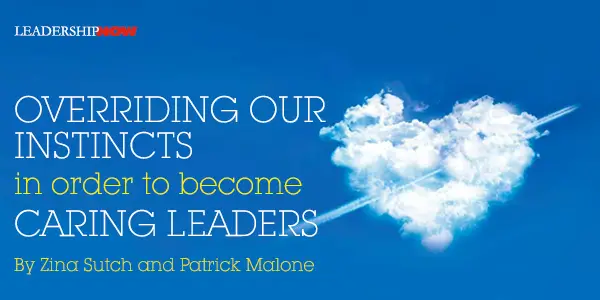
WE OFTEN THINK of ourselves as good leaders — or at least somewhat good. Afterall, we got this far in our careers by following our instincts, practicing what we learned, and applying appropriate business strategies. But are we leading? Truly leading people? Before we answer that question, let’s think about what’s really happening. Over the course of a career, we gain a myriad of tools and tips on how to lead. It’s easy for us to deduce that implementing everything we’ve learned has gotten us where we are now. We follow the acronyms, rules, and checklists we’ve learned from the innumerable books we’ve read, classes and symposiums we’ve attended, and mentors whose wisdom we’ve sought. We rely on this vast collection to get us through the daily challenges. Let’s call this methodology what it is: a recipe for leadership. We seek these quick fixes to leadership dilemmas like we’re shopping on Amazon.com and expecting next-day delivery, especially if we’re new leaders. Perhaps it’s because as managers, we face a horde of challenges. Bottom-line pressures, competitive marketplaces, and maybe a little self-doubt. We’re forced into decisions that answer a time crunch but do little to nurture high-performing organizational cultures. So, we rely on the leadership recipe. This “formula for leadership” approach occurs at all levels. Executives at the highest level of the company are quick to check the big boxes. Did I send out a monthly newsletter? Did I host a strategic planning offsite or a town hall? Did I say hello to a stranger in the cafeteria? Mid-level directors and managers don’t fare well either. They’re focused on getting the job done, meeting deadlines, analyzing data, and meeting quarterly performance goals. They rely on instincts, while the organization’s culture continues to support mediocre performance. Our brain loves the recipe approach. The human brain is a miracle of survival and, from a psychological and evolutionary perspective, this makes sense. We have a human need for steadiness and predictability. We like consistency. When the brain performs its neural magic, it creates a pathway that can quickly become our default way of thinking. The result is the brain is very comfortable with the knowledge it’s already mastered. These neural pathways and leadership formulas make us feel safe, and we become comfortable and confident with our expertise. We trust what we know, and we shun new ways of thinking. Recipes are, by definition, detailed processes that allow us to get to a final product — and voila, mission accomplished. They’re at least partially designed to reduce uncertainty and stress. And while they admittedly have some value, they don’t account for the human aspects that yield high performance. They don’t have an answer for how to build an emotional connection with the people that we lead. To accomplish that as leaders, we must stray from our comfort zone, override those instincts, and start caring. Really caring, not just saying that we do. Veering from our path of coziness makes us feel unsafe and vulnerable. Straying into the uncertainty of caring is uncomfortable. But when we fail to do this as leaders, we fall short of what leadership really is — letting go and getting real. True leaders are about inspiration, not expertise. Relying on past prescribed practices relinquishes us to stay on autopilot. We have no authentic connection to those we lead. Taking an exit ramp from those instincts and the recipe approach may be the most meaningful step we’ll ever take towards really leading. Here’s how to make that swerve: 1. Start with self-reflection. Challenge yourself to expand your thinking capacity. Begin with mindfulness or meditation exercises that allow you to descend deep within yourself to assess what’s really important to you. As you become more comfortable with who you are, you’ll become more approachable and connected with others. 2. Try something completely new. Take a pottery course or learn to play an instrument. Read more fiction and let your mind wander. This will help your brain develop new neural conduits that expand the way you think and the way you experience the world. This exercises the imaginative portions of the brain and opens doors to prospective solutions. 3. Let go of the control you think you have. Do you have millennials working for you? Here’s a shocker: you don’t control them. Actually, you don’t really control anyone. If this is your bag, you aren’t leading, you’re coercing, and your employees will give you their bare minimum effort. In today’s competitive business world, we need the discretionary energy your employees and teams hold. 4. Take a fourth-person perspective. Far too often, we congratulate ourselves on taking a third-person perspective on a problem. We pretend that we can see it through someone else’s eyes. Try looking at yourself looking at a problem and ask yourself what biases and tendencies you’re carrying and what you can do differently. 5. Embrace positivity. Leadership recipes can’t guide your attitude, nor can they influence how you see the world. Try to view your role as a leader through a positive lens — one that assumes noble intent, seeks the best in people, and presents an optimistic view about the future. Your employees aren’t the problem. They’re the answer to your problem. Fashion optimistic environments where people feel engaged and where they trust one another. If it sounds like this is work, it is. When we take a step away from prescribed approaches to leading, we step into a world that’s full of doubt and risk. We enter a universe where human emotions can vary greatly, and we’re left to deal with them. We may be hardwired for survival, but we’re also hardwired for belonging — to create a sense of connection with others. One size doesn’t fit all. Take a step beyond the recipe, override that instinct, welcome the human aspect of leadership, and become a truly caring leader.  
Posted by Michael McKinney at 10:36 AM
06.04.21

Tim Grover on Winning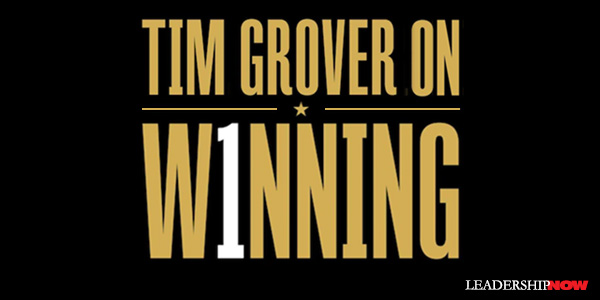
WINNING has its own language and its own code. And motivational talk isn’t part of it. Sports trainer and mindset expert to Michael Jordan, Kobe Bryant, Dwyane Wade, and others, Tim Grover (with Shari Wenk) provides a look at what it takes to perform at the highest levels in any field in Winning: The Unforgiving Race to Greatness. Grover says winning is uncivilized, hard, nasty, unpolished, dirty, rough, unforgiving, unapologetic, uninhibited, and everything. Results are all that matter. “Winning will cost you everything, and reward you with more.” For many of us, the problem is that winning is “trapped under a lifetime of fear and worry and doubt.” There are thirteen—equally important—characteristics of winning presented very candidly by Grover. The Winning Thirteen: WINNING Makes You Different, and Different Scares People Ask questions because if you do what everyone else is doing, you will end up like everyone else. “When you know what to think, you’re ready to compete. When you know how to think, you’re ready to win. Your education teaches you what to think. Life experience teaches you how to think.” I have one nonnegotiable: Performance. Everything contributing to that is open to discussion, as long as we arrive at the same end result. The one thing we’re not going to negotiate is anything that adversely impacts your performance. WINNING Wages War on the Battlefield in Your Mind All day, every day, your mental battlefield is attacked by blasts of adrenaline and anger and fear and anxiety, and other explosives too. Stress. Insecurity. Doubt. Envy. Winners can detect those bombs and defuse them before they can do any damage. Losers brace for impact and wonder how to clean up the mess. You need routines if you are going to win these battles and manage the distractions. The routines allow you to execute without rethinking. For Jordan, his routines allowed him the “mental freedom and clarity to focus on one thing: the complexity of the game, and manage every variable that stood between himself and a win.” WINNING Is the Ultimate Gamble on Yourself For leaders, like athletes, it’s not just the traits but how they are put together, and each person is unique. Winning is about having the confidence to gamble on yourself. Confidence is feeling as low as you’ve ever felt in your life, and knowing you’ll recover stronger than you were before. It’s hearing others tell you everything is fine, you’re perfect just the way you are … and knowing they’re wrong and you still have work to do. WINNING Isn’t Heartless, But You Will Use Your Heart Less Your mind is stronger than feelings. “You have to know when to turn your heart off, and your mind on.” You want energy. Focus. Intensity. You want to be alert and aggressive and strong. None of those are emotions, they are a state of mental power. You want your mind locked in, so you don’t even feel the nerves and the pressure that come with competition. WINNING Belongs to Them, And It’s Your Job to Take It Winning begins with you. “Should I go to the gym? Should I skip this donut? Can I get out of the house on time? Will I get my work done today?” Winning has no loyalty to you. No matter how long you’ve battled to become a winner, it takes one split second to become a loser. I know that’s a hard reality for a lot of people. They work so hard to get somewhere, and in an instant, it’s gone. They gave it up. Or more likely … someone took it. WINNING Wants All of You; There Is No Balance Focus and commitment. That means mastering the art of “NO.” If you give everything in your life equal weight, you are out of the race. Every time you say yes, every time you say maybe or not right now when you really want to say no, Winning rolls its eyes and looks for someone else. WINNING Is Selfish Winners don’t care what you think, they just need results. Selfishness is about separating yourself from the average—“to move from where you are to where you want to be.” But Grover notes, “separation doesn’t mean you cut all ties and refuse to cooperate. Collaboration and cooperation are essential in my business, and probably in yours too.” Selfishness means investing in yourself. Forget secret codes. “Invest in your education and your skills. There are no shortcuts, there’s no fast track.” WINNING Takes You Through Hell. And If You Quit, That’s Where You’ll Stay Winning is not a permanent destination—once on top, always on top. “It’s a never-ending cycle, not a one-way trip. You want to win? Start at the bottom and work your way up. Congrats, you won. You want to feel that way again? Go back to the bottom and work your way up.” Over and over. Resilience isn’t built in your comfort zone; it’s built in hell. And every time you go back you’re a little harder, rougher, less emotional, more scarred. WINNING Is a Test with No Correct Answers Resilience is a daily issue. We all have insecurity and a fear of failure. But Winners don’t let it hold them back. “Don’t allow your fear to escalate into uncontrollable doubt.” Fear shows up on its own. Doubt has to be invited. Fear heightens your awareness; it makes you alert. Doubt paralyzes your thinking. WINNING Knows All Your Secrets You aren’t alone. There are voices inside your head—especially at night when there is less to distract you. WINNING Never Lies You can’t fake winning. “Winning knows the truth. And it needs you to admit it. Because even if you can fool absolutely everyone else … you still know the truth.” If you can’t summon the desire and energy to make I, someone else will. WINNING Is Not a Marathon, It’s a Sprint with No Finish Line Every step is important no matter the distance. You keep going until it gets done. But… When you get to the finish, you should already see the next starting gate in front of you. WINNING Is Everything You have to put in the work now. Our opportunity to win is now. Each and every day, but time is limited. The biggest mistake we make in life is thinking we have time. Grover backs up each point with insights from his clients—especially Michael Jordan and Kobe Bryant. Winning defines the road less taken. 
Posted by Michael McKinney at 03:53 PM
06.02.21

Grace Notes: Leading in an Upside-Down World
IN Grace: A Leaders Guide to a Better Us, John Baldoni laid out a philosophy for better leading and living. Now in Grace Notes: Leading in an Upside-Down World, he reflects on the practical application of that philosophy. Over the course of the last year, he collected his thoughts on the response to the pandemic and its implications. Baldoni is a generous encourager. So, it is no surprise that he shares with us practical positive thoughts. These notes touch on many elements of what it means to be a good citizen, a friend, and a leader. Here are several that stood out for me: KINDNESS
To be thinking of one another
ABUNDANCE
Abundance is rooted in Grace.
All of us have something we can share.
MAKING PERSONAL CHANGE
My philosophy is anchored in the notion of Grace,
GENEROSITY
He shares this mandate for leaders—Leadership Now: STEP TO THE FORE
Offering over 60 notes, Baldoni reflects on many qualities that are central aspects of grace like patience, kindness, and respect. He also writes about anxiety, managing doubt and discouragement, and how to make this our finest hour. You will finish this little book inspired to be a better person. 
Posted by Michael McKinney at 12:00 AM
05.28.21

Always End with the Beginning in Mind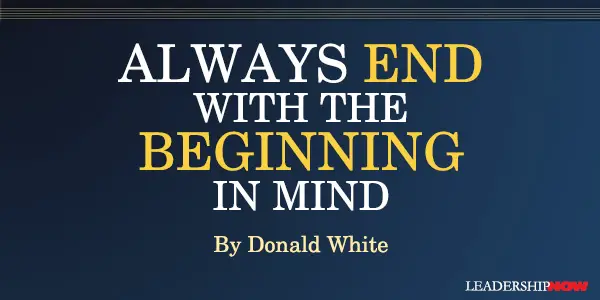
AS the Baby Boomers continue to age, business continuity and succession planning are on everyone’s radar. Take, for example, the financial industry: the average age of financial advisors in the U.S. exceeds age 50, and less than 12 percent of advisors are under the age of 35. In my observation, among the most successful advisors, the median age is even higher. The number of financial advisors who die or are limited by medical issues while still practicing is reaching an epidemic. An estimated 40 percent of today’s advisors will exit by the end of the 2020s, whether the advisors like it or not. Consequentially, this has piqued the industry’s interest for many years. Shoemakers, Fix Your Own Shoes! Advisors pride themselves on asking clients the hard questions about business continuity and succession. Consequently, it’s routine to ask clients:
For most business people, their single largest asset is their business, and what becomes of their largest asset is a huge deal. They’re asking themselves:
Everyone knows that there’s only one thing certain in life: everybody dies. Making provision for death, disability, and retirement is simply not optional. Unless I guess you’re a financial advisor! While advisors love to discuss business continuity with their customers, as a group, they do a horrible job of advising themselves. It’s a classic case of “shoemaker fix your own shoes” where a personal succession plan is apparently on tomorrow’s to-do list. Recently I had a discussion with an older colleague. I asked him what would become of his firm if he died, became disabled, or decided to retire? While not completely ignoring the first two possibilities, he pounced on the idea of retirement, saying, “Retire? I’m having too much fun to retire! Besides, most people who retire are either dead or disabled a year later anyway.” Sadly, my friend represents a significant percentage of advisors today who think they’ll somehow cheat fate and work forever. My first mentor told me, “Always do what’s in the best interest of the person sitting in front of you, and your interest will always take care of itself.” While I find most great businesspeople believe in this adage as it applies to the way they treat their customers, it doesn’t necessarily carry over to the way they treat their own businesses. Could intentionally building a business to have it continue into perpetuity be in the best interest of the clients, the employees, the successor, and the founder? What if, in executing a succession plan, everyone wins? The Cream Rises Until It Sours Back in the 1960s, Laurence Peter, a Canadian sociologist, wrote The Peter Principle. What Dr. Peter’s research found was that just because an employee stands out in one position doesn’t mean he or she will excel at another. In fact, employers frequently elevate people with what Peter famously called a promotion to their “level of incompetence” and suffer the inevitable consequences associated with the decision. They often simply don’t possess the skills needed to succeed in their new position. It’s not so much a case of the person being incompetent, but rather they are not suited for the role. One of Peter’s famous statements was, rather than cream rising to the top, “cream rises until it sours.” This can lead to organizations becoming almost entirely filled with people inadequate for the tasks they’re assigned to fulfill. Too many good advisors aren’t particularly good businesspeople. Their advisory skills don’t necessarily translate into an ability to lead and build organizations with the proper infrastructure to continue beyond themselves. Every advisor needs to examine whether he or she is the soured cream keeping the firm from being able to thrive for the long-term. The Goldilocks Dilemma Most of us are familiar with the tale of Goldilocks and the Three Bears. When Goldilocks eats from three bowls of porridge, one is too hot, one is too cold, one is just right. The problem is that no one can know for certain when an exit is just right. Indeed, when it comes to exiting a business, you can either leave too soon or you can leave too late. “Just right” is simply not an option. Because too soon and too late are the only real options, the question is, how do you choose between two imperfect alternatives? The answer is to leave too soon because leaving too late is disastrous. However, leaving too soon is the difficult choice because, at least on the surface, you wonder if you’d have been better off waiting. That is the Goldilocks Dilemma — you can never know if the timing is just right. My advice is to end with the beginning in mind. Allow your firm to become even greater after you depart by putting the right people and systems in place that will allow the firm to be even greater with each successive generation of leadership. I exited my company in 2019 and have watched how, even amid a pandemic, everyone has prospered. Indeed, my successors grew the firm by nearly 25 percent in 2020. Our clients and employees love my successors and have shown how much they appreciate the transition. Meanwhile, my life has never been better as I write and teach. Be Fearless! Succession planning can be challenging for numerous reasons, but the biggest challenges are usually internal, not external. James Clear, in his book, Atomic Habits, describes three levels of behavior change. The first level is outcomes. The second is changing your process. However, the deepest level is changing your identity or what you believe about yourself. Most succession plans focus on outcomes or selling the business without considering identity — or who they see themselves as internally. This leads many to a fear the succession process and becomes the root cause of moving the subject to tomorrow’s to-do list. The best advisors find their identity in their businesses. The thought of not being an advisor is anathema to them. As a result, their greatest fear is deciding who they are if they’re not an advisor. A friend of mine sold his business to his hand-picked successor. While the business outcome was great, internally, he was a mess. Without his agency, he lost his identity. This past year he started another agency because, in truth, he couldn’t re-identify as anything other than an agent. While no one can say what the best business succession solution is for any organization, be open to the myriad of possibilities there are in succession planning. Take it off tomorrow’s to-do list. Create a succession plan that looks out for everyone’s best interest — in which everyone wins. Indeed, if it’s not a win-win, call the whole thing off. Remember, you can exit too early or too late, but waiting until the time is just right is fool’s gold. Most of all, be fearless.  
Posted by Michael McKinney at 03:40 PM
04.09.21

Mayday! Mayday! How to Build Trust in a Crisis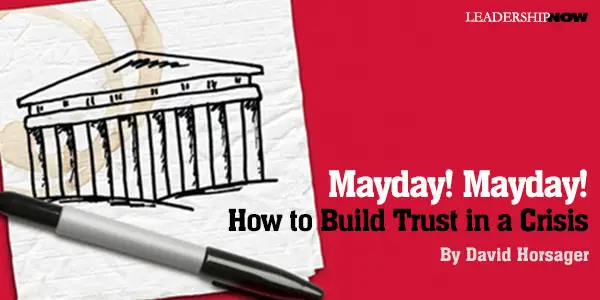
NOTHING reveals an organization’s limits more than a sudden crisis. And after 2020, we’ve all become more familiar with what that looks like. Crisis situations test what you have built — your culture, your relationships, your resilience. But at the root of all of these challenges is one capacity that means the difference between success and failure: trust. Trust is your most important asset amidst crisis and change. A team with high levels of trust will have the agility necessary to make decisions and react quickly to fluctuating situations. Building Trust Instantly The beautiful thing about trust is that it will help you through a crisis even if you start to build it the day things go off the rails. In fact, your quickest opportunity to build trust is in a crisis. On 9-11, complete strangers trusted each other in an instant if they were running in the same direction. To some degree, trust is built up over time, but your ability to build trust multiplies in a crisis. Building trust consists of strengthening eight traits (also called pillars) that came out of research on what makes the most effective leaders and organizations. Take a look at the pillar of clarity for example. Clarity increases trust instantly. It’s almost impossible to trust a leader who is vague or who gives insufficient information. But be crystal clear in your words and your actions, and trust will immediately increase — especially in the middle of a crisis. This three-point strategy prioritizes clarity and provides a roadmap that you can use over and over in any crisis. 1. Narrow your focus to a single priority. When the unexpected hits, everything feels like a priority. But it’s actually the opposite; in a crisis, it’s essential to address only one priority at a time. Ask yourself these two questions to help guide your actions: first, ask “What can I control?” It’s tempting to focus on barriers, but the only thing that matters in a crisis is what you can control, not what you can’t. The second question to ask yourself is “What is the one, most important thing that I can do, right now?” That’s your priority. Designating only one priority means your team will be able to follow through. There’s nothing that builds clarity more effectively than aligning a team around a single, achievable priority. When your team knows exactly where to focus its efforts, trust in your leadership will grow. 2. Compress your plan into short blocks. In a conversation with Gen. McChrystal (best known for his leadership of the US Army Joint Special Operations Command), he shared that when the war in Afghanistan took a turn for the worse, they weren’t able to quickly get the intel they needed. So instead of planning weeks ahead, they set 30-minute daily meetings to define a daily priority. What could this look like in business? Often leaders set a one-year priority, but in a crisis the pace of change means you may need to set a one-month, one-week, or even a one-day priority for your people to follow. In any crisis, task completion is a crucial benchmark because momentum builds momentum. Narrow your priority to something that can be completed in this short timeframe, or shorter! After a week, the situation may have completely transformed. A doable goal also facilitates engagement and optimism. When people know absolutely that their efforts are aligned with a larger plan, they won’t have to waste precious time second guessing or asking for approval. Nothing solidifies trust like a reliable pattern of completion. And the more trust increases, the more smoothly and quickly your operation can run. 3. Maintain agility. Responding to a crisis requires speed, but it also requires flexibility and agility. The situation will change constantly and on a massively accelerated timeframe. The ability to take in information, adjust, and pivot to a new direction is crucial. Once you’ve completed one priority, you need to be able to identify and shift to the next one. The ability to reassess a situation and pivot quickly is just as important as narrowing to a single focus. Leaders must be actively engaged in this process, taking their teams from start to finish, then circling back around to repeat the process. Making it through a crisis unscathed requires organizations to be able to identify, complete, and move on from tasks at a rapid clip. A high trust organization will always be able to move more quickly and maintain solid footing. And nothing facilitates trust better than crystal clear communication. Once you start, clarity builds on itself, and as clarity increases, trust grows exponentially in your leadership and in your business.  
Posted by Michael McKinney at 12:52 PM
03.22.21

Everyday People, Extraordinary Leadership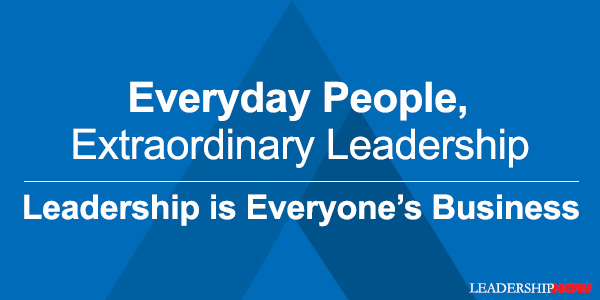
LEADERSHIP is a mindset—a way of approaching life. It is about how you behave and what you do. It can be taught and then tested and refined in practice. We all have a responsibility to lead in the context we are in. James Kouzes and Barry Posner emphasize this point in Everyday People, Extraordinary Leadership. The book is about what “individuals do to effect change and improvement.” Most leaders do not have titles. And this book is written for them – those people who can and should lead “without the benefit of hierarchical position and rank.” To help you develop confidence and grow as a leader, the authors present an operating system of leadership practices based on their time-tested Five Practices of Exemplary Leadership. Together they define what leaders do. Leadership is fundamentally about your relationships, your credibility, and what you do. Leadership has everything to do about how you behave. The authors share the personal stories of ordinary people who stepped up and behaved as informal leaders. When you read these stories of people from all walks of life who lead at their personal best, they demonstrated a common set of behaviors and actions that the authors have grouped together in the Five Practices: Model the Way
Modeling the Way begins with knowing and being able to articulate your values. But good leadership goes beyond that. “Successfully leading others requires an understanding and affirmation of shared values—the principles that can galvanize and strengthen collective commitment.” Inspire a Shared Vision
To follow your vision, people must see how they can make it their own. You must understand the hopes and aspirations of those you are involved with. You must breathe life into visions, not only by your own enthusiasm and expressiveness but by listening to and communicating the hopes and dreams of others so that they clearly understand how their values and interests will be served. Challenge the Process
Be willing to experiment and learn from your mistakes and setbacks. Identify and remove self-imposed constraints and organizational conventions that block innovation and creativity. Enable Others to Act
You strengthen others when you make it possible for them to exercise choice and discretion, when you develop in others the competence and confidence to act and excel, and when you foster the accountability that compels action. Encourage the Heart
By paying attention, offering encouragement, personalizing appreciation, and maintaining a positive outlook, leaders stimulate, rekindle, and concentrate people’s energies and drive. Encouragement is more personal and positive than other forms of feedback, and it strengthens trust within relationships. The behaviors associated with the Five Practices are not gender, race, or context-specific. Anyone can put these practices into action in their lives and lead with their best selves. Leadership begins by working on you. Start by believing that you can make a difference right where you are and by practicing these behaviors deliberately in your context. It will change you, and you can then make a difference in other people’s lives. 
Posted by Michael McKinney at 10:31 PM
03.09.21

The Seven Tests of A CEO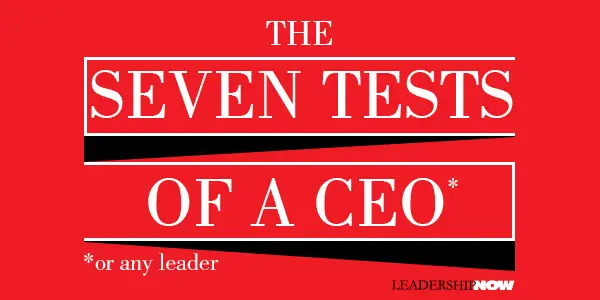
WHAT are the critical challenges that can make or break a leader? In The CEO Test by the always insightful Adam Bryant and by the former Amgen president and CEO Kevin Sharer, they present seven tests that really all leaders face in one form or another. They call it the CEO test because the intensity and consequences of these challenges grow as you move into higher levels of leadership. As a result, these challenges are brought into their sharpest relief and thereby provide the richest lesson for anyone aspiring to lead better. They believe that “to succeed in a leadership role, you have to achieve a certain threshold level of proficiency in each of the skills” highlighted in these seven tests. So, they are worth reflecting on no matter what context you lead in. The best leadership advice, after all, helps slow the game, so that you can better anticipate, understand, and label the nuanced dynamics of different situations in the moment and then guide them to better outcomes. Test #1 Can You Develop a Simple Plan for Your Strategy? This test begins with the ability to crystalize the issue or idea in simple terms and then create a clear, galvanizing plan to get everyone moving in the same direction. The simple plan should “address two questions that every employee deserves to have an answer to: What should I be working on? Why is it important?” Bob Iger of Disney writes: If you don’t articulate your priorities clearly, then the people around you don’t know what their own should be. Time and energy and capital get wasted. You can do a lot for the morale of the people around you (and therefore the people around them) just by taking the guesswork out of their day-to-day life. Two great questions to ask: “What three or four things that, if we accomplish them over the next twelve months, will make this a good year?” and “What are the areas that are going to get new or greater focus to achieve the outcome?” Test #2 Can You Make the Culture Real — and Matter? How are we going to work together? Building a strong culture is a critical test for leaders. “Done right, culture will engage something deeper within employees’ sense of themselves, ideally in ways that are aligned with business goals.” Robert Johnson, co-founder of Black Entertainment Television said: Culture is almost like a religion. People buy into it and they believe in it. And you can tolerate a little bit of heresy, but not a lot. If there are not clear and consistent guidelines for behavior, or if they are not reinforced and modeled every day by the top leaders, cultures can devolve into hives of dysfunction, insecurity, fear, and chaos. Test #3 Can You Build Teams That Are True Teams? This test brings us to four questions: What is the purpose of the team? Who should be on the team? How will the team work together? What is the leader’s role on the team? Teams need to evolve or grow with the times they are in. They need to have a “forward radar,” says the former CEO of Aetna, Ron Williams. “What you see is that some people aren’t evolving with the complexity of the business, and their ‘forward radar’ is diminished and keeps getting diminished.” Or as former CFO of the Disney Interactive Media Group, Bruce Gordon, puts it, “Very few people are bad at their job, but many are not as good as they must be.” We debate like we’re right, listen like we’re wrong, and then decide, commit, and lead together. Test #4 Can You Lead Transformation? The status quo is not an option. Even in institutions where the message never changes, the environment it is in does, and therefore delivery changes. The challenge is to disrupt yourself before you become obsolete. A couple of guidelines: Clarify what is not going to change, particularly mission and purpose, to make employees more open to new approaches for accomplishing their work. On the subject of what’s not going to change, The New York Times publisher, Arthur Sulzberger, says that it is important to separate mission from tradition. “Mission should never be tinkered with. You mess with mission at your own risk. Tradition needs to be constantly interrogated.” But he adds that you need to be very clear about your reason for being. “If everything is up for grabs, if you can change literally anything about a company, then the company has no reason for being.” Test #5 Can You Really Listen? How do you know what you need to know? The danger is walling yourself off from any kind of skepticism. Kevin Sharer, former CEO of Agmen, “It’s not just about listening to the person across the table from you. Listening is actually being alert to the whole ecosystem in which you operate.” You have to be able to separate the signal from the noise. “That’s not an easy thing to do because most of the communications that come to you are curated to have a pleasing tone.” Clue: “Watch how funny your jokes get.” Test #6 Can You Handle a Crisis? A crisis often emerges out of uncertain times. It can come from without and from within. If you have passed the first five tests, you are much more likely to better handle the next crisis. The particular challenge of leading in a crisis is to bring some predictability to moments of intense unpredictability and stress, when so much is on the line, including your own and your organization’s reputation. It is essential that the leader is visible because they set the tone that others will follow. It’s a good time to reimagine your organization. A crisis creates a rare opportunity to revisit long-standing assumptions about your organization. Ideas that may have seemed impossible to tackle are suddenly on the table. How well you survive a crisis is really determined by what you have done before the crisis. “Any weakness in your organization will be exposed and magnified. Your ability to handle a crisis will be a direct result of how well you led before the crisis.” That leads us to the next and final test. Test #7 Can You Master the Inner Game of Leadership? The other six tests were about things a leader must do. This test is about what a leader must be. As such, this test underpins the others. How well you master the inner game of leadership will help you in mastering the other six areas. Leadership is not easy, but Bryant and Sharer believe that if you understand it as a series of paradoxes, you will be better able to become the leader you need to be. They present seven: Be confident and humble
To make it about others, you need to acknowledge the pressures, keep your ego in check, focus on a few achievable goals, make yourself dispensable, and don’t forget to make the time to recharge yourself. 
Posted by Michael McKinney at 10:11 PM
01.25.21

Leadership U: The Six Degrees of Leadership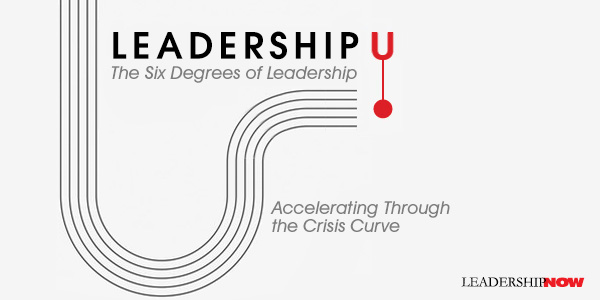
TO LEAD people from one place to another in good times and in challenging ones requires a framework like the one presented in Korn Ferry CEO Gary Burnison’s concise book, Leadership U: Accelerating Through the Crisis Curve. The framework is called, The Six Degrees of Leadership. These six degrees are mastered separately but work together in practice. Degree #1: Anticipate
Anticipating is 90% bottom-up and only 10% top-down. To anticipate, you need to make the hierarchy invisible. Take a total inventory across the organization as you listen for what people are thinking, feeling, fearing, and experiencing. Burnison says no matter the climate, the question is always, “What does this mean going forward?” Degree #2: Navigate
Impatience doesn’t get the job done. It inspires more fear than high performance, which can override critical thinking. Anybody who has gone into a skid on black ice can relate: your instinct is to slam on the brakes and jerk the wheel in the opposite direction. It takes a clear had to do the opposite—the counterintuitive—of steering into the skid to regain control. Degree #3: Communicate
When there is trust in what you say, there will be belief in what you do. That starts with modeling a “say/do” ratio of one-to-one. You do what you say and say what you mean. When you’re viewed as an authentic leader, people will not only trust your words and actions, they will also mirror what you say and do. Degree #4: Listen
What often can hold people back from giving honest feedback is the lack of perceived economic independence. Those over us control our resources. “Economic stability is the ultimate truth serum, and leaders need to recognize that.” As you listen, you need to distinguish between the urgent and the important. When a crisis hits, though, everything blurs as events and their implications constantly change. What’s important often becomes urgent, and the urgent becomes critical. You must delegate others to lead around a common purpose. Degree #5: Learn
The distance between your company and its competitors is not absolute; it’s relative. If you want to transform your organization, you must grow your organization through learning. Degree #6: Lead
In a world where so much has be reimagined, nobody has all the answers. This is not a time for individual heroism. It’s all about the team—and you need talented people around you. 
Posted by Michael McKinney at 07:46 AM
12.23.20

Acting with Power
WE need to think about power differently. Deborah Gruenfeld has been teaching a class at Stanford University that is the title of her book, Acting with Power. It is a tour de force on what power is, how it works, and how it affects every aspect of our lives. We all have power. The question is, what are we doing with it? Two statements she makes at the start caught my attention immediately: Success, impact, and life satisfaction are not the result of how much power you can accumulate, or even how powerful others think you are; they are the result of what you are able to do for others with the power you already have. These two statements set the stage for what follows. What Is Power? Simply stated, “power is the capacity for social control.” On a more personal level. “what makes someone powerful—what makes others willing to comply with their wishes—is the degree to which they are needed. Any person’s power depends entirely on the context in which power is being negotiated.” Power is not a feeling, and if you have to talk about it, you probably have very little of it. We can play our power up, or we can play it down. Both can be useful depending on the context and how we do it. “Pulling rank can be generous, or an expression of caring, when done by the right person at the right time.” As we see over and over in this book, the motive is the key. Sometimes you need to “power up because there will be times when other people need you to behave this way in order to protect their interests.” It lets people know, “I’ve got this.” Knowing when to power up or down is important to managing balance in a given situation. Playing power down often helps you to connect with others and pull them in. “Playing power down is not showing weakness. It is showing that we are strong and secure enough to take personal risks and put others’ interests ahead of our own.” Getting Good at Being Who You Are In one of her most important and practical chapters, she talks about a much bandied and misunderstood idea—authenticity—being yourself. Too often, people get the idea the authenticity means doing whatever feels right to me because it’s who I am. I’m being real. Frequently, that will backfire. In everyday life, we are acting, presenting an image of who we are. Being yourself is an act. We strategically choose costumes and props, manners of speaking and moving, and even which stages to appear on, not to trick people into believing falsehoods about us but to define ourselves and express a stable, coherent identity that keeps us grounded psychologically as we grapple with the messiness, self-doubt, and confusion that are an inevitable part of the internal experience. When we behave any way we want, any time we want, we are losing the plot. We are connected to others playing a part in their stories as they do in ours. So, we need to always consider our role on the stage we are on. When we don’t, we fail the people who depend on us. Losing the plot, like “going rogue,” describes acting in a way that is inappropriate because it does not fit the context and violates social norms in a way that is not helpful to anyone. In life, as in the theatre, the plot is the premise; it refers to the story like, the part of the given circumstances that defines what the actors have agreed to come together to do, and how they have agreed to behave while doing it. Power as A Follower All of us are subordinate to someone. If we are to be good in a supporting role, we first have to get our thinking right about it. If we can’t thrive in a supporting role, it means we have lost the plot if we ever really understood it in the first place. Gruenfeld says it requires a different level of commitment and a willingness to put someone else first. Your contribution must come first without regard to recognition. “It signals clearly that you care more about the art than about being known as the artist.” Well put. People who know how to support and follow understand leadership better. What is fulfilling, in life, is to serve a higher purpose in roles where you can have real impact—not just the ones that look good on a resume. And then there are times when we need to step into a more powerful role. Usually, the people who want power the most, are the least qualified to exercise it. One of the great ironies of power is that we seek leading roles in order to feel more secure and more in control, but then the joke is on us: we find that the moment we step into a powerful position is the moment we realize how little control we actually have. The thread that runs through the abuse of power is insecurity. And we all have them. Because of that, when placed in positions of power, “people act more readily on all kinds of impulses and approach all kinds of rewards that satisfy personal needs and desires, in ways that make the most sense to them, with less concern for the social consequences of their actions.” We know bad actors when we see them, but unfortunately, we have few role models to show us what it should look like. Gruenfeld examines some of the various types of bad actors and how we can best respond to them. She suggests that we use a different standard when choosing leaders rather than the dominant individuals we typically associate with leadership. If we used beneficence — “the capacity in a high-power actor to prioritize the welfare of less powerful others” — then a different kind of men and women would rise to the top. This suggests that to create organizations in which power is used effectively, it may be useful to cast people who have shown not just that they are capable of rising quickly but also that they are interested in the quality of their performances and are willing to do their time in a low-level position in order to learn, to hone their expertise, and to contribute (repeatedly) to something they care about. 
Posted by Michael McKinney at 12:29 PM
10.26.20

Leaders Who Lust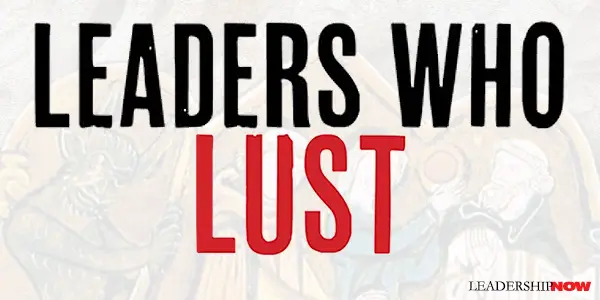
IN 2004, Barbara Kellerman wrote that “the idea that some leaders and some followers are bad, and that they might have something in common with good leaders and followers, has not fully penetrated the conversation or the curriculum” on leadership. And it should because it is true—the good and the bad are an inherent part of us all. Kellerman also rightly asserts in Bad Leadership that “Human nature is human nature, and that makes it inevitable that certain patterns of bad leadership repeat themselves.” And this brings us to Leaders Who Lust by Barbara Kellerman and Todd Pittinsky. Lust is a component of human nature. It is a human nature issue. It is innate, but it is not always acted upon. The determining factor is character—the character to bring the self under control. Lust is a fixation on the self. Kellerman and Pittinsky define lust as: “A psychological drive that produces intense wanting, even desperately needing to obtain an object or to secure a circumstance. When the object has been obtained, or the circumstance secured, there is relief, but only briefly, temporarily.” Their definition helps to separate it from determination and grit. The difference really comes down to motivation and closure. And no matter how many times a lustful leader might insist, “I’m doing it for the people” or “to do good for the world,” the “people” can see through the rhetoric to the selfish motivation behind it. They note that lust can result in good or bad outcomes. Leaders can harness their lust for the common good, or “leaders who lust can as readily harness their prodigious energies to foster murder and mayhem.” They cover six different types of lust that are the most indicative and important to leadership and two individuals that typify that form of lust. Power: the ceaseless craving to control. Examples: Roger Ailes and Xi Jinping Money: the limitless desire to accrue great wealth. Examples: Warren Buffett and Charles Koch Sex: the constant hunt for sexual gratification. Examples: John F. Kennedy and Silvio Berlusconi Success: the unstoppable need to achieve. Examples: Hillary Clinton and Tom Brady Legitimacy: the tireless claim to identity and equity. Examples: Nelson Mandela and Larry Kramer Legacy: the endless quest to leave a permanent imprint. Examples: Bill and Melinda Gates and George Soros While all of these examples are instructive and, in some cases, are cautionary, not all of these examples seem to fit the definition of pure, unadulterated lust. Some may have other issues driving their behavior. In any event, I always find Kellerman to be very insightful. When it comes to lust, the underlying issue is control—an attempt to bend reality to your wishes. In most cases, lustful leaders believe that they are doing right by pushing their agenda. When lust doesn’t get the results a leader wants, it is easy to point to some bias or prejudice, as the authors do in a few of the examples. And certainly, for some, it is a hurdle they must overcome, but further examination often uncovers other character flaws and abusive personalities undermining lustful leaders. Success often points to a degree of self-awareness where the leader has been able to consider their context and adjust accordingly. Some leaders who lust are fortunate. Depending on the object of their lust, on their level of self-control, on who are their followers, and on the circumstances within which they are situated, some leaders who lust can use it to good effect. By “use it to good effect” we mean that such leaders can meet one or another need or want of their own, if only temporarily, while simultaneously meeting one or another need or want of their followers. It does raise the question as the authors do, does moderation lead to mediocrity? The answer, of course, is no. They are two different issues. The fact that some succeed without moderation does not indicate causation. Sometimes a leader succeeds on the surface regarding their agenda in spite of their flaws, but they do pay a price. Lust is not taught, but it does exist in our human nature. That said, the example of a lustful leader can arouse others to follow in their footsteps in an effort to get what they want. Some of the lust lessons they enumerate are: Lust can and sometimes does overwhelm common sense—which is, however, not by definition a deficit. “Sometimes lust overtakes common sense with results that are not only positive, they are downright exciting. One could even argue that the great dreamers in history, the great movers and shakers, are not usually known for their common sense. Rather they are known for having driving passion and vaulting ambition—levels of passion and ambition that not only are not reasonable, that are downright unreasonable.” That unreasonableness may take them to new levels of achievement or understanding that was not thought possible. Lust is an inordinately powerful motivator—perhaps the most powerful motivator of all. “We primarily conclude that lust, as much as or maybe even more than anything else, distinguishes merely ordinary leaders from obviously extraordinary leaders.” Lust certainly drives people to perform in ways that are inspiring. The intense focus that lust can bring can move mountains. This leads us to the next observation. Leaders who lust generally are in control, not out for control. “Lustful leaders do not usually behave in ways that are beyond the pale—they are not crazy. Generally, they channel their drive; if they did not, they would increase their chances of being ousted.” This is true in almost all cases as long as that leader feels they are moving forward. But leave them with no rational alternatives, and they often resort to unethical, outlandish behaviors to de-escalate the dissonance building up in their own mind. We admire lustful leaders for their drive and discipline. The difference between lust and drive is closure. With lust, the self is never satisfied—the goalpost keeps moving further on. The challenge for us is to know where drive ends, and lust begins. At what point does pushing our own agenda become destructive and what is it we are really after. Self-examination is key if we are going to avoid the pitfalls of lust. 
Posted by Michael McKinney at 01:11 PM
10.21.20

Three Questions We Have of All Leaders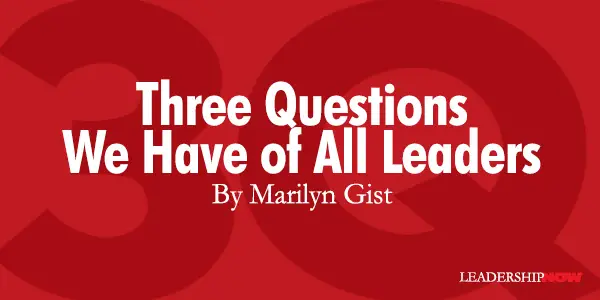
WHENEVER we work with leaders, we have our own important worries—things like fairness, the amount of change we’re being asked to embrace, and our own personal goals. When you think about it, we have three prime questions when facing any leader. Whether they’re asked aloud or merely observed, we evaluate leaders on these questions when deciding whether we want to follow along and to what extent: Who are you? Where are we going? Do you see me? Because leadership requires working together, it’s important for leaders to demonstrate humility (feeling and displaying deep regard for others’ dignity) to create healthy working relationships. Let’s look at how humble leaders provide positive answers to the three prime questions people have. Who are you? When people first meet us, they want to know who we are. This natural curiosity applies to leaders in a more penetrating way because leaders have power and influence. Two of the most important aspects of who you are that affect others’ dignity are how your ego appears when you interact with people and the level of integrity you display. Ego is commonly defined as our opinion of ourselves, especially of our own importance or ability. We notice whether leaders emphasize or minimize the status difference between us. Leaders with a balanced ego are aware of their power but confident enough in themselves that they prefer to minimize its unnecessary display. In contrast with a balanced ego, leaders who display high ego tend to emphasize their status around others. They may even display arrogance, such as boasting about achievements, name-dropping, or being condescending to others. Their behaviors can harm others’ dignity by hoisting their own sense of self-worth above that of others. Integrity means being honest and having strong moral principles by behaving in ways that reflect a high standard of personal conduct, not only in work but also in our personal lives. In the context of work, integrity implies that the leader is authentic and honest in communication, ensuring that actions are consistent with words. This includes timely responses to inquiries and follow-through on appointments, and expected communication. It allows others to trust the leader to guide them well. Where are we going? People also want to know about the direction a leader is setting. Remember that leaders need to convert many types of stakeholders into followers, whether they’re peers, customers, employees, suppliers, legislators, or community citizens. Setting direction well means establishing a compelling vision and ethical strategies. Although business leaders are rightfully concerned with competitive advantage and profitability, employees and customers typically have other concerns or priorities. People want to feel proud of both the work they do and the cause(s) they serve. Visions are compelling when they serve a greater good. Strategies are designed as the best paths to desired outcomes, but some leaders engage in unethical practices. There are news reports of leadership misdeeds almost daily; leaders who pursue unethical approaches display a significant lack of regard for the dignity of others. Instead, people want to know that the way their organizations operate is ethical. Ethical strategies can be developed by carefully understanding business opportunities and aligning others to pursue those approaches. Leaders who do this respect others’ dignity. Some of the best strategies used by humble leaders involve competitive pricing, fair employee compensation, collaboration and integration of operations to minimize waste, and alignment of direction across the organization in ethical pursuit of business opportunity. Do you see me? “Do you see me?” may be the most critical question people have when asked to work with a leader. It implies: Do I matter to you? Am I merely a pawn for you to use in achieving your goals, or do you care about me as a person with my own interests and needs? How you treat people matters, and two of the most important behaviors are generous inclusion and developmental focus. At its simplest, inclusion means inviting people to be part of the real action. Inclusion goes far beyond calling people together for staff meetings that simply provide face time or share routine reports. Instead, generous inclusion requires thinking about whom you’re engaging, on what activities, and in what way—and genuinely inviting people to contribute to key decisions. This requires careful listening. It’s also an important part of embracing organizational diversity. Developmental focus implies long-term thinking. The power you hold can be used to support others’ growth, neglect it, or sabotage it, and people are aware of this. Your role as a leader can and should involve helping others learn in many ways, such as understanding the values of your specific organizational culture, how to do their job better, and how to improve their knowledge, so they have a better chance to advance. Creating a Healthy Workplace The most promising path to optimizing organizational performance is to get people to put their very best energies behind a shared plan. Getting this type of alignment is easiest when people feel inspired by their leader. What leaders say and do is scrutinized, and their behavior answers the three prime questions others have. When the answers are favorable, people grow inspired, are eager to join in the quest, and give it their all. Leader humility has a lot to do with how productive we will be together. Therefore, leader humility has a lot to do with how effective a leader can be.  
Posted by Michael McKinney at 11:46 AM
10.07.20

Five Qualities Genuine Leaders Have in Common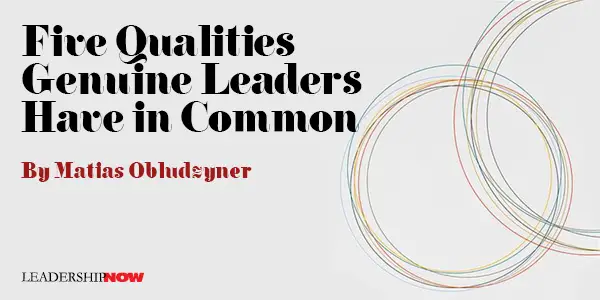
COVID-19 reminds us that we live in a world full of uncertainty—and this will continue well beyond the pandemic. But it only intensifies something we were already seeing in the world of work: organizations need to adapt constantly to keep up with market dynamics. Unfortunately, this can take a toll on employees if businesses focus on efficiency but don’t create an environment where people feel they belong. And with today’s digital economy and globalized markets making organizations more and more decentralized, it’s getting harder than ever for workers to create meaningful relationships with others. A recent MIT study underscores this. It surveyed top professionals from more than 120 countries about the skills needed for effective leadership in the decade ahead. It found that even more than in the past, leaders need to articulate a clear vision and strategy and provide a sense of shared purpose. Employees are expressing this, too. Millennials and Generation Z crave purpose as well as ethical behaviors from their bosses. We saw that when more than 32,000 students in France signed a pledge to work for environmentally conscious companies, or when thousands of Google employees signed a letter protesting the company’s involvement in a government program that uses artificial intelligence to enhance military tactics. Today’s workers also want autonomy and empowerment. They look for a work environment where they can decide how the job gets done. A Gallup study of the American workforce found that 42 percent of Millennials would switch to a job that allows them to work independently on a project of their choosing, and 63 percent to a job that allows them flexible hours. This kind of workplace demands a different kind of leader: people who follow their inner convictions and passions, and who engage with others in an authentic and open way. Leaders who behave like this are especially well-positioned to make a difference—let’s call them genuine leaders. They have a deep understanding of themselves, including their values, ambitions, and goals. They also lead with generosity: they care about others and empower their teams to fulfill their own ambitions. These leaders show you who they are as human beings, rather than hiding behind a mantle of power. They are not afraid to share their personal stories in a way that resonates with others and are able to shape a collective narrative that fosters trust and a common purpose—enabling others to find meaning in their own work. When people work alongside genuine leaders, they become more willing to give their whole hearts and minds to the mission. They feel motivated to work with others, to innovate, and to strive for extraordinary results. For my new book, The Expanding Circle, I interviewed three dozen genuine leaders across industries. While each of them has their own unique style for getting the job done, we can distill five common themes: 1. Achieving clarity of purpose. Genuine leaders have a deep understanding of their values, ambitions, and goals, and project their true selves for all to see. This self-awareness helps them lead with confidence and share their true passion and commitment. This authenticity helps create trust with others. It’s also critical to ensuring collaboration. 2. Crafting a genuine personal story. Humans are hardwired to learn through storytelling. By sharing a personal story that reflects their values and convictions, these leaders help others understand who they are and what they stand for. A story that resonates with others helps build trust and establishes a common ground for working together. 3. Seeking to understand others. Many people rely on their past experiences or even “intuition” to guess what others want. But intuition is a shortcut—and not a particularly good one. Genuine leaders spend time listening to others, asking questions, and exchanging ideas. They avoid prejudging others, which allows them to really see the people they are trying to reach—who they are and what they care about. 4. Shaping a shared narrative. Based on this deep understanding of others, these leaders develop a shared narrative, providing a common purpose and strategic direction: where we need to go, why it matters, and how we’re going to get there. This kind of narrative establishes a framework for teams to work together. 5. Empowering others. Fundamentally, these leaders see their role as creating the right conditions for all team members to take the initiative and contribute their best. They don’t try to micromanage or impose their own working style. They set the strategic direction and trust their team to get things done. And they create space for others to find purpose for themselves and develop their full potential. As we move into this new decade, we need leaders who can tune in fully: to themselves, to others, and to the world around them.  
Posted by Michael McKinney at 08:56 AM
06.17.20

The Infinite Game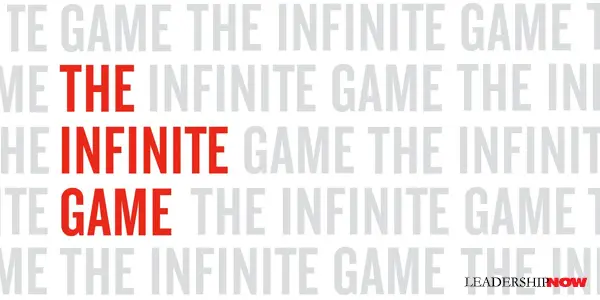
IN 1986, Professor Emeritus of history and literature of religion at New York University, James P. Carse, wrote a book entitled Finite and Infinite Games: A Vision of Life as Play and Possibility. He stated that there are two kinds of games. One could be called finite, the other infinite. A finite game is played for the purpose of winning, an infinite game for the purpose of continuing the play. Carse writes that a finite game will come to an end when someone has won. Only one person can win at the end of the game, and other players may be ranked. In contrast, in an infinite game, “players cannot say when their game began, nor do they care. They do not care for the reason that their game is not bounded by time. Indeed, the only purpose of the game is to prevent it from coming to an end, to keep everyone in play.” And Carse makes this important observation: “Finite games can be played within an infinite game, but an infinite game cannot be played within a finite game.” Intrigued by this concept, Simon Sinek builds on Carse’s idea in The Infinite Game. If there are two kinds of games, it is important to know which game we are playing. “We are more likely to survive and thrive if we play for the game we are in.” Sinek reminds us that we don’t get to choose what kind of game is being played. But we can choose if we want to play and whether we will play it with a finite or an infinite mindset. In business, playing with an infinite mindset means building an organization to last well beyond our own leadership. It is the long game. Built to last organizations are both stable and resilient. An infinite-minded leader does not simply want to build a company that can weather change, but one that can be transformed by it. They want to build a company that embraces surprises and adapts with them. Resilient companies may come out the other end of upheaval entirely different than they were when they went in. Sinek states that any leader playing with an infinite mindset must follow five essential practices: Advance A Just Cause A Just Cause is our picture of the future—where we are going. A Just Cause must be for something (affirmative and optimistic), inclusive (open to all those who would like to contribute), service-oriented (for the primary benefit of others), resilient (able to endure political, technological and cultural change), idealistic (big, bold and ultimately unachievable). A Just Cause is more than a goal. And this speaks to Carse’s thought that a finite game can be played within an infinite game, but an infinite game cannot be played within a finite game.” Sinek notes, “It’s easy to mistake a BHAG (big, hairy audacious goal) for a Just Cause because they can indeed be incredibly inspiring and can often take many years to achieve. But after the moon shot has been achieved, the game continues. Simply choosing another big, audacious goal is not infinite play, it’s just another finite pursuit.” But the Just Cause does provide the framework for a series of goals that ultimately advance the Just Cause. We need to rethink our relationship with business. We are stewards. “Shortsightedness is an inherent condition of leaders who play with a finite mindset.” Build Trusting Teams Trusting teams are characterized by the team member’s ability to feel free to express themselves—to be vulnerable. Groups of people who simply work together are transactional in nature, motivated by a desire to just get things done. But there is an element of fear—fear of missing out, being mocked, getting in trouble, looking stupid, and not fitting in. Fear is such a powerful motivator that it can force us to act in ways that are completely counter to our own or our organization’s best interests. Fear can push us to choose the best finite option at the risk of doing infinite damage. And in the face of fear, we hide the truth. Ethical fading, a condition that allows people to act in unethical ways to advance their own interests, is the result of a finite mindset. And these kinds of problems are not solved by more rules and processes, but by the application of an infinite mindset. Study Your Worthy Rivals In a finite game, it is “us” against “them.” We see a competitor to be beaten. “If we are a player in an infinite game, however, we have to stop thinking of other players as competitors to be beaten and start thinking of them as Worthy Rivals who can help us become better players.” There is a strategy for picking a Worthy Rival. We choose them “because there is something about them that reveals to us our weaknesses and pushes us to constantly improve … which is essential if we want to be strong enough to stay in the game.” Prepare for Existential Flexibility While finite minded players fear surprises and disruption, the infinite minded player is transformed by them. “Existential Flexibility is the capacity to initiate an extreme disruption to a business model or strategic course in order to more effectively advance a just cause.” Sinek shares a great example of Existential Flexibility through the evolution of Walt Disney’s Just Cause. Walt Disney Productions had enormous success releasing Snow White and was a great place to work, until it went public. Things began to change as it became more finite and less infinite in approach. So, he founded a parallel company named WED and began work on Disneyland with an infinite mindset. Disney explains: Disneyland will never be finished. It’s something we can keep developing and adding to. A motion picture is different. Once it’s wrapped up and sent out for processing, we’re through with it. If there are things that could be improved, we can’t do anything about them anymore. I’ve always wanted to work on something alive, something that keeps growing. We’ve got that in Disneyland. Show the Courage to Lead Leading with an infinite mindset is not easy. “Adopting an infinite mindset in a world consumed by the finite can absolutely cost a leader their job. The pressure we all face today to maintain a finite mindset is overwhelming.” Maintaining an infinite mindset is hard. Very hard. It is to be expected that we will stray from the path. We are human and we are fallible. We are subject to bouts of greed, fear, ambition, ignorance, external pressure, competing interests, ego … the list goes on. To complicate matters further, finite games are seductive; they can be fun and exciting and sometimes even addictive. The Infinite Life Is Service Our life is finite but played in the infinite game of life. But we can play it with an infinite mindset or a finite mindset. If we choose to lie our lives with a finite mindset, it means we make our primary purpose to get richer or promoted faster than others. To live our lives with an infinite mindset means that we are driven to advance a Cause bigger than ourselves. We see those who share our vision as partners in the Cause and we work to build trusting relationships with them so that we may advance the common good together. We are grateful for the success we enjoy. And as we advance we work to help those around us rise. To live our lives with an infinite mindset is to live a life of service. We are stewards. 
Posted by Michael McKinney at 11:47 PM
04.29.20

The Grace to Show Respect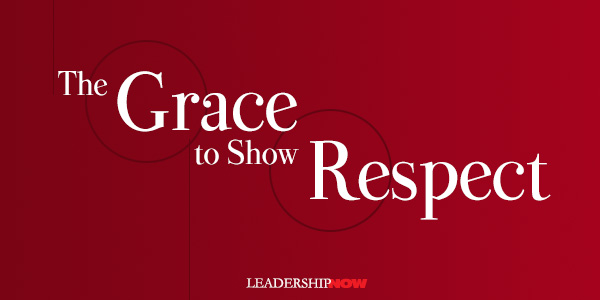
IF WE are to be successful, we need to collaborate. We don’t have the whole story. Collaboration is founded on a bedrock of respect. John Baldoni writes in Grace: A Leader’s Guide to A Better Us, “Our culture has become more coarsened. The rancor in our political system, fueled as it is by people who do not want to listen to one another, paralyzes so much of our public discourse.” It is difficult to find a voice today that is not hindered by personal biases, political affiliations, pandering, sarcasm, and name-calling. We all need—and leaders, especially—a good dose of grace. We stop listening when we think we know all there is to know, and we are convinced we are right. We believe that belittling other’s ideas that are in opposition to our own becomes a necessary step in protecting our own views. Instead, ask yourself, Why are they making that choice? Tom Peters wrote in The Little Big Things, “Connect! Listen! Get the Story! (Remember: Everyone [every single one] has a story.)” In a time of crisis, we have to remember that not only do we not know everything, but those we look to for answers, don’t know everything. We have to assume, as former CEO and Chairman of Aetna Ron Williams advocates, positive intent. We must assume that others are motivated by positive intentions. He writes in Learning to Lead that assuming positive intent is an “empowering strategy that disarms defensiveness and turns potential enemies into allies. If there’s something that will make you feel really good to say—something you are itching to say—don’t say it. Blowing up in the face of provocation is a way of losing power, not of claiming it.” Peters goes further to say that he’s “stuck on, hooked on, wedded to,” the word thoughtfulness. Thoughtfulness is “transactional,” and it “applies literally to every internal and external activity, as well as being something that resides deep within.” He adds that thoughtfulness speeds things up and reduces friction, and “it abets rather than stifles truth-telling.” And it matters most when there is disagreement. Change management consultant Paul Meshanko, writing back in 2013 in The Respect Effect, perfectly describes the mental process through which we arrive at, and justify our disrespect of others:
In the heat of the moment, when faced with vastly divergent opinions and approaches, it is difficult to remember thoughtfulness, positive intent, respect, and grace. It is easy to give another respect when they are respectable. It’s another thing to give it when they are not. When we are in that situation, it requires that we call up something much deeper from inside ourselves. Grace is giving something of ourselves to others though it is unearned or undeserved. Demonstrating grace, like forgiveness, kindness, service, and respect, says more about who we are than who they are. It is about us, not them. Grace, says Baldoni, “enables us to take the higher road, to think more clearly.” In our times, that’s what we need. That’s true leadership.
Posted by Michael McKinney at 12:02 AM
04.03.20

Are You Ready for Recovery?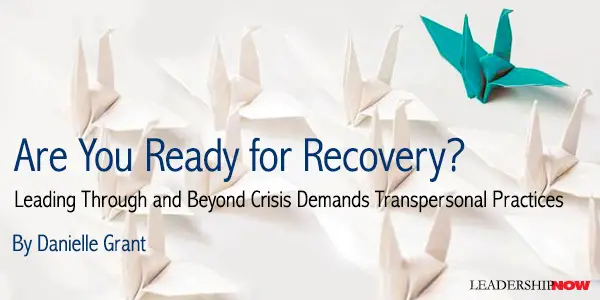
AS a McKinsey & Company article stated in late March 2020: “What leaders need during a crisis is not a predefined response plan but behaviors and mindsets that will prevent them from overreacting to yesterday’s developments and help them look ahead.” McKinsey cites 5 practices or mindsets that will enable leaders to bring their organizations through any turbulent times. This article will show how those who develop as transpersonal leaders are those who are best prepared to do this. Transpersonal Leadership is a concept that my colleagues and I at LeaderShape Global have been developing for over 10 years. It is an approach that was born out of many years’ experience as corporate leaders ourselves and our experience developing organizational leaders using Emotional Intelligence approaches. We realized that leaders could be emotionally intelligent but also manipulative and self-serving. This phenomenon is driven by excessive egos that want power, prestige, recognition, and reward. While there is nothing wrong with these drivers, per se, when they are the dominant force in decisions, rather than the needs of the organization and its stakeholders (including the community and the planet), then the problems arise. This is when the incidence of corporate scandals increases, as we have all seen in recent years. A Transpersonal Leader operates beyond their own ego and personal drivers and balances the needs of all the organization’s stakeholders. This means they are making decisions in full consciousness of their sense of purpose, ethics, and values. Mindset This approach self-evidently enables a mindset that offers a long-term perspective. Because, if leaders are balancing the needs of stakeholders in a values-conscious way, they will not cut corners or put short term gains at the forefront of decisions. This meets the need to slow down and not overreact. It naturally gives them the tendency to look ahead at or beyond the immediate horizon. It also means that leaders whose ego is not in the driving seat will have the humility to appreciate that in a crisis (especially), they do not have all the answers and that Leadership and decision-making needs to be distributed to those who have the best knowledge and information. Those who are driven by their ego, for example, will take center stage and proclaim to have the answers, ignoring or side-lining the experts who could give a more realistic assessment of a situation, managing people’s expectations. The leader who is transpersonal will value the expertise of those around and enable that to be disseminated to achieve the best outcome. “During a crisis, leaders must relinquish the belief that a top-down response will engender stability.” —McKinsey Involve More People The next area to consider is the crucial importance of distributed Leadership, which follows naturally from the transpersonal perspective. To explain further, in a crisis, using diverse perspectives enables the unthinkable to be brought to the table, it avoids groupthink and enables more effective solutions. One way to devolve leadership in times of crisis is through the organization of a network of teams that can tackle discrete responsibilities and are empowered to communicate with each other to create a complete picture before coming to decisions. Decisions that they are authorized to take. That’s right, without a need for approval from the top. To achieve this requires not just the humility previously referred to but also transparency, trust, and effective communication. A transpersonal leader has travelled a road where these attributes have been developed, alongside a honed appreciation of how to improve judgment and decision making. The transpersonal leader learns that we have 5 decision-making processes, of which only one is conscious. Harnessing and bringing into greater awareness, the processes that lie below consciousness enables them to detach from their emotional reactions or unconscious biases. This allows them to take a pause, stand back and allow the distributed responsibilities to be exercised by teams that they have assembled, using all these capacities.
So, the transpersonal leader can use their own touchstone of values and self-determination to have the confidence in backing decisions and making any tough calls along the way. Such a leader will appreciate the level of thinking from empowered teams of experts. This shared understanding of how well-considered decisions are made results in both sides trusting the other. The environment of psychological safety and optimism which follows from these principles, becomes an underpinning enabler. “Leaders with the right temperament and character are necessary during times of uncertainty. They stay curious and flexible but can still make the tough calls, even if that makes them unpopular. They gather differing perspectives and then make the decisions, with the best interests of the organization (not their careers) in mind, without needing a full consensus.” —McKinsey The Transpersonal Touchstone Explored Each of us will have our own list of core values that we can populate the touchstone with. Here is one example from a leader. Some of the values on the left are integral to them; other things they are keen to develop. Which might yours be? The qualities on the right represent the way the transpersonal leader brings their values into the world and guides their actions.
Checking thinking and decisions against one’s own values and the transpersonal qualities is the foundation. This stepping back to gain clarity creates the sound mindset and behaviours that are indispensable in leading through and out the other side of any crisis. It allows boldness to be tempered with just enough prudence to maximize the upsides of the situation. Anybody can travel the path to Transpersonal Leadership. The journey is ideally taken with the support of an accredited Transpersonal Leadership Coach. It is a path you can choose to follow to lead your organization out of the depths of a crisis through to the sunny uplands of recovery.  
Posted by Michael McKinney at 03:17 PM
03.23.20

Why You Shouldn’t Go It Alone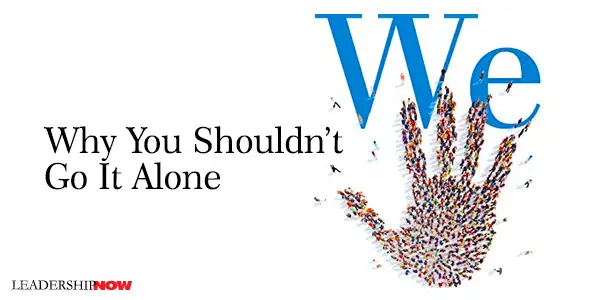
OUR INDIVIDUALISTIC narrative is strong. But it holds us back. Almost anything of importance was accomplished by connecting with others. We can leverage who we are by enlisting others. Eric George, a renowned hand surgeon, entrepreneur, and venture capitalist, shares in We: Ditch the Me Mindset and Change the World that in his field, he frequently sees “a spirit of absolute independence. It’s a mindset that, for whatever reason, makes people ignore the help readily available to them and internalize challenges, headaches, and obstacles.” This also extends to entrepreneurs and aspiring professionals as they “strive to independently achieve while ignoring the crucial relationships and resources that can help them along the way.” Connectedness is not only about us connecting with others but the connections we make for other people. “Connectedness means looking beyond the self and requires us to focus on others and consider how our connectedness can benefit everyone around us.” George identifies and examines six benefits or outcomes of connectedness: Outcome#1: Discovering Our Purpose Discovering how and where to channel our passions, interests, and talents to create shared value that we and others find meaningful. By embracing a wide breadth of diverse people, ideas, and perspectives, we become exposed to many avenues in life, which ultimately help us find where we can succeed and help others do the same. Discovering our purpose (or purposes) in life is sometimes difficult. “Yet by embracing a mindset of connectedness, we can, at the very least, accelerate and improve the process. Rather than passively wait for our purpose to emerge, we uncover the opportunities that lay hidden in the potential connections surrounding us.” Outcome#2: Create Partnerships Connectedness helps us to create partnerships now and opens the door to more connections in the future. “Embracing this mindset helps us find and cultivate truly rewarding and sustainable partnerships from our sincere commitment to learning about, investing in, and survive the interests of others.” Successful people don’t just see others as a means to get things done, but the relationships as an end in themselves. Outcome#3: Supports Perseverance We rarely become successful without resolve and resourcefulness. Connectedness “allows us to recognize the full potential of the opportunities afforded to us and recognize that we can always surmount any obstacle with hard work, the right approach, and access to people who can support us along the way.” Outcome#4: Cultivate Support We don’t know everything, and we don’t know what we don’t know. We need to connect with others who we can trust and “who share our passion and contribute to our purpose. The more connected we become, the more we can find the right people to support our mission in life, and the more we can help nurture their goals and needs.” Truthfully, we never accomplish anything of importance without people helping us along the way. No matter how difficult a surgery or miraculous its outcome, or how smart a business decision, success does not depend on “Me” but on the collective contributions of everyone supporting the organization. Outcome#5: Gain Perspective Perspective expands our minds with the experiences of others. It informs us and connects us with reality. We see the world from a “more informed, objective, and comprehensive point of view. Perspective enables us to fully appreciate life and the people surrounding us.” As a surgeon, connectedness allows him to “cross boundaries my patients self-construct against the external world. It allows me to help them see a world unrestricted by their injury and value what they didn’t lose.” Illuminating other perspectives is a significant part of a leader’s job. Outcome#6: Build Trust When it comes to medical care, trust is vital. George explains that he “must actively build trust through a process that draws heavily on connectedness and the many actions and behaviors that support it.” He continues:
With a mindset of We versus Me, we can see beyond what might divide us and change the world. 
Posted by Michael McKinney at 06:45 PM
03.04.20

Are You Leading for the Right Reasons?
YOU either lead for yourself or others. Why you took the role you now fill, affects the results you are getting. Patrick Lencioni has penned another leadership fable that follows the discussion of two CEOs getting to the bottom of why they lead and the results they are getting from their two different mindsets. The Motive is classic Lencioni, with plenty of let’s-get to the-core-of-the-issue insights. He writes that there are fundamentally only two motives that drive people to lead: service or reward. Those who lead to serve “understand that sacrifice and suffering are inevitable in this pursuit and that serving others is the only valid motivation for leadership. Those who lead for rewards often associated with leadership “see leadership as the prize for years of hard work and are drawn by its trappings: attention, status, power, money.” When leaders are motivated by personal reward, they will avoid the unpleasant situations and activities that leadership requires. They will calculate the personal economics of uncomfortable and tedious responsibilities—responsibilities that only a leader can do—and try to avoid them. This inevitably leaves the people in their charge without direction, guidance, and protection, which eventually hurts those people and the organization as a whole. Employees will express their disbelief as to how their leader could have been so negligent and irresponsible, yet it makes perfect sense in light of his or her motive for becoming a leader. Lencioni acknowledges that although we all try to do the right thing at times, we do fall short. But a little self-examination will reveal that one of these motivations is predominant in our thinking and explain the impact we’re having on the health of the entire organization. What Do Reward-Centered Leaders Avoid? When you are motivated by reward as a leader, you typically avoid these five situations or responsibilities: 1. Developing the Leadership Team In some cases, leaders delegate team-building to their head of HR. Let me be very clear; this does not work. And that’s not a knock against HR folks. If people on a leadership team don’t believe that the leader sees team development as one of his or her most critical roles, they’re not going to take it seriously, and it’s not going to be effective. The leader simply must take personal responsibility for, and participate actively in, the task of building his or her team. 2. Managing Subordinates (And Making Them Manage Theirs) Managing individuals is about helping them set the general direction of their work, ensuring that it is aligned with and understood by their peers, and staying informed enough to identify potential obstacles and problems as early as possible. It is also about coaching leaders to improve themselves behaviorally to make it more likely that they will succeed. 3. Having Difficult and Uncomfortable Conversations Failing to confront people quickly about small issues is a guarantee that they will become big issues. And if you’re not a responsibility-centered leader, one who understands that if the leader doesn’t do it, no one will, then you’re probably going to find a reason, almost any reason, to ignore those messy issues and do something else. 4. Running Great Team Meetings Meetings are the setting, the arena, the moment when the most important discussions and decisions take place. What could be more important? 5. Communicating Constantly and Repeatedly to Employees Most CEOs don’t hate the idea of communicating to employees. But the majority of them greatly underestimate the amount of communication that is necessary…. Unfortunately, many CEOs refuse to repeat themselves again and again and again and again…. No reasonable human being has ever left a company because management communicated too much. “That’s it. I’m going somewhere where leaders tell me something once and never repeat it again!” Each of these points ends with a section of questions “to help you reflect on your own attitude and discern whether you may be struggling to some extent with reward-centered leadership.” What motivates us to lead? If it is not service, we aren’t really leading; we are simply draining the organization and its people for our own gain. Lencioni encourages “those who chose to embrace responsibility-centered leadership—even if they were formerly focused on rewards—will come to see activities and situations that they once viewed as tedious and unpleasant as the real work of a selfless leader. And eventually, start to enjoy them.” But more than that, we are teaching future generations that the only kind of leadership that matters is responsibility-based or service-centered leadership. If reward-centered leadership is the norm, “the wrong people will aspire to be managers, CEOs, and civic leaders, condemning society to more of the same or generations to come.” The cost is too high. 
Posted by Michael McKinney at 12:00 AM
03.02.20

10 Lessons from Porter Moser’s All In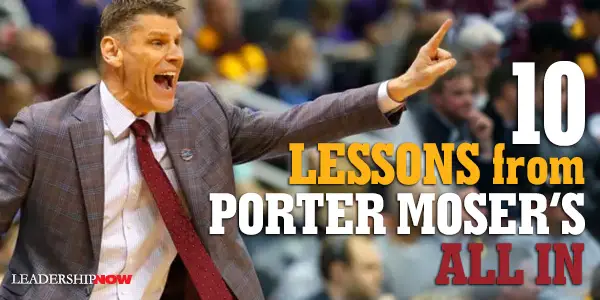
PORTER MOSER is the head men's basketball coach at Loyola University Chicago. Known for what he does on the court, he has guided the Loyola-Chicago Ramblers to three post-season berths, including a historic run to the 2018 NCAA Final Four and back-to-back MCV regular-season championships in 2018 and 2019. But it is his reputation and impact for what he does developing people off the court that is his legacy. In All In: Driven by Passion, Energy, and Purpose, he shares the values and beliefs, the ups and downs of his career, and the lessons he has taken from them. All In is filled with wisdom and lessons from a life leading others to their potential. I’ve extracted some of them for our mutual benefit:

Posted by Michael McKinney at 03:36 PM
11.19.19

quickpoint: Leaders Build Faith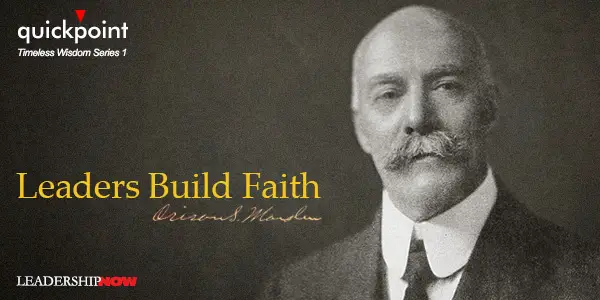
THE JOB of a leader is to build faith. The New Testament says that faith is confidence in what we hope for and conviction about what we do not see. It is the confident assurance that something we want is going to happen. In short, faith is the belief in the realization of vision. Jonathan Swift said that “vision is the art of seeing the invisible.” Faith is the belief that it will happen. The process is to separate the important from the peripheral—to lift people from their present reality to a future possibility. Embracing a vision is an act of faith. Without it, there is no reason to pursue it. Faith is like trust and based on it, but I would suggest that it is more than that. Faith is trust infused with passion. It drives us forward. Faith changes our behavior generally and how we interact with others specifically. While virtually invisible, faith is powerful. It is what brings life to leadership relationships. Leaders with great power also have great faith and build that faith in others. Orison Swett Marden, author, and founder of SUCCESS magazine elaborates on the importance of faith in any endeavor: Faith is the best substitute for genius; in fact, it is closely allied to genius.
Posted by Michael McKinney at 08:44 AM
11.08.19

Is a Lack of Intentionality Holding You Back?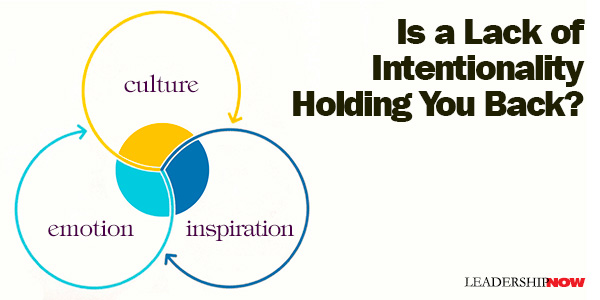
WHAT ARE the defining characteristics of successful leadership? Mark Sanborn identifies them as clarity and intentionality in The Intention Imperative. Clarity, he says, “tells you where you’re headed” and intentionality is “the consistent action you’ll take to get there.” To explain, Sanborn takes us back to when Domino’s found clarity and discovered how they were going to get there. With clarity of purpose that took them back to their roots, and intentionality, they became an e-commerce company that happens to sell pizza. As a result, Dominos stock has risen 5000 percent since 2008, outperforming all of the world’s largest tech companies. Leading with clarity and intentionality makes the difference. He offers the following chart to illuminate the effect of clarity and intentionality on our leadership effectiveness.
The quadrant of No Leadership is negligent leadership—no direction and no way to get there. Vague Leadership has a bias for action but lacks a clear idea of where they’re going. Wishful Leadership knows where they want to go but haven’t figured out the how or aren’t taking consistent action to get there. Intentional leadership is effective leadership. “Intentional leadership is knowing where you want to go and taking consistent action in the world as it is, not the world as it was, to get there.” There is a lot contained in that last statement and is the subject of this book. Intentional Leadership consists of three imperatives: Inspiration, Culture, and Emotion. The Culture Imperative Culture gets a lot of attention and is considered critical to success, but few organizations actually do much about it. At best, it becomes an HR function. Sanborn defines culture as “what we think and believe, which then determines what we do and what we accomplish.” He lists six reasons why it matters so much, but this reason caught my attention. I had never looked at it from this perspective. He says, “Culture is a corporate immune system that protects against variance, decline, or abandonment by identifying and combating threatening forces like toxic partners, disjointed processes, and bad decisions.” Culture often takes a back seat—though we know better—because we focus on the wrong things or think it is all about making employees happy. “Making people happy isn’t the job of an intentional leader. The job of an intentional leader is giving employees the tools—the philosophy, the training, the communication, and the incentives—to be successful.” Sanborn offers five levers to create, change, and/or maintain culture—intentionally. The Inspiration Imperative Inspiration comes from purpose and the mission. It’s more than motivation or engagement which are “task-focused and lack the sustaining power of inspiration.” Inspiring leadership begins with you. You find it in yourself first so that you can bring it out in others. Inspiration can be found in solitude, those you associate with, curiosity, a healthy sense of humor, gratefulness, service and exercise. “To find your purpose is to find your inspiration.” From this foundation you can guide others to their inspiration. Sanborn offers ten tools for inspiration. Connection with your team, your example, empathy, linking purpose to work, providing challenges and education, appreciation, and a good story are among the ten. The Emotion Imperative We have entered the emotion economy. The customer wants to feel successful after the fact, not just happy. “Are you happier you did business with us than with someone else?” You want customers happy they chose you—to feel successful. “The old notion that a company merely needs to provide a good or service withers away when we start to understand that it is not the product or service itself that matters—what matters is which emotion your company elicits from its customers.” The intentional leader knows that this goes beyond customer service. That’s part of it. “A customer’s emotions start well before they enter your sales funnel. The new economy has expanded the points at which your potential customers will first interact with your company. Across all levels of your organization, ask yourself how each impacts the customer’s happiness and feelings of success. This includes marketing, product design, sales, and, yes, customer service.” There are a lot of great insights in this book. Through a series of case studies that go beyond the usual suspects—a parking garage, High Point University, Acuity Insurance, Savannah Bananas baseball, Texas Roadhouse, and Envisioning Green landscaping—and interviews, he walks us through the thinking behind intentional leadership and its three imperatives to see how they connect. Here is a sampling of the comments from organizations featured in the book: Nido Qubein, president of High Point University: “I just get in front of our team. I walk around and pat people on the back, shake hands, share a laugh. It’s not complicated. I make time for moments of joy each day, and the time I spend in the café talking to students and staff members makes me feel good. Students talk selfies with me. If a student is on their phone talking to Mom and Dad, I grab it and talk to their parents. I’m present.” Ben Salzmann, CEO Acuity Insurance: “You can’t innovate in a vacuum. If you take the best genius and give them a year, feed ‘em the best food and lock ‘em in a room—a year later they don’t look so smart. Take the same person and let them talk and look around and interact, and they will come up with great innovations. Stimulus is critical.” Kent Taylor, founder and CEO of Texas Roadhouse: “If we think about a new idea, I run it through twenty people—managing partners, market partners, kitchen managers, service managers, meat cutters. I don’t create ideas in a distant office. When it comes to employees, I am always asking, Are they happy? Do they enjoy their job? That’s important because I believe that happy employees create happy guests, which creates happy accountants!” Erika Johns, co-owner of Envisioning Green: “Our culture is fun and positive. We aren’t afraid to laugh and joke around, but we know how to work hard. You spend more time with your co-workers than your family a lot of the time, so it’s important to have some fun at work.” All of the examples point to the fact that inspiration, culture, and emotion, are created and maintained with intentional leadership. Sanborn completes the book with thirty things that you can do now to lead intentionally based in reality—the world as it is. 
Posted by Michael McKinney at 06:59 AM
11.06.19

8 Leadership Principles to Elevate Others to Success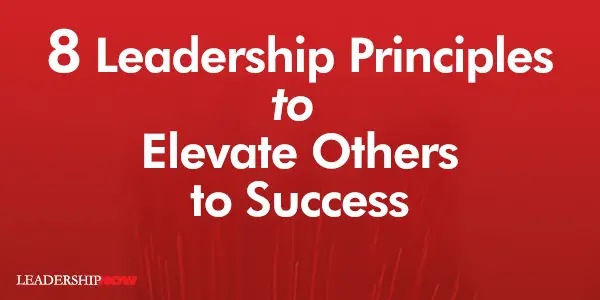
LEADERSHIP, says John Eades, is “inspiring, empowering, and service in order to elevate others over an extended period of time.” In Building the Best he tells how to do just that. To that end he presents 8 practical principles you can use to elevate others . Principle 1: Use High Levels of Love and Discipline to Elevate Others In terms of the workplace, Eades defines love as contributing to someone’s long-term success, and well-being and discipline as promoting standards in order for an individual to chose to be at his or her best. With love and discipline as a foundation, we can use the following seven principles to elevate others. Eades presents five leadership styles that we can fall into, but only high love and discipline will be effective in elevating others. You can take a free leadership style assessment on the LearnLoft website.
Principle 2: Without Strong Relationships, You Can’t Lead Leadership is relationships. Consistently demonstrating good character, showing you care for others, and your willingness to share your expertise with others builds trust with your team. Principle 3: Culture Starts with You, But Your People Prove It The cultural values you live will be evident in the behavior of your people. Four elements to consider when building a culture are safety ( emotionally safe), Unity (belonging and mutual respect), positivity (belief in possibilities), and energy (encouraged to produce and grow). Principle 4: People Persevere Because of Purpose Not Pay Purpose is derived from values, vision, and mission. “The most important thing frontline managers can do is connect their specific team to the purpose of their work.” By connecting people to the overarching purpose you elevate them to the possibilities their work contributes to the whole. Principle 5: Goals Aren’t Achieved Without Priorities Put into Action Break the goal down step-be-step. “To ensure you don’t unintentionally veer of course, come up with the top priorities that will help achieve your big goal.” Principle 6: The Instant You Lower Your Standards Is the Instant Performance Erodes Your standards define what an excellent culture looks like. “Standards produce behavior, behaviors become habits, and habits lead to results.” Principle 7: Accountability Is an Advantage, Make It Your Obligation Accountability often has a negative sound to it. But that is usually the result of the lack of accountability from the beginning. Accountability is meant to keep people on track and to exceed expectations. Feedback is done through direct dialogues. Eades offers systems to help do this right. “Being a leader of consequence, where accountability is at the center of everything you do, will lead to improved performance.” Principle 8: Coaching Unlocks Potential and Elevates Performance “While a team can function autonomously, a strong, dedicated leader plays an integral role in pushing people to new heights of development. They do this by focusing on coaching their people for role development and going beyond the role.” Eades provides a model for role development that shows you how to align your coaching to each of the for stages of role development. To maintain the mindset of elevating others, Eades urges us to say to ourselves as we go throughout our day, “Prepare to serve.” On your way to work, as situations change during the day, as you enter your house at night, think “prepare to serve.” Your attitude will be reflected in your leadership behavior. 
Posted by Michael McKinney at 07:56 AM
06.05.19

7 Principles to Lead with Imagination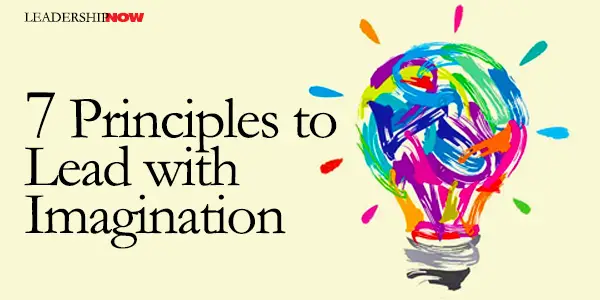
IMAGINATION is about seeing what others don’t see. In a disruptive world, we need leaders with more imagination. We all have the capacity for imagination and applied it has the power to unlock or fullest potential. Brian Paradis was the Chief Financial Officer for Florida Hospital when he was tasked with leading the troubled organization in 2006. Plagued with doubt and inexperience, he records his journey in Lead with Imagination, to turn the enterprise around. Lead with Imagination he writes is about “how to lead and how to do it with imagination. It is first about how to be, about character, before checklists and a list of to-dos.” It’s about “how to release yourself and those you lead from the constraints of the mind’s own making and those of our organizations.” This is a powerful book. Honest, straightforward, and insightful. The lessons Paradis has learned on his journey, we can learn along with him. He cites a passage from General Gordon Sullivan’s book, Hope Is Not a Method, that is particularly instructive. Sullivan was a primary inheritor of a U.S. Army in shambles after Vietnam. Today’s problems can be so close, so intense, that they become like blinders. Getting beyond today begins by imagining your organization out in the future. Ask yourself “What could be?” Postulate the new paradigm, and then imagine your organization in it. Many people seem uncomfortable with this process. They see it as too much art and too little science—as irrelevant theology in a world that has deadlines to meet. It is not. It is how the Army’s leaders of the 1970s and 1980s built the Army that was successful in the Persian Gulf War. It is how successful leaders in business, in all walks of life, in fact, operate: by keeping their eyes on today and on the vision—always moving forward. Imagination is about removing those blinders Sullivan describes. Below, I have reproduced his summary of each of Paradis’ seven principles. You will need to read the stories in each of these chapters to get the full impact of his message. 1. Love in All Interactions Love is the foundation, the soil, and the fuel for imagination. Love is both power and powerful. An act, service, or business endeavor done in love universally turns out better. However, love is hard. It is much easier to give in to fear, cynicism, and self-interest than to lead, live, and serve with love. Paradis says love should be our brand, first inside our organizations so that it can radiate outside our organizations to whomever we serve. 2. Out of the Comfort Zone: Leaning into Authenticity and Humility Once you commit to the principle of love, a high hurdle presents itself when leaning into authenticity in your leadership. At the same time, you must become self-aware about the influence your ego casts. Your ego must be managed. There is not a simple formula for this work. The struggle is the heart of this part of the journey to lead with imagination. It is difficult, if not impossible, to move forward effectively without consistency and balance to your words matching your actions. Authenticity and humility build trust. I end where I began: authentically making mistakes, and in humility, saying sorry, asking for forgiveness, and admitting that sometimes I just don’t know. …This is the place where you will earn the trust of the people you have the privilege to lead as a servant. 3. Chaos, Calm, and A Canvas: Creating the Environment That Matters A leader’s primary job is to set the stage, not perform on it. If you want to lead with imagination, you must unleash the power, capacity, and energy of the many and release the stranglehold of the few—even if the few includes you. This is creative work. We often use the language of ‘creating culture’; however, we don’t think enough about what those words mean. This is work that involves careful thought and consideration of every decision we make as another brushstroke applies the paint, either moving us toward a performance masterpiece of moving us away from it. 4. The Act of Fearlessness: Practicing Vulnerability and Right Risk-Taking Vulnerability is about putting yourself in harm’s potential way, or ‘out there,’ in order to accomplish something. It requires clear and creative action. It exposes you. In that place of exposure, we move from preparing to lead to leading with imagination. First, we take risks personally, then we can begin taking right risks organizationally. This is where the trifecta of imagination, creativity, and innovation get their solid foothold in what might be described as virtuous momentum. 5. Tolerating Curiosity Curiosity starts with questions. Both quality and quantity matter. Asking them is less than half the process. Holding the answer open, suspending judgment, questioning: do we even have the right answer yet? That is the larger half. That is the art. 6. The Misunderstanding About Humor Laughter creates a runway for love to land on, and then take off again. Life is serious, to be sure. Organizations are serious, too, but they are made up of humans. And because of that, humor contributes an essential living element to culture. Humor makes us human. It connects us. It gives us energy and capacity to handle stress and challenge. It lifts us. If we believe people are our greatest organizational capacity, then infusing humor into an enterprise is a high return on investment and undervalued as a creative and cultural force. Humor opens a pathway to breakthroughs and new insights. It becomes a competitive advantage. 7. Connecting the Dots: Doing Whatever It Takes Leadership is hard work. Leading with imagination and leading for results require skill and competence, constant self-evaluation, a servant’s heart, and a relentlessness to get it ‘mostly’ right. It is about asking the important and difficult questions of yourself and of the organization and waiting for the answers. It is about engaging and encouraging what is working and owning and dealing with what is not. It is about finding the way and doing whatever job needs to be done to support the team. It is about continuously and consistently imagining the vision, communicating it, and taking daily action toward it. Benjamin Zander, conductor of the Boston Philharmonic Orchestra, has described the ‘long line’ or vision of musical piece. He explains how the ‘line’ is easily lost with too much attention to single notes or short passages. As leaders, it is our constant job to keep bringing our organizations and enterprises back to the long line of the music and connecting the dots back to the big why. 
Posted by Michael McKinney at 07:55 PM
05.10.19

Great Leaders Have No Rules
THERE ARE well-intentioned behaviors and assumptions about leadership that we have accepted over the years that really don’t serve us well. Kevin Kruse has identified ten such assumptions and provided effective counter-thinking in Great Leaders Have No Rules. His goal is to “teach you how to be both the boss everyone wants to work for and the high achiever every CEO wants to hire—all without drama, stress, or endless hours in the office.” The ten principles highlighted below are well supported with research, the experience of Kruse and many interviews. Some of them will immediately resonate with you, others will take some consideration. Here they are: 1. Close Your Open-Door Policy The idea is to promote transparency, trust, and information flow. But leapfrogging the chain of command, dependency, and the productivity nightmare it creates, to name a few of the unintended consequences of this idea, make it worth overhauling. It is a passive solution to trust and information flow. It can also discourage autonomy, empowerment. It’s better to have office hours, set ground rules, have weekly one-on-one meetings, and a scheduled system of communication. 2. Shut Off Your Smartphone While smartphone activities can give you a big dopamine hit, they are distracting, they diminish brainpower, contribute to stress, accidents and fatalities, and smartphone surveillance impedes candor. Put them away and limit your access during the day. It will improve your safety and focus. 3. Have No Rules Principles do more and go further than any rule ever could. Principles are less micromanaging and more like guardrails. “Instead of rules, leaders need to hire talent who can be trusted, make company values actionable, set guidelines, and be willing to coach those who make honest mistakes.” 4. Be Likable, Not Liked Wanting to be liked is normal, but it makes it difficult to make tough choices and give candid feedback. Leadership is not about you. It’s about what’s best for those you lead. You can be tough and tender. “You should try to be likable, without caring whether you are liked.” It’s about results. 5. Lead with Love John Wooden said it best, “I will not like you all the same, but I will love you all the same.” That’s a tough concept to get sometimes. Kruse writes, “Whether I like you, and whether you like me, is irrelevant. In our daily interactions, I will lead with love. Who said leadership is easy?” Like and love are two different things. Like is an emotion. Love is a decision. 6. Crowd Your Calendar
7. Play Favorites People are different. So, if we are treating them the same, that isn’t fair. Standards apply equally to everyone. But people who perform better and are more engaged deserve to be treated better and have their strengths developed. “Great leaders take the time to identify each person’s strengths and then align opportunities and career path options to take advantage of them.” 8. Reveal Everything (Even Salaries) Radical transparency “enables team members to move fast, adapt to change, and make wise decisions and reduces their need to knock on your door with ‘got a minute’ questions.” 9. Show Weakness Being able to show weakness is a sign of courage and confidence. It is most often wise to keep your internal anxieties to yourself, but vulnerability builds trust. A culture of trust and psychological safety reduces the magnitude of mistakes and fosters innovation. 10. Leadership Is Not A Choice Leadership is influence. In that sense, that includes all of us, all the time. I define leadership as intentional influence so that we see it not as a passive activity but as a condition that we need to take responsibility for. Nevertheless, we are always “on,” and we need to keep that in mind at work, at home, among friends, and with everyone with whom we come into contact. We are representing a worldview. Kruse stresses leading by example—taking responsibility for the change you want to see. “If leadership is influence, then leadership isn’t a choice.” He concludes with a choice we all need to make. “Will you live your life on autopilot, or will you lead with intent? Are you leading in a positive direction or are you leading in a negative direction? How will you lead today? One of the great features of Kruse’s book is that he ends each chapter with a section titled, “How Might You Apply This If You’re A … manager, sales professional, sports coach, military officer, and/or parent. Extremely practical and designed to help you implement the principles he discusses immediately. Great Leaders Have No Rules is well-written and persuasive and just what you need to increase your leadership effectiveness. 
Posted by Michael McKinney at 07:23 AM
05.08.19

36 Lessons for Business & Life from Trillion Dollar Coach Bill Campbell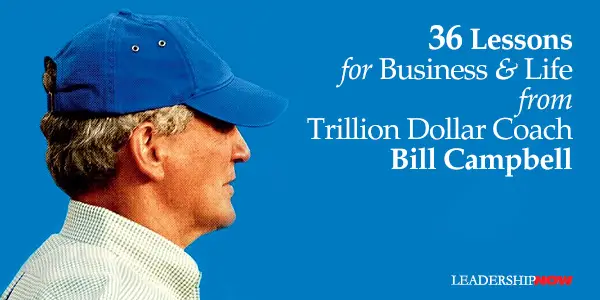
BILL CAMPBELL was one of the most influential background players in Silicon Valley. He helped to build some of Silicon Valley’s greatest companies including Google, Apple, and Intuit and to create over a trillion dollars in market value. In Trillion Dollar Coach, authors Eric Schmidt, Jonathan Rosenberg, and Alan Eagle, state that “without a doubt, Bill Campbell was one of the people most integral to Google’s success. Without him, the company would not be where it was today.” Campbell was a coach, mentor, and friend to Steve Jobs spending many Sunday afternoons walking and talking. He coached many others including Sundar Pichai, CEO of Google, Dan Rosensweig, CEO of Chegg, John Hennessy, former President of Stanford University, and Sheryl Sandberg, COO of Facebook. He was simply known as “coach” in part because he was a coach of the Columbia University football team from 1974 to 1979, but mostly for his business mentoring. Campbell worked with individuals, but he coached teams. “Coaching is the best way to mold effective people into powerful teams.” Campbell coached people to coach teams. “The best coach for any team is the manager who leads that team. Being a good coach is essential to being a good manager and leader. Coaching is no longer a specialty; you cannot be a good manager without being a good coach.” Remarkably, he repeatedly declined compensation except for some Google stock that he donated to charity. “When asked about his habit of eschewing compensation, Bill would say that he had a different way of measuring his impact, his own kind of yardstick. I look at all the people who’ve worked for me, or I’ve helped in some way, he would say, and I count up how many are great leaders now. That’s how I measure success.” From their own experience with Campbell and with stories from the many lives he impacted, the authors have assembled his thoughts and principles about business and life—and importantly how to bring people together. They are listed below but get the book to read the stories that illuminate the thinking behind the principles. Your Title Makes You A Manager, Your People Make You A Leader. It’s the People. Start with Trip Reports. 5 Words on A White Board. The manager's job is to run a decision-making process that ensures all perspectives get heard and considered, and, if necessary, to break ties and make the decision. The goal of consensus leads to “groupthink” and inferior decisions. There isn’t a head at the Round Table, but there is a throne behind it. Lead Based on First Principles. Manage the Aberrant Genius. Money’s Not Just About the Money. Innovation Is Where the Crazy People Have Stature. Let People Leave with Their Heads Held High. Build an Envelope of Trust. Only Coach the Coachable. Practice Free-Form Listening. No Gap Between Statements and Fact. Don’t Stick It in Their Ear. Be the Evangelist for Courage. Full Identity Front and Center. Team First. Work the Team, Then the Problem. Pick the Right Players. Pair People. Everyone Needs to Be at the Table. Solve the Biggest Problem. Don’t Let the Bitch Sessions Last. Winning Right. Leaders Lead. Fill the Gaps Between People. Permission to Be Empathetic. It’s OK to Love. To Care About People, You Have To Care About People. Cheer Demonstrably for People and Their Success. Help People. Love the Founders. Build Relationships Whenever You Can. Positive Human Values Generate Positive Business Outcomes. 
Posted by Michael McKinney at 07:54 AM
01.18.19

The Truth About You
IN THE January/February 2019 issue of Communication Arts, Ernie Schenck writes about two kinds of truth: authentic and inauthentic. Authentic truth is who you are. Inauthentic truth is who you are when everyone is looking. It’s accepting what the loudest voices around you are saying because you don’t want to look bad. It’s commonplace in politics, but we see it everywhere. It’s pandering. Not leadership. It’s denigrating. Not serving. Inauthentic leadership is selfish. We use it to get something. To get us from A-to-B. As leaders, we need to be sure we are walking our talk. If we talk about service to others, then everything we do must be guided by that value. If we believe in building others, then everything we do must build others without regard for our own position. If we are empathetic, then our criticisms are constructive and measured, not strident. The alignment between who we are—our authentic truth—and what we say and do is critical. A leader who acts or his or her authentic truth is a leader that can be trusted. If we jump on every bandwagon that comes through, we can be perceived as not knowing our own mind. When we lead from who we are and not from where everyone else thinks we should, more than just being trusted, we can more easily adapt, grow, and lead in a thoughtful and measured manner. Here are Schenck’s thoughts on truth in advertising from The Truth Is Out There. Kind Of.: The authentic truth. It’s absolute. It’s unshakeable. Its power to propel us as creatives mighty beyond measure. But there is another truth. It is feeble. It is disingenuous. And it is something we’ve rarely seen before. The kind of truth that’s fleeting. Fabricated. Cloaked in insincerity. And if we’re not careful, it can lure us onto a bandwagon that at best is uncomfortable and at worst can suck the spirit out of us. Call it the inauthentic truth.
Posted by Michael McKinney at 01:25 PM
12.12.18

Everything Begins with a Day One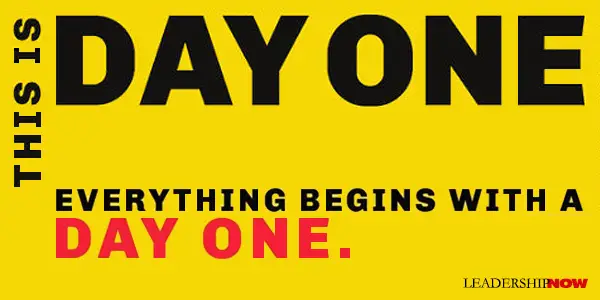
L This is Day One by Drew Dudley is about choosing to lead. Everything worthwhile in life begins with a Day One. “If you want to be a leader, chose to be a leader today. Repeat that choice every day. It doesn’t matter if you failed to do it yesterday or if you’ve done it every day for a decade: every new day begins with a recommitment to that choice.” And it’s a daily choice. With everything in our environment to distract us from that choice, to push us into being reactive rather than proactive, some days that choice will take a huge effort. But the payoff is big. Your most enduring legacy will very likely have nothing to do with your plans. The greatest impact you will have on the people around you and the organizations of which you are a part will almost always be a result of the unplanned consequences of your everyday actions. It’s the daily behaviors that add up to a successful life—to successful leadership. So we must plan to make a difference. Our leadership plan must revolve around who we want to be—our values. We must identify and define those values and then do something every day that embodies those values. “When you no longer must consciously align your behavior with your values—when it happens by instinct—you have created a ‘personal culture of leadership.’” Dudley has identified six values in his life that drive his behavior every day. Yours may be different. They are articulated through six questions that when asked in advance of your day can lead to a change in your behavior. His six questions are: 1. Impact—What have I done today to recognize someone else’s leadership? “Leadership recognized is leadership created. What if we all worked to create a culture in which the true measure of our lives is how many people smile when our name is spoken twenty years after they last saw us.” Answering this question “will create moments of impact that remind others they have mattered, do matter, and will matter in the future.” Let people know they are leaders to us. 2. Courage—What did I try today that might not work, but I tried it anyway? Courage is demonstrated through action. “Effective personal leadership is the willingness to honestly ask ourselves: ‘In what areas of my life am I settling? Leadership is having the courage to be honest with yourself about where in your life you are allowing yourself to settle and taking action to ensure you don’t do it for a single day longer.” 3. Empowerment—What did I do today to move someone else closer to a goal? We are responsible. “One of the reasons so few people put up their hand when asked if they are a leader is they’ve accepted a situation where the things that they are chasing in their life—the things they believe will make them happy—can only come from someone else.” A driver in New Orleans told Dudley, “We serve others whenever we help them move closer to one of their goals. For some people that might mean an educational goal, a career goal, or a goal related to their legacy. But let me tell you, the most important goals you can help someone reach are the goals related to their dignity. People need to feel seen, they need to feel understood, they need to feel connected to another person. Too many people in this world don’t have those goals met.” Acting for the success of others. 4. Growth—What did I do today to make it more likely someone will learn something? Expand your capacity. “Go too long without appreciable growth in your life and not only does it become difficult to see yourself as a leader, it become difficult to feel like you matter.” I liked this statement: “You can’t lead on a need-to-know-only basis. You can fix things, you can maintain, but you can’t lead.” We must continually expose ourselves to the new and uncomfortable. “It’s not enough to be supportive when you see opportunities to help people, you must be a catalyst for creating those opportunities and forgiving others the tools to create them for themselves. Forget power, influence, and control: make people feel like they’re better when you’re around and they will follow you anywhere.” 5. Class—When did I elevate instead of escalate today? We can choose our response. We don’t have to operate on autopilot. “Class is elevating a situation when your instincts push you to escalate, when it would be easier to escalate and when you have every right to escalate. The difference lies in your goal for the resolution of the situation: elevating means trying to succeed, escalating means trying to win.” Treat people better than they deserve to be treated. 6. Self-Respect—What did I do today to be good to myself? “The fact that we have the rest of our lives ahead of us is the biggest reason we don’t do things today that will make the rest of our lives better.” Plan failure into your plans. It’s inevitable. “The most extraordinary leaders I’ve known are the ones who are best at healing.” Only hurt people hurt others. “It means leaders have got to forgive and leaders have got to heal. If we don’t evict the things living rent free in our heads, we will carry them with us and one day use them as weapons against those we care about most.” The last section of the book is a workbook of sorts to help you define your own values and create your own questions based on those values. This is Day One will help to see leadership as a responsibility everyone has. It’s a choice. We can build a community of leaders one day at a time. 
Posted by Michael McKinney at 10:37 AM
11.19.18

William Donaldson on Entrepreneurial Leadership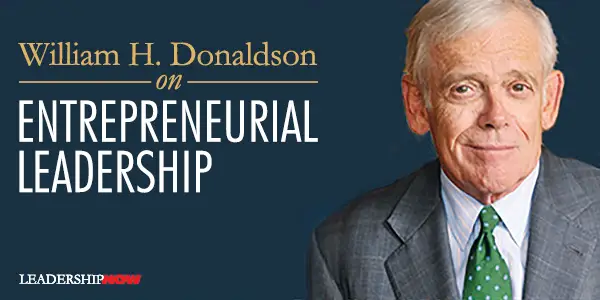
W Donaldson and Karl Weber extract relevant lessons for leaders in Entrepreneurial Leader. The thread that runs through his career is the entrepreneurial mindset. That mindset is “about the application of creative thinking and prudent risk-taking to build innovative, long-lasting organizations in any sector of the economy.” There are leaders and there are entrepreneurs, but not all leaders are entrepreneurs, and not all entrepreneurs are leaders. Simply put, I believe that entrepreneurial is a mindset—a way of thinking—and leadership is a way of acting. Entrepreneurial leadership, then, describes the way such a leader behaves. The case method he experienced at the Harvard Business School, showed him that “in many cases, the deeper you delve into a problem, the less obvious the answers are.” This realization is empowering because “since nobody really knows the one perfect solution to the kinds of real-life challenges organizations face, it’s important to have the courage to ask questions, to propose answers, to challenge assumptions, and to experiment—all of which are key elements of the entrepreneurial drive.” As founding dean and professor at the Yale school of management, he taught a course on entrepreneurial leadership. He focused on the personal characteristics of the leader. “Of course, an entrepreneurial leader needs to know about subjects like financial management, competitive strategy, market analysis, and the like. But I think those topics are distinctly secondary. More important are the human qualities that the entrepreneurial leader brings to the job—the ability to see the world through fresh eyes; the ability to pay attention to both the big picture and the small details that define a particular situation; a high degree of personal energy, optimism, and a sense of fun; the readiness to shape and define the system in which he or she operates rather than being controlled by a system someone else has created; and, most important, a strong sense of integrity.” By integrity, he means that they transcend themselves. They look beyond their ego. They remain true to the vision and commit to the value of individuals. He notes that an entrepreneur is not a gambler. “The smart entrepreneur uses careful planning, intelligent strategy, and lots of hard work to minimize the risk as much as possible.” Effective leaders must be entrepreneurial—which means getting things done, regardless of the obstacles. I found this comment especially useful as it speaks to the mission here at LeadershipNow: In the business arena, entrepreneurial leaders must think and behave as if they own the company—whether they do or not. Entrepreneurial leaders must define systems rather than be defined by them; they must adopt an ownership mentality. They understand that they must take ownership of their choices, including the smaller, day-to-day decisions they make. They must take full responsibility for them rather than attributing them to “the system” or “circumstances.” Entrepreneurial leaders also think continually about the big picture—the broader goal that everyone in the organization is supposed to be working toward—and strive to be guided not by short-term gain or personal profit but by long-term objectives that help everyone. Furthermore, entrepreneurial leaders find ways to encourage everyone in the organization to think and behave in this way, and create circumstances that help them do this. The behind-the-scenes look at the roles he has taken on throughout his life—especially the rationale behind and the building of Donaldson, Lufkin & Jenrette—is instructive. The range of his life and career demonstrate the broad relevance of the principles he describes in this book and makes for a fascinating read. 
Posted by Michael McKinney at 12:43 PM
11.07.18

Who Will Lead Us Tomorrow?
W Developing leaders places a huge responsibility on us today that goes beyond telling those future leaders what we think. To develop leaders, we must not only envision the leaders we want tomorrow, but we must behave in the manner of the leaders we want to see. We may not like the leadership or lack of it that we see today, but if our reaction to anything we don’t like is anger, outrage, hatred, and vicious rhetoric, we are endorsing those values by way of example. Unwittingly, we perpetuate hatred, outrage, and vulgarity in the leaders of tomorrow. They learn to lead by watching us “lead.” Martin Luther King succeeded because he calmly but passionately painted a picture of a world that appealed to our morality. He shared a positive idea to replace a negative idea without attacking other people. His example had moral weight. He was silenced by hatred. Hatred and anger is an idea without reason—it’s unreasonable—a rudderless opinion with no foundation. We must be the leaders we want to see developed in the generations that follow us. If you want leaders who listen, who are understanding, compassionate, civil, and respectful, then we must display those values in our dealings with what we see happening around us. If not, we are the problem. If we want others to respect us and listen to us, we must respectfully listen to them. We talk when we should be listening. If we believe people should be respectful of each other, then we must be those people. Returning in kind is tempting and sometimes funny, but it does nothing but add to the discord we see around us. Real leaders resist the temptation and rise above it. Our response should be one that is conscious and empathetic of the other person's frustration and often misplaced angst. To do anything else only adds to the destructive division we see today. Real leaders connect, they don’t divide. They focus on similarities, not differences. We often think that if I don’t yell, I won’t be heard, but we aren’t heard because we are yelling. The most strident voice is not the leader. Harsh words do not connect with others. “Blood in the streets” is not a mature response to disagreement. When we become the leaders we should be, those that follow will learn to lead the way they should. As we learn and grow, those around us will learn and grow. We are modeling now the kind of leadership we will have in the future. American poet Edwin Markham’s poem captures the need for us to grow into the leaders we want others to be: We are all blind until we see
If we want our children to be intentional about their lives, we must too be intentional about ours with the end in mind—with the consequences of our personal behavior in mind. Meaningful lives are built; they don’t just happen. If we want them to be adults, we must act like adults. We are shaping the character of future leaders today. We must resolve to be the leaders we wish to see. What will our future leaders be like? Who will lead us tomorrow? What legacy are we leaving for our children? We only need to look at ourselves.
Posted by Michael McKinney at 07:54 AM
10.29.18

Michael Lombardi’s Lessons in Leadership
M In Gridiron Genius, you will certainly get the inside scoop on the game of football, but it’s much more than that. As a three-time Super Bowl champion, Michael Lombardi provides lessons in organizational culture, team building, strategy, and character. His philosophies on how to build championship teams were foundational for the teams built by both Walsh and Belichick. Organizations of all types will benefit from the insights found here. “Football is ultimately a business, and as in any successful business the most important ingredients are a sound culture, a realistic plan, strong leadership, and a talented workforce.” So let’s look at some of the leadership lessons to be found here. The main lesson that comes through his experience with great coaches and owners is that culture comes first. “If you haven’t created an underlying ecosystem of excellence, short-term success is all it will ever be.” On Bill Walsh building the San Francisco 49ers in 1979: “From the talent on and off the field, to the quality of the workplace, to the practice fields. No detail was too small for Walsh to consider because, to his assembly line way of thinking, only the sum of them all could produce the organization he wanted. As he was fond of saying, if he managed to perfect the culture, the wins would take care of themselves.” He writes: “Character assessment is by far the hardest challenge for team builders. More than any other factor, inaccurate character assessment is why draft boards are to this day littered with so many mistakes. For starters, let’s be honest, there’s a sliding scale of morality in the NFL (as in every industry), in which the more talented a player is, the more he can get away with.” “Each player retains information differently, and it’s the coach’s job to determine the best way to instruct him.” What Makes a Great Quarterback? A winning way. (Winning is a habit.) A thick skin. (The measure of who we are is how we react to something that does not go our way.) Work ethic. (Your best player has to set a tone for intolerance for anything that gets in the way of winning.) Football smarts. (A quick mind come with preparation. You prepare so well that you don’t have to think; you just react.) Innate ability. (Born with it quality: Walsh couldn’t define it, but he knew it when he saw it.) Carriage. (Quarterbacks have to inspire. They can always look as if they have it all under control and that somehow they will figure out how to lead the team to victory. No one wants to follow a sulker.) Leadership. (Quarterbacks who fail to gain the respect of teammates leave a team rudderless.) Building a team: “A big part of Walsh’s genius was his uncanny ability to spot a quarterback in a crowd. Even from a distance and after only a few throws, he could sense immediately if a quarterback could run his offense. Guys like Walsh and Belichick are unusual this way: They can visualize how skill sets fit in their schemes in a way that both maximizes those abilities and fuels the system.” From Bill Belichick: “Although practice doesn’t make perfect, it gets you closer to perfection each time you do it.” “We aren’t collecting talent; we are building a team.” Mental Toughness: Doing what is best for the team when it might not be the best for you. If players can fight past exhaustion, if they can focus when they’re completely drained, well, that’s mental toughness. On Bill Walsh: “His meticulousness was evident everywhere.” “Walsh opted for less experienced men who shared his curiosity and displayed a willingness to learn his system and methods.” What Makes a Great Coach? Command of the Room. Followers need something to commit to. A leader has to have a plan. On Nick Saban at Cleveland: He had a strong plan and an effective way of communicating that plan, and his ability to be self-critical earned the players’ trust in a way that rivaled their feelings for Belichick. Command of the Message. What good is the plan if you can’t talk about the plan? Players can’t accomplish anything unless they can visualize the path. Delivery isn’t as important as meaning. Command of Self. Personal accountability is the ultimate sign of strength. Sophocles sums it up best: “All men make mistakes, but a good man yields when he knows his course is wrong and repairs the evil. The only crime is pride.” Ego is the leading cause of unemployment in the coaching world. Command of Opportunity. Becoming an NFL head coach is a process. You learn on the fly. In the beginning, it is likely you’ll be bad at it. You just have to keep working at it until you get good and pray that you don’t end up a one-hit wonder. Command of the Process. A leader must be fair and consistent. When rule don’t apply to everyone, the ensuing chaos collapses whatever foundation a leader has tried so hard to build. In a particularly good section of the book, Combating Complacency he talks about how Belichick and Walsh fight complacency. This was interesting: “Whether the Patriots have just won the Super Bowl or not, the first thing Belichick does is wipe the slate clean. One of his favorite sayings is, ‘To live in the past is to die in the present.’ It’s why you see no Super Bowl trophies as you walk through the players’ entrance and why all the photos from the previous season are removed as soon as the season is over. That clean slate demands a trip back to basic principles and fundamentals after a detailed examination of the current process.” He adds, “What impressed me the most about Belichick and Walsh in their self-awareness. With the same kind of success in the NFL many lesser men have become close-minded, authoritarian, and lazy.” Of Related Interest:

Posted by Michael McKinney at 12:16 AM
10.24.18

Humble Leadership
I What they advocate in Humble Leadership is moving to and developing an organizational culture based on Level 2 relationships. That is relationships that are intentionally personal, cooperative, and trusting. Level 2 relationships come naturally with friends and family, but no so much at work. Level 2 relationships come about by seeing others as a whole person and not just as someone filling a role at the moment. It’s being able to say in actions and words, “I want to get to know you better so that we can trust each other in getting our jobs done better.” In my own work, it’s not uncommon to see people who would tell you that relationships are important to them, shift into Level 1 transactional relationships with the people they are working with. Transactional relationships can somehow make us feel like we are serious and getting down to business by avoiding all of the relationship stuff. Not to mention, it’s just easier to avoid the hard work of developing trust and openness with another person or team. But it comes at a cost. As they describe it, Humble Leadership is about “building relationships that get the job done and that avoid the indifference, manipulation, or, worse, lying and concealing that so often arise in work relationships.” Much of our work life occurs at Level 1 because the services, stores, hospitals, and businesses we deal with are organized bureaucratically to deal with us at that level. This is typically the source of our dissatisfaction with bureaucracies. We don’t like being treated so impersonally, especially at work. “Evolving the managerial culture from Level 1 to Level 2 is the defining task for Humble Leadership.” The authors suggest that to move from Level 1 to Level 2 relationships, we need to personize our relationships at work. By that, they mean getting to know them as a whole person by minimizing subordination so that we “emphasize collaboration, joint responsibility, and your own willingness to help them succeed.” One of the best ways to get that started is by learning together “because in that context the boss and the employee can give each other direct feedback and suggestions on how he work could be done better.” In a Level 2 workgroup Humble Leadership emerges by enabling whoever has pertinent information or expertise to speak up and improve whatever the group is seeking to accomplish. The Heroic leader will no longer be the leader with all of the answers, going it alone to forge a new future. The leader of the future will need to be humble, cooperative, and open. Leadership will be expressed as “we together.” At the end of the book, there are exercises to help you shift from Level 1 relationships to Level 2 relationships. 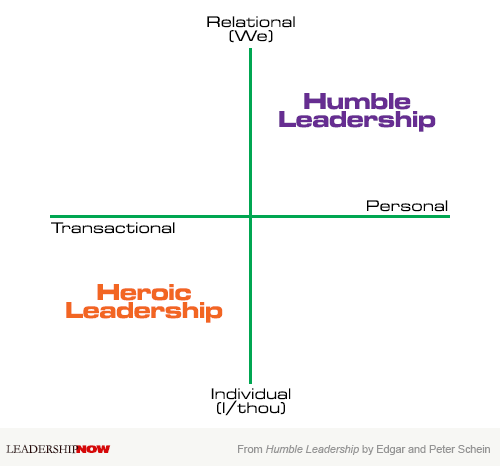 
Posted by Michael McKinney at 07:55 AM
10.10.18

The Dichotomy of Leadership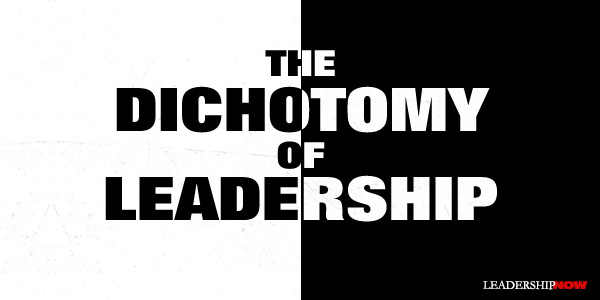
S After the publication of their first book, Extreme Ownership, many people latched on to the aggressive implications of the word “extreme” and missed the more nuanced balance that a leader must have. “Leaders must find the equilibrium between opposing forces that pull in opposite directions.” The Dichotomy of Leadership is meant to help leaders find that equilibrium. Extreme is almost never the answer. Anything can be taken too far. A leader must be able to where to be on any given continuum in any given situation. Steadiness comes to mind. Or as the Romans termed it: gravitas. Knowing what the tensions or the dichotomies are is the first step avoiding the trap of extremes. Willink and Babin offer twelve. We’ll review eight of them here.
The bottom line that leaders build on is the first dichotomy: To care about your people more than anything—but at the same time, lead them. “And as a leader, you might have to make decisions that hurt individuals on your team. But you also have to make decisions that will allow you to continue the mission for the greater good of everyone on the team.” This concept frequently gets lost on some discussing leadership. It’s easy to get this wrong. Getting it right is caring. It’s the job of leading. Own it All, but Empower Others The next tension is between micromanagement and hands-off leadership styles. You have to have to take ownership, but at the same time, give ownership. “With Extreme Ownership you are responsible for everything in your world. But you can’t make every decision. You have to empower your team to lead, to take ownership. So you have to give them ownership.” Leaders set the destination but ownership comes when people can help set the course. Resolute, but Not Overbearing When and where do you hold the line? “There is a time to stand firm and enforce the rules and there is a time to give ground and allow the rules to bend. They must set high standards, but they cannot be domineering or inflexible on matters of little strategic importance.” It’s about your leadership capital. “Leadership capital is the recognition that there is a finite amount of power that any leader possesses. It can be expended foolishly, by leaders who harp on matters that are trivial and strategically unimportant. Prioritizing those areas where standards cannot be compromised and holding the line there while allowing for some slack in other, less critical areas is a wise use of leadership capital.” It’s an act of strength for a leader—the opposite of insecurity. When to Mentor, When to Fire Knowing when to work with someone and when to let them go isn’t easy. “Most underperformers don’t need to be fired, they need to be led.” The balance when leaders remember that “Instead of focusing on one individual, there is a team—and that the performance of the team trumps the performance of a single individual. Instead of continuing to invest in one subpar performer, once a concerted effort has been made to coach and train that individual to no avail, the leader must remove the individual.” Disciplined, Not Rigid Rules can be imposed with too much rigidity that it stifles the team’s ability to think and adapt. Leading isn’t about following the exact procedure, but being able to think and do what makes the most sense so that you can support and lead your team. “Disciplined standard operating procedures, repeatable processes, and consistent methodologies are helpful in any organization. The more discipline a team exercises, the more freedom that team will have to maneuver by implementing small adjustments to existing plans.” A Leader and a Follower Following is a part of leading well. Babin recalls, “Leading didn’t mean pushing my agenda or proving I had all the answers. It was about collaborating with the rest of the team and determining how we could most effectively accomplish our mission. There were many times in my Navy career when, in an effort to prove my leadership, I failed to follow. And rather than strengthen me as a leader in the eyes of the team, it undermined my leadership.” Good leadership not only includes encouraging junior members of the team to step up and contribute but to support the boss even when you disagree with the decision and “execute the plan as if it were your own.” Plan, but Don’t Overplan Trying to plan for every contingency can create more problems than it solves. Plan you must, but “you cannot plan for every contingency. If you try to create a solution for every single potential problem that might arise, you overwhelm your team, you overwhelm the planning process, you overcomplicate decisions for the leader. Therefore, it is imperative that leaders focus on only the most likely contingencies that might arise for each phase of an operation. Choose at most the three or four most probable contingencies for each phase, along with the worst case scenario.” Humble, Not Passive Humility is the leader’s most important quality. Be humble or get humbled. “An important part of being a leader is to be humble enough to see beyond his or her own needs.” And while humility means that you need to recognize that you are part of a larger whole and don’t have all of the answers, “being humble doesn’t mean being passive. It doesn’t mean to not push back when it truly matters. Humility has to be balanced by knowing when to make a stand.” That is, “willing to push back, voice their concerns, stand up to the good of the team and provide feedback.” Humility means knowing when to lead and when to follow. “Pushing back against an order or task from the boss should be the rarest of exceptions and definitely not the rule. Staying humble is the key to developing trust with the chain of command.” When SEAL leaders had to be fired from “leadership positions in a platoon or task unit, it was almost never because they were tactically unsound, physically unfit, or incompetent. It was most often because they were not humble: they couldn’t check their ego, they refused to accept constructive criticism or take ownership of their mistakes.” Other dichotomies they cover include: Train Hard, but Train Smart; Aggressive, Not Reckless, Hold People Accountable, but Don’t Hold Their Hands; and Focused, but Detached. When you find that you are not managing well one of these tensions, the tendency can be to overcompensate. “When a leader moves to rebalance, however, caution must be exercised not to overcorrect. This is a common error: when leaders sense they have gone too far in one direction, they can react by going too far in the other direction. This is ineffective and can make the situation worse. So instead, make measured, calculated adjustments, monitor the results, and then continue to make small, iterative corrections until balance is achieved.” Balance is never achieved once and done. You will need to move back and forth along these continuums to achieve the results you need because circumstances are always changing. “The leader must continue to monitor the situation, readjust as changes happen, and restore balance.” 
Posted by Michael McKinney at 07:11 PM
07.06.18

What Is the Role of Leaders in Emerging Technology?
O Technology is capable of doing great things. But it doesn’t want to do great things. It doesn’t want anything. That part takes all of us. It takes our values and our commitment to our families and our neighbors and our communities, our love of beauty and belief that all of our faiths are interconnected, our decency, our kindness. For a leader to be that candle they need to be able to create context by communicating across disciplines. They need to be able to share ideas to take advantage of all of the information that is available and put it to a creative solution. In short, leaders will need to define focus and create meaning. An emphasis on communication will be essential for building a stable narrative and a practical relationship with technology throughout an organization or team.  
Posted by Michael McKinney at 08:16 AM
05.24.18

The Journey to Servant Leadership
I When Art Barter bought Datron World Communications in 2004, he was determined to create a servant leadership culture in his organization. In doing so the company went from $10 million in annual sales to $200 million today. He explains, “by following the principles of servant leadership, we were able as a committed and engaged team to create a growth mindset and far exceed our normal production with basically what we already had.” In The Art of Servant Leadership II, Barter shares the journey from power-based leadership to servant leadership. Inside you will find the ups and downs, the trials and triumphs, and the rewards of making the journey. What worked and what didn’t. Making a change from a power-based leadership style to a servant leadership style is not easy and must begin at the top. At the beginning, there are trust issues. And quite frankly, it is a difficult approach to wrap your mind around. It’s unnatural and some otherwise great people will never make the transition. It’s an ongoing process—a cycle of education, understanding, applying, and reflecting. Educate to Own Leaders must educate to the point of ownership. It has to be ongoing and consistent. Barter began by preaching more or less but soon learned that if they were going to own it, they and to be part of the educational process. Based on the principles of servant leadership, he asked his team to define what servant leadership looked like to them and then said let’s do that. “Let them decide up front what that will look like; it allows them to start their transformation because they own that definition.” Barter moved from educate-to-train to educate-to-own. It is important too, says Barter, that the leader’s voice is in the process so that everyone is speaking the same thing and that you meet people where they are. Understand and Empower When things get tough it’s easy for a leader to fall back on power. And when you do it takes humility to face the real issue. Barter said that he had to look at himself at times and ask, “’What did I do to generate that response?’ It took me a while to get to the point where I started looking inside first.” He adds, “They can’t put me on a pedestal and expect me to be perfect, because I’m going through a continual transformation right along with them.” As to empowering others, “there are times when the best thing you can do to help people transform is to stop teaching them and just encourage them, giving them space to work on their own transformations.” Not just listening but listening to understand, empowers people. Apply You can’t put an organization on hold to make the transformation to a servant leadership culture. You must be profitable and self-sustaining. But servant leadership stresses the means more than the results. It is a culture that makes it safe for failure. Encouraging others and one-on-one mentoring helps to send that message. Here are two key thoughts that caught my attention in this section: Someone on your team isn’t performing well. Maybe this person is dealing with some personal issues, or perhaps is struggling with what he or she is being asked to do. What would happen if two other people on the team took that person aside and helped him or her get through those challenges and stayed with the team member until the challenges were resolved? What would that look like in today’s workplace? In most workplaces, a person who starts falling falls alone because nobody wants to be part of it. Reflect Self-reflection and team reflection are necessary in a servant leadership culture. At Datron the create what they call a “fascination-for-the-truth” environment. It begins by never killing the messenger. They also host monthly get-togethers and quarterly off-sites. They invest money into developing the team by sending people to conferences, bringing in outside speakers, and encouraging reading. Confrontations at Datron are meant to restore relationships and not to convince the other person that you’re right and they’re wrong. The real test of servant leadership is if those you are serving are growing.   
Posted by Michael McKinney at 10:45 PM
05.22.18

Co-Active Leadership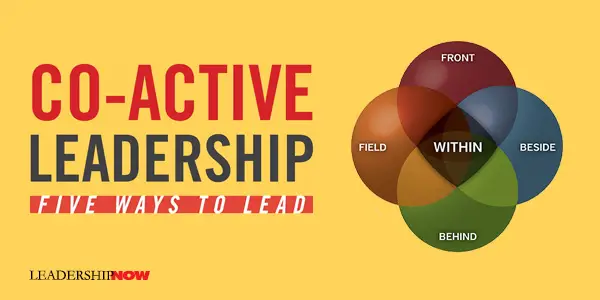
I In Co-Active Leadership, Karen and Henry Kimsey-House define leadership as “those who are responsible for their world.” So much of leadership is about initiative—taking responsibility. In this sense, anyone can choose to lead. “Leadership development, then, becomes about growing the size of the world for which one is able to be responsible.” Naturally, this would mean not only becoming “first-class noticers” but increasing one’s competence. A multidimensional view of leadership allows for anyone to lead. The authors have created the Co-Active Leadership model that is multidimensional. “Everyone, at different times, plays all five roles, shifting from dimension to dimension as the circumstances and the needs of the moment require.” The five dimensions are: 
Co-Active Leader Within This is where all leadership begins—from within. It begins with taking responsibility for who you are, knowing your values, and then leading in alignment with those values. I agree with the authors that what we need to lead is within us, but leading with a “take me as I am” approach can lead to disaster. Self-awareness is about seeing who I am in relation to those I impact and asking ourselves if this is the person I want to be. Opening our heart is not enough. The bigger question is what is motivating the heart. From “Within” we move into the other dimensions as appropriate. Co-Active Leader in Front Leading in front is not about being in charge. A Co-Active Leader in Front fosters a “connection with the people who are following them and stand firmly for a clear direction and purpose.” They understand too that it is not about them, it’s also about creating the space for others to step up and share their knowledge and creativity. It’s about providing guidance. Co-Active Leader Behind This is about service. Co-Active Leaders Behind “focus on providing whatever is needed and, through openhearted and enthusiastic participation, advance the action in a way that holds everyone together.” They are most concerned about the whole. It’s about encouraging others. Co-Active Leader Beside Two can be better than one. Co-Active Leaders Beside “take responsibility for their world by creating their partnership around a shared vision and intention and supporting each other’s strength to generate a powerful synergy in which the whole is much greater than the sum of the parts.” It’s about partnering with team members. Co-Active Leader in the Field The field referred to here is “the energetic field that surrounds all of life and offering us information all the time.” So Co-Active Leaders in the Field is “about expanding our attention beyond individual people to connect with the energetic field that surrounds life.” It’s about drawing on insights from beyond the rational mind. It about sensing and connectedness. Seeing leadership as more than top-down command, frees anyone to lead. Seeing leadership in the multi-dimensional way the authors present here, enriches a leaders responses and approaches to any given situation. 
Posted by Michael McKinney at 11:45 AM
04.23.18

The Excellence Dividend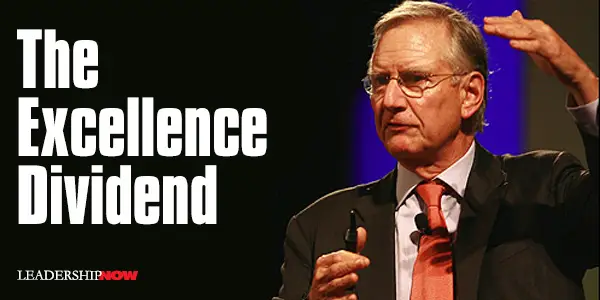
T We are faced with a tech tsunami that threatens our work. Daniel Huttenlocher, dean of Cornell Tech, said, “The industrial revolution was about augmenting and replacing physical labor, and the digital revolution has been about augmenting and replacing mental labor.” Machine learning and Artificial intelligence will change the way we work. Peters says that the best defense against this tech tsunami is excellence. Excellence is an offensive strategy. It's proactive. We need to focus “on the human attributes that will, effectively deployed, likely remain beyond the realm of artificial intelligence.” He believes we need to go on the offensive creating excellence in everything we do. Excellence is not a list of dos and don’ts. It’s really a quality of heart. It’s a “state of mind.” It’s expressed in everything we do—the next thing we do. It’s our next e-mail; our next conversation. “Excellence is a moment-to-moment way of life. Or it is nothing at all. There’s no tomorrow in excellence; there is only right now.” “Excellence is the next five minutes.” Little touches are the most important differentiators. Little is greater than big. Execution, then is everything. Execution is the leader's job. “Amateurs talk about strategy. Professionals talk about logistics,” said General Omar Bradley. “Get moving now. Get the job done. On this score, nothing has changed in 50 years, including the fact that all too often the strategy is inspiring, but the execution is largely AWOL.” People first. Hard is soft. Soft is hard. “Your customers will never be happier than your employees.” Training is your most important investment. “Simply put,” says Peters, “helping your employees achieve a worthwhile future turns out to be the most profitable way to run a company. Period.” When it comes to innovation WTTMSW: Whoever Tries The Most Stuff Wins and it’s corollary, WTTMSASTMSUTFW: Whoever Tries the Most Stuff And Screws The Most Stuff Up The Fastest Wins. It’s a numbers game. “If you know where you’re heading, you’re not innovating. If things work out as planned, you weren’t chasing anything interesting.” We must become fully immersed to innovate. “To deal effectively and creatively with a given context, we must push ourselves hard, very hard, systematically, one day at a time, one hour at a time, to become fully engaged with novelty. Novel settings. Novel people. Novel everything.” When it comes to leaders, “the best of the best are extraordinary listeners.” Most of us think we are good listeners, but we aren’t. “Listening is strategy.” It’s not passive. It’s an action word. “Fierce listening. Aggressive listening.” Peters offers a solid explanation of 26 Tactics to spur leadership excellence. Of course it would not be complete without MBWA. Managing By Wandering Around. As John le Carré said, “A desk is a dangerous place from which to view the world.” The list includes, you are your calendar, it’s always showtime, the rule of zero (every day is a start-up), acknowledgment, thank you, civility, and apologize. There is much, much, much more in The Excellence Dividend. As you might expect from a Tom Peters book (or anything by him), there is a lot to digest and much to learn from. He gives specific behaviors that you can put into practice now. But I think Peters would say, “Don’t think too long. Execute on excellence NOW and learn by doing.” 
Posted by Michael McKinney at 11:49 PM
02.21.18

Key Tips for Bridging the Generational Divide in the Workplace
M The clash of perspectives, with the Boomer generation craving the comfort of a hierarchical organization and Millennials demanding inclusion and collaboration, impacts the bottom line. Millennials will abandon any job if the culture their manager has created is unworkable for them. If it means more than six jobs in ten years, so be it. But such turnover is costly. Research shows the average cost of employee turnover is about 20 percent of the employee’s annual salary. Other costs of not adapting leadership styles for your younger employees are harder to quantify, including lost knowledge, relationships, opportunities, and more. Transforming from an entrenched and unworkable generational disconnect into a dynamic organization able to face 21st century challenges collaboratively requires key actions, including: 1. Reassess attitudes toward junior employees. Boomers and Millennials have distinct differences in how they act and how they want to be regarded in the workplace. These differences are potentially lethal to your business, particularly when leaders aren’t prepared to make the most of the talent and innovation the young employees bring. Strategies that move managers, supervisors and executives away from being simply directors to become “people developers”—coaches, motivators and listeners—will serve in providing the collaborative culture Millennials crave. And management will realize that all generations in the organization respond better to relational leadership opposed to directives and demands. 2. Realign workplace expectations. Boomers remain in the mindset that junior employees have to pay their dues and show respect, just as they had to do. But Millennials expect their supervisors to understand the amazing life experiences and skills they bring. They value autonomy, flexibility and opportunity to express their opinion. Leaders are challenged to clearly communicate expectations and standards and allow the young employees to take ownership of their work. This means treating them as owners, not renters. Treating them like renters allows them to do the minimum amount of work and expect others to fix any problems. Owners, on the other hand, have skin in the game and own their part of the overall results. 3. Capitalize on new skills. Companies who can effectively bridge the generation gap through leadership strategies that harness the potential of Millennials will create a competitive advantage. After all, the young employees are yearning for personal value in their work and the opportunity to contribute to something that matters. The alternative is that the manager—and the organization—become irrelevant.  
Posted by Michael McKinney at 06:30 PM
01.24.18

The Power of Vulnerability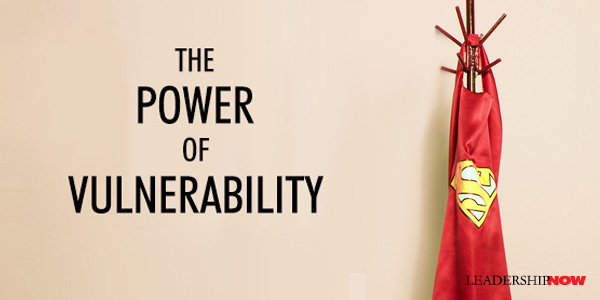
H In The Power of Vulnerability, Barry Kaplan and Jeffrey Manchester explain that the secret to unleashing the power of leaders, teams, and organizations, is through vulnerability. The more that leaders open their hearts, reveal their fears and show their authentic selves, the deeper the connections among team members will be, and the more the team will achieve. Part of what makes it work is that when we get behind the façades that we habitually put up, we begin to understand others better—their motivations, values, and beliefs. As we better understand what is going on inside of us, we will better understand what is going on inside of others and take their comments and behaviors less personally. We will begin to understand their points of view more completely. It generates respect and a willingness to share points of view that can strengthen the group as a whole. You don’t begin this journey to authenticity and vulnerability by giving away the store. There are real and imagined risks. Some environments carry more risk than others. “Imagine that there is a continuum of risk, on one end of the spectrum is where you shut down completely, and at the other end, you are wide open. You stand somewhere along that continuum as you subjectivity determine what’s what. That’s your spot of safety, where your internal risk manager allows you to play.” To take the first step, “you’ll need to get permission from your internal risk manager to take a small step, say to stretch just 10 percent, in showing vulnerability.” If you don’t believe it’s safe enough for you to share your opinions, you are not going to. Yet because you have clarity about what you want, you can now imagine the relational and team dynamics to ensure that you can express yourself more fully. Because you have clarity about your need to create safety, it’s already safer. As you also make it safe for others to show their vulnerabilities, it will become safer for you. Creating a safe space for others involves: 1. Getting Present: Set aside distractions. While you may feel safe in being disconnected, “if you’re going to be more open and vulnerable and show up in your power, then you must first shift from disconnection to the intentional practice of connection.” The authors suggest checking yourself mentally, emotionally, physically and spiritually. Where are you right now through these four energy centers? 2. Understanding and Committing to Guidelines and a Protocol for How We Are Going to Connect: For example, everyone commits to respect confidentiality, being present in the moment, staying when times get tough, speaking the truth, asking for what you want, owning your judgments and feelings, actively listening, and asking permission before offering feedback or advice. 3. Using the “Clearing and Resolution Model:” Clear the elephants in the room so that “everyone can be aligned with themselves and the people they work with.” There is a process of clearing that asks five questions; What are the facts? What are your perspectives? What are you feeling? What was your role in attracting the issue to you? What do you want specifically? 4. Completing Exercises to Take Steps Toward Authenticity: Break the ice with an exercise like everyone sharing a bit of themselves to get you to move out of your head to opening up emotionally to become more present. Create shared experiences. “The weekly or monthly meetings don’t count because the primary focus in those sessions is on the business of the company. Additional investment on a quarterly, semi-annual, and, at a minimum, annual offsite is required to help continue the momentum of trust and connection that has been established.” 5. Anchoring and Integrating the Process: Create a rhythm by creating rituals that serve to maintain the connection you’ve established. The heart of authenticity is connection. It has to be a conscious choice practiced over and over.
Begin the journey by practicing vulnerability in the hope that others on your team will really see you and seek a version of the journey for themselves. And hang up the cape.

Posted by Michael McKinney at 10:50 AM
12.22.17

Moving Your Agenda
M Samuel Bacharach writes in The Agenda Mover, that leadership is “about your capacity to take your ideas and work them through the maze of resistance, overcome challenges, and put those ideas in place. Leaders are remembered for their accomplishments, not their promises.” To that end, Bacharach has provided a practical guide to do just that. He presents a four-step process that anyone can learn to master with practice. To move an agenda, you need to learn to harness what others have to offer if for no other reason than you have blind spots. You need to build a coalition and develop the managerial skills required to maintain forward movement. It requires a campaign of pragmatic leadership. “Agenda movers are aware that their self-interest, emotions, cognitive capacity, and background can trip them up if they are not careful and that being smart is not a guarantor of success.” 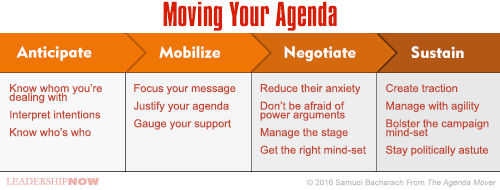 The four major stages in any campaign are first, you must anticipate the agendas of others. Second, you must mobilize your campaign. Third, you need to negotiate buy-in. And fourth, you must sustain momentum. In this post we will focus on the first stage—Anticipate the Agenda of Others—because this is the stage that most of us miss or move too quickly over and set ourselves up for frustration or failure. Anticipate the Agenda of Others This means knowing where others are coming from. Putting yourself in their shoes. Empathy. Our own egos are the enemy here. You need to know who you are dealing with—the stakeholders. Bacharach lists four: Top Dogs (organizational decision-makers), Gatekeepers (the liaisons), Gurus (senior individuals, external consultants, the board of directors), and the Players (people directly impacted by your agenda). The players are your essential ally. Never underestimate them. All of these stakeholders have their own agendas and ways they go about accomplishing them. There are the Tinkerers versus the Overhaulers and the Planners versus Improvisers that make up the Four Agenda Archetypes. There is the Let’s-Be-Careful Traditionalist, the Cross-That-Bridge-When-We-Come-to-It Adjuster, the Push-the-Envelope Developer, and the Tear-the-Envelope Revolutionary. If you know where you are coming from and where others are coming from you can begin to see what might motivate someone to join your change effort. This framework can help you do that. 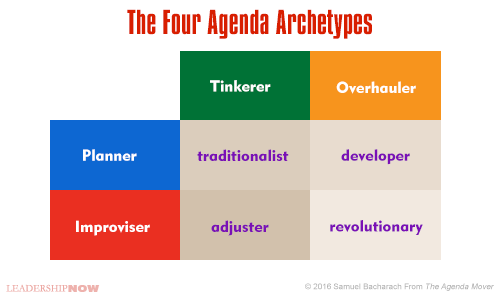 Distinguishing traditionalists from developers, developers from adjusters, and adjusters from revolutionaries allows you to identify where others are coming from quickly and efficiently. In making these distinctions, be careful not to assume that these agendas are immutable or that people are uniformly consistent from one situation to another. Of course, we are a factor in the process. We have our own motivations and our preferred ways of dealing with change. It is critical that we know where we are coming from too. We may need to adjust the approach we are comfortable with in order to move our agenda. The chart below helps you to see how your motivation relates to the motivation of others. “Allies are those who share your agenda, and it is easy for them to see where you’re coming from.” Traditionalists can anticipate that a Revolutionary will resist their approach and agenda. But here is a key insight: Agenda movers are leaders who understand that leading isn’t about meeting jubilantly with allies or reasoning earnestly with resistors. Successful leaders understand that the real challenge is in the gray area—converting potential allies into allies and making sure the potential resistors are not transformed into full-fledged resistors. Potential allies and potential resistors disagree with either your approach or your goals. Skillful negotiation may persuade these individuals to reconsider aspects of your agenda that differ from theirs. If you are not careful, potentials can easily switch to resistors. 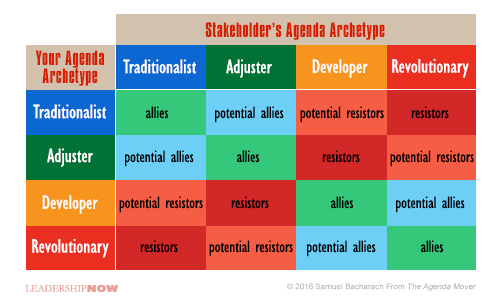 Mobilize Your Campaign Timing and tone make a difference. “To mobilize others you must: focus your message; justify your agenda; establish your credibility; and gauge your support.” You do not want to oversell here. Choose your words carefully to justify why your agenda should be supported. Make sure your idea is well thought through and you demonstrate the ability to see it through. Negotiate Support “Getting the buy-in is about shifting your focus from sharing your passion for your idea to really thinking about where the other party is coming from.” It is a process of reducing their anxiety. How will it benefit them? If they come on board, it is reasonable to assume that it can be done, will they get any of the credit, and are they protected if it fails. They want to know what changes for them. Your approach to the situation will make a big difference. You can approach it with a controlling, hardline mindset if this is a one-time thing. On the other hand, you can try a more cooperative mindset that seeks to pull-them-in. This mindset may allow you to build supporters for any future agenda you may have. Sustain Your Campaign This is where the rubber meets the road. After you’ve won people over, you have to get it done. “You may have sold your idea and created a coalition, but you can only sustain momentum and get results if your team can keep up its energy and focus in spite of challenges, obstacles, and setbacks.” To create traction, you need to celebrate small victories, make sure they own the idea and manage with agility. You have to be smart about how you present yourself and deal with others. You can micromanage your team, but you are better acting as a facilitator coach. To go the distance, your team must act with a collective purpose. You can sustain the campaign mindset by reminding them why they are part of your effort, reinforcing the payoff, keeping an optimistic outlook, and maintaining your credibility. It is crucial to remind people not only about the importance of the mission but also about how important they are to the mission. Anyone successful at moving an agenda knows that it is not a solo effort. “Failed leaders are those who assume that they are the most important player.” The Agenda Mover is a book that leaders at all levels would benefit from reading. It is common to see people trying to push their agenda without first defining what they are up against and without any understanding of the impact they themselves are having on others. Without that knowledge, we often resort to destructive behaviors to get our agenda moving. In that regard, this book is critical for anyone with an idea they want to have taken seriously. 
Posted by Michael McKinney at 12:45 PM
11.13.17

The Leadership Triangle
A The elite of higher education would have us believe that leadership can be taught, especially if you are one of the privileged attending classes at a top tier university offering courses in leadership. But there are others who believe leaders come out of the womb with a mission to lead. Either way, we assume that leadership is dependent on personality traits and/or skills. That once a leader, always a leader. But is this the case? Is the population to be divided simply into leaders who always lead and followers who always follow? Leadership is surely more complicated than that. Perhaps the question is not are leaders born or made, but rather, can leadership flourish in anyone when the circumstances for it are right? Does context matter? We tend to remember leaders who seemingly made the impossible possible, but it was always in a particular context. Leaders like Martin Luther King defined by the civil rights movement, Margaret Thatcher defined by the Cold War, and Bill Gates defined by the burgeoning personal computer industry come to mind. For the most part, history doesn’t record how these leaders dealt with contexts outside their defining accomplishments. We examine their leadership and develop theories about their strategies, their skills, and their personality traits. But to understand a broader view of leadership, we must look beyond these historic figures and observe the anonymous trailblazers in our midst. A different picture of leadership emerges. Hurricane Harvey in Texas demonstrated that “ordinary citizens” can step up to leadership when the situation is ripe for it. CNN captured a video of a local boat owner saying this: “We got eight people that done called for us already. So we’re going to go and get them eight, come on back, and try to save some more.” Crisis leadership in action. The story of Todd Beamer, a sales rep for Oracle, still produces chills in anyone who hears it. He is the young man who called 911 during the hijacking of United Flight 93 on 9/11 and declared, “Let’s roll” as he and presumably a few others commandeered the airplane to prevent the hijackers from achieving their goal. They were willing to die for it. Ordinary citizen leadership, however, need not be all about saving lives. Often it is about changing the status quo. Take Sheryl Sandberg, COO at Facebook, who took it upon herself to help women attain leadership roles in business, wrote a book about how to do it, Lean In, and started a foundation to promote it, Leanin.org. This was not part of her job. I’ve had the opportunity in my life to interact and work with some of the most impactful leaders in their fields. Among them is Steve Jobs who returned to the company he co-founded after being ousted in 1985 having learned how to deal with adversity and turned it around with a vengeance. Audrey Rust gathered steam from a passionate group of homeowners in Woodside, California, who wanted to protect the natural beauty in the expanse beyond their backyards and preserved 53,000 acres in Santa Clara, San Mateo, and Santa Cruz counties under her leadership of the Peninsula Open Space Trust. And Walter Isaacson, having established himself as a talented journalist and media professional in the business world, took the reins of the Aspen Institute during a period of severe decline and redefined it as a purveyor of rich and varied content for the intellectually inclined. Certainly, all of these people led others to fulfill a very particular mission and in so doing, created something out of nothing, something that made a difference in the world. But their leadership occurred in a particular context where their competence was significant, their confidence secure and their commitment established. The truth is, leadership is all around us, and it arises within a certain context in which the leader’s ability (competence) aligns with faith of accomplishment (confidence) and forms a mission (commitment). I call this the Leadership Triangle. So rather than ask if leaders are born or made, perhaps we should change the paradigm of leadership examination. Perhaps we have given short shrift in leadership study to the myriad people who find their competence, confidence, and commitment aligning with a particular context and jump in with both feet because there is simply no other choice but to lead.  An entrepreneur at the forefront of marketing, branding, positioning and communicating “The Next Big Thing,” Andy has played a key role in the launch of a number of new technology categories and products (including the Apple Macintosh) over the past 35 years. Today she advises startups, serves on several corporate boards, is a Henry Crown Fellow and a trustee at the Aspen Institute. She is a graduate of Northwestern University and lives in Sausalito on an old wooden boat with her husband, Rand Siegfried. For more information, please visit get2aha.com and follow Andy on Twitter 
Posted by Michael McKinney at 07:34 AM
09.22.17

5 Leadership Literacies You Will Need in the Future
F Looking Backward from the Future The present is too noisy to give us much in the way of insight. While most forecasters try to find a trend in the present noise, Johansen says we need to look ten years into the future and then looking backward from the future. “Looking long is using foresight to provoke insight and action.” Looking back from the future provides more clarity than the other way around. “The best way to lead in a disruptive world is to be very clear where you’re going, tell a great story about it, and then be very flexible about how you bring that future to life.” Although Johansen claims that anyone can do this, there isn’t much to explain just how that is done. The suggestion is to see through the noise now to a future that others cannot see to get clarity and dilemma flipping which is to turn unsolvable problems into opportunities. Nevertheless, he does offer some good general advice. The future rewards clarity, but punishes certainty. Having clarity and being certain are two different things. Clarity is simple. Certainty is simplistic. “Clarity is usually expressed in stories, while certainty is usually expressed in rules. Rigid rules can get leaders into a lot of trouble in the VUCA world, while stories encourage people to engage.” We can get stuck in the present and the issues of the day. “Sometimes, focusing on the future can help people move beyond the polarities of the present.” Looking back from the future gets us out of the present-day noise. Voluntary Fear Engagement Gaming allows the user to engage in risky or unknown situations in a low-risk, even fun way. A good game has a good story and allows you to be in the story—interact within the story. The most successful games are multi-player games. Gaming communities learn from each other and together. Johansen believes that “gaming will become the most powerful learning medium in history.” The military, for example, uses simulations to train soldiers. Business needs to learn how to do the same. “Gaming, simulation, role-playing, improvisational theater, immersive travel, and similar experiences can help leaders create safe zones to practice their own leadership.” Gaming allows for immersive learning. “The whole point of gameful engagement is to immerse yourself in a realistic but mock fearful environment and learn how to thrive, or at least push through it.” Gaming combined with gaming communities will allow users to learn in low-risk immersive experiences that allow them to prepare and practice. Shape-Shifting Organizations Shape-shifting organizations are those that have no center, grow from the edges, cannot be controlled, and where hierarchies come and go. “The best organizations will be characterized by partnerships of mutual benefit.” Not surprisingly, Johansen believes we are moving toward a future of distributed authority. That is to say, leadership is distributed and varied. Hierarchies are formed where they are needed and disbanded when the job is done. “Shape-shifting organizations grow from the edges, and it is at the edges where diversity and innovation thrive.”
Being There Even When You Are Not
What Leaders Need to Do Leaders must make a disrupted world more hopeful. Being dealers in hope if key. “Globally, a large number of people will be lacking in hope and unable to achieve a sense of meaning in their lives—and they will be very connected through digital media.” That hole needs to be filled with a positive hope and shared meaning. “A world of continuous disruption will be too much for many people to process—and many people will be susceptible to simplistic and dangerous calls to action.” Fear is created by a lack of exposure. Leaders will need to be exposed to more globally and be willing to learn from a wide variety of sources. Johansen cautions: “It’s one thing to believe you’re right and have clarity about a future direction. It’s quite another to believe everybody else is wrong. Clarity can degrade into certainty.” 
Posted by Michael McKinney at 11:51 AM
09.06.17

The Potential Principle: How Good Could You Be?
Y This is a case where it’s easy to think that good is good enough and get comfortable. Most of us live below our potential. As a result, we miss out on opportunities and therefore live below our true potential and hinder our ability to contribute to others. The Potential Principle by Mark Sanborn is about how we can become better – even better than our best selves. It’s not about perfect. It’s about better. So you might ask, “Better at what?” Sanborn presents a program to get you on the road to better. First, you need to figure out just what you want to improve. What Do You Want to Improve? Your journey toward better can be organized into four areas: Performing, Learning, Reflecting, and Thinking. Improvement happens by not only things you initiate like interactive, collaborative activities but also by responding to what you hear, observe, learn as represented by the vertical line. Improvement also takes place in both our inner (things going on inside us) and our outer (things going with others) worlds as represented by the horizontal line. It’s about the inner world of being versus the outer world of performing.
Performing The top right quadrant is the most familiar to us. “It’s where most of us consciously spend each day doing things: the observable world of initiating, acting, and producing.” It’s what people expect of us when we show up – results. It takes deliberate practice. Performance improvement is not a straight line. There are plateaus. Also, keep in mind the FIT model: Frequency, Intensity, and Technique. How often you practice, the intensity you bring to it and the techniques you use, make all the difference. Learning Learning involves the acquisition of new ideas that we put into practice. If we approach life humbly, we will be enriched by what we do not know. Intentional curiosity keeps us growing. “Develop a learning agenda.” Identify what you must or need to learn and then make the time and find the resources to do it. Reflecting Reflecting is the inner world of responding. This is an underappreciated value in our instant, tech driven world. It’s about waiting and listening. “Epiphanies—that is, clarity and deeper understanding about yourself and how to improve your life—happen through introspection.” It’s easy to think that we have no time for this and focus on the outer world of doing, but, says Sanborn, “the inner world informs the outer world, and that for the majority of us, going within to understand motivations, hopes fears, and dreams offers some of the greatest leverage to improving every area of our lives.” Thinking Think about thinking. “Thinking is about proactively contemplating the world around you. It’s the source of vision, dreams, plans, and strategies. It uses external input and creates connections and directions.” Make the time to think about what you need to learn and unlearn. Focus your thinking and write it down. “Some of the biggest payoffs from thinking will occur when you review notes of previous thinking sessions and add to or modify what you came up with.” Sanborn explains each of these areas in more detail to help you develop the right mindset. Improvement in these four areas are key to improving consistently. To be sure, each of us is more comfortable on one or two of these areas. If you are not spending enough time in an area, that will signal an area where you could improve. “Each area complements the others. If you are headed toward better, you’ll want to use each of the four areas identified. Doing so will help you reach your destination sooner and, perhaps more important, enrich the trip.” Four Tools for Breakthrough Improvement These four tools will help you “prevent complacency, create improvement, and bust through barriers” on your improvement journey.
The ideas you will find in The Potential Principle are not all new, but they are organized in such a way as to make them actionable. Sanborn has done a great job of laying the foundation and providing a blueprint for continuous improvement. All you need to do now is to put it into practice.

Posted by Michael McKinney at 06:28 PM
08.18.17

4 Things Solitude Will Do for You
W I know none of us have any extra time, but there is overwhelming evidence that taking a time-out to simply think is foundational to your success. Raymond Kethledge and Michael Erwin explore some solid reasons why you must make the time to think in Lead Yourself First. When we say solitude we mean a “subjective state of mind, in which the mind, isolated from input from other minds, works through a problem on its own.” There is no particular structure to it—place, time, or length—but it must focus the mind. It’s scheduled white space—a commitment you make to yourself simply because your leadership begins with who you are—not what you do. So let’s look at four things solitude will do for you. Clarity Clarity is about what is true. What is signal and what is noise? Solitude facilitates that distillation process. It helps you to eliminate or deliberately deemphasize all distractions. That alone will help you to make the time to think. Clarity and focus go hand-in-hand. That kind of focused attention is often best done alone. Intuition complements analytical thought. When we get stuck, “intuition can provide clarity when analytical thinking cannot.” The challenge is accessing it. Accessing intuition requires “a deeper form of solitude: an absence of inputs not only from other minds, but also from one’s own.” Clarity is important for decision-making but it is also critical for understanding who you are—strengths and weaknesses. It helps to connect you with your core values and understand your place from that perspective. Creativity Solitude opens the path to creativity. Solitude isn’t always the shortest distance to the goal. Joey Reiman, CEO of the consulting firm BrightHouse, credits their success to their “longer, incubation pace.” On one project he says, “If we had moved at a faster, business pace, we never would have excavated that original brand identity and then generalized it into a new ethos.” Dena Braeger, mother of six in El Paso, offered this insight into information overload: People make such an effort to copy what other people do, because we have so much access to information. I’m surrounded by people on Pinterest. I’ll be dammed if I make something on Pinterest. You’ll see things like these cupcakes that look amazing. And people copy them. But on the inside their phony, because the person didn’t create it themselves. We’re getting more of everything, but less of what is authentically ourselves. If we spent more time alone, creating something that might not look as amazing but is more authentic, we’d value ourselves more. Creativity is doing something differently than the norm. Solitude allows us to get away from the inertia of our environment and connect to new possibilities. Emotional Balance Emotional balance requires you to respond rather than react. General James Mattis finds a lack of reflection the single biggest problem facing leaders. “The leader who neglects to step out of the sweep of events, to contemplate from whence they come and where they might go. Finds himself merely blown from one thing to another. But the leader who steps outside events is a leader who can change them.” Solitude allows you to reflect on what is making you emotional and provide clarity on the issue. Often what you are emotional about is more of a distraction than an issue. Again Dena Braeger, the West Point graduate and mother of six in El Paso, said, “When I’m practicing solitude regularly, I self-correct so much better. I’m more focused on what’s important, and I let things go that aren’t important.” Instead of allowing our emotions to adversely affect our leadership, it is wise to move away and deal with them in private. Our emotions will find an outlet somewhere. And that is best alone than in decisions made through unfiltered emotions that affect those around us. Moral Courage We’ve all seen them: leaders who take themselves too seriously—who believe their own press release. And it’s all too easy for any of us to fall prey to self-admiration. “Honest reflation can deflate these pretentions.” Reflection can pave the way to humility. Solitude allows you to slow down and be clear and firmly convicted of your values and beliefs. “Leaders who are well anchored in what they believe are going to be more effective,” says Doug Conant, the former CEO and president of the Campbell Soup Company. When those criticisms come along that are design to enforce conformity, it is easier to weather the storm when you know that what you are doing is the right thing to do for the right reasons. It is the power to rise above. Reclaiming Solitude Brené Brown, author of Daring Greatly, says that “The biggest mistake I’ve made in my career to date is believing that solitude is a luxury. I could chart the ups and downs of my quality of life personally and professionally and the amount of time I spend in solitude.” As important as it is, it is easy to let it slip away without even realizing it. We are continuously bombarded by pressures—both personal and social—not to stop and reflect but if we lose our solitude, we will lose who we are. You don’t have to go off to a mountaintop or sit at the seashore. It can be a closed room, the library, a park bench, and even a waiting room. We have a responsibility to seek out periods of solitude. We owe it to ourselves and those we lead. Of Related Interest:

Posted by Michael McKinney at 04:05 PM
07.10.17

The Mathematical Corporation
Y A mathematical corporation is one that takes advantage of machine intelligence by collaborating with it to achieve leading-edge results. It will require a shift in your thinking. “As a leader,” say Josh Sullivan and Angela Zutavern in The Mathematical Corporation, “you need to evolve your focus to excelling through imagination, creativity, reasoning, and problem structuring.” Leading in the era of the mathematical corporation means learning to work with the machine to investigate mountains of data not by braking them down, but by keeping them together to mine insights never before imaginable. It means being able to distinguish what machines are good at doing from what people are good at doing. When people and machines are appropriately paired we can explore heretofore impossible strategies and execute incredible solutions. Machines will not replace people but we will need to develop and capitalize on some uniquely human skills. “People will continue to be better than machines at many of the loftiest cognitive tasks, like asking questions to clarify a problem, composing experiments to test hypotheses, and drawing on truths in one discipline to elicit insights in another.” Because of the machine’s ability to synthesize vast amounts of data, it would be wise to question your own judgments when machines offer a different conclusion from your own. Machines, for example, can recognize patterns better than we can. That said, “computers don’t know the cause of a pattern. They don’t have the human appetite to get to the bottom of the matter, and they don’t ask, ‘Just how does cause A lead to effect B?’ They learn, infer, and have high recall accuracy, but they don’t know the story of cause and effect. So, the task of taking a cause-and-effect understanding of a business system and crafting a strategy from it remains a people job.” Getting the Questions Right While Big Data adds complexity, it is only a problem if you don’t know how to mine it for value. The key skill for leaders is to be able to ask better questions than to offer solutions. Asking the right questions is critical. Poor questions lead to questionable insights. “That’s why as a leader, you need to remain at the tip of the process, seeing the world in a much broader and more differentiated way than others.” Not only asking the right questions but removing our own biases from them, will bring us breakthrough insights and more nuanced answers. Another issue we will have to work through is not projecting our limitations and constraints on the machine. Although we have a mental model that we filter the world though, we must be careful not to constrain the machine—our questions—in the same way. What About Intuition? In the mathematical corporation, the role intuition will shift from judging reality to judging models. “No matter your feeling on intuition, its role is destined to shift to a smaller, if still critical position. As machine intelligence converts implicit understanding to exploit facts, replaces implicit assumptions with data-givens, counters biases with hard evidence, we have to admit the superiority of the cold facts encoded in 1s and 0s.” Often it will require a leap of faith on our part. We will need to learn to ask bigger questions and questions that will lead us to better questions. The best machine collaborators will see this as a learning journey. “Conventional strategic planning practice calls for a relentless search for answers during a detailed analysis of context and a relentless analysis of the opportunity to find the right answer in one go. But when the answer is over the horizon, no amount of analysis of the landscape up front will reveal it. You need to go on a learning journey—sailing to the far shores to find the best answer.” It requires a commitment to a cycle of questioning and learning, questioning and learning. As digital technologies continue to develop and improve, leaders will need to become wise and discerning leaders of machines. Leaders will not only be expected to use this technology to their advantage to solve their own organizational issue but to help answers the questions that exist beyond their own walls.   
Posted by Michael McKinney at 05:24 PM
07.05.17

The Bridge to Growth
W In today’s business climate, the cadence between strategy and execution is compressing, making the integration of the two more important than ever. Too many workers are being left out of this equation. More and more people are disconnected from their company’s goals, even though they still report being satisfied with their jobs. A Global Workforce Survey conducted by Towers Watson revealed that a mere 21 percent of workers feel engaged and truly committed to their company’s success and goals, even though 86 percent report liking their jobs. Is this reflective of a failure of leadership, a shift in the attitudes of today’s workers, or both? Apparently, many people are settling for a job that satisfies their basic needs, yet denies them a motivating answer to two important questions: “How does my personal work connect to my company’s goals, and how can I help us achieve them?” In these cases, leaders have unfortunately failed to fully engage workers in either the development or execution of their company’s mission, goals, and ultimately its journey toward success or failure. Too often, workers are being over-managed and under-led. I believe this “commitment gap” represents the largest source of untapped potential to create economic value in our society today. How can leaders tap into this gap and raise the performance bar? This question matters more now than it ever has. As our world becomes more socially connected, more women progress into leadership roles, and millennials seek more meaning and purpose in their work than previous generations did, the principles of servant leadership are becoming more relevant than ever before. Based on my experience leading high performing teams over the last 36 years, I developed a blueprint of nine proven leadership principles I've used to improve the performance of several businesses by moving workforces from satisfactorily disengaged to enthusiastically committed to winning: 1. Grow leaders and difference-makers, not just followers. 2. Build and orchestrate synergistic, high-performance teams more powerful than the sum of their parts. 3. Focus your organization on strategic priorities and simplify operations to accelerate progress. 4. Champion the people who purchase and use your products and services. 5. Cultivate a performance-based culture of innovation that unleashes the innate desire in the people you lead to solve, create, and contribute to winning. 6. Communicate relentlessly to give your workforce the context they need to sign up for and truly commit to achieving company goals. 7. See the world through the eyes of others, and your example will breed a healthier organization. 8. Be the model you want emulated. Operate transparently, deliver on your promises, and remain steadfastly focused on doing the right things. 9. Coach people to achieve more than they thought possible. They need a model of success more than they need a critic. Inspire your entire organization to step up by revealing what success looks like, catching people doing something well, and showing your gratitude publicly. If you connect with these principles, I encourage you to check out my new book The Bridge to Growth. It's packed with useful tips and tools, and each leadership principle is articulated using real-world success models that bring the principles to life.  
Posted by Michael McKinney at 12:03 AM
06.26.17

What Sets Apart the Greatest Teams of All-Time?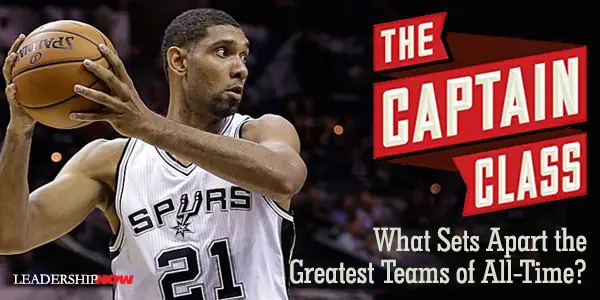
S Ironically, it wasn’t the Roy Keane’s or the Michael Jordan’s that made it happen. “The best leaders in sports history were not mesmerizing characters. They didn’t always make for great television. That’s what we’ve come to expect, however. So that’s what we continue to get.” And so teams choose the wrong people to lead them. They promote people with the wrong characteristics. It’s typically not the player with the highest market value. What it takes to lead is not always what it seems. What Walker discovered are the Seven Traits of Elite Captains. They explain why captains of exceptional teams are so influential. And it explains why we often look for the wrong kinds of leaders to lead us. 1. Extreme Doggedness and Focus in Competition Elite Captains just keep coming. They overcome a group dynamic known as social loafing. It’s what happens when a single person’s contribution to a team is not noticeable or unidentifiable. We put less effort in. An Elite Captain improves everyone else’s performance by leaving nothing in reserve themselves. Their willingness to give everything—all of the time—encourages the rest of the team to raise their effort level to match. 2. Aggressive Play That Tests the Limits of the Rules Elite Captains play the edges. Walker identifies a “hostile” variety of aggression to do harm and an “instrumental” variety that is used in pursuit of a worthwhile goal. “While the captains of Tier One often did ugly things, they did so while operating within the fuzzy confines of the rules of sports. (Although you can try to parse aggressive behavior and justify some but not all, it does matter how you win. Contrary to the examples of a couple of Walker’s Captains, winning at any cost is not a sustainable value.) 3. A Willingness to Do Thankless Jobs in the Shadows An Elite Captain serves. This finding is worth giving a little extra thought to. It is the person willing to carry the water that makes the best captain. “In fact, superior leadership is just as likely (if not more so) to come from the team’s rear quarters than to emanate from its frontline superstar.” Walker relates the story of the San Antonio Spur’s Tim Duncan. Duncan suppressed his own skills (and salary) in order to promote the goals and values of the team. “By lowering himself, he was able to coax the maximum performance out of the players around him.” Walker notes: “One of the great paradoxes of management is that the people who pursue leadership positions most ardently are often the wrong people for the job. They’re motivated by the prestige the role conveys rather than a desire to promote the goals and values of the organization.” 4. A Low-Key, Practical, and Democratic Communication Style Effective teams talk to one another and the person that fosters that culture is the captain. “They engaged with their teams constantly—listening, observing, and inserting themselves into every meaningful moment. They didn’t think of communication as a form of theater. They saw it as an unbroken flow of interactions, a never-ending parade of boxing ears, delivering hugs, and wiping noses.” 5. Motivates Others with Passionate Nonverbal Displays Jack Lambert of the Pittsburgh Steelers, went out of his way on the field “to project extreme passion and emotion.” This is distinct from verbal communication. Great captains project their feelings to have a strong impact on the thoughts, feelings and emotions of their teammates. Communication-based on displays rather than words. 6. Strong Convictions and The Courage to Stand Apart All of the Tier One captains stood up to management in some way in their careers. It served to bring the teammates closer together and cement their leadership. Some dissent is a good thing and captains should stand up for the team even at the risk of displeasing superiors. But they focus on task conflict and not personal conflict. “Tranquility isn’t more important than the truth—at least the kind that’s told by a captain who is known to be fiercely committed, who labors in the service of the team, and who avoids attacking people on a personal level.” 7. Ironclad Emotional Control Elite Captains have a kill switch; they are able to mute their personal emotional tendencies. Emotion and enable and it can disable. The Elite Captains walled off “destructive emotions in order to serve the interests of the team. They developed a kill switch for negative emotions.” What Does This Say About Leadership? Walker says we overcomplicate things. “We’ve been so busy scanning the horizon for transformational knights in shining armor that we’ve ignored the likelier truth: there are hundreds upon thousands of potentially transformative leaders right in our midst. We just lack the ability to recognize them.” We are often swayed by the force of a person’s personality or talent, but real leadership is not readily found on a resume. It’s found in the day-in and day-out activities that reveal who they are. The truth is that leadership is a ceaseless burden. It’s not something people should do for the self-reflected glory, or even because they have oodles of charisma or surpassing talent. It’s something they should do because they have the humility and fortitude to set aside the credit, and their own gratification and well-being, for the team—not just in pressure-packed moments but in every minute of every day. 
Posted by Michael McKinney at 01:00 AM
03.08.17

Humility Casts a Wide Net
HUMILITY casts a wide net and makes possible the work of leadership. Nothing facilitates community, collaboration, and innovation like humility. In Humility is the New Smart, Ed Hess and Katherine Ludwig define humility as “a mindset about oneself that is open-minded, self-accurate, and not all about me, and that enables one to embrace the world as it is in the pursuit of human excellence.” Their definition encompasses the mind of a leader that will be able to lead in a changing and uncertain world. Humility is inclusive. It is inclusive of others ideas, others needs, others strengths, other contributions, and the realities that exist outside of our own head. A humble leader asks more questions and is open to more answers thus deepening the pool of resources they have to draw upon. But it requires a strength of character. As senior vice president of the NBA’s Orlando Magic, Pat Williams writes in Humility: The Secret Ingredient of Success:
Additionally,
Humility is the antidote to insecurity that often plagues us. A lack of humility actually drives insecurity. Humility makes your strengths productive and multiplies the strengths of others. Humility acknowledges a world beyond our own thinking and minimizes our own limitations. A good leader knows this and acts accordingly to produce the best results. Do you have the strength to be humble?
Posted by Michael McKinney at 10:50 PM
05.25.16

Robert Gates on the Essentials of Leading Change
IN A TIME when change is not just inevitable, but must be encouraged and led, Robert Gates’ A Passion for Leadership is a must-read. Gates has led and continues to lead in a wide variety of organizations and organizational cultures. His collected wisdom serves to inspire us to lead others where they don’t often want to go and improve people’s lives. In addition to serving on numerous corporate boards, he has served as a United States secretary of defense, a director of the CIA, served eight presidents, served as president of Texas A&M University, and is currently the chancellor of the College of William and Mary and president of the Boy Scouts of America. The one feature of the institutions with strong cultures he has led has been a strong sense of family. He describes it as a “commitment to taking care of one another at all times but especially in adversity or times of need.” All great cultures do have this sense of family. At the same time, it is easy then to become insular and tolerate long-standing but inappropriate practices and behaviors because they are a tradition. It is important to define what traditions must be defended and those that must be changed to enable future success. “A good leader,” writes Gates, “must keep coming up with new perspectives, new ideas, new improvements. Only a committed leader can keep an organization—a bureaucracy—on its toes, continuously adapting, innovating, improving.” Gates recognizes that we need leaders at all levels in an organization that are able to mobilize the willing and bring about productive change. More often than not those leaders are there, they just need to be liberated by the person at the top in an organizational culture of leadership. Not surprisingly, he identifies listening as the most critical thing a new leader can do. “Never miss a good chance to shut up.” CIA director Bill Casey gave him some good advice early on. “Bill advised me not to focus on what I disagreed with but to see if there were one or two kernels of information or wisdom worth seizing on—finding a little wheat amid all the chaff. Just because 95 percent of what someone says is nuts, he would say, laughing, doesn’t mean you should ignore the 5 percent that might be useful. (He was always handing me pamphlets or books to read, warning, ‘This guy is crazy, but there’s an interesting idea on page x.’)” To be an effective leader, one must demonstrate from the start an understanding of and respect for the role and views of the career employees in an organization and be clear that the new boss intends to make them participants and partners in reforming the place. This is the best possible preparation of the bureaucratic battlefield. And that doesn’t mean just rearranging the organizational chart. “The main target is how people do their work, not where.” Gates offers from experience, strategies, techniques, and principles for implementing change. He includes many examples from the organizations he has served. Leading change is hard work and can’t be done from on-high. Gates cautions that while micro-knowledge is necessary, micromanagement is not. “For a leader to get the big things right depends a great deal on knowing the little things, especially when implementing difficult and controversial change. Without micro-knowledge, you are the prisoner of your bureaucracy and your staff, and they will play you like a cheap fiddle.” Fundamentally, leadership is always about people. I’ll leave you with a few thoughts from Gates on leading: ☙ You can be the toughest, most demanding leader on the planet and still treat people with respect and dignity. ☙ A self-confident leader doesn’t cast such a large shadow that no one else can grow. ☙ Leaders who think they don’t need frank, critical advice every day are usually doomed. ☙ To change bureaucracies effectively, a leader must first make his people proud and eager to excel. ☙ Formal education can make someone a good manager, but it cannot make a leader, because leadership is more about the heart than the head. ☙ Core to leadership is the ability to relate to people—to empathize, understand, inspire, and motivate. ☙ If you fundamentally don’t like or respect most people, or if you think you are superior to others, chances are you won’t be much of a leader. 
Posted by Michael McKinney at 06:56 PM
04.07.16

The One Ingredient You Must Demonstrate in Your LeadershipPerry Noble suggests that there is one ingredient that would make a lot of leadership issues go away. In The Most Excellent Way to Lead, he turns to the advice of the apostle Paul in 1 Corinthians 13.Paul had a lot to say about leadership and rightly so. Leadership comes to us naturally but without some guidance it’s not just easy to get it wrong, it's highly probable. In Paul’s first letter to the Corinthian church, he is discussing – in chapter 12 – how people should work together and points out that we all have roles but that none is more important or better than another. Just different. And then at the end of chapter 12 he lists some of the roles needed in the church, but then he says in chapter 13 that no matter who you think you are or how gifted you think you are, if you can’t do it in love—outgoing concern for others—then you are nothing. Your leadership doesn't matter. You aren’t doing it right. It sounds like Paul is just saying play nicer, but he’s talking about serving others in some of the most difficult ways possible. “The most excellent way to lead is also the most difficult. It goes against our natural tendencies and the culture we live in, and it highlights the fact that leadership is ultimately about the leader.”Paul is taking about being patient with others when your patience has run out. Being kind when they don’t deserve it. Being supportive of other people’s success and helpful when they stumble. Looking out for the best interests of other’s before yourself. Never keeping a tally of other people’s failures and wrong behaviors. Always seeking the truth even when gossip is more believable. Choosing to trust others when it would be easier to be suspicious of them. Being optimistic even when circumstances compel you to do otherwise. And never giving up on people even when you are discouraged. Noble does a good job explaining each of these and more both on a personal level and organizationally. “The way we look at other people is important,” writes Noble, “and when we see them through the lens of love, our capacity to lead significantly increases.” Without love, as Simon Sinek has pointed out, “people are forced to spend too much time and energy protecting themselves from each other.” Mark Sanborn adds, “when we allow love to define who we are as we work, we become irresistible leaders with a contagious passion for what we do.” This is how we get things done through others. This is how we develop others and allow them to flourish under our leadership. It’s how we build more leaders to carry on after we are gone. 
Posted by Michael McKinney at 10:02 AM
02.16.16

The Superboss Playbook
IMAGINE A WORLD a world where the person who you call your boss changed your life by helping you accomplish more than you ever thought possible. In every industry there is a leader that stands out. A Superboss. What is their secret?In Superbosses, Sydney Finkelstein discovered that although they may differ in leadership styles, they share a playbook that leads to extraordinary success founded on making other people successful. Superbosses can be fierce or gentle, belligerent or self-depreciating, but whatever their style, they do a much better job inspiring and teaching because they get in their trenches with protégés, leading by example and giving them personalized attention they require to move up quickly. Here then is the outline of The Superboss Playbook – Techniques, Mind-Sets, Philosophies, and Secrets of the World’s Best Bosses: Superbosses recruit people who “get it.” Superbosses are uncompromisingly open. Superbosses embrace the apprenticeship model. Superbosses are traders in opportunities. Superbosses fashion teams that function as a “band of brothers.” Superbosses create a strategic alumni network. We need new approaches to nurturing people and the Superboss Playbook presented by Finklestein, is completely learnable by any leader who is fearless, competitive, imaginative, credible, and authentic. Superbosses is a fascinating look at the leaders that flourish and often change their industries by developing a future generation of leaders. If you are not working for one, this book will help you to become one. The Three Types of Superbosses Glorious Bastards: These superbosses care about one thing: winning. They’re the ultimate hard drivers, yet they realize that to get the very best results, they need to develop the world’s best people and teams. So they do.
Nurturers: These coaches and teachers resemble traditional mentors the most. They take pride in bringing others along and care deeply about the success of their protégés. They help people accomplish more than they ever thought possible.
Iconoclasts: These executives usually operate in creative fields, where their single-minded passion for their work inspires their protégés.
Available too, is The Superbosses Playbook: A Workbook Companion to Superbosses. It shows readers how to apply the tactics of these "superbosses" in their own organizations. It features assessments, case studies, and exercises designed to help anyone recruit talent, lead performance, inspire teams, and even part with great people like a true superboss. 
Posted by Michael McKinney at 08:40 PM
01.27.16

Leadership Value is Defined by the ReceiverWE ALL RESONATE with the clarion call for leaders to build on their strengths, be authentic, and demonstrate emotional intelligence. We can envision these noble, resonant, and genuine leaders as icons of effective leadership. But these virtuous leadership attributes are not the essence of leadership effectiveness.Building on one’s strengths is incomplete unless one’s strengths strengthen someone else. Authenticity without a positive impact on someone else is more narcissism than leadership. Effective leaders turn their emotional intelligence into helping others find their purpose and meaning. An underlying principle of effective leadership is that value is defined by the receiver more than the giver. This value-added principle applies in almost every relationship. When I give my wife a gift, she defines the value of the gift. When I was newly wed, I got her tickets to sporting events and she often suggested I enjoy myself. I have learned that the real gift is figuring out what will be meaningful to her, not me. Likewise, effective leaders recognize and serve the stakeholders who are impacted by their strengths, authenticity, and emotional style. They then work to deliver value to these stakeholders in ways that matter to the stakeholders. When leaders focus on the value they create for others, they think less about who they are and how who they are, will make others better. They realize that the value of their values is in that others will achieve what matters to them. Ultimately, leaders are measured by what they leave behind and how their present actions shape future success. Leaders should be asking themselves, “Who are the stakeholders I care about? Who do I want to make better because of what I do? Who will benefit from my choices today? How will my actions be seen by and affect others?” When pondering and responding to these questions, leaders matter because they create sustained leadership in others. Value creating leaders talk more about “we” than “I”; they build on what is right more than what is wrong; they help others feel better about themselves when leaving an interaction with them; the work to institutionalize their ideas so that they are sustained; and they relish success in those they mentor. It is time to look beyond a leader’s personal strengths, authenticity, and emotional well being to define how leaders’ build value for others. 
Posted by Michael McKinney at 07:07 PM
12.22.15

7 Coaching Skills that You Need as a Leader
Whether you like it or not – if you are a leader, you are a coach.Coaching exerts enormous leverage. People struggle at work and at home. No one leaves their problems at the door when they come to work. And it affects their performance. Coaching is critical. Developing people is or should be a top priority of leaders. Coaching doesn’t mean fixing people. It is developing a relationship that allows you to help people break through from one level of performance to another. It is unlocking potential. Michael Simpson writes in Unlocking Potential that coaching is built on four principles: Building Trust: “Simply being in a position of authority does not make you a trusted coach. Your concern for the person you are coaching must be based on genuine and good intent. Your integrity must be inviolable. Your determination to keep confidences must be unshakable.” These are issues of your character. Tapping Potential: “When a coach helps a person challenge their paradigms, they can more readily take responsibility for their life or situation. When they learn to align their paradigms to reality, many of the barriers to realizing their potential begin to fall.” “Potential suppressed by years of self-defensiveness, self-betrayal, or self-denial.” Creating Commitment: You can’t make people commit, “But you can create the conditions where people commit to goals they themselves want to achieve.” This is done primarily by asking powerful coaching questions. Executing Goals: “All successful coaching conversations need to link directly to actually meeting key performance indicators, measures, and objectives.” Coaching is a skill with its own set of competencies. Simpson gives seven:
Simpson provides you with the essential questions and approach behind each of these skills. One of the benefits of coaching is that it also helps you to develop you. It holds you to a higher standard.   
Posted by Michael McKinney at 08:33 PM
12.11.15

Are You Trading Influence for Attention?
PEGGY NOONAN brought up some great thoughts in her editorial, A Rash Leader in a Grave Time that would be good for us to consider in any time. She was referring to the presidential campaign of Donald Trump, but too frequently we see the tendency of leaders in all walks of life, to use their “mouth as a blunt instrument” whenever they feel they are in the right, have a just cause, want to get attention, or simply want to put their foot down. Their comments may not be as flamboyant as Donald Trump’s, but they are just as dismissive. Some people find that to be an admirable quality in a leader, until of course, they don’t. When the leader steps on their toes, then the undisciplined rhetoric comes across as contemptuous. Noonan says that the problem arises when a leader “doesn’t think it through, doesn’t anticipate legitimate pushback, doesn’t try to persuade, only declares.” It is disrespectful and shows a lack of self- and situational-awareness on the part of the leader. 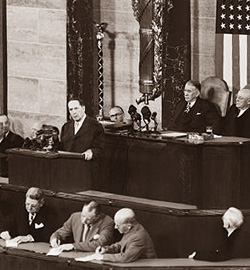 She uses the word politesse in this regard. In a time when grabbing attention is more important than civility, politesse it not a practical value. Taking the time to be civil or polite and to polish our words is a luxury we can’t afford or we may miss adding our voice to what’s trending. The pressure to respond doesn’t often leave us the time to be thoughtful, measured, and disciplined on our approach. We have to fight the forces that would intimidate us. That doesn’t mean we can’t be remarkable in our speech. Noonan encourages, “It is possible for candidates to be vivid but careful, dramatic but responsible.” Politesse is a word that implies sacrifice which is at the core of good leadership. Sometimes we have to sacrifice our raw emotions for disciplined thought; our efficient bluntness for long-term understanding.
Posted by Michael McKinney at 03:11 PM
12.08.15

5 Leadership Lessons: Players First His Players First philosophy is summed up this way: “I coach for the names on the backs of the jerseys—not just the front. My players. They are sent to me by their fathers, their mothers, their grandmothers, their aunts—whoever in this world raised them and loves them. Others look at their NBA bodies and consider them lucky. Future millionaires, just stopping through before they cash in. That’s not what I see. They’re kids, some of them as young as seventeen years old. They all need me in a different way. Some want my affection, others my approval. It’s a burden to be responsible for other people’s children, sometimes a heavy burden.” From this mindset comes this key point that any leader could ask. “If I’m struggling with a player, it’s where I ask myself: How would I want my own son treated?” These ideas are worth considering in your own leadership situation: You have to be strong willed. You can’t have a mental picture of yourself that’s not accurate. Along the same lines is this note sent to a player: Alex, work hard to improve your body language. Body language is a facial expression, slouching, dropping your head, how you sand, how you sit, how you speak. Begin today. God created you as a winner and he has big plans for you. Work with him. Be the best. When you feel like you want to drop your head, lift it up. When you feel like slouching your body, stand up straight. When you want to frown or have a sour face, smile. When you feel like complaining, encourage someone else. When someone corrects you, thank God because they care. 
Posted by Michael McKinney at 10:58 PM
12.04.15

The Gift that Keeps on Giving
LEADERSHIP is stewardship. It requires a long term perspective. It is difficult because it is fundamentally a process of reconciliation; a process of bringing a community of people together towards a common purpose. It is service. Stewardship requires that the organizational leaders put leadership in the hands of every member of the organization. It gives them ownership of the future. As leaders, it is where we can contribute the most good for society as a whole. It’s good stewardship. In Bob Chapman and Raj Sisodia’s remarkable book, Everybody Matters, they explain the idea this way: So many American businesses destroy lives every day, but we make a lot of money, and then we feel really good when we write a check to the United Way for $1 million. But I believe we are creating the need for the United Way in the first place by destroying the lives of people who create the wealth that enable us to give. I believe the greatest charity is what we could do at work every day to take care of the people entrusted to us. As a leader, ask everyone you influence, “How can I serve you?” 
Posted by Michael McKinney at 02:52 PM
11.17.15

Leadership BS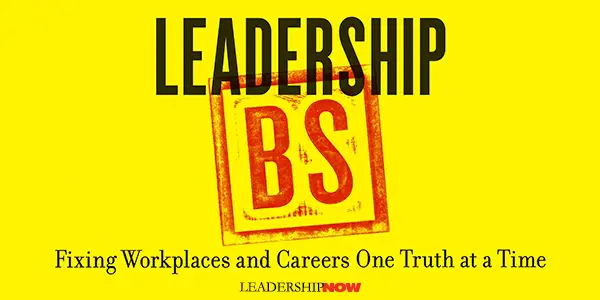
Leadership BS by Jeffrey Pfeffer, is a very important book. It actually builds on the ideas and thinking presented in his classic book written with Bob Sutton, The Knowing Doing Gap over a decade ago. Pfeffer wants to know why, in spite of the thousands of leadership books, blogs, and seminars, are there so many leadership failures? Pfeffer believes that the answer is to be found in the systemic processes that produce leaders who often behave differently from what most people might like or expect. He’s right. As a society, we produce and reward leaders who think short-term, and this is at odds with what it takes to get the leaders we think we want. As we look around there are disconnects between: • what leaders say and do,
It’s not surprising that students of leadership often become disillusioned upon entering the workplace. Life rarely adheres to the good leader formula of success they have come to know. Leadership BS is a compendium of human nature. It describes well the hypocrisy in all of us. We don’t always meet our own standards. We don’t always reward what we say we value. The real world doesn’t behave as it should. These are life issues as much as they are leadership issues. Consider the following comments from Leadership BS: Once people believe they are better leaders—possibly because they have given talks or written about positive leadership, have attended lots of leadership trainings, or because they were once acknowledged for their good leadership—they are less likely to be as vigilant about their subsequent behavior, having already demonstrated their leadership credentials. And finally, this would seem to be a fairly typical experience. Pfeffer was asking a woman who was being outmaneuvered by a peer how she responded to the whole thing: She said that she responded by using her learning and ideas from a leadership course on personal dynamics, colloquially referred to as “touchy-feely,” to attempt to repair the relationship with her peer. “Why?” Pfeffer asks. “Because I have been taught to build relationships of authenticity and trust at work.” But it didn’t work because the peer was not interested in “repairing a relationship” or behaving with trust and authenticity; he was interested in taking over her team for his own advantage. Pfeffer comments: People not only have problems in their current positions, but they also lose out on attractive job opportunities by believing in the prescriptions so frequently proffered for how leaders should behave. The leadership values aren’t the problem. It really becomes a “why” problem for each individual. Why do I believe what I believe? What kind of person do I want to be and why? How important is it to me to be this kind of person, and why? The fact is, you are going out into a world that doesn’t work the way it “should.” People are not always trustworthy, authentic, honest, supportive, generous, or any number of other highly regarded values. If you want to adhere to them you need to understand that the playing field isn't level. Not all organizations encourage virtuous behaviors. Frequently, people do what works for them in the moment to get what they think they want now. It’s short-term thinking, but for many, it seems to work. Leadership BS reads a bit like the book of Ecclesiastes. Solomon illuminated some of the same issues almost 3,000 years ago. He noted that “When the sentence for a crime is not quickly carried out, people’s hearts are filled with schemes to do wrong.” (I wonder if Pfeffer peruses Ecclesiastes in the quiet moments.) Organizations that tolerate less-than-virtuous behavior will get less-than-virtuous behavior. Machiavellian values would not still be circulating almost 500 years after they were first published if they did not “work” in the real world. They do, and quite spectacularly at times. So I have to ask myself, “What is most important to me?” knowing that I may not get some of the things I want out of life if I stick to my values. It is a commitment issue. Values are personal and they stand up to whatever is happening around you. If they don’t they’re not values. They’re strategies. Strategies change when conditions change. Some people will argue that “I’ll temporarily trade my values in on a bigger prize and then I’ll go back to them after I get what I want”—the corner office for instance. Sometimes they do and sometimes they don’t. Either way, there’s always a price. It’s a question of character. It is the same problem faced by schoolchildren every day: Do I compromise my values to get along, to be accepted, or to be promoted to the head of the line? Narcissistic people often get the spotlight as Pfeffer noted. This can be confusing if a person doesn’t have the support structure to navigate human nature. We need to get better at building character from day one. Leadership begins in the home. Pfeffer chides the leadership industry for focusing too much on inspiration and not enough on the reality of the world in which we live. And he is right. Inspiration is important as people need a vision, but there needs to be accountability along the way. The leadership industry is so obsessively focused on the normative—what leaders should be doing and how things ought to be—that it has largely ignored asking the fundamental question of what actually is true and going on and why. Unless and until leaders are measured for what they really do and for actual workplace conditions, and until these leaders are held accountable for improving both their own behavior and, as a consequence, workplace outcomes, nothing will change. He’s talking about creating accountability for what we say we value. Character is a long-term, life-long issue. Do you always stick to your beliefs even when you might lose in the moment for doing so? Fred Kiel demonstrates there is a long-term payoff for doing the right thing in his book Return on Character. The problem we all face in the short-term is that not everyone is playing by the same rules. This isn’t a problem that is ever going to go away. We are all human and will continue to be human. We do need to work on ourselves but it is also an organizational problem. As Pfeffer and Sutton write in The Knowing-Doing Gap: “Some organizations are consistently able to turn knowledge into action and do so even as they grow and absorb new people and even other organizations.” The difference between organizations that do and organizations that don’t comes “more from their management systems and practices than from differences in the quality of their people.” The leadership industry certainly could do more. Knowing without doing leads nowhere. 
Posted by Michael McKinney at 09:49 PM
11.02.15

5 Leadership Lessons: Lessons in Leadership and Life from a Championship Season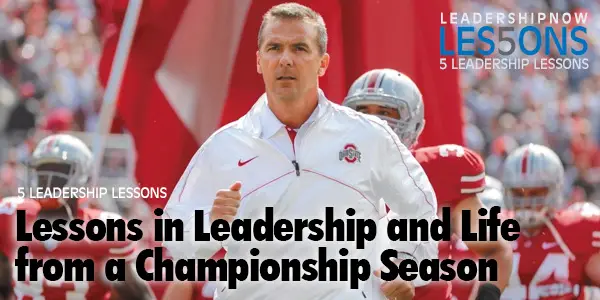
URBAN MEYER is an elite college football coach and currently the head football coach of the Ohio State Buckeyes. In Above the Line Lessons in Leadership and Life from a Championship Season he presents the lessons he has learned over his career. Meyer says, “A leader is someone who earns trust, sets a clear standard, and then equips and inspires people to meet that standard.”

Posted by Michael McKinney at 10:37 PM
09.15.15

5 Leadership Lessons from Herb Greenburg 
Posted by Michael McKinney at 09:41 PM
08.28.15

Fairness is OverratedFairness is Overrated is a solid leadership primer on what it takes to create a healthy culture day-in and day-out. Tim Stevens comes from a Church leadership perspective. However, his 52 principles are applicable anywhere because people are people with the same issues—only the peer pressure changes (unfortunately).The 52 principles are organized around four key areas: Be a leader worth following, Find the right people, Build a healthy culture and Lead confidently through a crisis. Stevens begins with “live a life with margins” and ends with the “five stages of failure.” Living a life with margin structured in not only helps all of the other leadership principles discussed here but it helps you move through the five stages of failure faster. So it’s a foundational principle. A leader worth following has integrity. It’s about character. Knowing yourself and disconnecting is an important way to maintain integrity. You need to build space for what’s important. Finding the right people—finding and developing leaders—is the most important thing his did as an executive pastor. “Here is what I believe to my core: the success of leaders will rise or fall based on the decisions they make about the people around them.” When hiring people Stevens recommends not going solo. Get others involved. Chemistry is more important than skills, experience, or education. Use social media to “get to know” the people you are considering. Look for how they treat people they disagree with. Hiring too quickly leads to problems. Pay well. “You don’t want staff to join because of money. You don’t want staff to stay because of money. You don’t want staff to leave because of money.” If you have a healthy culture, people are waiting in line to join your organization. A healthy culture is led by a leader who is not insecure about others succeeding. Gossip is not tolerated. Employees do life together; it’s not just a job. In a healthy culture a leader turns over authority to others. Let your leaders lead. “No organization, church, government, or company can have a healthy culture and be run by a dictator, monarch, or single personality.” You need a strong team running the organization. What Stevens is talking about here is humility. A toxic culture cannot be changed without it. Leading confidently through a crisis means trusting the people you have in place to figure it out. A confident leader is not one that says, “I can figure it out” but one that says, “We can figure it out.” Having a great team in place is critical here. If you have found the right people and developed a healthy culture, then it becomes easier to lead confidently in a crisis. These 52 principles are easier to implement if you have people who will speak truth to you. Again, humility is key here. There is a lot to be considered in this book. It is well-written (a bit of a page turner) and you will want to go back again and again to see how you measure up. And by the way, fairness is overrated. “Don’t confuse fairness with justice. Justice is about doing what is right. Fairness means everyone gets exactly the same thing.” It's about priorities. 
Posted by Michael McKinney at 08:03 AM
07.06.15

Could Embracing Ignorance Improve Your Leadership?Orchestral conductor Itay Talgam writes in The Ignorant Maestro, that “the greatest leaders not only embrace ignorance but are convinced it is an essential choice on their part, allowing their people to reach upper floors that haven’t even been built yet.”In short, your willingness to let go of knowing—the conscious decision to be ignorant, to not know the answers, not even try to predict them—and embrace the unknown will be the crucial tipping point in making you the best leader you can be. The ignorance that Talgam speaks of is not about having a lake of knowledge, but being open to exploring other knowledge. It is humility. It is built on our knowledge but it is the willingness to go beyond what we know—to explore the unknown—so that the future is a matter of choice rather than the result of inertial thinking. Ignorance combined with two other qualities, the willingness to explore the gaps and listening, can create the space for others to fully express themselves. Gaps arise from incompatibilities; when something doesn’t make sense; the difference between what we say and do. They invite exploration and creative work. “Gaps with the most potential are often the most intimidating ones, so they are probably covered with layers of tradition, routine, and ‘that’s the way we’ve always done it here’ attitude.” “When we avoid gaps,” say Talgam, “we give up the possibility of choosing an interpretation for them, of putting them into context, of giving them a story. Our openness to new meanings is what allows the freedom to choose a different future. This invites the constructive participation of all stakeholders and that requires a high degree of listening. Great leaders listen from the perspective of ignorance. Instead of focusing on transmitting knowledge, focus on creating dialogue. Create the space for dialogue and learning by listening. “As a leader your choice for ignorance makes you focus on the learning processes of your people, supporting them in their autonomous discoveries.” Listening focuses on holding the space open for that exchange rather than on the outcome. “Gaps are the renewable fuel of new thinking, enabling change. Gaps exploration, around your organization’s leading values and ideas, is a great sustainable energy source.” You explore gaps by “choosing to be ignorant, and by listening from the unique perspective of ignorance.” Talgam looks at the leadership styles of six great conductors in terms of how each of them did or do embrace ignorance, explored gaps and listened. In terms of leaders creating a connection with those they lead, the example of Leonard Bernstein is instructive. For Bernstein it was not a nicety but a necessity. For a precious half hour or so he was not rehearsing at all but moving around among people, greeting each and every player by name, his arm around a shoulder, hugging some and kissing others. Engaged in a hundred conversations, he was catching up with domestic news, remembering names of children and events he had been told about maybe a year earlier. These were not just niceties but the manifestation of relations based on empathy and mutual trust. These precious thirty minute were the basis for making music together. 
Posted by Michael McKinney at 08:23 AM
04.29.15

Creating a Dare-to-Serve Culture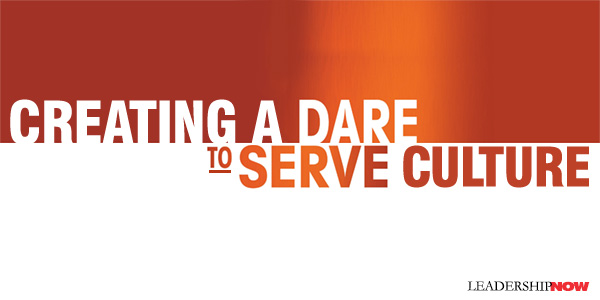
COMMAND and control is a leadership style that is in many ways our default leadership position. It’s very human. Leadership that serves is far more demanding of a leader. These demands easily drive us back into our old styles of leadership. It’s the daily grind that derails our best intentions.
Bachelder lists five benefits to becoming a Dare-to-Serve Leader:
What do you believe enough to act on? These are core beliefs that are so important to you that you will act promptly to rectify the situation when they are violated. Dare-to-Serve Leaders act on three core beliefs: human dignity, personal responsibility, and humility. We tend to be careless with human dignity says Bachelder. We don’t listen, we are impatient, we publicly criticize, and joke in ways that hurt. Push your daily situations through a filter of what you would like someone to do for you. “Lack of personal responsibility in a leader is just another form of self-absorption.” You must look at yourself and understand your own imperfections. “You will have no capacity to serve others unless you can take responsibility for your own self.” Humility is the “behavior” that makes it all work. “We agreed that we are not naturally humble either. That means there are plenty of days we are hell to work for, too. Therefore, humility must be a principle that we have conviction about—or we will never demonstrate humility to our teams. This principle will forever be an aspiration, not an accomplishment. As hard as we try, we will repeatedly fall short.” Bachelder has included 40 reflections for Dare-to-Serve Leaders to help you think about the leader you are. How do you gain meaningful feedback from those you serve?

Posted by Michael McKinney at 11:30 PM
04.15.15

Cleaning the Toilet Can Make You a Better Leader As a leader you are more than an individual contributor. Leaders think about the context—the big picture—not just their function. Focused on the outcome, they do whatever needs to be done to move the organization forward. They do whatever they can to facilitate the work of others. Leaders are connected to what others are doing. And we can accomplish this be asking, “How can I help you?” And then doing what needs to be done. Michael Janda Founder of the creative agency RiSER, put it this way in Burn Your Portfolio: I believe you are a better person if you’ve ever had a job that required you to clean a public restroom. This humbling task teaches so many lessons, among which is the willingness to do whatever the job requires. I have seen over and over again in my career that the people who are willing to go the extra mile and do whatever task is required of them by their boss or client are among the most valued in the company.Doing what needs to be done—including cleaning toilets—is taking ownership for the outcome. Going the extra mile—doing what needs to be done—helps to create a true culture of leadership in your organization—by example. We don’t serve because we are leaders, we have the privilege to lead because we serve.
Posted by Michael McKinney at 09:34 PM
12.15.14

Booknotes: Leadership Vertigo, Kidding Ourselves ☙ In Leadership Vertigo, authors S. Max Brown and Tanveer Naseer explain that there is a gap between what we know we should be doing and what we are actually doing. They call it “leadership vertigo” and they attribute it to false signals in our daily perceptions that inform us that we’re moving in a certain direction when in reality we’re not.
☙ In Leadership Vertigo, authors S. Max Brown and Tanveer Naseer explain that there is a gap between what we know we should be doing and what we are actually doing. They call it “leadership vertigo” and they attribute it to false signals in our daily perceptions that inform us that we’re moving in a certain direction when in reality we’re not. ☙ How do we avoid leadership vertigo? If we live the following four principles it will help us to keep our focus where it should be and avoid leadership vertigo: “We need to create a feeling of community, of being a part of something bigger than a collection of individuals. We need to consistently respond with an inquisitive mind, actively listening to our employees to learn from their experiences so that we can encourage them to share their creativity and insights. This is especially true when you are dealing with mistakes and failures. We also need to make sure that our employees see the authenticity behind our words and actions so that they will trust the compassion we exhibit in light of the challenges or obstacles they face.” ☙ Joseph Hallinan deals with the same issues in Kidding Ourselves. He writes, “We engage in self-deception so seamlessly, across so many aspects of our lives, that it seems, to be an inherent human quality—a built-in shock absorber that allows us to adjust to life’s stresses and strains not by altering ourselves, but by altering our perceptions.” He notes that this is not all bad. It allows us to adapt and persevere when the odds are against us. We like to believe that we are in control. It may be an illusion but the results it produces are real—to us. ☙ At the same time, “Once we have an opinion about how something should be, that expectation often colors our perception of how that thing actually is.” (Sounds like leadership vertigo.) The tail begins to wag the dog and our perceptions conform to our expectations. “When we look, we look with a purpose—we don’t look at something; we look for something…We tend to see what we expect to see and to experience what we expect to experience.” ☙ Hallinan expertly draws our attention to a number of ways we deceive ourselves quite unconsciously. “There is very little we are not capable of seeing or believing.” While a little self-deception can lead to optimism, perseverance and success, being mindful of our proclivity for it can save us. “Striving to see the world accurately is immensely better than seeing is inaccurately.” 

Posted by Michael McKinney at 08:39 AM
12.10.14

Eight Critical Questions for Leading with IntentionYour leadership effectiveness is a direct result of the level of intention with which you operate.In Leading With Intention, author Mindy Hall says leading with intention means “consciously deciding to lead by design rather than by default; being mindful of who it is you want to be and then living into that picture twenty-four hours a day. It is about seeing opportunities every day, in every interaction, to shape the tone, the experience, and the outcome of those interactions.” Everything you do sends a message. It begins with self-awareness. “The rest is practice, consistency, and continuous effort.” Here are eight critical questions from Leading With Intention that the intentional leader needs to ask:

Posted by Michael McKinney at 01:14 PM
12.03.14

Efficiency is the Wrong Mindset for a Leader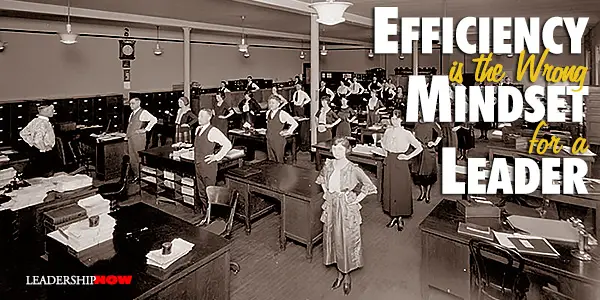
EFFICIENCY always seems like the right answer. It’s reflexive. Faster. Easier. Who doesn’t want that? And yet while efficiency is critical and often a competitive advantage, it is a problem when it becomes a mindset that is applied to everything we do; when it becomes an excuse for our lack of real connection. Faster and easier is not always better. As leaders, we have to know the difference. Some things are better over time. There is no such thing as efficient leadership. If efficiency is digital, leadership is analog. Leadership is about influence and mobilizing people to achieve a common goal. This is done through relationships. Relationships do not benefit from efficiency. Much of the practice of leadership is a process. If you rush the process you miss the fundamental issues that create meaning and engagement. Leaders are action-oriented people to be sure. Holding another meeting, having critical conversations, and reinforcing commitments, principles, and values can seem like a waste of time especially when you see the goal and the need to get moving so clearly. But if you don’t take the time to do these things, you may end up on your own—leading no one. Leadership does not exist until we create a relationship with another person. It is our relationships that result in the actions we seek. The efficiency—quality and flexibility—you get from people is primarily based on the relationship you have with them. Creating partners takes time. Distributing ownership takes time. The idea is to build relationships so that people in your sphere of influence, flourish. Growth is rarely an efficient affair. It’s almost never a straight line. People have emotions, feelings, and history and that takes time to understand and work with. If we are to grow and learn and innovate we have to leave room for the inefficient. Growth is born in the question. Efficiency rarely leaves room for questions. It is a tension that has to be managed. We have to learn to maximize efficiency without restricting growth. We know when it comes to people, better doesn’t always mean faster. Easier isn’t always the best way. But if we approach the practice of leadership with an efficiency-based mindset, we will look for shortcuts through a process that necessarily requires time and patience. The straight line can miss so much. The crooked path often adds the depth and color to our life that we can’t get in any other way. Good relationships cultivated over time will bring you the level of commitment you want when you need it the most. If you haven't taken the time to build relationships all you have is a gun. Take the time now to build trusting, caring relationships with the people you serve.
Posted by Michael McKinney at 01:07 AM
11.25.14

The Age of Enlightenment and You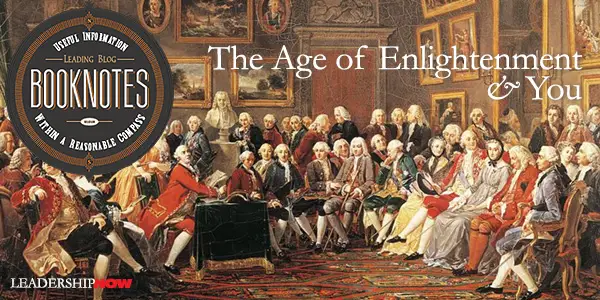
☙ Enlightenment remains the most powerful tool for challenging authority and liberating the human mind, an inspiration to leaders and followers worldwide, a method for effective change, and a framework of values by which that change can be measured. ☙ No single idea of the Enlightenment was so laden and sweeping as this. If people could transform their minds, they could change their lives, and together with others they could change their communities and beyond. ☙ Thomas Jefferson’s Declaration of Independence was less a guide to committed leadership than a resounding statement of Enlightenment ideals that had served its purpose of uniting Americans for war. ☙ Thomas Paine’s Common Sense expressed an aspiration that lay at the heart of the Enlightenment, the dream of revolutionaries everywhere, that the people “have in our power to begin the world over again.” ☙ No one had a greater role in fashioning the American experiment, basing the government on Enlightenment principle and then testing them in action than James Madison. ☙ Pursuing private interests, untethered to the thick social structure of old aristocracies, lacking deep familial roots, free of tradition and inherited beliefs, constantly on the move, democratic man, in Tocqueville’s portrait was profoundly alone. Lacking them, people would be crushed under the hypertrophy of selfhood; they would suffer the full consequences of the liberal society that made the isolated self the measure of all things personal and political and the market economy that made money the measure of all things economic and social. ☙ For Enlightenment pioneers, it meant embracing mankind as the measure of all things—not authority, not custom, not faith, but individual perception and reason were the foundation of truth. 
Posted by Michael McKinney at 08:58 AM
11.24.14

These Are Hard Times for Leaders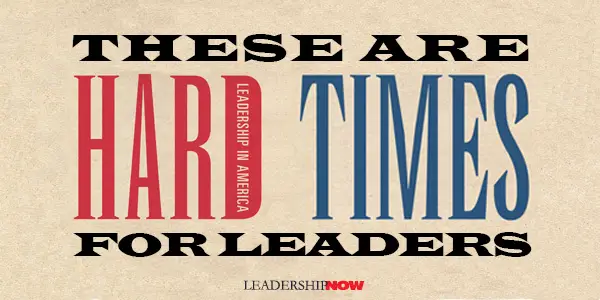 BARBARA KELLERMAN has written about leaders (good and bad) and followers, but in Hard Times she turns her attention to the often-overlooked context in which we lead. Leaders, followers, and context, form a system of leadership.
BARBARA KELLERMAN has written about leaders (good and bad) and followers, but in Hard Times she turns her attention to the often-overlooked context in which we lead. Leaders, followers, and context, form a system of leadership.
“More than ever,” writes Kellerman, “it is better—better in practice and better in theory—to focus less on the leader and more on the leadership system.” It is difficult to navigate or change systems without understanding the underlying context they exist in. We diminish our capacity to lead when we don’t consider all aspects of leadership. Hard Times is about context. It’s not about looking in but looking out. Everywhere leaders are finding it difficult to lead without using or threatening to use force because everywhere followers are making their lives difficult—and because everywhere context is both a cause and an effect of this power dynamic. So this book is about what leaders need to know to develop contextual expertise. Her extensive examination considers twenty-four different ways the context in which we lead shapes leadership now—in the United States—in the second decade of the twenty-first century. However, much of what she discusses is global because it is human. Tackling America’s historical background, she writes, “When the history of a country leaves a legacy that renders its citizens virtually allergic to authority, leadership is more difficult.” The capacity to persuade is more important than the capacity to control.
Other contextual issues like money as influence, the anxiety of innovation, the competitive need to be first, class distinctions, cultural pressures, divisiveness, special interest groups, environmental issues, and risk management, have all intensified. These all serve to undermine leadership confidence and put us off-balance. Risk management is not something that we generally like to spend our time thinking about. And unfortunately, some risk management platitudes only serve to put us asleep—only to wake up when a real risk comes along and we are ill-prepared to deal with it. We need to develop “risk management based not on what we know, or think we know, but on what we do not know.” Leaders and followers have changed in profound ways too. In general, says Kellerman, all this adds up to the fact that leaders are getting weaker. Leaders may not have less influence but they do have less power. Titles mean less and “status means less, which means that their ability to lead has lessened as well.”As Kellerman, Moisés Naím and others have argued, power is “undergoing a historic and world-changing transformation. Big players are increasingly being challenged by newer and smaller ones, and those who have power are more constrained in the way they can use it.” While I think this has always been and will continue to be an underlying truth on a micro level, we may very well see a backlash on this trend at the macro level. Time will tell. The most obvious reason leaders have been enfeebled are first, changes in culture that entitled and embolden subordinates to demean and diminish their putative superiors, and second, changes in technology that enable ordinary people to obtain information, engage in self-expression, and make interpersonal connections in ways and to degrees that historically are unprecedented. Increasingly, unable to rely on power and authority, on a more general level leaders are having to become what true leadership is about: influence. Exercising influence is what leaders should have been doing (and should have been trained to do) instead of relying on position and power because they could get away with it. Leaders “are more dependent than they ever were on their capacity to exercise influence.” As leaders we need to keep focused not just on the leader and the followers but on the context in which they interact. “Leading has become a high-wire act that only the most skilled are able to perform successfully over a protracted period of time.”
Kellerman’s insight at the end of the book is worth repeating because it says so much: “Leadership is not a profession.” Amen. 
Posted by Michael McKinney at 09:15 AM
08.18.14

Leading People Like Family IN Leaders Eat Last, Simon Sinek shares an insight he learned from Bob Chapman, Chairman and CEO of the Barry-Wehmiller Companies. It’s an important way of framing our leadership responsibility:
IN Leaders Eat Last, Simon Sinek shares an insight he learned from Bob Chapman, Chairman and CEO of the Barry-Wehmiller Companies. It’s an important way of framing our leadership responsibility:
Every single employee is someone’s son or someone’s daughter. Parents work to offer their children a good life and a good education and to teach them the lessons that will help them grow up to be happy, confident and able to use all the talents they were blessed with. Those parents then hand their children over to a company with the hope the leaders of that company will exercise the same love and care as they have. “It is we, the companies, who are now responsible for these precious lives,” says Chapman. Sinek explains: “Being a leader is like being a parent, and the company is like a new family to join. One that will care for us like we are their own … in sickness and in health. And if we are successful, our people will take on our company’s name as a sign of the family to which they are loyal.” He adds, “It is about committing to the well-being of those in our care and having a willingness to make sacrifices to see their interests advanced so that they may carry our banner long after we are gone.”
Intimidation, humiliation, isolation, feeling dumb, feeling useless and rejection are all stresses we try to avoid inside the organization. But the danger is controllable and it should be the goal of leadership to set a culture free of danger from each other. And the way to do that is by giving people a sense of belonging. By offering them a strong culture based on a clear set of human values and beliefs. By giving them the power to make decisions. By offering them trust and empathy. By creating a Circle of Safety. Too often, people are trying to protect themselves from leaders that are willing to sacrifice anyone to advance their own careers. “Without a Circle of Safety, people are forced to spend too much time and energy protecting themselves from each other.” We thrive when we feel safe in our group. Leaders can be found at any level in an organization. They are the ones who are willing to give of themselves for the sake of others.

Posted by Michael McKinney at 10:03 PM
04.29.14

Six Critical Leadership MomentsStep Up by Henry Evans and Colm Foster is about learning to recognize six critical leadership moments where we need to lead. These moments were areas that clients found difficult to deal with. Leadership is not someone else’s job. Anyone can recognize moments where leadership is required, know what to do and step up.The six critical moments are: Using anger intelligently in the workplace. The key is learning to respond rather than react. Anger is not an either/or emotion. There are levels of anger. “The problem for most people is not that they get angry; it’s that they become less intelligent when they do. Our beef is with stupidity, not anger.” If you understand your own anger you can recognize the opportunity to lead when you see anger in other people and become a catalyst for positive action. “Knowing that there is an optimal mood for every task that a group might undertake provides you with leadership opportunities. You can step up to help create the mood.” Recognizing and dealing with “terminal politeness.” You and others may be avoiding important conversations that you should be having. They key is learning to skillfully distinguish between conflict with a person and conflict with his or her idea. Making decisions when no one else making them. Rarely do you have perfect information, but you must be able to confidently decide on a course of action. Taking ownership when others are externalizing a problem. What are you contributing to an ongoing problem? “Moments of leadership present themselves when the people around you are stuck in old ways of thinking and behaving.” Leadership moments involve those in which you must change as well as others. “It’s not easy for most people to accept the possibility that one of their most cherished and entrenched beliefs about how the world works may be wrong.” Identifying and leveraging pessimism. Pessimists don’t belong in a leadership role but they do have value that you can and should leverage. They can “point out problems and shed light on tough issues that others may be avoiding. “Optimism is not the same as positivity, and pessimism is not the same as negativity. It is possible to be an optimist and have a slightly negative bias; you can see the trouble ahead but are confident in your ability to overcome obstacles and achieve a good result.” Inspiring others to take action. This is about recognizing when you and others are stuck in unproductive and redundant dialogue. “You don’t have to be the group’s formal leader to recognize negative momentum and exercise the kind of leadership that will reverse that momentum.” The authors note that you will not be successful enacting these behaviors unless you can do it in such a way that is emotionally safe for others for three simple reasons: the quality of your information deteriorates when people don’t feel safe talking to you, people will pursue goals beyond the point that makes sense out of fear of “crossing you,” and people simply don’t grow in a fearful environment. Step Up contains concrete ideas for dealing with each of these areas with links to online resources. 
Posted by Michael McKinney at 11:56 PM
03.04.14

Quick and Nimble: A Leadership CompanionAdam Bryant has put together a great leadership companion with Quick and Nimble. There’s great advice on a wide range of leadership issues from Why Culture Matters to Alone at the Top. Here are several:Why Culture Matters: A successful culture is like a green house where people and ideas can flourish—where everybody in the organization, regardless of rank or role, feels encouraged to speak frankly and openly and is rewarded for sharing ideas about new products, more efficient processes, and better way to serve customers. A Simple Plan: “You have to be able to simplify things that are complex. At the end of the day, if the thirteen thousand people on the front lines don’t understand what you’re trying to do, forget it. You don’t stand a chance of making it work.” (David Barger, the CEO of JetBlue) “We’re not a transparent culture so that we can be cool and it’s not about an open environment, because that’s not what makes a company transparent. It’s more around the fact that everyone needs to know where we are going and how we are going to get there. So we want everyone to understand our objectives and make that available to everyone as we’re evolving, so that people aren’t guessing and they’re not internally focused, because that’s one of the obstacles that a lot of companies fall into.” (Ryan Smith, CEO of Qualtrics) Rules of the Road: “Ideas can come from anywhere. There are no titles around an idea. As the CEO, I’m the chief editor of the company, but I want the idea to come from anybody. There’s no bureaucracy around an idea. In fact, bureaucracy around an idea is the death of an organization. I tell people all the time: If you have a great idea, and you’re passionate about it, and it makes sense, and you can’t get your boss to hear your idea, then you should leave. That’s not an organization that you’re going to thrive in.” (Steve Stoute, Translation LLC and Carol’s Daughter) A Little Respect: “By definition if there’s leadership, it means there are followers, and you’re only as good as your followers. I believe the quality of the followers is in direct correlation to the respect you hold in them. It’s not how much they respect you that is most important. It’s actually how much you respect them. It’s everything.” (Jeffrey Katzenberg, CEO DreamWorks Animation) Play it Again and Again: “No matter how smart the people are that you are communicating to, the more of them there are, the dumber the collective gets. As the audience gets bigger and bigger, the bullet-point list has to be shorter and shorter, and the messages have to be simpler and simpler.” (Marcus Ryu, Guidewire) Surfacing Problems: “I always ask, ‘Tell me one thing you really like about the company and one thing that frustrates you about the company.’ I always come out with at least one thing that is eye-opening.” (Ken Rees, CEO of Think Finance) School Never Ends: “It’s about keeping them marketable. I encourage people: ‘Go out and find out what the market bears. You should do that and then come back and help me figure out what you need in your development that you’re not getting, because we owe that to you.’ I’ve been told by my associates that’s a countercultural approach to leadership: ‘You’re telling me to go look for another job?’ But my point is that I should be able to re-recruit them. I should be able to get them convinced that his is the best opportunity for them.” (Linda Heasley, former CEO of The Limited) Alone at the Top: “Pacing is really important in an organization. I have in the past tended to overestimate the amount of change I can effect in the short run and then not fully appreciate the change I can effect in the long run. And so I’ve learned that it’s critical to think carefully about the pace of change, and it’s something that I’ve learned the hard way. it’s important to manage that carefully, because it’s not just about the pace of change that certain people in the company can manage. It's about the pace of change that the company as a whole can manage. You can push and push and nothing seems to happen, and then suddenly it takes off and you’re sort of running to catch up.” (Harry West, Continuum) 
Posted by Michael McKinney at 11:48 PM
12.02.13

Leading Through Uncertainty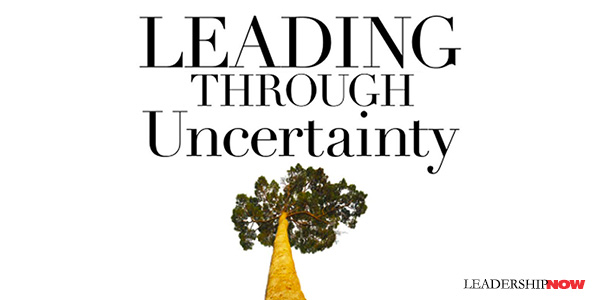
IN times of great uncertainty, we must be leaders. In Leading Through Uncertainty, Ray Davis writes, “Effective leadership is motivating, and it can and should be the energy that propels a company through inevitable waves of change. Poor leadership can lead to disaster and has sunk more than a few companies and governments alike.” Davis divides the book into three parts: leading yourself, leading your organization, and leading the way. He shares the ideas that have allowed Umpqua Bank—the West Coast’s largest independent community bank—to emerge from the economic crisis even stronger than before. The problem some will have with the book is that it requires a secure leader. A leader that can set his or her ego aside. And a leader that truly cares about their people, their organization, and the people they affect. Leading through uncertainty means leading with the truth. People can handle the truth. “The negative energy created by worrying is replaced with positive, productive actions and attitudes.” Of course, some leaders are afraid of the truth because it incriminates them and exposes their weaknesses. Davis says, “I always tell our people that they’re entitled to get answers to every question they have. I let them know I’m not going to defend myself when it comes to their questions, but I will explain what’s going on. I also tell them that while they’re entitled to answers to every question, that doesn’t mean they are going to like the answers.” Being truthful means acknowledging the problem. Saying peace when there is no peace—saying everything is fine when it isn’t—is only whitewashing that will erode trust and peace. You must have a firm foundation in the basics, says Davis, and then walk the walk and talk the talk. We’re all busy but listening is essential. “I think it is a mistake for people in my position not to make themselves available to their customers, their people, and the community at large.” When you don’t have all the answers, listening goes a long way. Leaders don’t lead in a vacuum. Secure leaders reach out to others. They give them the ability to provide constructive criticism which is hugely valuable of and by itself but it also serves to motivate and keep people involved in the process. “How else can a company get better if it’s not willing to listen to constructive criticism if it’s not willing to listen to what it’s not doing as well as it could? If you’re not willing to listen, you’re not going to improve and you’re not going to grow.” Great leadership begins with us. “I believe this starts with an introspective and honest inventory—first of yourself and then of your organization. Companies regularly evaluate their strengths, weaknesses, opportunities, and threats to make sure they are focused on the right issues. I wonder, however, how many leaders do the same evaluation on themselves. I recommend this as a good starting point.” 
Posted by Michael McKinney at 11:22 PM
11.15.13

The White Knight Syndrome
AS A LEADER, it is easy to think that we alone possess all anyone needs to know; to think that our view of the world is the right one. After all, the view looks pretty good from where we sit. We’ve thought everything through. We have access to more information than anyone else. We have a way of doing things and it works—for us. So what rational person would question you? What could they possibly know that you don’t? We can get a little self-important and think that we need to mount our white horse and begin a crusade to save the kingdom—charging through the organization bringing everyone in line with our way of thinking and our way of doing things. We know best and if they can’t see it, well then, they’re wrong. But before we do we should consider these questions: Is this about me? Of course not. But before you get on your high horse, ask yourself if the issue is truly a right-wrong issue or simply a matter of opinion or approach? No one likes to be questioned, but the questions serve as a tool to help us grow. They keep us in check. If we're not being questioned, we have an even bigger problem. We have made our leadership about us—and everyone around us knows it. Only we are deluded enough to think otherwise. Is there a connection I can build on? Find connection with the other side—even if you have only their intentions to consider. Rarely is anyone going out of their way to do the wrong thing. Most often it is their execution that is bad. Their timing can also be at the core of the problem. All these things can be fixed without diminishing the other side. Finding areas where you agree gives you something to build on and shows respect. Am I motivated by the desire to establish my authority? If you have to correct someone, you should never leave them there. As a leader, your job is to build up not to put down. There are times when you have to correct but it should only be done in an effort to grow others and not to control them. If correction is about control, it’s about you—and you’ve lost before you’ve even gotten out of the gate.  The most valuable people we have around us are those people who are willing to question us, consider another approach, and test our assumptions. We need these people if we are to grow into the leader we could be. It’s not about us.
Posted by Michael McKinney at 10:49 AM
10.30.13

The 8 Elements that Bring People Together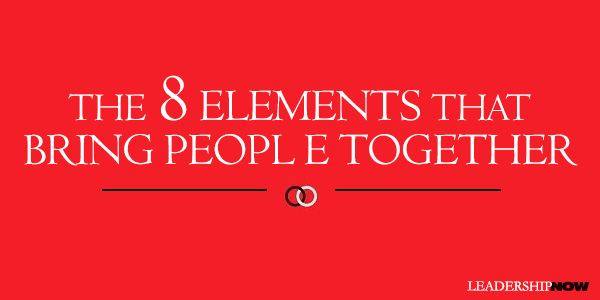
WORKING together to solve a common problem provides us with a more complete picture of the problem, and can offer us more options, synergies, and solutions than we could achieve by working alone. Many of the issues we face will require collaboration at some level to solve or even manage them. In Finding Allies, Building Alliances, authors Mike Leavitt and Rich McKeown, state, “The ability to get things done with collaborative networks is the next generation in human productivity.” We need to be able to form and work with and through value alliances. Value alliances are “a group of participants with aligned interests in pursuing an outcome with value for each of them.” These alliances can last long enough to solve the issue they came together to solve or they can be ongoing as an alliance enterprise to oversee the solution to the problem. But value alliances are not always easy. “Value alliances require that participants subordinate their egos, their agendas, their preferred styles, and their biases—not to mention their organizational agendas—in favor of a shared benefit.” Some people just don’t have the aptitude—the collaborative intelligence, if you will—to work well with others. “People with high collaborative intelligence make an effort to understand the views and needs of others; they listen honestly, thoughtfully, and objectively. They don’t lock into positions prematurely. While they may possess strong points of view, they make an effort to hear other perspectives and will adjust their points of view once convinced they need adjusting.” The authors have had a lot of experience creating, working with, and successfully resolving problems through effective value alliances. They share the good and the bad and the lessons learned along the way. They answer why you form value alliances, the eight key elements required for a collaborative effort to succeed, how you select productive participants, and how you deal with the inevitable issues that come up dealing with other people. Their case is well thought out and clearly presented. From their experience, they have discovered why some collaborative efforts have failed and why others have succeeded. From that background, they detail the 8 elements required for a collaborative network to succeed: 1. A Common Pain is a shared problem that motivates different people/groups to work together in ways that could otherwise seem counterintuitive. Value alliances “exist at the intersection of self-interest and common interest.” We often become collaborators when we discover that we can solve a problem on our own. “Few people are willing to place themselves in a collaborative position of they have an alternative.” (As a side note, leaders, because of their position and the authority it brings them, usually have an alternative—my way or the highway. The best leaders collaborate anyway.) Collaborations require time, money, and people. The collaborative process is more complex, slower, and messier than independent decision-making. To be willing to give up a degree of independence and control, a given leader must believe the problem poses a serious threat to the enterprise. 2. A Convener of Stature is a respected and influential presence who can bring people to the table and, when necessary, keep them there. “The inability to turn down an offer is one sign that you’re dealing with a convener of stature.” The book lays out the roles and responsibilities of the convener. 3. Representatives of Substance. The collaborative participants must bring the right mix of experience and expertise for legitimacy and have the authority to make decisions. Look for participants who possess at least one and ideally all three varieties of substance: authoritative, cognitive, and reputational. Sometimes it is wise to create additional layers of participants beyond the primary or core group. “Omitting people from the collaboration often guarantees that they’ll become external critics or even saboteurs.” 4. Committed Leaders are individuals who possess the skill, creativity, dedication, and tenacity to move an alliance forward even when it hits the inevitable rough patches. Value alliances require committed leaders who fulfill many of these ten roles: organizer, diplomat, technician, teacher, counselor, matchmaker, salesperson, referee, judge, and disciplinarian. “If committed leaders can consistently achieve consensus, they will move the alliance forward. Finding consensus is an art form that alliance leaders must master.” 5. A Clearly Defined Purpose is a driving idea that keeps people on task rather than being sidetracked by complexity, ambiguity, and other distractions. It is important to identify and deal with purpose creep—“an inexorable broadening of scope that eventually makes it impossible to relieve the common pain that drew the group together in the first place.” The authors provide a step-by-step guide to creating a purpose in a collaborative setting. They advise, “Find a golden mean: big enough to matter and small enough to do.” And add, “As a committed leader, you need to develop a sixth sense for when people are setting goals that are too difficult to achieve or too wide-ranging; you also need to grasp when you’ve shrunk the purpose to the point that its achievement won’t have any real impact.” 6. A Formal Charter establishes rules that help resolve differences and avoid stalemates. The three crucial parts of a charter are: the Purpose section, the Principles section, and the Operating Procedures. 7. The Northbound Train is an intuitive confidence that an alliance will get to its destination, achieve something of unique value, and that those who aren’t on board will be disadvantaged. The idea is, “decisions that matter to me are going to be made, and I need to be there. The train is headed north, and I want a seat on it.” They explain why a northbound train slows and what to do about it. “The feeling generated by a northbound train is what carries the collaboration to its destination.” 8. Defining Common Ground. “Participants and leaders need to discuss the beliefs and ideas that they take for granted in their collaborative efforts.” A Common Information Base keeps everyone in the loop and avoids divisive secrets and opaqueness. “Defining common standards boils down to the capacity of collaborators to reach foundational agreements.” People are coming from all different places with different values and beliefs, but to get to the point where there is a recommendation or decision that everyone can buy into and to hold the collaboration together until that point is reached, “Agreement about operating modes and information protocols is necessary.”

Posted by Michael McKinney at 12:43 AM
10.09.13

The Good Struggle NOT surprisingly, Joseph Badaracco has written an essential read for leaders of all kinds. The Good Struggle addresses the question of how to lead successfully and responsibly in our uncertain, high pressure, turbulent world.
NOT surprisingly, Joseph Badaracco has written an essential read for leaders of all kinds. The Good Struggle addresses the question of how to lead successfully and responsibly in our uncertain, high pressure, turbulent world.
Badaracco says that the inescapable pressures of leadership are intensified today because of the market-driven world in which we live. “Almost everything—how we manage our organizations and our lives, how we make decisions at work and at home, and even how we think about ourselves—is deeply shaped by markets and market-based thinking.” This creates greater uncertainty, obscures right choices, and puts pressure on us to abandon principles that we used to rely on. Responsible leaders find themselves engaged in the good struggle: “a long effort, demanding perseverance and courage, to make good on serious but profoundly fallible commitments in an uncertain and often unforgiving world.” He adds, “Struggle has always been central to accomplishing anything worthwhile, and this is especially true today.” He offers five enduring—inescapable—questions. Responsible leadership consists of thoughtful and lived answers to them. Am I Really Grappling with the Fundamentals? “The first responsibility of leaders is intellectual. It is the struggle to develop—to the extent possible—a deep, careful, analytical, data-driven understanding of the driving forces in the markets and society around them and to keep this understanding loose, flexible, and revisable.” Grasping the fundamentals can “reduce the chance of being blindsided, by encouraging the mental habit of looking for emerging patterns and odd developments with larger implications. It also promotes modesty, a healthy, low-level paranoia, and vigilance rather than hubris.” He notes that everything now is modular—constantly being recombined. “Recombination also makes it much harder for leaders to inculcate values when people in their organizations know they and their leaders are basically modules in a plug-and-play world and could be moving on soon. The natural instinct is to take care of yourself, here and now.” What Am I Really Accountable For? “Without clarity about accountability, leaders and their organization can drift or zigzag aimlessly.” Of course, many leaders do not want to be accountable to anyone or anything. “Accountability originates in an obligation to make good on the spirit of some jointly designed, provisional, and evolving objectives.” Here’s the question for any leader: “What pressures, scrutiny, and risks do we want to create or invite in order to build a strong, resilient, responsible organization?” How Do I Make Critical Decisions? We need a broader view of critical decisions. Instead of viewing them as deep, abiding pledges that we must make good on, we need to see them more as evolving commitments. That is, “a pledge, by a leader and an organization, to move in a particular direction, but to do so in a flexible, open-ended way.” Decision making has to be as fluid as the markets around them. “Execution as learning.” “Instead of periodic big decisions, responsible leaders make or orchestrate an unending series of smaller ones—all aimed at some larger, broad, flexible objective.” Do We Have the Right Core Values? Values are important because “they may be the only force that can counter the power of markets and market-based thinking….Today’s ever-present markets have their own implicit values, and they can easily overwhelm whatever values leaders want to instill in their organizations.” To lead responsibly, leaders must commit to “clarity, meaningful projects, and bright ethical lines. In different ways, each of these helps leaders and organizations respond to the risks and opportunities created by pervasive market forces.” Why Have I Chosen This Life? People seek positions of leadership not despite the struggles involved, but because of them. “Responsible leadership is a challenge that—despite its inevitable risks, frustrations, and failures—demands and merits the best efforts of talented men and women, tests their competence and their characters fully, gives purpose and intensity to their lives and helps them lead the kind of lives they really value.” The purpose of our struggle matters. Badaracco writes, “If the purpose of life is ease and comfort, no sensible person would take on the demands of leadership.” Perhaps in developing leaders at all levels we need to change that very prevalent mindset. Without it we can’t discover what we are and the person we are meant to be. Badaracco doesn’t offer hard answers because they are evolving answers and should be individual answers created from introspection and reflection. But the insights and provocative concepts are enough to get you thinking in new ways. 
Posted by Michael McKinney at 11:24 AM
09.16.13

Why We Need Strangers
PART of the reason we get stuck and part of the reason we lack the feedback we need is that we are surrounded by the familiar. The familiar that continuously reminds us that we are doing the best we can and that we are doing it right. We are mired in the familiar when what we need is the strange. We need strangers. “These strangers,” writes Alan Gregerman in The Necessity of Strangers, “whom we quickly choose to ignore or form an opinion about, are the people who force us out of our comfort zones and challenge us to question the knowledge, belief, and habits we hold dear.” Gregerman asks, “What if strangers are actually, in many ways, more important than friends?” Interesting question. There are two issues here. “First, most of us just don’t have enough friends or a diverse enough set of them to give us the breadth of insight and perspectives we need to continually stretch our thinking and to grow. And second, the exact reasons why we count on friends are the same reasons that their input may not be ideal for our efforts to stretch and grow.” Maybe it’s not who you know but who you could know that will determine your success and growth. While we tend to be adverse to outsider's thinking, our real aversions, says Gregerman, “should be to see our own thinking as the only way to move forward. The real trick is to “pick the right strangers with ties to what we hope to accomplish and then ask them the right questions.” Gregerman suggests that 99% of all new ideas are based on an idea or practice that someone or something else has already had. New employees are a great source of fresh ideas, but we tend to quickly shape them into the way we do things. “They arrive filled with different ideas and fresh perspectives based on a new and different set of work and life experiences—ideas, perspectives, and experiences that might actually make us more efficient, effective, innovative, customer-focused, and successful if we were willing to listen.” If we don’t focus on the strange but instead focus on the different that we could tap into, we might grow in ways we never imagined. “Everyone matters. And that’s an idea that leaders must convey.”

Posted by Michael McKinney at 10:42 PM
07.30.13

Henry Ford on Leadership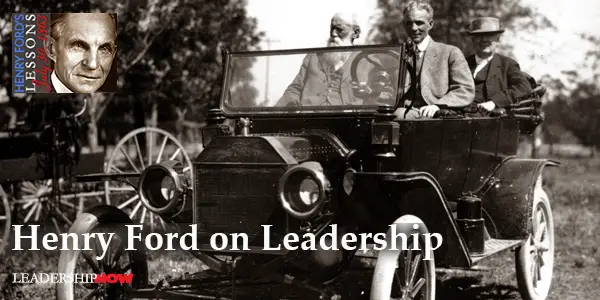
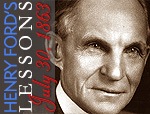 Although his first and second car companies failed, Ford learned more about cars, how to run a business, and more importantly how to attract talent to make his vision a reality. The times Ford was born into and his impact on them understandably convinced him of the superiority of his own intuition. He had the problem that haunts many successful leaders: self-delusion. He believed what he wanted to believe and was certain that he always knew best. Harvard professor Richard Tedlow observed in Giants of Enterprise, "If Henry Ford had died in February of 1914, after the announcement of the $5 dollar day, he would be remembered almost without qualification as a man of true greatness. His flaws were noticeable in his first half-century of life, but they would have been forgotten…. As his wealth grew and his fame engulfed the whole world, he lost all perspective. No life better exemplifies the derangement of power." His defiant, tenacious, and compulsive nature accounts for his early successes. His inner strength made his dreams possible but it didn't leave much room for introspection. Without a healthy self-awareness, Ford allowed his strengths to run amuck. If he was creative, he was irrational. If he attracted great talent, he also drove it away. If he was direct, he was insensitive. Without an inner compass, Henry Ford was a man of great extremes—for better and for worse. Henry Ford leaves us much to be admired but he also reminds us of the importance of a healthy self-awareness. On Failure:
On Lifelong Learning:
On Success:
On Passion:
On Initiative:
On Teamwork:
On Personal Responsibility:
Posted by Michael McKinney at 12:18 AM
07.24.13

The Business of Belief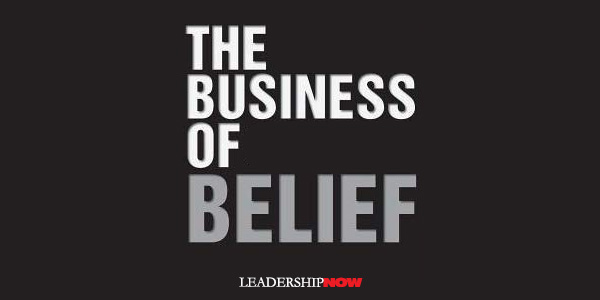
"Belief has been a most powerful component of human nature that has somewhat been neglected," says Peter Halligan, a psychologist at Cardiff University. "But it has been capitalized on by marketing agents, politics and religion for the best part of two millennia."TOM ASACKER reveals the role of belief in leadership in The Business of Belief. For leaders and organization, belief is the issue. It is at the core of who we are, why we do what we do, or approach to change, and how we lead. "If you want to change the world, if you want to change your world, if you want to succeed at work, in the marketplace, or in any other social endeavor or organization, belief is your Holy Grail" writes Asacker. Beliefs are nothing more than working assumptions. Belief may or may not be true or even rational. But belief is at the heart of making your leadership work. We fight for choice and fight wars to protect choice, but we don't always live with choice, we more often live with our own self-imposed dogma. "Choice is liberating, and belief flourishes with the freedom to choose. But every choice also chains us, because it rejects a world brimming with competing opinions and possibilities. Our believing minds simply cannot function while brooding over all of those chains. The psychic strain would paralyze us. And so we ignore them." We want control over our world. And that desire impacts how we operate in the world. "If we believe we know what's happening around us, especially the near term future and general direction, we feel safe. That's why we resist change and want our agendas and ideologies to prevail." This is where, I believe leadership comes in. And Asacker addresses that in part two: Those skilled at motivating people to cross a new bridge to change their beliefs and behavior, are not trying to cajole or manipulate them against their will. Rather, they seek to guide them to a new destination, a transformed way of feeling, thinking and acting that's aligned with their personal desires and values. To paraphrase industrial designer Dieter Rams, good leaders "must have an intuition for the reality in which people live." It's one of the reasons that self-centered leaders struggle. Great leaders, as Asacker writes, must design new beliefs. "Creating belief is about affect before effect. It's about finding people who want to believe and making them feel comfortable." It's about making it ours. And this is key: "Making it ours is not giving us control of the ship. Rather, it's connecting the voyage—especially the questions, highlights and successes—to our desires and choices." That's leadership. In part three, Asacker turns to what we can do personally to understand and manage our own beliefs. He issues this challenge: Face it: We are either breaking out of our spirit-sucking routines and breaking through to new insights and experiences, or we are breaking down. So when the opportunity to step out of your comfort zone arrives, and it definitely will come, take it. Say no to the sure thing and say yes to a creative challenge. Say no to short-term, comfort producing activities, and say yes to fear, passion and leadership. I've only scratched the surface here. The Business of Belief is full of thought-provoking ideas and statements that will make you think. Perhaps I should say they will distract you. "Distractions and difficulties turn on our thinking mind, which undermines belief by overriding our instincts." May you be distracted.

Posted by Michael McKinney at 03:14 PM
03.12.13

Leadership and the Art of Struggle: 5 Things You Can Do
STRUGGLE is a part of any human endeavor and leadership is no different. The problem is we view struggle as a negative. But struggle is how we grow. Without them we can’t reach our full potential as leaders. We like to think of our leaders as flawless. We like to be perceived as flawless—or at least we like people to think we have everything under control. But as Joe Badaracco has pointed out, “leadership is a struggle by flawed human beings to make some important human values real and effective in the world as it is.”It may sound counterintuitive, but considering the benefits illuminated by Stephen Snyder in Leadership and the Art of Struggle, we should welcome it as an important element of the leadership process and our own personal development. Snyder writes that we should face struggle “head on—not hiding from it or feeling shame—because struggle is the gateway to learning and growth.” It can also help us to discover our purpose and meaning and develop the adaptive energy necessary to sustain our leadership for a lifetime. Struggles have three defining characteristics:
In the world we live in today, this is a common occurrence often leading to burnout unless we learn to see struggle through a different lens. Snyder recommends: Adopt a growth mindset. The first step in accomplishing this is through reflection—being aware of what is going on around you. Snyder’s former colleague at Microsoft, Frank Gaudette, used to say: “I reserve the right to wake up smarter every day.” A good mantra to make our own. Center your mind, body and spirit. We all need some way to anchor ourselves and gain perspective that we practice daily like exercise and diet, prayer, connecting with nature, meditation, and/or journaling. Build your support community. “Create a community of people whom you can connect and bond with and from whom you can seek advice and feedback.” Overcome your blind spots. Blind spots by their very nature are hard to recognize. And they are frustrating because they blind us from seeing why people may be responding to us in counterproductive ways—leading us to finger pointing rather than personal responsibility. “Blind spots,” writes Snyder, “are the product of an overactive automatic mind and an underactive reflective mind.” A fairly common blind spot Snyder calls the Conflict Blind Spot. This blind spot can cause someone to interpret every interaction through a distorted lens. It reinforces the perception that the other person is wrong and we are right. Recommit, pivot, or leap. When we struggle we have essentially three options. The first is to recommit and stay the course. The second is to pivot and make a course correction. And third is to leap into uncharted territory far beyond our comfort zone. Choosing the right option requires that we examine ourselves and determine which choice is most consistent with our personal values or mission statement. Every struggle is a chance to learn and to confront who we are and what we are becoming. Seen in that light, they are a gift. And our ability to deal with our own struggles effectively has an impact on those around us. Not only does it create a more positive environment to function in, but it provides a constructive example for others to follow. Snyder has written an outstanding and practical book to help us to rethink the challenges and problems we face along the way. One of the best you’ll ever read on the topic. (The Adaptive Leader Profile is available from Snyder Leadership Group.)

Posted by Michael McKinney at 10:27 PM
02.06.13

People are Job 1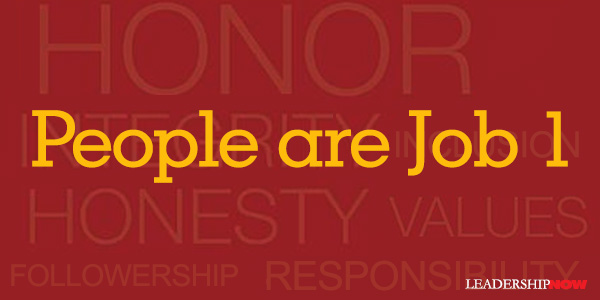
AS A LEADER if you are not devoting your time to people issues, you’re missing the big picture. Amy Lyman, author of The Trustworthy Leader, was once asked what could you do if you only had five minutes a day to devote to people issues? It is a stunning question on its face but reveals something deeper. Lyman explained that “leading is a full-time job. If you want to be a successful leader, you need to devote all of your time to people issues….Five minutes a day—or even five minutes an hour—is the wrong approach.” The problem is we tend to separate our “work” from the “people” issues; respond to people issues when asked to, but focus our intellectual talents on the mechanics of the specific tasks in front of us. Lyman makes the point that people are integral to our ability in every single area in our organizations and if we do not include consideration of people in every aspect of our work, then we are doing ourselves and our organizations a great disservice. Yet it is not uncommon to find leaders who see people as the problem—the distraction—that takes them away from their work. Our work is people. Trustworthy leaders…understand the complexity of bringing together a group of human beings to pursue extraordinary accomplishments. They are masters at guiding, directing, encouraging, and challenging people to contribute their best, in part because they ask the same of themselves. Trustworthy leaders know that their relationships with others throughout the organization are key to their success—however, success is measured. Lyman identifies six elements that both influence how a leader acts and reflect how that person thinks about being a leader: Feels Honored—Sense of honor and gratitude for being asked to lead and acknowledging the responsibility that comes with it. Inclusive—Promotes the inclusion of every person into the larger community of the organization. Ability to Value and Engage Followers—Pay attention to followers and learn from them, support their contributions and connect with them beyond their work roles. Openly Shares Information—Employee's contributions will be magnified to the degree that they have access to useful information. Develops Others—Help employees to learn, grow, and discover their talents. It’s part of who they are because they think about others more than themselves. Ability to Move through Uncertainty to pursue Opportunities—The skillful weighing of risks and rewards attached to the opportunities available is one of the most important actions that leaders can take on. When employees see their leader act with honor, feel included, choose to follow, have access to information they can use, and are supported in their development, they will support their leader’s efforts to try novel approaches and find the best way forward. Trustworthy leaders succeed in the marketplace because their trustworthiness provides them with two key competitive advantages: first, they benefit from the cooperation of employees with each other, across departments, and throughout the organization as a whole; and second they engender a deep, strong commitment among employees to the long-term success of the company, its mission, and its vision as expressed by the leader.

Posted by Michael McKinney at 08:56 PM
10.16.12

If it were just about leading, would you still want to be a leader?
IMAGINE for a moment that you as a leader didn’t have all the perks that often accompany positions of leadership—no lease car, no reserved parking space, no special dining rooms, offices, furnishings or refreshments and certainly not the compensation that creates jealousies. Would you still want to be a leader?
What if no one had to think that your way was always the best way? What if you had to ask as much as you told? What if being “in-charge” meant that it was your job to put others first? What if those you led got all the credit? Would you still want to lead?
What if all you got were the intrinsic rewards of leadership—the satisfaction of seeing others grow to their potential, perform to their best ability and knowing that you enabled that to happen, knowing that you were the catalyst, the spark, the steady, guiding hand throughout the process? Would that be enough to motivate you to lead? To deal with the downside of leadership?
Because of its demands, without a doubt, good leaders should be rewarded. But we need to ask frequently, “What are we in it for?” If we are in it for ourselves or just to make our dreams come true, our gains will go when we go. In our own mind, it can’t be about what we get but what we give. If we’re in it for the rewards, it will skew our thinking and diminish our role as a leader. It will create a culture where everything rests on the leader. And that’s not leadership, that’s self-promotion.
Posted by Michael McKinney at 10:15 AM
08.24.12

Leadership as Provocative Competence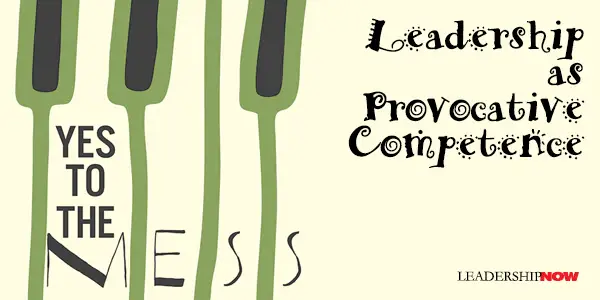
J Barrett introduces us to what he calls Provocative Competence. It is the capacity “to create the discrepancy and dissonance that trigger people to move away from habitual positions and repetitive patterns.” Barrett says “Leadership as a design activity means creating space so that people will be tempted to grow on their own.” Herbert Simon, who won the Nobel Prize in Economics in 1978 for his research on decision making in organizations, believed that we should not think of leaders as making decisions on past data, “but as creating forms so that people can flourish in the future,” or as Barrett expresses more clearly, as shaping “worlds of interpretation in which others can make meaningful contributions.” The outcome then, is to enliven activity and rouse the mind to life. It isn’t about authority but is “relational moves within an unfolding context” and are judged by “how well they work with the resources at their disposal … and how effectively they help free their own potential and that of others.”Barrett breaks provocative competence down into five component parts: First, it is an affirmative move. “What makes these interventions powerful is that the leader holds a positive image of what others are capable of. This often means seeing other people’s strengths better than they see their own strengths.” Second, provocative competence involves introducing a small disruption to routine. “What makes provocative competence an ‘art’ is the introduction of just enough unusual material that it engages people to be mindful—to pay attention in new ways.” Timing and pacing is important he cautions. “Leaders who disrupt on a regular basis or try to be provocative all the time are obnoxious, and are eventually ignored and probably mimicked.” Third, it is important to create situations that demand activity. People are expected to jump in and work it out and discover as they go. Fourth, provocative competence means facilitating incremental reorientation by encouraging repetition. There is a balance here. “Not all repetition is the same. Sometimes you need to repeat a gesture and then start to notice it from a slightly different angle…. Even while people are learning on old habits, they have to attend to new cues and new options, and start to manage and process information within a new, broader context.” Fifth, provocative competence involves analogic sharpening of perspectives and thought processes. “This is the point at which people look back at what is emerging and jump into the morass as they make comparisons, links, and connections to a larger, emerging whole.” This is the thrust of innovation. Net effect: “People start to notice affinity between pieces that previously seemed disconnected; resemblances that no one noticed before start to emerge.” Of course, notes Barrett, “different groups have different levels of performance, and leaders certainly have to deal with imperfect talent, but saying yes to the mess means finding affirmation in the best of what already exists.” That’s the job of a great leader. It’s what separates leaders from bosses. “That’s a true gift: to be able to see people at their very best when their current behavior is far less than that.” Of Related Interest:

Posted by Michael McKinney at 05:59 PM
08.17.12

Heroic Leaders and Passive Followers
AS leaders, if we take too much control and do not encourage others to take responsibility, we set ourselves and others up for failure. Roger Martin calls it the responsibility virus and it always begins with the germ of fear. “This vacillation between over- and under-responsibility is an endless loop. Fear of failure drives them into an initial extreme position. The extreme positions of over- and under-responsibility drive them into failure. Failure causes them to flip into the other extreme. And so on.” He adds that “Advising leaders to stop being heroic and exhorting passive followers to become more aggressive doesn’t get the job done. Heroic leaders and passive followers are pursuing what they feel, at that time and place, to be the optimal course of action.” But it is destructive. Yet we see it played out all the time in organizations, in part because we have a hard time wrapping our minds around the true function of leadership. Martin explains that “Take-charge leadership is the stuff of Hollywood and history books, deeply ingrained in our consciousness.” A heroic leader is one who takes on more responsibility than they can handle. And it undermines rather than builds followers. In an article for the Stanford Innovation Review, Martin writes: “Take-charge leadership misapplied not only fails to inspire and engage, it produces passivity and alienation. “When leaders assume 'heroic' responsibility for making critical choices, when their reaction to problems is to go it alone, work harder, and do more – with no collaboration or sharing of leadership – their 'heroism' is often their undoing. “Such action often leads to an organizational affliction I have dubbed the 'responsibility virus.' A leader senses a subordinate flinch under pressure and responds by taking a disproportionate share of responsibility, prompting the subordinate to hesitate and become passive. The heroic leader reacts by leaping to fill the void. The passive employee retreats further, abdicating more responsibility, becoming distant, cynical, and lethargic. The leader, unable to cope with an impossible workload, becomes contemptuous and angry. A once-promising project becomes rudderless and spirals toward failure.” Are you acting over-responsibly?
Posted by Michael McKinney at 07:02 PM
07.30.12

Influencing Up
IF you’re trying to make a significant contribution you will have to influence people you can’t control. In other words, you will need to influence up.
Cohn and Bradford deal with all of these issues. Beside any self-examination you will need to do, you will need courage to deal with two influencing up issues: First, the impact of large power differentials. Obviously, the greater the power differential between you and the powerful person, the more difficult influence becomes. Unfortunately, this kind of large power gap tends to produce dysfunctional behavior for people on both sides of the equation. Relatively high-power people tend to overvalue their own contributions and undervalue others’, whereas those with less authority tend to overestimate higher-level individuals’ power and underestimate their own. Second, becoming a partner with high-powered people. Partner does not necessarily mean equals. It’s a matter of “joining with” not just “reporting to” and taking responsibility for developing the partnership. To do that you need a clear understanding of your boss’s world. Characteristics of this partnership are:
Just as leaders should ask themselves, “Why am I doing that?” so should junior partners ask themselves, “Why aren’t I doing that?” Not all bosses of course, are interested in the idea of influencing up and this is one area where the partnering mind-set really helps. You need to carefully examine the interests, power, knowledge, and agendas of every relevant individual, group, or organizational stakeholder—and determine who influences others. Although you might not be able to sway a powerful person, he or she might respond to someone else’s argument. Who has those connections? This complete analysis is critical for selling ideas or proposals, gaining backing for projects, neutralizing resistance, or otherwise making a difference. Building on the model they first presented in their book Influence Without Authority, Cohen and Bradford deal with challenges of power differentials and partnering and how to overcome them in a step-by-step, straightforward way.

Posted by Michael McKinney at 10:42 AM
07.20.12

Success is Oftentimes Wrongly Associated with External GainsJoe Frontiera and Daniel Leidl present a valuable commentary on success in Team Turnarounds. The thoughts here have a direct application to leadership. Why we do what we do. Something to think about over the weekend.Success is oftentimes wrongly associated with external gains, such as social standing, a high profile, an influential job title, a trophy that proves one team is better than its opponent, or a car that symbolizes wealth. But success is actually something much more personal, reflecting an internal commitment to specific values, characteristics and belief. Of Related Interest: 
Posted by Michael McKinney at 06:17 PM
06.21.12

Love Works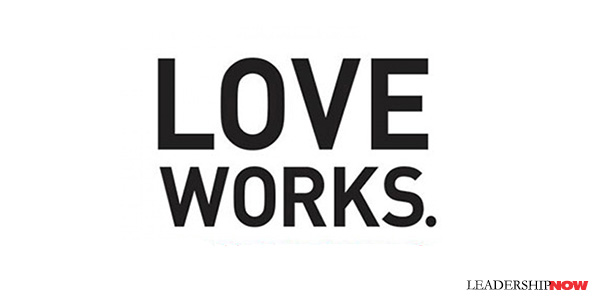
WE’VE heard that love is the killer app from Tim Sanders and Mark Sanborn says that “when we allow love to define who we are as we work, we become irresistible leaders with a contagious passion for what we do.” Joel Manby says that Love Works, but it’s hard. On the other hand, easy doesn’t get it done. It’s easier to “hit the numbers” than to worry about how our decisions impact the lives of others. It’s easier to fire someone than to work with them. But easier doesn’t build trust, it doesn’t grow and nurture a strong culture that brings out the best in people, and it doesn’t build a lasting, healthy organization that attracts the very best and stands the test of time. Leading with love is a higher testament to one’s leadership acumen than simply taking the well-trodden path toward fear-based, power-hungry management. Leading with love demands commitment, strong will, and patience, but the results are second to none. Manby says love is an action and not a feeling. He identifies seven behaviors: to be patient, kind, trusting, unselfish, truthful, forgiving, and dedicated. These are the bottom-line behaviors for leading with love. Leading with love is a lifestyle choice, says Manby, and should be part of what he calls your be goals as opposed to your do goals. Your be goals are completely within your power to execute. How will you lead? 
Posted by Michael McKinney at 11:23 PM
06.15.12

What’s Wrong with Leadership Training Today? IT’S A DIFFICULT TIME for leaders. “Our familiarity with and disrespect for our leaders,” writes Harvard professor, Barbara Kellerman in The End of Leadership, “coupled with our feeling entitled and being emboldened, saps their authority, which then drains their power and influence.”
IT’S A DIFFICULT TIME for leaders. “Our familiarity with and disrespect for our leaders,” writes Harvard professor, Barbara Kellerman in The End of Leadership, “coupled with our feeling entitled and being emboldened, saps their authority, which then drains their power and influence.”
Commenting on the 2011 budget-ceiling talks she finds that Barack Obama’s followers are “more disposed to resist him than to support him….No one was able to lead…and no one was willing to follow.” Perhaps no one was able to lead because no one was willing to follow. Leading in America is now more difficult than ever “not only because we have too many bad leaders, but because we have too many bad followers.” Kellerman cites lack of involvement as the culprit, but it goes further than that. We have never been taught how to support a leader in the right way. Followership is as important a skill as leadership. Kellerman notes that the contract—you lead, I’ll follow—between leaders and followers has been undermined “because of the information to which followers now have access, too many leaders are judged by too many followers to be unethical or incompetent or both.” Familiarity with our leaders had bred contempt. Technology has changed the social landscape providing us with so much more information. But it has, I would argue, informed us more broadly, but for the most part, not more deeply—if we even had the time or the inclination to go more deeply. I would also suggest that we are not, at times, very good judges. We lack facts and context much of the time. What frames our judgments are often selfish concerns—just like our leaders. And too, we rarely judge others in the manner that we would like to be judged. The End of Leadership offers a report on the state of leadership and followership today. Kellerman has surveyed the history of leadership to pinpoint a trend—the diminishing power and influence of leaders and people in authority and the increase of power and influence of ordinary people—followers. In recent years, communications technology has played a large part. “The effect on leaders is to diminish them. The more we know about how leaders and managers manage, the more they tend to shrink.” The contract between leader and follower has changed. The assumptions on which it was based has changed because first, “the old justifications for having power, authority, and influence are no longer so persuasive and second because people in the present think of themselves are more important, more entitled than did people in the past.” Kurt Anderson asked in New York magazine, Is Democracy Killing Democracy? He writes: So now we have a country absolutely teeming with irregular passions and artful misrepresentations, whipped up to an unprecedented pitch and volume by the fundamentally new means of 24/7 cable and the hyperdemocratic web. [There is ] the misapprehension that democratic governing is supposed to be the same as democratic discourse, that elected officials are virtuous to the extent that they too default to unbudging, sky-is-falling recalcitrance and refusal. And the elected officials, as never before, are indulging that populist fantasy. Just as the founders feared, American democracy has gotten way too democratic. I wonder if we have—in our radical shift to the entitlement of followers and the bad leadership that encourages it—sowed the seeds for an overcorrection in the other direction. Perhaps we will find ourselves welcoming a society governed by extremely self-deferential leaders to sort it out. History shows us that when societies get to the point that they can’t properly govern themselves, they don’t get more disciplined and make the necessary corrections, they instead get behind anyone that will make all the “bad” go away—usually with negative consequences. Because we have been able to “do” leadership in a way that has been less respectful of the follower and get away with it, doesn’t mean we were doing it right. While old methods of leadership are not tolerated at the present time, it doesn’t mean leadership itself has changed. The “right” way of leading people has never changed; our approach to leading people just swings back and forth from ditch to ditch. History shows us that we rarely get it “right.” Kellerman observes that in the world in which we actually live, “leaders tend to put self-interest ahead of the public interest.” How true. The idea that our leaders reflect who we are should give us pause. Much of the problem with leadership training, in my view, is that we are trying to develop something in leaders long after the train has already left the station. It’s not that it can’t be done. It’ is just much harder. Good leadership development begins much earlier in life. Given our situation, Kellerman asks, how do we learn to lead in the twenty-first century? How to learn to lead when leaders are diminished from what they were, even in the recent past? How to learn to lead when resources such as power, authority, and influence are scarcer than before—and when any number of followers is as likely to be resistant as deferent? And, finally, how to learn to lead when the context itself is fraught with complexity and constraint? Could we develop betters leaders if we developed better followers and would better followers create a pool of better leaders? Should we be training for followership? Should we be teaching the right kind of followership is leadership? The End of Leadership is a vitally important book that every leader/follower should read and consider, but it is the tip of a much larger discussion about leadership, followership and society. Kellerman writes that “it is meant as a caution about the future of leadership in the twenty-first century. For nearly everywhere, leaders are found wanting, followers are restive, and the context is changing—sometimes at warp speed. So unless we get a grip, the prognosis is grim.” Kellerman says that the leadership industry must make at least four changes:
Kellerman lays the foundation with this: “We need to think of leadership as a creative act—for which leaders and followers both are educated, for which leaders and followers both are prepared over a lifetime of learning….There are ways to educate women and men so they learn to be good, smart followers as well as good, smart leaders, and develop as large capacity for contextual intelligence as for emotional intelligence.” Absolutely.

Posted by Michael McKinney at 03:19 PM
05.08.12

What Matters Now
What Matters Now by Gary Hamel is an important book. It is an invitation to rethink the fundamental assumptions we have about capitalism, management, institutions, and life at work. It is, as Hamel describes it, “a blueprint for creating organizations that are fit for the future and fit for human beings.” It would be wrong to assume that hierarchies and managers will go away. But we need to rethink how we operate within our organizations. The book is divided into five fundamental, make-or-break issues that will determine whether your organization thrives or dives in the years ahead: values, innovation, adaptability, passion and ideology. Here are some of his thoughts that become more powerful as they sink in:Values Matter Now. • What matters now is that managers embrace the responsibilities of stewardship. • Every institution rests on moral footings, and there is no force that can erode those foundations more rapidly than a cataract of self-interest. • I think corporate life is so manifestly profane, so mechanical, mundane, and materialistic, that any attempt to inject a spiritual note feels wildly out of place—the workplace equivalent of reading the Bible in a brothel. Innovation Matters Now. • Post these simple questions on your company’s idea wiki: First, what are the thoughtless little ways we irritate customers and what can we do to change that? And second, what are the small, unexpected delights we could deliver to our customers at virtually no additional cost? • Whenever you identify a convergent belief, ask, does this rest on some inviolable law of physics, or is it simply an artifact of our devotion to precedent? By working systematically to surface these invisible dogmas, you can turn reactionaries into rebels. • To innovate, you need to see your organization and the world around it as a portfolio of skills and assets than can be endlessly recombined into new products and businesses. Adaptability Matters Now. • To thrive in turbulent times, organizations must become a bit more disorganized and unmanaged—less structured, less hierarchical, and less routinized. • There are only two things, I think, that can throw our habits into sharp relief: a crisis that brutally exposes our collective myopia, or a mission so compelling and preposterous that it forces us to rethink our time-worn practices. • To put it bluntly, the conversation about “where we go next” should be dominated by individuals who have their emotional equity invested in the future rather than the past. It needs to be led by individuals who don’t feel the need to defend decisions that were taken ten or twenty years ago. Passion Matters Now. • It’s impossible to unleash human capabilities without first expanding the scope of employee autonomy. People need the freedom to challenge precedent, to “waste” time, to go outside of channels, to experiment, to take risks, and to follow their passions. How, many policies in your company exist only to preserve that fiction that the higher-ups really are in control? How many rules enforce standardization at the expense of initiative and passion, while delivering few if any performance benefits? Ideology Matters Now. • The creed of control reigns supreme. If you doubt this, ask yourself: Is your organization any less rules-driven than it was ten or twenty years ago? Do people on the front lines feel any less controlled? Are their freedoms any less abridged? And are little cogs any less obsesses with becoming big cogs? • Give someone monarch-like authority, and sooner or later there will be a royal screw-up. • We don’t have to content ourselves with an organizational model that was designed to serve the interests of ancient military commanders and smokestack-era CEOs. It’s time to re-invent our leadership. This book will help in that process. 
Posted by Michael McKinney at 09:54 PM
02.15.12

The Inner World of the Leader: On the Couch with Manfred Kets de Vries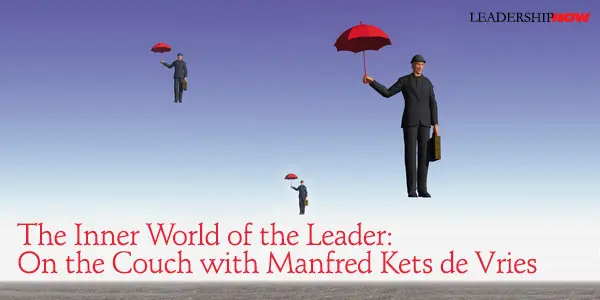
WHY do organizations attempt to function on the basis that executives are logical, rational, dependable human beings? Kets de Vries is a clinical professor of leadership development at INSEAD. His background in economics, management, and psychoanalysis, adds a great deal of richness and context to the study of leadership. Over the last three years Jossey-Bass has published a mostly revised and updated collection of his rather large body of thoughtful-provoking writing in this series of three books. The opinion of one of the power holders in the [Harvard Business School] Organizational Behavior department was that I would never write anything. That particular person must have had a very good understanding of human behavior. One of the small pleasures of life is doing something people say you will never do. I believe that [Reflections on Character and Leadership] is my twenty-ninth book. I have always thought that academics are masters in character assassination.Kets de Vries begins the series with Reflections on Character and Leadership. In it he examines some of the major issues about leadership. What makes a leader? What is good leadership? And what is bad? What happens to organizations if a leader derails? What are the impacts of successful and failed leadership on followers and organizations? Every leader needs someone who is willing to speak out and tell the leader how it is in order to create checks and balances—the counterweight of the person in power. Without such people leaders easily derail and organizations can become paralyzed by fear, mistrust and insecurity. He explains how leaders construct organizations that are great places to work. The era of the highly structured organization is past….Clearly, some executives may not be able to deal with the ambiguities that this new kind of networking, boundary-less organization entails—the external boundaries in an organization can be removed fairly easily, but the boundaries inside people’s heads are more difficult to dissolve. Weaning some leaders away from their need for authority, structures, and controls may take considerable time and effort. In the long run, however, it will be well worth it. Eventually, they will enjoy their work more, and be more effective.Kets de Vries says that narcissism is an inescapable aspect of human nature—and leadership. It has had a generally bad press. “There is such a thing as a healthy dose and it lies somewhere on a wide spectrum that ranges from grandiosity and showmanship to denigration and coldness.” He begins Reflections on Leadership and Career Development by discussing narcissism and leadership. Leadership can be pathologically destructive or intensely inspirational. But what is it about the leaders themselves that causes them to be one or the other? I believe the answer lies in the degree of narcissism in the personality of the leader in question. He discusses the qualities characterize great leaders and the interactions, both positive and dysfunctional, between leaders and followers. “The truly effective leader “is the one who knows how to balance reflection and action by using self-insight as a restraining force when the sirens of power start singing.” He takes a look at leadership archetypes and how they operate within organizations—and how to deal with them. He concludes with an examination of the issues, anxieties, and opportunities that we face at midlife and beyond. How can we alter our perspective on life to become “twice-born”? Finally in Reflections on Groups and Organizations, Kets de Vries looks at leadership issues in the context of groups and organizations. He examines various ways in which neurotic individuals create neurotic organizations. He describes how folie à duex—literally “madness shared by two”—works in an organizational setting; how individuals’ activity or passivity and tendency toward conformism can contribute to the process and what checks and balances could be used to forestall and manage dysfunctional leader-follower relationships.Kets de Vries doesn’t believe leaders are born. While some seem to have a head start, leadership potential can be developed. “Leadership potential is a delicate interplay between nature and nurture.” An effective leader is someone, says Kets de Vries, “who is a little like a Zen riddle, or kōan—a paradox who is comfortable dealing with paradoxes. Because a leader has to be active and reflective, an introvert and an extrovert, engaged in both divergent and convergent thinking. A leader needs IQ, but also EQ. A leader has to think atomistically, but also holistically, for the short term and the long term. Anyone who can balance these contradictions effectively will do well.” He advocates the building of an organization wide coaching culture ad discuss how it can be implemented. There are several basic things that any leader has to do: provide focus, understand what makes their people tick, set an example, and make things happen. However, the distinguishing factor between mediocre and great leadership is always the same: the creation of meaning….When it comes down to it, people are searching for meaning. This series of books cannot be read quickly. Each book in the series seeks to understand leaders, human nature and its vicissitudes. They need to be reflected on. They will challenge your thinking, widen your perspective and inspire you to do better.
Posted by Michael McKinney at 04:08 PM
02.08.12

Lead With Purpose
WITHOUT A CLEAR SENSE of purpose, organizations become listless. John Baldoni says in Lead With Purpose that it falls to the leader to make certain that organizational purpose is understood and acted upon. Retired Army colonel, George Reed told Baldoni that the importance of this cannot be underestimated: I don’t think you can hit purpose enough as a senior leader. It is one of those things that can be undercommunicated by an order of magnitude. You cannot oversell, overpronounce “Here’s why we’re here.”The problem is that leaders think that they have communicated it enough, but the urgencies of the day cause people to forget their original intentions and their passion. It causes leaders to forget too. Repetition is essential. Baldoni states: How well leaders use purpose to create the vision, mold the mission, and shape the values will serve as a testament to their ability to bring people together for a common cause.It may begin with an explanation of what the organization does, says Baldoni, but it is vital that it be linked to the organizational culture and values. That means having clear-cut, definite goals, putting people first, and importantly, reducing purpose to a simple and memorable statement. Baldoni has illuminated seven key people-smart things that organizations must do to succeed in the new future: Make purpose a central focus. Organizations that succeed are those that know where they are headed and why. Leaders of purpose tap into the power of narrative to help employees make sense of adversity and have faith in their organization’s ability to not just survive, but continually adapt and thrive. Instill purpose in others. Prioritize people. People have to know what they are doing and why they are being asked to do it. To cultivate and leverage high-performing people, emphasize mission, values, creation, collaboration, and execution, establish clear expectations for behavior, and embrace the credo: “Honor the workforce.” Make employees comfortable with ambiguity. Purpose can provide clarity in unsettled times. Leaders who find clarity in chaos, practice the virtues of pragmatism, and teach critical thinking skills will make living with uncertainty easier for their people—and themselves. Turn good intentions into great results. Even in a tough world and a people-sensitive company, it’s a bottom-line fact: the work still has to get done. Leaders of purpose balance creativity with practicality; keep a firm eye on efficiency, effectiveness, and accountability; and strive to instill ownership in every individual worker. Make it safe to fail (as well as prevail). Reasonable risk, daring to try something radical while keeping a grip on what works and what doesn’t, is critical to every breakthrough success. Leaders of purpose explore the impetus for change—reason, urgency, action—before leaping; respect their people’s resourcefulness; and handle setback with grace. Develop the next generation. Few senior business leaders will be in their current jobs five or ten years from now. Leaders of purpose prepare their people for a future beyond them by hiring with care, developing capable, competent employees who are able to rise to challenges and seize opportunities; and enabling others to lead. Prepare yourself. Purposeful organizations need leaders who know themselves first; have the inner compass that points them in the right direction. Many leaders never take the time to do so. Take time to reflect on what you want to do, why you want to do it, and how you will do it. Baldoni says to define purpose, you want to ask three questions: What is our vision? Vision emerges from the sense of purpose. It forms the why, but it also embraces the future as in “to become” the best, the most noted, the highest quality, or the most trusted. What is our mission? Your mission is the what of an organization; what it does. What are our values? Neither vision or mission mean much if they are not reinforced by strong values. Values shape the culture. Values enforce the behaviors that employees cherish.
 

Posted by Michael McKinney at 11:38 PM
01.27.12

Managing With a ConscienceWe handicap our potential when we think we have to exploit others to get ahead. Succeeding is not a zero-sum game. We don’t look better when everyone else looks worse.Frank Sonnenberg makes the case in Managing with a Conscience, that the only sustainable way to succeed is the right way—not cutting corners—emphasizing the intangibles like trust, creativity, focus, speed, flexibility, relationships, loyalty, and employee commitment. While not readily measureable, they can make or break leaders and organizations. Sonnenberg believes that leaders who have a jaded view of intangible assets will never make the commitment required to reap their full potential. Sonnenberg discusses at length, nine critical success factors that need to be built into the organization:
Employees have the right to approach management. Management should announce an open-door policy. But announcing is not enough. Employees should feel comfortable approaching management. Ask yourself if you’re in your office long enough to be approached. Are you available at convenient times or only at 7:00 a.m.? Has your administrative assistant done everything to screen you from “outsiders” except put barbed wire outside your office? When a concern was brought to your attention, in confidence, did you divulge any part of the information? Do you just go through the motions of listening? It is up to you to take the initiative and get out of your office to meet with employees. Been seen on a regular basis so people don’t think you’re avoiding them.Sonnenberg writes, “If your organization isn’t focused, someone is probably undoing something you just completed.” How true. As he notes, when people don’t know or understand the organizational purpose, they end up going in different directions, often competing with each other. And this is true in the social media environment, too. It is not unusual to see social media participants undoing an organization’s values and beliefs because they simply don’t understand them or can’t live them. They create conflicting messages that undermine the purpose of the organization. “The costs to society,” writes Sonnenberg, “of everyone acting like random molecules bouncing off one another is just too great. We have no time to think about what is important. We judge someone’s worth by what we see on the outside rather than their inner worth. We envy someone who has achieved success without thinking about what they did to earn it.” We can change that, if we begin with our own example first.

Posted by Michael McKinney at 04:34 PM
01.03.12

Power Corrupts Sooner than You Think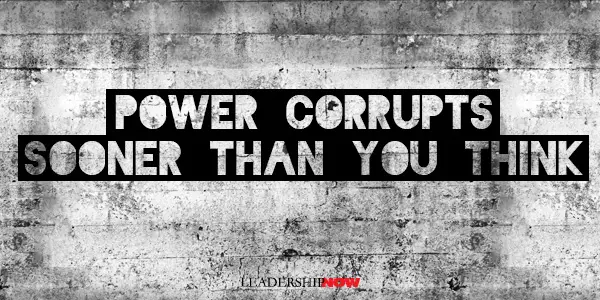
IN A LETTER to Bishop Mandell Creighton in 1887, Lord Acton observed that “Power tends to corrupt, and absolute power corrupts absolutely. Great men are almost always bad men.” British Prime Minister William Pitt also observed, “Unlimited power is apt to corrupt the minds of those who possess it.” Power is a tricky thing and we rely on it more than we should. In a study by Adam Galinsky and others, they found that when people where power primed—temporarily made to feel powerful—they demonstrated a reduced tendency to comprehend how others see, think, and feel as compared with those that were primed with low power. They relied too heavily on their own vantage points and demonstrated less accuracy when assessing the emotions and thoughts of others. The possession of power or even the feeling of power tends to very quickly change how we think. We easily slip into thinking we are something we are not, to become absorbed with ourselves, to think, “It’s all about me.” Our ego can quickly blind us to reality—self-deception sets in very quickly. We lose self-awareness and therefore our sense of the impact we are having on others. We would do well to remember the Stripes Rule. Denny Strigl, former CEO and president of Verizon Wireless, recalls in Managers, Can You Hear Me Now?: When I became president of Ameritech’s cellular subsidiary, Ameritech Mobile, the chairman of Ameritech told me something that has stayed with me ever since. He said I would be managing an entire company, and as the company’s most senior manager, I should always remember that the “stripes” I have been given are on the coat I wear, not on the person who wears the coat. He cautioned me not to let the job go to my head because when I take the coat off, I will just be a person like any other. Power, it seems, can easily become a handicap and not a blessing to leading well. But it often comes with the territory. A wise leader might keep Lord Acton’s words front and center.
Posted by Michael McKinney at 09:25 AM
11.16.11

We Blame the 1%, But Still Call Them Our Leaders Approval ratings have consistently hovered at historic lows for both American political parties for years. Thousands have organized in angered protests on a near monthly basis to express their distrust and impatience with the political and economic elite, spanning stark polarities of social groups like the Occupy Wall Street movement and the Tea Party. As his own approval ratings have fallen toward the abysmal ratings of former President George W. Bush—and with the 2012 Presidential Election now looming -- the inspired election of President Obama certainly feels like ancient history. Clearly, the deep leadership problem that is wreaking havoc throughout our modern world is neither a Republican nor Democrat problem. The real problem, as I contend in my new book Lead Without Followers: How to Save Our World by Radically Redefining the Meaning of Leadership, is that we have collectively, quietly, even subconsciously lost sight of what it really means to lead—the essential, fundamental, unshakeable human core of what leadership is, amongst and on behalf of others. My book is a radical redefinition of leadership. By that, I mean to encourage you to rethink the very relation between a leader and followers. At first glance, we would all deduce that if you have no followers, you cannot lead, because you have no one to lead. A quote that I often hear attributed to John C. Maxwell goes something to the effect of, "If you think you're a leader but no one is following you, you are just a guy going for a walk." This is the highly constrained, indisputable law of today's definition of leadership. But what about what you do when you're on that walk? Do you come across others? Get presented with an opportunity to do good, do wrong, or resort to indifference? Become a hero or one of many bystanders who did nothing to help? Lend a hand? Offer a smile? Nobody lives in a bubble. In our lives, we encounter countless dozens, if not hundreds, if not thousands of lives. Each seemingly routine and mundane interaction—even with a complete stranger you'll never see again—is an opportunity to positively, negatively, or neutrally impact his or her life, potentially forever. To me, simply living in this world and among its peoples gives you the raw opportunity to become a bona fide leader. By simple choice, with some internal exploration, personal growth and everyday practice, you can become a highly influential leader that positively impacts the lives of others, every day—even without followers. I argue in my book that "leadership" has become a far too limited term that is more accurately used to define the material wealth and career success of individuals among society—those who have succeeded in acquiring high salary, prestigious job title and social status, perceived popularity and power, and masses of followers. On a subconscious level, we socially acknowledge these qualifiers of material success as indicators of an individual's supposed ability to lead. Of course, making the assumption is matter simple logic: to rise to such a level of success, one has proven his or her intelligence and abilities—important necessities for leadership on business and political levels. However, today, and especially as popular protests lambast the supposed "1%" of corrupt politicos and evil big bankers, have we quietly grown into investing far too much attention into the things that individuals have acquired—wealth, status, power, followers, etc.—to shallowly qualify them as the best potential leaders for our world? Leadership today has become a dirty word. "Politician" is even dirtier. And as public rage swirls at the simple, commonplace status quo amongst the national zeitgeist, what it means to be a leader is becoming further convoluted. If we are truly dedicated to changing what we see as wrong with our world and feel it necessary to inspire a new generation of leaders to help turn things around, we owe it to ourselves to take a good, hard, long look at how we each define leadership in its typically constrictive terms. Maybe, just maybe, if we place renewed focus and energy into defining leadership more upon what drives us to do good—passion and inspiration, love and selfless giving, vision and dedication, positivity and hope—than the socially-admired material outcomes, we'll more quickly arrive at the solution. Not everyone can lead as a CEO of a Fortune 500 company. There can only be one President of the United States. But everyone, in as little as being human, can take up the vital mantle of leadership in their every day lives based upon everything that they already have—even without followers. Dave Ursillo is a former “politico” insider turned alternative leadership writer, author and speaker. The Rhode Island native teaches men and women how to become “leaders without followers” in any walk of life by discovering a personal and profound sense of inner leadership. At 23, Ursillo abandoned his fast-tracked career path in public service amid a crisis of identity and while battling depression. Opting for the unemployment line during a 100-year recession, Ursillo has built an expansive digital platform through a growing social media presence and as an avid writer, helpful personality and determined world-changer. Ursillo’s experiences from “his past life” span five governmental offices over six years from 2003 to 2009, including the White House Council on Environmental Quality under the Bush Administration in 2008 and as a “body man” to a state gubernatorial candidate in 2009. Since its inception in 2009, DaveUrsillo.com has reached over 70,000 readers from 173 countries. In June 2011, Ursillo and his blog were also seen in a feature story on CBS Sunday Morning about the world of blogging.
Posted by Michael McKinney at 05:17 PM
11.11.11

What Did He Know and When Did He Know It?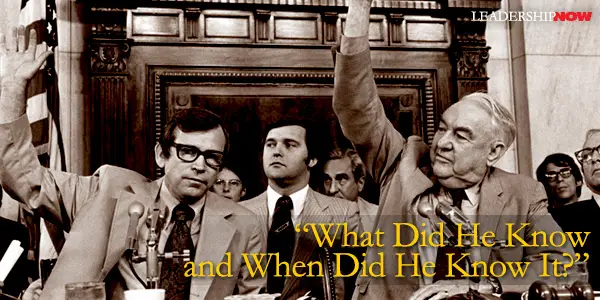
SENATOR Howard Baker’s famous question, "What did the president know and when did he know it?" is about moral responsibility. Leaders have a moral responsibility to the people they serve. Those relationships are a leader’s stock in trade and are to be valued above our agendas. For it is through the relationships we develop that we are able to accomplish anything at all. Our actions set the tone for the whole team. They express our values and our priorities. Above all leadership is something we live. It’s easy to get trapped in the agenda and forget why we are leading in the first place. The agenda is very visible and exciting. Lost in the agenda, we forget who we are and those we serve. We can be so focused on the goal that we forget the process. We move so fast we can’t hear our own values. We have to slow down so that our values catch up with our behavior. If we don’t, we make poor judgments, we misplace our loyalties, confuse priorities, and forget the well-being of the people we lead and the example we provide. In short, we ask the wrong questions and so we get the wrong answers. Before we choose to lead and throughout our leadership journey, we need to ask who we are and why we lead? It is that inescapable core that determines our behavior.
Posted by Michael McKinney at 05:16 PM
11.02.11

Leading Views: You Can’t Do It Without Love In
Up, Down, or Sideways, Mark Sanborn asks: In
Up, Down, or Sideways, Mark Sanborn asks:
So how are you doing with love? One method I use to assess myself in this area is to plug my name into a familiar passage from the Bible—1 Corinthians 13:4-7. It says, “Love is patient, love is kind. It does not envy, it does not boast, it is not proud. It does not dishonor others, it is not self-seeking, it is not easily angered, it keeps no record of wrongs. Love does not delight in evil but rejoices with the truth. It always protects, always trusts, always hopes, always perseveres.”Replace the word love (and the pronouns that represent it) with your name, and if you’re like me, it will convict you and challenge you.
Posted by Michael McKinney at 01:20 PM
10.24.11

Great by Choice
IT IS A defeatist attitude to think that luck or circumstances primarily make you what you are. Luck, both good and bad happen to us all. We cannot control much of what happens around us, but the choices we make, as Jim Collins and Morten Hansen’s research confirms, determine our success. In Great by Choice, the authors rightfully assert that we have entered an extended period of uncertainty and turbulent disruption that might well characterize the rest of our lives. The question then is, what is required to perform exceptionally well in such a world?. For their study, the authors chose a set of major companies that achieved spectacular results over 15 or more years while operating in unstable environments. They call these companies "10Xers" for providing shareholder returns at least 10 times greater than their industry. Then the authors compared those companies—Amgen, Biomet, Intel, Microsoft, Progressive Insurance, Southwest Airlines, Stryker—to similar, but less successful, "control" companies: Genentech, Kirschner, AMD, Apple, Safeco, PSA and United States Surgical.
Fanatic Discipline: Extreme consistency of action. Don’t overreact to events.
10X Leadership Behaviors 20-Mile March: This is the discipline to stay the course in both good times and bad. This means maintaining a lower bound and an upper bound, a hurdle that you jump over and a ceiling that you will not rise above, the ambition to achieve and the self-control to hold back. A 20-Mile March provides a tangible point of focus that keeps you moving forward. Fire Bullets, then Cannonballs: 10Xers increase their luck by firing lots of bullets instead of a big un-calibrated cannonball. The underlying principle is, be creative, but validate your creative ideas with empirical experience. Leading above the Death Line: 10Xers build in buffers because the only mistakes you can learn from are the ones you survive. They zoom-in and zoom out to manage risk and recognize luck. SMaC: Specific, Methodical and Consistent. Tactics change from situation to situation, whereas SMaC practices can last for decades and apply across a wide range of circumstances. “Steve Jobs didn’t so much revolutionize the company as he returned it to the principles he’d used to launch the company from garage to greatness two decades earlier.” There is always the struggle to find the balance between continuity and change. I find too many are wedded to one ditch or the other. Certainly luck plays a part. The authors found that the difference between the 10X companies and the comparison companies wasn’t the good or bad luck they got, but what they did with it. Key comment regarding luck: “If the ratio of head to tails tends to even out over time, we need to be skilled, strong, prepared, and resilient to endure the bad luck long enough to eventually get good luck.” Mountain climber “Malcom Daly had to be lucky enough to survive the fall, but he also had to be strong, skilled, and resilient before the 44 hours of peril after his two-hundred-foot fall.” The organizations they studied were paranoid about chance events and complex forces out of their control, but they focused on what they could do, seeing themselves as ultimately responsible for their choices and accountable for their performance—no matter what the sequence of coin flips. A thought provoking book that, like Collin’s other work, takes us back to basics. In conclusion they ask: When the moment comes—when we’re afraid, exhausted, or tempted—what choice do we make? Do we abandon our values? Do we give in? Do we accept average performance because that’s what most everyone else accepts? Do we capitulate to the pressure of the moment? Do we give up on our dreams when we’ve been slammed by brutal facts?

Posted by Michael McKinney at 10:57 AM
10.14.11

5 Leadership Lessons: EntreLeadership Dave Ramsey defines EntreLeadership as “the process of leading to cause a venture to grow and prosper.” Entreleaders know how to blend their entrepreneurial passion with servant-like leadership that motivates employees through persuasion instead of intimidation. EntreLeadership is a book about how business works from a practitioner. His advice, on nearly every facet of running a business, is based on solid principles. Here are just a few of his thoughts on leadership: 
Posted by Michael McKinney at 05:25 PM
09.26.11

Leading: Sharing Accountability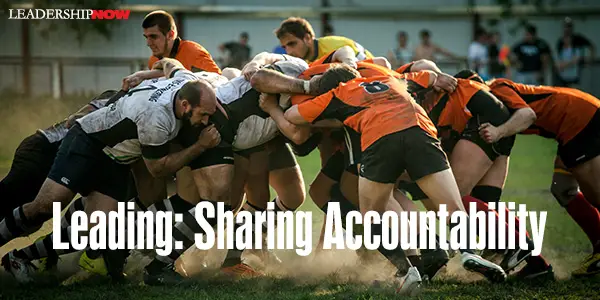
UNCERTAINTY necessitates the need for finding more wisdom within our organizations. This can only be accomplished by creating a leadership mindset throughout the entire organization. It is shared accountability. Any leader that thinks that they can do it alone is indulging their own ego. James Champy and Nitin Nohria cautioned us not to assume that no one else on the premises can match our own ambition, competence, and vision. We have to accept the fact that there are many points of wisdom within our organizations and a wise leader will engage them. Too many leaders are not accustomed to accepting input from junior members no matter how valuable it is. This creates a lack of trust and openness. The currency of leadership is relationships and a wise leader would do well to encourage input from as many sources as possible and especially not from the usual suspects. Phil Nolan, former CEO of Eir Limited, described it this way in A Time for Leadership: The concept of distributed leadership will keep you in touch with the environment. If you want to prepare people for this environment, you have to get leadership further down the organization. We generally tend to drive managing down the organization, but not leadership. Leadership needs to be the expected norm at all levels.
Posted by Michael McKinney at 12:08 PM
08.08.11

Common Purpose Leadership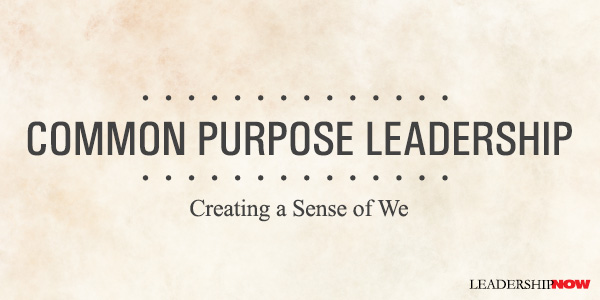
IN Common Purpose, consultant Joel Kurtzman makes the case that excellent leaders build a sense of inclusiveness—a sense of we—within the organization by creating a common purpose. A place where people know what to do and why and understand what the organization stands for. Based on interviews and first-hand experience, Common Purpose lays out how to achieve and then sustain a culture based on a common purpose. For example:
The easiest way to create a sense of we, says Kurtzman, is unfortunately to create the specter of them. Because it is easy, it is probably the reason you see this dynamic played out in so many organizations of all kinds. While it is a shortcut to common purpose, “it can also be a stepping stone to chaos, doom, and organized opposition.” I would add that within the organization or group, it also leads to arrogance, stagnation and closed minds. In most cases, it leads to decline. Organizations are created to achieve goals that “are beyond the capability of an individual to accomplish alone.” They are a method of “aligning groups of people so they achieve common goals.” This is best accomplished when you encourage people to be leaders at any level within the organization. Simon Cooper, president and CEO of Ritz-Carlton, says the best reason to rid an organization of mindless hierarchy is to provide scriptless service: employees deciding on their own how to make guests happy. “They make decisions on their own, on the spot, using their own judgment, and with the sense of confidence that comes from owning their jobs. That’s real leadership.” Taking risks on behalf of the organization. This requires trust at all levels and a different view of real leadership, says Kurtzman. It is difficult to overstress how important it is for teams of people working together to meet informally from time to time…The point is that you cannot lead a team if you do not know the people you are leading, and the best way to do that is informally. “The leader is not separate from the group he or she leads. Rather, the leader is the organization’s glue—the force that binds it together, sets its direction, and makes certain that the group functions as one.” Kurtzman notes, “Leadership is not coaching. Coaching focuses on helping people arrive at their own goals. Whereas leadership, especially common purpose leadership, is about helping people arrive at a collective set of goals. It is about coordinating people’s efforts, aims, ambitions, and capabilities.” Leaders can’t think of themselves as better than their workers or more favored because they have a higher rank. Becoming CEO is not a coronation; it’s a promotion. And CEOs can’t do everything. The purpose of an organization is to combine the efforts of many people to produce results no one on his or her own could achieve alone. Leaders must understand that. They must live the goals they espouse. They must understand that everyone inside the organization is looking at them — scrutinizing them, really — and also that every action of theirs is being watched and talked about. At FM Global, Shivan Subramaniam, the chairman and CEO, decided against buying a corporate jet despite the prodding of his board. Instead, he decided to abide by the same corporate travel rules that every other executive in the company abides by. He even flies on the redeye if he must. By doing this, he sends a powerful signal throughout the company that while he may be the CEO, he’s also an employee, just like everyone else. People value that. People will do almost anything for a leader like that. Of course, one size does not fit all. “People are individuals, and those who thrive in one firm might not thrive in another. Chemistry, fit, values, and many other qualities are in the eye of the beholder.” Kurtzman believes that “organizations will come to resemble constellations of capabilities linked together technologically from centers located around the world….Big companies will comprise smaller pieces, each with unique characteristics, ownership structures, and relationships. Each of these elements, when combined, will create enormous value?” The question is what will keep it all together. Incentives alone won’t do it. “The power of a common purpose will become the factor that differentiates winning organizations from those left behind.” This means that leaders will have to be “kinder, more caring, and more empathic than leaders of the past.” We have seen this increased focus on respect as many of you write, talk, and practice this on a daily basis. Common purpose leadership, at its most basic level, is about recognizing people as individuals. Common purpose leadership begins with respect for individuals and their differences, and goes on to celebrate their strengths. 
Posted by Michael McKinney at 10:59 AM
07.28.11

Who's the King?
THE lion was completely convinced about his dominance of the animal kingdom. One day he wanted to check whether all the other animals knew he was the undisputed king of the jungle. He was so confident that he decided not to talk to the smaller creatures. Instead he went straight to the bear. “Who is the king of the jungle?” asked the lion. The bear replied, “Of course, no one else but you, sir.” The lion gave a great roar of approval. He continued his journey and met the tiger. “Who is the king of the jungle?” The tiger quickly responded, “All of us know that you are the king.” The lion gave another roar of pleasure.  This story illustrates that even in the face of another point of view, we reshape the feedback until it supports what we want it to mean. We often will do anything to maintain the status quo. The problem is that reality is slipping further and further away. “Some leaders are like the lion,” says Manfred Kets de Vries author of Reflections on Groups and Organizations. “Reality testing isn’t their forte. They are not good at making sense out of feedback. Instead, they create their own reality, wanting to see only what they like to see.” 
Posted by Michael McKinney at 04:19 PM
06.27.11

The Big Vision is Important but People Live in the DetailsMost leaders don’t want to be called a tyrant, a control freak, or even a micromanager. To avoid that, it’s easy to jump into the other ditch and be laissez-faire. Leaders have a duty to navigate between these two extremes as the situation dictates.Typically, we like to present the vision—the values—and leave the details to be sorted out. We like to give the big overarching principle without explaining exactly how it plays out in everyday life. The problem is that everything happens in the details. That’s where people live. That’s where decisions are made, community is built, and your vision and values are realized—or not. We like to articulate the “promised land” and expect that everyone will catch on. That might work for the most highly visible leaders—those interacting with employees day-in and day-out—because they see you translating those values and goals on a day-to-day basis. But seriously, how many of us are that visible? We’re far too busy!?! We don’t want to be caught telling people what to do, but we want everyone on the same page. Life doesn’t work like that. People see the same thing and hear the same thing differently. They interpret it differently and thus it plays out in their behavior differently. And that is where the friction starts. That’s where the community breaks down. That’s where the judgment begins. Organizations, groups and families need more guidance than that. I’m not suggesting that we become control freaks, create even more rules, or become condescending or judgmental, but we need to clarify the vision and values in the details where people live. What do our values look like in everyday life? We need to use examples as they come up to relate everyday behavior to our values. Show where they match-up and where they don’t in a way that leaves room for them to develop good judgment and practical wisdom. From the beginning—and along the way as needed—we need to spell out, “This is the kind of company we want to be, this is the kind of people we want to be, so that means we don’t do this but we do do that.” Specifically. And we then communicate this over and over again in our rhetoric and actions. People need to know and understand your values if their behavior is to be guided by them. If there is a disconnect between your values and everyone’s clear understanding of them, confusion and misbehavior will define your leadership.
Posted by Michael McKinney at 08:17 AM
06.03.11

4 Lessons from the Toyota Crisis
“Crisis response must start by building a strong culture long before the crisis hits,” say Jeffrey Liker and Tim Ogden, authors of Toyota Under Fire. Turning crisis into opportunity is all about culture. It’s not about PR strategies, or charismatic leadership, or vision, or any specific action by any individual. It’s not about policies or procedures or risk mitigation processes. It’s about the actions that have been programmed into the individuals and teams that make up a company before the crisis starts. The accident in August 2009 that took the lives of four people in a runaway Lexus brought national attention to Toyota. Fueled by innuendo and speculation by Congress and some media, it escalated into something it was not. Toyota Under Fire deals with not only the massive recall of 2009-2010, but also Toyota’s response to the oil crisis and recession. Toyota’s response has not been typical, but it does follow the Toyota Way. It is a reflection of their culture. That way includes what is probably Toyota’s “greatest contribution to the world as a model of real continuous improvement” at and by all levels in the organization. Liker and Ogden describe the Toyota Way as: Face challenges with a clear head and positive energy. Hold fast to your core values and your vision for the company. Always start with the customer. Understand the problems that you face by analyzing the facts, including your own failings, and understanding the root causes. Thoroughly consider alternative solutions, then pick a path, develop a detailed plan, and execute with discipline and energy. “You do not turn a culture off and on again like a light switch.” Culture—like character—is built over decades of living your values in the real world. And then in a crisis, when you really need it, it is there to carry you through. The authors isolated four lessons for dealing with a crisis: Lesson 1: Your Crisis Response Started Yesterday. What a company does isn’t likely to change much when a crisis strikes or for any length of time. “They are driven by culture, and culture simply can’t be changed quickly, even in a crisis…. Therefore, the chief questions to ask yourself about how your company will respond in a crisis are not contingency plans and policies, but about your culture and your people. Have you created a culture that rewards transparency and accepts responsibility for mistakes? Have you created a culture that encourages people to take on challenges and strive for improvement? Have you created a culture that values people and invests in their capabilities? Have you created a culture that prioritizes the long term?”Lesson 2: A Culture of Responsibility Will Always Beat a Culture of Finger-Pointing. Common sense? Yes, but the question is how far do you go in accepting responsibility? What if the factors were beyond your control? The answer illuminates an important nuance in understanding Toyota’s culture of responsibility and problem-solving. “There is no value to the Five Whys [the belief that you have to ask why at least five times] if you stop when you find a problem that is outside of your control. There will always be factors outside of your control. When you reach a cause that is outside of your control, the next why is to ask why you didn’t take into account forces outside of your control—either by finding an alternative approach or by building in flexibility to adjust to those forces.” Lesson 3: Even the Best Culture Develops Weaknesses. The greatest threat to a culture of continuous improvement is success. “To survive the weaknesses that inevitably develop, a corporate culture has to have clear and objective standards, codified in such a way that self-correction is possible. Having a culture that recognizes a loss of direction is absolutely critical to long-term survival.” Lesson 4: Globalizing Culture Means a Constant Balancing Act. The clarity of Toyota’s culture and values is essential to growing the culture in every employee. And there is a balance to strike—the balance between centralized and decentralized, local and global—that is not easy. “There is an inherent demand here that especially the people who are at the margins, at the periphery of the organization, be deeply steeped in the culture, and that they are to be trusted to make decisions because they are at the gemba.” One of the root causes of the crisis they identified was centralized decision making. They will now pursue a regionalization strategy which will require trusting the leaders they have trained to maintain the culture. Toyota Under Fire is an in-depth look at the value of having a strong culture that can serve you when things go south. The discussions explaining the reasoning behind why Toyota does what it does were very helpful. They demonstrate that the most important decisions are the ones made before the crisis. And then when the crisis hits, return to basics. Go deeper and wider. 
Posted by Michael McKinney at 05:21 PM
05.10.11

Can I Lead? Yes. But…There is a danger in selling leadership to everyone.Serious practitioners of leadership know that there is a lot of work that goes into being a good leader (dictators of any variety, not so much). Competence in your chosen context for leadership aside, the life-long inside work of leadership—figuring out what you won’t do before you figure out what you will do—is sometimes gut-wrenching and sometimes the most thrilling feeling you can experience. Character usually isn’t explicitly stated in the sales pitch. Instead, leadership is quite often seen as a way to be heard, to advance your own agenda and to put yourself out front. It is no surprise that Alan Webber recently wrote in the Washington Post: You will be told that you have a responsibility to be leaders. That what the world needs more than ever are leaders. That we suffer from a lack of leadership. That with your education, your values, your ability to apply social media, your global vision, your youthful idealism, you will be the next generation of leaders!Choosing to lead is one of the most rewarding decisions you may ever make. But it’s not about you. Yes, you will bring your unique and much needed gifts to the world, but not for your own sake. Your job is to use your gifts to help others express, make known and fulfill their potential. Influencing others with a purpose, a calling, and with opportunities they never imagined they had. It’s a mindset of service. It’s a mindset of continual learning. It’s a mindset of growth. The single biggest truth of leadership is that we build who we are by building up others. That doesn’t come naturally to us, but it’s your calling, if you would be a leader.
Posted by Michael McKinney at 03:15 PM
04.07.11

Leadership is about Creating ConversationsPoet and Fortune 500 consultant David Whyte said that “The core act of leadership must be the act of making conversations real.” Conversations—sometimes difficult conversations—are what build relationships. Conversations that provide the opportunity for possibility. Conversations about choice.Leaders create the opportunity for conversation. By bringing people together for conversation they increase engagement, commitment and accountability. Leaders ask people to share their own genius and assume personal leadership. At that point the ability to listen becomes paramount. Accountability isn’t only at the top. It lies with all of us. All of us are responsible. Possible futures are not the work of one person. They are made possible by the conversations and resulting accountability of a community of leaders. Leadership is about creating conversations.
Posted by Michael McKinney at 07:18 PM
03.21.11

What's Holding You Back? A Call for Gutsy Leadership
ROBERT HERBOLD, former COO of Microsoft, says that lack of courage is what destroys companies. In example after example, what is holding companies back is consistent, courageous leadership. In What’s Holding You Back? he writes that we need gutsy leaders that “make sure that their organization has a simple, understandable, clear game plan for the future,” a culture that is “curious, even paranoid about the future, to keep people always looking for new ways to help the company grow and prosper,” they “make sure decision making is crisp and accountability is clear.” Management that doesn’t confront problems and make the necessary tough decisions to change, typically ends up with a culture focused on pride in the past and the protection of old procedures. I think we are seeing too much of this core issue, and what we end up with is operational complexity and lack of innovation and forward momentum. Herbold says that this is usually due to one or more of the following reasons: Avoid conflict
Herbold details ten principles that you should review regularly to help you provide gutsy, courageous leadership. The most important principle and the one underlying the rest is the first principle: Devise a Demanding Game Plan to Confront Reality. This is accomplished by putting three things in place: “a clear vision with impact, aggressive strategies to achieve that vision, and a defined way of measuring success. Echoing Max De Pree, Herbold writes, “The core job of a leader in any organization is to quickly and accurately assess the current situation and any vulnerabilities and opportunities the organization may have.” He adds, “The leader must then lay out a demanding game plan…and stand ready to modify that plan at any moment, given new learning.” The process of creating aggressive strategies to achieve that vision should be “very interactive and fact-driven, and it can become an engaging and exciting venture for the organization.” Finally, appropriate measures should be defined to tell everyone whether or not the vision has been achieved. What’s Holding You Back? is valuable for reminding us of basic principles that are easily overlooked as we get caught up in the daily minutia. Another part of defining reality that I think is significant enough to mention is understanding our impact on those around us. It’s not uncommon to find that we hold others back because of remarks we make, and as a result, we lose the full potential of what they bring to the table. In a section titled “Creativity and Six Sigma don’t Mix,” Herbold writes: Innovation is not an orderly process. People who are good at it tend to go through many ideas before coming up with one that works. It’s also a very fragile process. A manager can stifle innovation without even knowing it through his or her unspoken communications. People who are charged with innovation are constantly observing how their management is acting and reacting. Unfortunately, they often interpret their management’s behavior and casual comments as specific instructions or constraints that need to be followed. As we need to consistently ask, “What’s holding me back?” we also need to ask, “How am I holding others back?” 
Posted by Michael McKinney at 10:50 PM
02.22.11

Leading As One: Generating Collective BehaviorTo be successful in the world we’re entering, we will need a new set of mental models. While these new models should not exclude the possibility of commanding and controlling, they need to encompass a much wider range of possibilities.The challenge facing any leader is turning individual action into collective power. In short, getting people to act as one. As One by Mehrdad Baghai and James Quigley, is the result of a two year research project conducted by Deloitte Touche Tohmatsu Limited, to understand this common leadership challenge and to answer the question, “What leads to effective collaborations in a wide range of fields?” Not just working together, but working as one. As we talk about leadership it is easy to confuse ends and means and seek collaboration for collaborations sake. The authors note that collaboration "is a means to an end, not an end in itself, and that because the purposes might be different you might need different styles" of collaboration for different situations. Thus we find successful leadership comes in many different shapes and sizes. They believe real leadership is about productivity, people and purpose—or As One Leadership—“leadership that results in a cohesive group of people working together effectively toward a common goal or purpose.” Initially the task is identifying which people need to be involved (the Who) and what purpose they need to satisfy (the What) and then How do we need to collaborate to get the results we seek. 
What emerged from the As One Flagship Project was the identification of eight models or archetypes of As One behavior. Arranged around two axes: a vertical axis that describes how power is exercised in an organization from emergent to directive and a horizontal axis that conveys the nature of individual’s tasks and outlines how work is organized from highly scripted and uniform to highly creative. 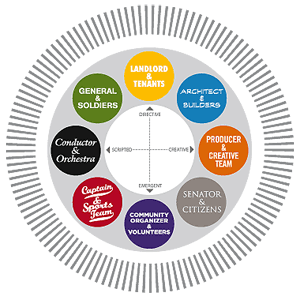 Not surprisingly, these archetypes reflect both top-down and bottom-up styles. The analysis is very balanced. In the descriptions that follow, you can see that different kinds of organizations or situations with different kinds of objectives call for different kinds of leadership. It is enlightening to identify your type of organization and the related leadership approach. The book presents case studies of each type, an explanation of the key characteristics, and a discussion of what you can do to be better at that type. Not surprisingly, these archetypes reflect both top-down and bottom-up styles. The analysis is very balanced. In the descriptions that follow, you can see that different kinds of organizations or situations with different kinds of objectives call for different kinds of leadership. It is enlightening to identify your type of organization and the related leadership approach. The book presents case studies of each type, an explanation of the key characteristics, and a discussion of what you can do to be better at that type.
The Deloitte Center for Collective Leadership was launched in January to advance the study of the As One Collective Leadership discipline and As One behavior. Through research, data collection, and analysis, this center will help define and increase knowledge in the exciting and dynamic field of collective leadership. If you are wondering what your model is, they have created an online As One Classifier tool to figure out which archetype is closest to your current situation. THE EIGHT ARCHETYPES The four main archetypes are: Landlord & Tenants: The Landlord & Tenants pairing is based on landlords’ top-down driven strategy and power: they control access to highly valuable or scarce resources. Landlords decide how to generate the most value for themselves and dictate the terms of participation for the tenants. Tenants voluntarily decide to join landlords, and it’s usually in their best interests to do so. However, once they do, landlords define the rules of participation. Landlords maintain their power by ensuring the best tenants are rewarded, so that, over time, as the number of tenants grows, the landlords’ power increases. Community Organizer & Volunteers: The Community Organizer & Volunteers pairing is based on volunteers’ bottom-up, autonomous, independent, decision-making ability and their desire to voice their opinions. Community Organizers ignite volunteers’ interest through compelling storytelling and opportunities for volunteers to join in. They may have little direct power over the volunteers, but they can tap into volunteers’ interests by gaining their trust, promoting a strong brand, and understanding their motivations. Volunteers themselves are drawn together by a rallying cry, or out of a sense of enlightened self-interest; they gain their power through a strength-in-numbers approach. Conductor & Orchestra: The Conductor & Orchestra pairing is based on highly scripted and clearly defined roles that focus on precision and efficiency in execution as defined by the conductor. The orchestra members, who have similar backgrounds, need to be fully trained to comply with the requirements of the job, and, therefore, must be carefully selected to ensure they fit the strict culture and scripted tasks. Belonging to the orchestra provides members with the best way to make a living while focusing on tasks at which they excel. Producer & Creative Team: The Producer & Creative Team pairing is typically about producers providing their creative team with the freedom to do their best work and reach their natural potential. This pairing is led by legendary, charismatic producers who bring together a team of highly inventive and skilled independent individuals to achieve the producers’ objective. Producers guide the vision and overall progress, while the creative team develops ideas through frequent meetings and interactions using an open culture of collaboration. Dissent is used to push creative boundaries. To maintain longevity in their industry, producers and creative teams need to continuously produce new and innovative ideas. The four hybrid archetypes combine the characteristics of the adjacent pairings and occupy the spaces between the axes. General & Soldiers: The General & Soldiers pairing has a command-and-control-type culture combined with a multi-level hierarchy organized around the general’s clear and compelling mission. Soldiers’ activities focus on clearly defined and scripted tasks. They are motivated by advancing up the hierarchy through well-defined roles at all levels. Soldiers undergo extensive training to understand the army and its culture, and to learn specific skills. They are committed to the mission, the overall institution, and each other, while the general provides strong top-down authoritarian direction to motivate and direct them. Architect & Builders: The Architect & Builders pairing focuses on the creative collaboration between groups of diverse builders that have been recruited by visionary architects to bring a seemingly impossible dream to life. Their visions are so innovative and ambitious that they can’t be achieved simply by using conventional means, so builders often need to reinvent and rethink ways to achieve them. Builders strive to meet ambitious deadlines and milestones mapped to deliberate workcycles. As each milestone is completed, the builders become one step closer to bringing the architect’s dream to reality. The Architect & Builders hero story is based on the development of the world’s cheapest car, the Tata Nano. Captain & Sports Team: The Captain & Sports Team pairing operates with minimal hierarchy and acts like a single cohesive and dynamic organism, adapting to new strategies and challenges with great agility as they appear. Members of the sports team have a strong shared identity. They have extensive and networked communication channels, and carry out the same highly scripted, repeatable tasks. There is strong camaraderie and trust among the sports team – the collective good outweighs the needs of the individual – while captains are there, on the field as part of the team, to motivate and encourage. Senator & Citizens: The Senator & Citizens pairing is based on a strong sense of responsibility to abide by the values or constitution of the community, which have been outlined by the senators. Sovereignty is held by both senators and citizens, and the citizens thrive on the values of democracy, freedom of expression, and autonomy. Since citizens are autonomous, the community structure is flexible. There is no set framework or direction organizing the citizens. Instead, much of their direction is emergent as they gather ideas and collaborate with other citizens. Senators are the guiding intelligence for the citizens and oversee decision making for the community. There is no one size fits all archetype and each archetype is more nuanced than described. Putting As One into practice consists of three steps: First, a diagnostic to assess the who and to do what and then determine the how or what archetype is being used. Second, determine the type of intervention to strengthen the archetype being used or to create a new approach and third to adopt the approach across the organization and applying different archetypes in different situations even in the same organization. It is an interesting study that begins to create a broader understanding of what it takes to lead at all levels as opposed to the common polarizing either/or discussions of command and control versus collaborative leadership. It also helps to dispel the myth that top-down leadership is synonymous with command and control. 
Posted by Michael McKinney at 12:11 AM
02.07.11

Consider: Harnessing the Power of Reflective Thinking in Your Organization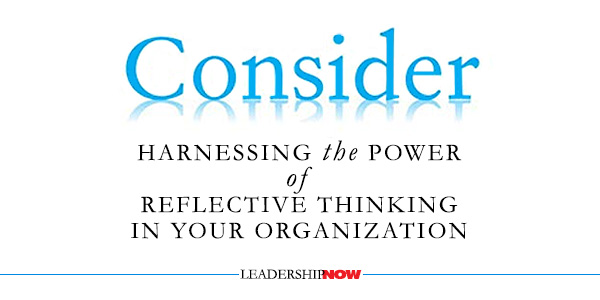
PETER SENGE, founder of the Society of Organizational Learning and senior lecturer at the MIT Sloan School of Management, once observed, “Most managers do not reflect carefully on their actions.” Most managers are too busy “running” to reflect. While reflection seems to have no place in a competitive business environment, it is where meaning is created, behaviors are regulated, values are refined, assumptions are challenged, intuition is accessed, and where we learn about who we are. Some of the greatest barriers to getting the results we want lie within us. Growth happens when we stop repeating our habitual patterns and behaviors and begin to see things in a new way and in the process, discover the power to create the results we want. That makes Consider: Harnessing the Power of Reflective Thinking in Your Organization, one of the most important books you’ll read this year. Author Daniel Patrick Forrester states, “Stepping away from the problem—and structuring time to think and reflect—just may prove the most powerful differentiator that allows your organization to remain relevant and survive…. The best decisions, insights, ideas, and outcomes result when we take sufficient time to think and reflect….Only by carving out think time and reflection can we actually understand, in an entirely different context, the actions we take.”He defines think time as “the purposeful elevation of chunks of our work time, forged within densely packed schedules. It forces the consideration of core significant and pending decisions, outside of cursory overviews and immediate response…. Reflection is the deliberate act of stepping back from daily habits and routines (without looming and immediate deadline pressures), either alone or within small and sequestered groups. It’s where meaning is derived through reconsideration of fundamental assumptions, the efficacy of past decisions and the consequences including the downside of future actions. It’s where space is given for the ‘totally unexpected’ to emerge.” Even if we can agree on the value of think time, we still regard it as a luxury. There’s just no time. But what emerges from Forrester’s research is the fact that we can’t afford not to. It is at the core of what allows a business to thrive. It’s what we don’t know that has a disproportionate impact on us personally and organizationally. We don’t really see the reality we face. Reflection in effect expands our perspectives and thus reveals to us more options and that gets to the heart of what leadership is all about. The point is to make the unseen seen so we can act on it. Forrester interviewed Sarah Sewall who worked with General Petraeus and others to rewrite the military’s counterinsurgency doctrine. Sewall noted, “We are now in a world of increasing specialization, where people get narrower and narrower in their viewpoints in order to become more expert and ‘useful.’ My view is that people become more myopic in how they can think about problems and solutions. We wind up shuttered in our ability to think about possibilities.” This tendency is best counteracted by think time and reflection; being able to back away and incorporate more and varied thinking. Forrester asks, “What is the last document or strategy you can point to as a ‘product of reflection’ built with all parts of the organization and senior-level involvement? If you can’t cite one, it may indicate a culture that values immediacy and the short term over reflection and scalable problem-solving.” Recognizing the need for reflection and actually doing it are two different things. Reflection is a discipline. General Petraeus told Forrester that “he forces bursts of reflection into his day, where he pauses to read, think, and then moves to the next iteration—recognizing that thoughtful insights are not born through real-time analysis.” Forrester suggests that we set time aside for a meeting with oneself. “It isn’t hard to book a meeting with yourself, when you are off-limits to everything but your thoughts.” He notes too, “The power of reflection lies not in how much time we allocate to it. The power of reflection lies in how we choose to use that time and what structure we bring to the fleeting disjointed moments we are afforded.” While some situations required his immediate action, Forrester describes how Lincoln “developed ways to force time to think (if even only for a few minutes) before acting. Even Lincoln had to resist the “instantaneous nature of the telegraph.” Some organizations he has studied have adopted a no internal e-mail Friday policy and other ways to temporarily disconnect from technology. Although these ideas may not work for you, the point is made so that you might consider the impact these technologies are having on the productivity and well-being of your staff. There is always one more e-mail and it will control you if you let it. “When overworked people declare that they ‘just don’t have time to think,’ leaders have a choice: They settle for the status quo and declare that it’s the best way the world works today, or they can insist that reflection is a strategic business enabler,” says Forrester. As an organization, you can either educate for it, make it an expectation—a cultural norm—or treat it as a “do it on your own time” activity and pay the price. Leaders need to understand and demonstrate by example that reflection—taking time to consider—is not wasted time. Reflection is the first step in coming to understand how we are connected to our outcomes. Until we see the relationship between the two, we cannot make deep, lasting change and bring thoughtful behaviors to bear on the situations we find ourselves in. Our thinking creates our reality. If we do not reflect on our thinking we stand to miss our connection to the whole. Consider offers a way to break the pattern of continuous partial attention that seems to be our default position in this technological age. It helps to disrupt the habitual thinking that drowns out the reflective, critical thinking we need to become fully present and effective. Consider isn’t a fad. It is the bedrock of successful leadership and living. Upcoming: I asked some leading minds about the discipline of reflection. So, for the rest of the week, I’ll share their thoughts on this important topic. Look for valuable insights from John Kotter, Mark Sanborn, Brian Orchard, Marshall Goldsmith, John Baldoni, Tom Asacker, James Strock, and Jeremy Hunter.  More in this Series:
Posted by Michael McKinney at 01:57 PM
02.06.11

Ronald Reagan on Leadership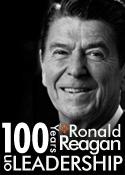 In her memoir, Personal History, the late Katharine Graham, former publisher of the Washington Post, tells a story about a dinner at her home attended by the Reagans and others in November 1988. When the Reagans arrived they were surrounded by well-wishing friends. Graham remembers that after someone knocked against a glass and spilled a drink, “I was dumbstruck,” she recalls, “at seeing the president of the United States down on his hands and knees in the middle of the crowd, picking up the ice.” Reagan possessed a servant quality that resonated with millions of people in America and abroad. On Vision:
Reagan believed that it is important for a leader to rise above secondary concerns to remain consistent and focused. His most important task was keeping his staff focused despite daily distractions. One of his aides recalled: "It was striking how often we on the staff would become highly agitated by the latest news bulletins. Reagan saw the same events as nothing more than a bump in the road; things would get better tomorrow. His horizons were just not the same as ours." James Strock sums it up well in his book, Reagan on Leadership: “As with all leaders of consequence, Reagan’s ability to lead others was an outgrowth of his ability to govern himself.” Of Related Interest:
Posted by Michael McKinney at 12:15 PM
01.05.11

Insist on Heroes. And be One.
MAKING a difference requires a different kind of thinking. Making a difference means doing something different. To not be taken for granted means that you have to do things that are not expected—to step out of your comfort zone. Do more. Experience more. Serve more. A leader’s legacy doesn’t come easily. While a leader may be focused on tomorrow, that future will be based on what they do today. Some years ago, documentary filmmaker Ken Burns offered some advice for those starting out in life. The message applies to anyone who would lead and is worth reflecting on: Do something that will last and be beautiful. It doesn’t have to be a bridge—or a symphony or book or a business. It could be the look in the eye of a child you raise or in a simple garden you tend. But be on guard: do something that will last and be beautiful.
Posted by Michael McKinney at 09:58 PM
12.20.10

Bill Cohen’s Eight Universal Laws of Heroic Leadership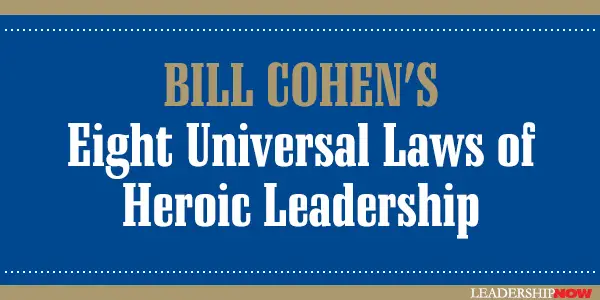
BILL COHEN says “Heroic leadership is special. It requires leading a group with absolute integrity while raising individual performance to a personal best and building a team spirit of sacrifice for the common good,” and adds, “heroic leadership requires tough standards.” Cohen correctly states in Heroic Leadership, that “we cannot lead on automatic.” It takes “considerable thought, intention, and action.” He believes that good leadership must be grounded in the following eight principles of heroic leadership:

Posted by Michael McKinney at 01:54 AM
11.02.10

Political Leadership and Compromise
ON ELECTION DAY our minds turn to political leadership. Men and women are elected with the expectation that they will honor commitments they have made to the voters. This often leads politicians to take a short-term view of almost everything. At the same time, plagued by reality, a politician (or any leader for that matter) may find that they have to change direction or offer a compromise. This leads to the “disconnect” we frequently have with political leaders. The problem facing politicians is that reality doesn’t sell. (And of course, we play a hand in that.) So frequently, what gets them into office is not the approach that will get the job done. It is a dilemma all leaders face. It’s a dilemma that requires a certain degree of wisdom. Prudent flexibility, adaptability, and compromise are necessary qualities for leadership. Yet we often hold in high esteem leaders who don’t back down more than those that compromise their position. No one wants to be viewed as weak. But a leader that will not change or even listen to the need for change can cause irreparable damage. It’s easy to get lulled into a sense of our own permanence. We must remember that leadership is temporary. It is a sacred trust that we hold for only a short time. The skill is in understanding what one can be flexible about and what one should not. We should never compromise principles, but approaches (even the proper understanding of how those principles are applied) may need to be adapted. Values and approaches are distinct from universal laws and principles and are derived from them. The former may change; the latter never does. The fact too remains, that we may be wrong, our perceptions might be faulty and our assumptions may be without foundation. When faced with the facts, we need to be able to change direction and chart a new course without losing sight of the ultimate goals. Stefan Stern recently wrote in an excellent post on knowing when to shift your position: “If you are heading full speed ahead for the rocks it is time to change direction….Good leaders adapt to changed circumstances, and admit it when they have made a mistake.” In the introduction to Profiles in Leadership—an excellent collection of essays on leadership—biographer Walter Isaacson shares a historical perspective on compromise: The greatest challenge of leadership is to know when to be flexible and pragmatic, on the one hand, and when it is, instead, a moment to stand firm on principle and clarity of vision. Even the best leaders get this wrong sometimes. I learned this when writing a biography of Franklin. His instinct was to try to balance the conflicting values that were at issue during moments of tough debate and to find common ground. At the Constitutional Convention, he was, at eighty-one, the elder statesman. During that hot summer of 1787, the rivalry between the big and little states almost tore the convention apart over whether the legislative branch should be proportioned by population or with equal votes per state. Finally, Franklin rose to make a motion on behalf of a compromise that would have a House proportioned by population and a Senate with equal votes per state. “When the table is to be made, and the edges of the planks do not fit, the artist takes little from both, and makes a good joint,” he said. “In like manner here, both sides must part with some of their demands.” His point was crucial for understanding the art of true political leadership: Compromisers may not make great heroes, but they do make great democracies. 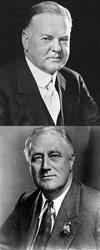 FDR on the other hand was not as well regarded and was mostly known for his connections and family background. “In the end, however,” writes Brinkley, “Herbert Hoover left the white house thoroughly discredited, repudiated, even hated, while Franklin Roosevelt was revered by much of the world when he died in office.” The difference was flexibility. Hoover was “A victim of his convictions, convictions that seemed to him close to absolute….Hoover’s unshakable principles shackled him time and again in his effort to deal with the Depression.” On the other hand, the quality that separated Roosevelt “most decisively from Hoover, was his pragmatic, experimental nature.” The contrast between Hoover and Roosevelt, Brinkley concludes, “suggests that leadership cannot succeed through ideals and strong convictions alone. The world is a complicated and ever-changing place, and a great leader must be capable of adapting to change and understanding the diversity of the ideas and principles that shape history.” Roosevelt was more successful in guiding the United States through the two greatest crises of the twentieth century, “in part because his values were appropriate to his time but also because he understood that values must reflect the realities of his age.” 
Posted by Michael McKinney at 10:21 AM
09.20.10

Do You Argue With Reality?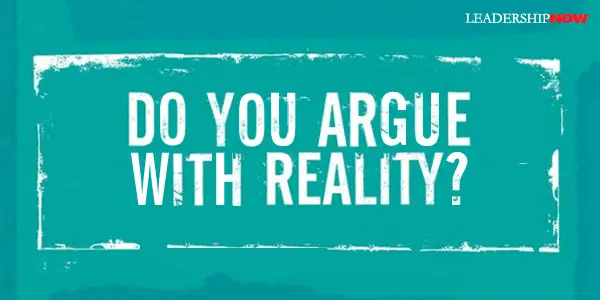
CHRIS THURMAN wrote in The Lies We Believe, “The number one cause of our unhappiness are the lies we believe in life.” Too often, we operate apart from reality. Given a choice between reality and our version of it, we are inclined to choose the latter. It is a central tendency of human beings. The result is drama, not peace. “Instead of getting the results we want,” says Cy Wakeman, “we end up with reasons, stories, and excuses for why things didn’t work out—leading to more drama, disengagement, judgment, and ineffective leadership.” In Reality-Based Leadership, Wakeman presents a much-needed wake-up call. We can ditch the drama by getting in touch with what is. Quit making up stories. Quit arguing with reality. Ditching the stories that are causing us stress. “We all tell ourselves stories and live with the resulting drama.” It sounds like:“I shouldn’t have to do this—it’s not part of my job description.
“You are arguing with reality whenever you judge your situation in terms of right and wrong instead of fearlessly confronting what is.” You need to respond to the facts, not the story you create about the facts. This is easier said than done. Interwoven in our stories are our egos, insecurities, and identities. (At one point Wakeman suggests we ask, “Who am I as a manager or as an employee when I believe this story?”) We like our stories. They make us look better. They place the blame somewhere south of us. If other people are always coming up short in our stories, then it’s all about us. But letting go of our stories is not always easy as we have a lot invested in them. Too often our criticism is about setting us apart from others and not about helping them. It says a lot more about us than it does those it is directed towards. Wakeman says, “When you are judging you are not leading.” In her analysis of the case study about Steve and a team he dreaded working with, she concludes, “his biggest obstacle is his belief that they are a negative group. What if he just dropped that whole story and simply responded to reality directly? The phone rings? Answer it. The team ask a question? Answer it, or teach them where to find the answer. The team share what worked in the past? Listen and lead them into the future. The team requests some time with the leader? Engage with them—lead! When Steve began to lead the team rather than judge and criticize, the team began to change for the better.” She adds, “When you focus your energy on what you are able to give And create rather than what you receive, you are truly serving.” Do you see any applications in what you and involved in? Wakeman insightfully writes: “What is missing from a situation is that which you are not giving.” Operating out of a judging mindset of “I know” or “I am right” effectively shuts down the potential to learn or accomplish anything. Moving on based in reality requires setting the story aside and asking, “If I set the story aside, what would I do to help?” The minute you start judging is the very minute you quit leading, serving and adding value. When you’re in judgment, you are dealing with your story—not with reality. Wakeman suggests that when you get off-track:
What stories are you telling yourself that cause you to operate in your own world? While it may be cognitively economical, it is costing you far more in every other area. 
Posted by Michael McKinney at 03:54 PM
09.17.10

The Reality-Based Leader’s Manifesto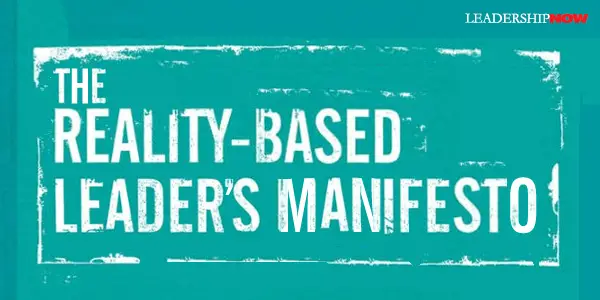 “If you believe that leadership is tougher today than it was in the past, you’re not alone,” writes Cy Wakeman, author of Reality-Based Leadership. “We are living and working in dramatic and demanding times, but that is not our biggest problem. The source of our pain is the absence of great leadership that is based in reality. …The future belongs to the leader who is able to change the way people think and perceive their circumstances, the leader who engages hearts and minds.” To that end, she offers the Reality-Based Leader’s Manifesto:
“If you believe that leadership is tougher today than it was in the past, you’re not alone,” writes Cy Wakeman, author of Reality-Based Leadership. “We are living and working in dramatic and demanding times, but that is not our biggest problem. The source of our pain is the absence of great leadership that is based in reality. …The future belongs to the leader who is able to change the way people think and perceive their circumstances, the leader who engages hearts and minds.” To that end, she offers the Reality-Based Leader’s Manifesto:

Posted by Michael McKinney at 07:07 PM
08.10.10

Ten Truths about Leadership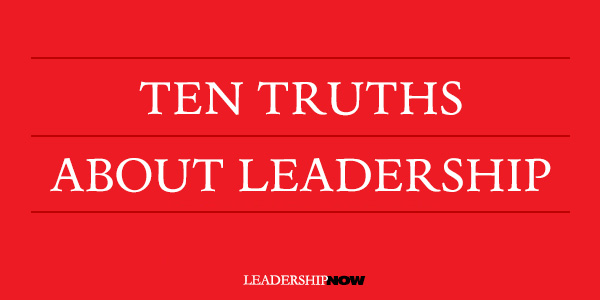
IN the last 30 years James Kouzes and Barry Posner, authors of the highly regarded leadership classic The Leadership Challenge, have studied leaders all over the world. They understand leadership. The question they get time and time again is “What’s new in leadership?” They answer that while the context of leadership as changed dramatically, “the content of leadership has not changed much at all. The fundamental behaviors, actions, and practices of leaders have remained essentially the same since we first began researching and writing about leadership over three decades ago. Much has changed, but there’s a whole lot more that’s stayed the same.” That is probably the fundamental truth of leadership development. With that understanding, we can develop leaders in all contexts and weed out fact from fiction.Based on thirty years of research—more than one million responses to their leadership assessment—Kouzes and Posner have gathered together in The Truth about Leadership, the ten truths that have stood the test of time and they hold true both globally and cross-generationally. They devote a chapter to each of these ten concepts: Truth #1 You Make a Difference. Before you lead you have to believe that you can have a positive impact on others. When you believe you can make a difference, you position yourself to hear the call to lead. Truth #2 Credibility Is the Foundation of Leadership. If people don’t believe in you, they won’t willingly follow you. You must do what you say you are going to do. This means being so clear about your beliefs that you can live them every day. Truth #3 Values Drive Commitment. You need to know what you believe in because you can only fully commit to the organization or cause when there is a good fit between what you value and the organization values. This is true too, for the people you lead. Truth #4 Focusing on the Future Sets Leaders Apart. You have to be forward looking; it’s the quality that most differentiates leaders from individual contributors. You need to spend time reflecting on the future. Big dreams that resonate with others inspire and energize. Truth #5 You Can’t Do It Alone. Leadership is a team sport, and you need to engage others in the cause. You need to enable others to be even better than they already are. Truth #6 Trust Rules. To enlist others, you need trust. Build mutual trust; you must trust others too. Truth #7 Challenge Is the Crucible of Greatness. Great achievements don’t happen when you keep things the same. Change invariably involves challenge, and challenge tests you. It introduces you to yourself. It brings you face-to-face with your level of commitment, your grittiness, and your values. It reveals your mindset about change. Truth #8 You Either Lead by Example or You Don’t Lead at All. You have to go first as a leader. That’s what it takes to get others to follow your lead. Truth #9 The Best Leaders Are the Best Learners. Learning is the master skill of leadership. Leaders are constant improvement fanatics. Truth #10 Leadership Is an Affair of the Heart. Leaders love what they’re doing and those they lead. Leaders make others feel great themselves and are gracious in showing their appreciation. These truths should form the basis of any leadership development program. Even more, they are the motivation behind the right kinds of behaviors that go into the formation of good and sustainable leadership. There are no shortages of problems and opportunities…. Leadership is not about telling others they ought to solve these problems. It’s about seeing a problem and accepting personal responsibility for doing something about it. And it’s about holding yourself accountable for the actions that you take. The next time you see a problem and say “Why doesn’t someone do something about this?” take a look in the mirror and say instead, “I’ll be the someone to do something about it.” 
Posted by Michael McKinney at 08:09 AM
07.16.10

5 Leadership Lessons: Joseph Nye on Leadership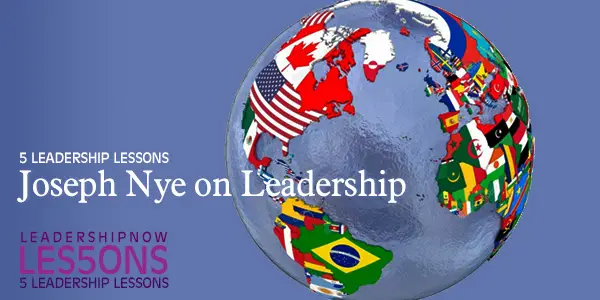
JOSEPH S. NYE is University Distinguished Service Professor at Harvard University's Kennedy School of Government. In The Powers to Lead, he relates leadership and power. He expands further on his concept of soft power—co-opting people rather than coercing them—and hard power—influence involving pressure or threats—but he shows how effective leadership in the real world requires a mixture of both. Hard and soft power are related because they are both aspects of the ability to achieve one’s purpose by affecting the behavior of others. They sometimes reinforce each other and sometimes they interfere with each other. The use of either one or the other depends on context. The ability to know which to use when is what he calls smart power. We need to know our context. He says, “Soft power is not good per se, and it is not always better than hard power. Nobody likes to feel manipulated, even by soft power. Like any form of power, it can be wielded for good or bad purposes, and these often vary with the eye of the beholder.” Here are five leadership lessons from The Powers to Lead:

Posted by Michael McKinney at 06:35 PM
06.07.10

John Wooden: It Takes a lot of Strength on the Inside to be Gentle on the Outside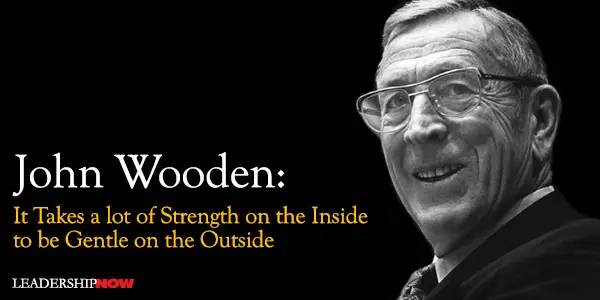
I FIRST MET John Wooden (October 14, 1910 – June 4, 2010) in the early eighties when working on a presentation product for his pyramid of success. He truly was a legendary teacher who based his life on sound principles. As with nearly everyone he came into contact with, he had a positive influence. Not surprisingly, his Dad, Joshua Wooden, took the time to lay a firm foundation for him. Upon his graduation from Centerton Grade School, his Dad gave him a card with seven suggestions to follow:
In his book, The Essential Wooden, John Wooden tells a story of his Dad’s leadership to illustrate the point that it takes a lot of strength on the inside to be gentle on the outside. It’s a good lesson for all of us: Scattered around the farmland where I grew up in Centerton, Indiana, were gravel pits. The county would pay local farmers to take a team of mules or horses into a pit and haul out loads of gravel for use on Morgan County roads. Some of the pits were deeper than others, and it would be tough for a team to pull a wagon filled with gravel out through the wet sand and up a steep incline. 
Posted by Michael McKinney at 12:50 PM
05.30.10

Why is the Essence of Leadership So Hard to Grasp?Why is the essence of leadership so hard to grasp? In The Leadership Illusion, authors Tony Hall and Karen Janman attribute it to the way in which we view leaders. We tend to over-emphasize character and underplay context. This gets to the heart of the leadership illusion: seeing leaders and leadership in one dimension. We ignore the context. When we evaluate the causes of the success or failure of leaders, we tend to “focus predominantly on the individual (sometimes the context), but very rarely both at the same time. The need to see someone as “fabulously successful or woefully inadequate” is strong. This causes us to underestimate the importance of context and connections when thinking about leaders and leadership. Leadership is not a solo performance.The leadership illusion also influences how we predict leaders and train for leadership. When examining what makes for successful leadership we search for personal attributes and tend to ignore their context and connections. This caused Harvard professor Richard Chait to refer to some leadership researchers as organizational meteorologists. “His view being that we have as much a chance of predicting whether it will rain or shine three weeks hence as we have of reliably finding ourselves a suitable leader.” They write, “There are some aspects, some attributes, of an individual that make them successful as a leader. But we need to evaluate the person and the context in order to be clearer about whether what we perceive is real or illusory.” Additionally, leaders should not be developed not in a vacuum but in the context within which they are to lead and in an environment that is fully supportive of that. “It doesn’t matter how effective a development technique may be in improving individual skills, if the organizational context is not supportive or consistent with the skills you have developed, the learning is likely to have little impact….There are far too many organizations that invest significant time and money in developing their people, but forget to develop or change the organization in tandem.” Do we develop strengths or weaknesses? “Our view is that you work on the skills and abilities that you need in order to perform effectively in your context….the end result being that development may encompass both strengths and weaknesses, as long as they are relevant to performance.” The demand placed on us by living in such a connected world, has lead Hall and Janman to the concept of network leadership. Relationships matter. Developing the right kind of social capital is an increasingly important function for effective leaders. What kind of social capital to develop is context dependent. Network leaders “bridge and they bond. They exhibit a balanced form of leadership that mixes the old with the new; combine radical approaches with received wisdom; and develop both breadth and depth of relationships.” Leaders are not independent entities. Leaders do not exist by themselves in organizational space, but are spatially extended (through their networks). In this way the concept “individual leader” loses its meaning. … The network thus becomes an irreducible element of physical description.
Posted by Michael McKinney at 08:00 AM
05.17.10

Serve to Lead: Make Your Life a Masterpiece of Service Everyone can be great because everyone can serve. You don’t have to have a college degree to serve. You don’t have to make your subject and your verb agree to serve…. You only need a heart full of grace, a soul generated by love.“Everyone can lead because everyone can serve,” says James Strock. “When service is the basis of leadership, everyone can be a leader.” What’s more, “We’re in a new era, with new rules, new ways to serve—and much greater accountability.” In a new edition, Serve to Lead 2.0 puts the focus of leadership where it should be. Too often, people think of leadership as being about the leader. A leader who serves has greater influence. Service—not control—leads to trust and increased influence. In an excellent chapter on management, Strock helps to place management and leadership in perspective and explains some of the nuances of tough love and accountability. “Management is encompassed within leadership.” As leaders, we must develop management skills. “Ultimately, management is a key to extraordinary service. Individual performance has the limitations of an individual. You may be a virtuoso. Yet, if you are determined to express your individuality in a more expansive way, you must develop management skills and engage others in a larger enterprise.Filled with examples and quotes, Serve to Lead 2.0 is well thought out and one of the best books you’ll read on how to think about service and how to get your leadership to be one of service. Strock urges us to make our life a masterpiece of service. It begins by asking the question—who am I serving—throughout our life, minute by minute, hour by hour, day by day. Importantly, it is not a question that we should apply to only one area of our life. It should be an approach we take in all areas of our life—our time, our money, our relationships, and thoughts. As an ongoing practice, he suggests we continually ask ourselves four questions: Who am I serving? How can I best serve? Am I making my unique contribution? Am I getting better every day? Service isn’t easy. It doesn’t always get noticed, but it is what leading is all about. If that is hard to swallow, you need to ask yourself, why do I want to lead? How many people are trapped in their everyday habits: part numb, part frightened, part indifferent? To have a better life we must keep choosing how we’re living.   
Posted by Michael McKinney at 01:42 PM
05.05.10

Are You Living Out Your Why?Reduced to a list of techniques, leadership is uninspiring. Leadership that is uninspiring is stagnant. Eventually it will need to be replaced because all involved are just going through the motions—doing time—atrophying. The leader is superfluous.Techniques help us to manage the function of leadership, but they are not the essence of leadership. Techniques don’t connect with people, passion does. Passion inspires because it comes from inside of us. Our passion is who we are. It’s authentic because, like leadership, it is something we live. It is our why. Inspiring leaders keep the why front and center by living it. You can not fake passion for long. Eventually it is undermined by the comments we make, the look on our face, and the way we treat others. When the eyes say one thing, and the tongue another, a practiced man relies on the language of the first.Watching someone live out a why is compelling. It makes people want to follow, connect and be engaged. It forms the basis of trust and the moral authority that is the spark of the leader/follower relationship. Leaders go first. John Adair wrote, “Gandhi and Mandela had acquired the right to demand what they had already given.” Their authority came from their example. A leader inspires best by example. And as John Baldoni once wrote in his book on leading by example, “It all starts with character.” Are you living out your why?
Posted by Michael McKinney at 11:08 AM
04.21.10

Mark Twain on Leadership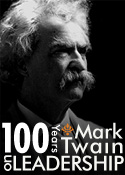 It could be said that he believed in Management By Wandering Around. In his autobiography he wrote, "In religion and politics people's beliefs and convictions are in almost every case gotten at second-hand, and without examination, from authorities who have not themselves examined the questions at issue but have taken them at second-hand from other non-examiners, whose opinions about them were not worth a brass farthing." Firsthand knowledge is a competitive advantage.
Posted by Michael McKinney at 07:07 AM
04.16.10

Does Your Leadership Have “White Space?”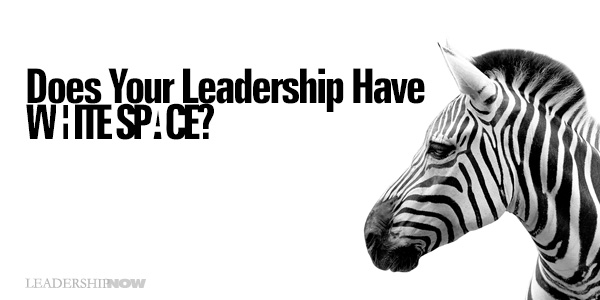
IIN THE VISUAL ARTS, white space is that area that is left blank or perhaps more accurately, open. It should not be thought of as unused space because it is actually an important part of the design itself. It is an “active” void. It adds to or enhances what the artist is trying to communicate. It clears away the clutter and allows the message to be heard.
Wendy Richmond is a visual artist, author, educator and a contributor to Communication Arts. In a recent column she discusses the need for white space in teaching art. She provides a wonderful example of the value of white space as applied in teaching and leadership: In my teaching, I use the idea of white space as a metaphor. When I develop a syllabus, I also design the activities for which I will not be present. On the first day of class, I tell my students, “By the end of this course, I hope to be the least important person in this room.” I believe that in addition to providing the content, my role is to create an environment that contains an active void. I need to disappear enough for my students to jump in and fill the learning environment with their own excitement and discovery. Again, as in my artwork, it takes confidence to leave that space empty. Creating white space in your leadership requires balance. Leadership is an art. White space doesn’t reflect a lack of leadership or structure as it might seem. On the contrary, strong leadership is what makes it possible. A leader has to shape that space in an ongoing way to ensure that they are allowing room for people to develop themselves, contribute and lead. The question is: do you as a leader have the confidence to do that?
Posted by Michael McKinney at 08:08 AM
02.26.10

Are Leaders Destined to Disappoint?Historian David Greenberg wrote in the Atlantic, “Americans have fallen, starry-eyed, for leaders who speak of a future unencumbered by history’s weight.” Intellectually we must know that this isn’t possible, yet is it too much to expect real change, fundamental change—a break from the past? It’s unsettling to think that we are only slaves to our past. Are we demanding too much?Greenberg continues, “Theodore Roosevelt’s New Nationalism, Woodrow Wilson’s New Freedom, FDR’s New Deal, JFK’s New Frontier, even George H. W. Bush’s New World Order—all began with the promise of the new. Of course, after the flush of a campaign, both voters and presidents have invariably discovered that history imposes constraints.” And we are left disappointed. Of course, this dynamic affects not only political leaders, but leaders everywhere. One always has to deal with what is (past and present) and the real level of desire (the crisis)—for transformational change to occur. Leadership is a creative act. A leader seeking transformational change needs to have three basic elements in place: clearly defined goals (the how), strong values with which to measure those goals (the why), and an environment that is urgent to change (an opportunity). Expectations create opportunities for leaders. The motivation from which springs the leader’s initiative is most often influenced by certain expectations on the part of the potential followers. Rosalynn Carter once said, “A leader takes people where they want to go. A great leader takes people where they don't necessarily want to go, but ought to be.” This suggests that a leader’s responsibility is to do more than just serve up our wants. As Insead’s dean J. Frank Brown said, “Leaders must learn to listen and question before they act.” We get the wrong kind of leaders when we place all of the responsibility of our expectations on their shoulders. In that environment we will always find individuals that are all too happy to pander to us and promise what they can never deliver in return for a title—placeholder leaders. Leadership is a shared responsibility. A great leader must elevate their followers and give them power and responsibility to act or they can never really lead them. Greenberg writes, “Twenty-five years ago, the political scientist Theodore Lowi published a book called The Personal President He concludes, “It is easy to propose that we lower our expectations for our new presidents—even, or perhaps especially, for presidents who come bearing lofty promises of transformation. But we can’t correct the problem, Lowi’s diagnosis suggested, simply by resolving to demand less from our chief executives or by vowing to learn from the past. The problem is rooted in nothing less than the presidency’s assumption of immense powers, and of a central role in our imagination. Candidates have no better path to victory than by inspiring us with dreams of a new political era, and presidents have no choice but to attempt “too much.” In doing so, however, they can only disappoint us.” Perhaps we aren’t demanding too much of our leaders, we are instead, demanding too little of ourselves. Can we separate ourselves from our “history” and act creatively for real change? Maybe we need a little less heroic leader and a little more heroic follower? It requires leadership at all levels.
Posted by Michael McKinney at 04:16 PM
02.12.10

Getting Naked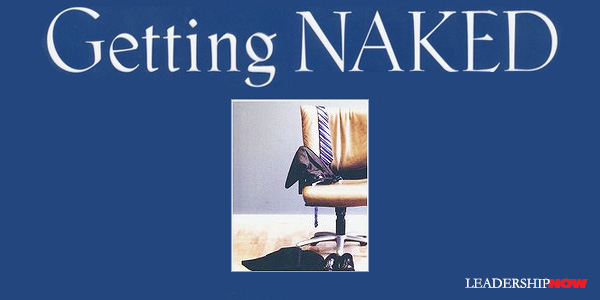
PATRICK LENCIONI has penned another solid business fable, Getting Naked and it's about vulnerability. The kind of vulnerability that comes from being completely open and honest with no sense of pretense or cover. He calls it getting naked. The story grows out of his experience in his consulting practice, The Table Group. They found that by being completely transparent and vulnerable with clients, they built levels of trust and loyalty that blew them away. Getting naked is not easy to do. It goes against the grain. It’s not comfortable. It involves shedding the three fears that sabotage client loyalty: Fear of Losing the Business - No service provider wants to lose clients or revenue. Interestingly, it is his very notion that prevents many service providers from having the difficult conversations that actually build greater loyalty and trust. Clients want to know that their service providers are more interested in helping them succeed in business than protecting their revenue source. To Overcome: Give Away the Business, Consult Instead of Sell, Tell the Kind Truth, Enter the Danger Fear of Being Embarrassed - This fear is rooted in pride. No one likes to publicly make mistakes, endure scrutiny or be embarrassed. Naked service providers are willing to ask questions and make suggestions even if those questions and suggestions turn out to be laughably wrong. Clients trust naked service providers because they know that they will not hold back their ideas, hide their mistakes, or edit themselves to save face. To Overcome: Ask Dumb Questions, Make Dumb Suggestions, Celebrate your Mistakes Fear of Being Inferior - Similar to the previous fear, this one is rooted in ego. Fear of being inferior is not about being intellectually wrong, it is about preserving social standing with the client. Naked service providers are able to overcome the need to feel important in the eyes of their client and basically do whatever a client needs to help the client improve. To Overcome: Honor the Client’s Work, Make Everything about the Client, Do the Dirty Work, Take a Bullet 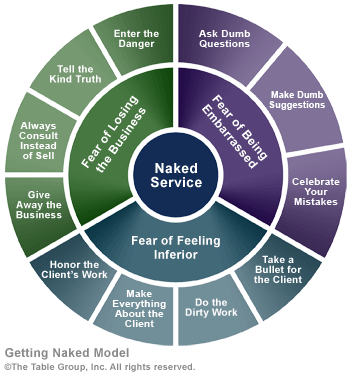 Why don't all service providers do this? Lencioni says, “On the surface the approach may sound soft or commonplace, but actually putting it into action can be downright scary. Getting naked is not for the faint-of-heart and those who employ this approach need to be prepared for the potential costs. Naked service providers leave themselves exposed to criticism and rejection, and may lose some business. However, once they prepare themselves for those situations, they find that they actually receive less criticism and are much better able to attract and retain clients. What is more, when they do lose a potential client due to their naked approach, they have no regrets because they realize that the relationship wouldn't have been a productive one anyway. “Not everyone is fit to be a naked service provider. It requires levels of self-esteem, humility, and courage that not all consultants are interested in having. However, anyone who is willing to set their ego and fear aside can practice the approach successfully. And they will benefit both in terms of the success of their business as well as experiencing growth in their personal lives.” Although this book is aimed at service providers it has wider applications and provides a general lesson for all leaders in any situation: We go a lot further if we demonstrate that we are more concerned about helping the people we lead, than we are in protecting ourselves. Stop trying so hard to be impressive. Just see where you can help. Great service makes a great impression. Getting Naked Resources on the Table Group website. 
Posted by Michael McKinney at 03:02 PM
02.10.10

Leaders Make Connections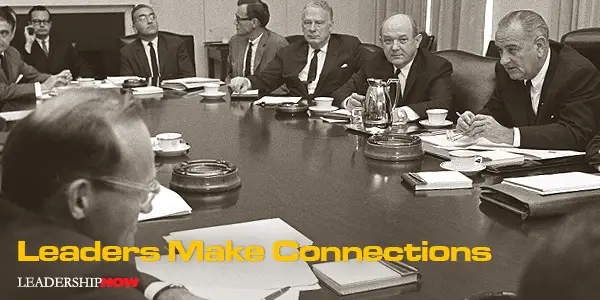
THE Financial Times ran an excellent analysis on February 3rd by Edward Luce concerning the very tight inner circle—just four people—that Mr. Obama relies on for advice. In America: A Fearsome Foursome, Luce advocates a broader circle of advisers and notes, “To be successful, presidents need to separate the stream of advice they get on policy from the stream of advice they get on politics.” Intellectually we know that we need to get their advice and information from a wide variety of sources. In practice, however, it doesn’t always happen. We like to talk to those with whom we are comfortable with and share our views. It’s very reassuring. But dangerous. Dangerous because it clouds our vision and makes us less agile. More importantly, seeking the opinions of others helps to make them feel a part of a larger purpose, connected to the leader and a part of a community. This points to a basic function of leadership: to make connections. 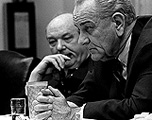 Treasury Secretary Henry Fowler, shrewd, effective, a superb negotiator, but somewhat shy of Lyndon Johnson, would occasionally feel in need of a presidential laying on of hands even when he had no serious presidential business. After one such occasion—it had ended with Fowler, sitting on the edge of the Oval Office loveseat, reading in monotone from his own memo on the floor in front of him, while the president was plucking yellow news tickers from the ticker machine at the opposite end of the Oval—LBJ turned on me, angrily: “What on earth did you bring him in here for, wasting my time ...” and so forth, but then stopped himself mid-sentence. “No, I’m wrong. Make me see him when he asks even if he has no real business! While you staff fellows are safe in the White House, these cabinet fellows are out there every day being shot at, on the Hill, in the papers, on TV. They are my field generals. Never forget that. They’ll be useless to me if they don’t feel connected to me. Always treat them with dignity.” A leader’s position is in the middle; to share and connect. In a world bent on differentiation, leaders must make connections.
Posted by Michael McKinney at 12:00 AM
12.02.09

Managers Can (and Should) Be Leaders
IT HAS BECOME commonplace to regard managers as inferior to leaders. Leaders are out front getting things done and managers are … what are they doing? This is, in part, due to our proclivity to label people as one or the other. Henry Mintzberg is the antidote to that kind of unproductive thinking. He writes in a book simply titled Managing: “we should be seeing managers as leaders and leadership as management practiced well.” While I have maintained that there is value in separating the functions of managers and leaders for the better understanding of both, in practice, they shouldn’t be two different people. Mintzberg believes that managing is a practice that is learned on the job through apprenticeship, mentorship, and direct experience. He has good cause to assert that we should be more concerned about “macroleading;” people that manage by remote control; too far above it all. “We are now overlead and undermanaged, he writes.” By obsessing over the glories of leadership, we lose our grasp on the realities of management. And our leadership is all the worse for it. “The more we obsess about leadership, the less we seem to get.” Managing is a valuable read. Mintzberg always makes you stop and think. He’s at his best when he’s leveling the playing field. As we’ve stressed on this blog before, leadership isn’t evolving. Leadership (and management) are a fundamental human activity. How they are practiced may change depending on the context, but their essence remains unchanged. Much of what we have to learn and relearn are fundamental principles regarding how people get along and work together. Managers deal with different issues as time moves forward, but not with different managing. The job does not change. We buy new gasoline all the time and new shirts from time to time; that does not mean that car engines and buttons have been changing. Despite the great fuss we make about change, the fact is that the basic aspects of human behavior—and what could be more basic than managing and leading?—remain rather stable.Mintzberg has distilled management thought into a general model of managing—what do managers do? They operate on three plains of activity, from the conceptual to the concrete: They act through information. They work through people. They manage action directly. And they need to operate on all three planes. “Too much leading can result in a job free of content…and detached from its internal roots.” A blending of all three planes into a dynamic balance is required and is best learned on the job. “No simulation I have ever seen in a classroom … comes remotely close to replicating the job itself,” says Mintzberg. He playfully addresses the conundrums of managing like: How to keep informed when managing by its own nature removes the manager from the very things being managed? How to delegate when they are better informed than the people to whom they have to delegate? How to maintain a sufficient level of confidence without crossing over into arrogance? How to bring order to the work of others when the work of managing is itself disorderly? And how do you do all these things at once? Managers are flawed. “If you want to uncover someone’s flaws, marry them or else work for them. Their flaws will quickly become apparent. So will something else: that you can usually live with these flaws. Managers and marriages do succeed. The world, as a consequence, continues to unfold in its inimitably imperfect way.” [He adds in the notes: “Not always. Politicians seem to become particularly adept at hiding flaws during elections until they become fatal in office.”] We are successful to the extent that our weaknesses are not fatal relative to the situation we are in. Commitment is the key; commitment “to the job, the people, and the purpose, to be sure, but also to the organization, and beyond that, in a responsible way, to related communities in society.” He concludes, “To be a successful manager, let alone—dare I say—a great leader, maybe you don’t have to be wonderful so much as more or less emotionally healthy and clearheaded.” No institution can possibly survive if it needs geniuses or supermen to manage it. It must be organized in such a way as to be able to get along under a leadership composed of average human beings.”That’s good news!   
Posted by Michael McKinney at 01:43 PM
11.20.09

Lead Your Boss
A CAN-DO PERSON himself, Theodore Roosevelt once advised, “Do what you can, with what you have, where you are.” Roosevelt’s admonition is easier said than done. Most of us are not in a position to implement sweeping change by the wave of our hand. And some of us are in a counterproductive culture where sticking your head up is a good way to get it knocked off. But we can learn to do what we can, with what we have, from where we are.It means that we must learn the art of leading from the middle—from among rather than from in front. And if we are honest, in most contexts, we find ourselves leading from the middle. (CEOs included) We are trying to influence the people around us, above us and below us. So learning to appropriately and effectively lead in this way, will impact our success in most areas of life. John Baldoni has written a primer on leading from the middle with Lead Your Boss: The Subtle Art of Managing Up. What I appreciate about his writing is that it is down-to-earth, nuts-and-bolts, and easy to connect with. He is aware of the fact that it is not easy and can be fraught with peril. He writes, Those who lead from the middle are those who think big picture and can do what it takes to get things done so their bosses and their teams succeed….Those who succeed at leading from the middle also are artful and adept managers. Baldoni says that leading up begins with answering three questions: 1. What does the leader need?
As he suggests, this is a selfless act that speaks to the heart of leadership. It requires people who can think for themselves and take the initiative to make things happen. Answering the three questions, taking the initiative and making it happen is the trick and is the focus of the rest of the book. Lead Your Boss walks you through every critical step of leading up. It provides instruction for overcoming those inevitable obstacles and you’ll find tips and strategies for:
Leading up is not a solitary job. “Leading up requires the ability to develop the talents of others; this is important for two reasons,” writes Baldoni. “One, you need to demonstrate that you know how to lead others; and two, putting others into leadership positions gives you the time you need to think and act strategically, that is, to lead your boss and your team more effectively.” Below is a two and a half minute video that provides a good overview of the book by author John Baldoni: 
Posted by Michael McKinney at 03:26 PM
11.19.09

Changing Generational Expectations on Leadership
EARLIER this year La Piana Consulting issued a report as a part of their NonprofitNext Initiative, that explores the key trends shaping the future of the social sector. They identify five trends: Demographic Shifts Redefine Participation, Technological Advances Abound, Networks Enable Work to Be Organized in New Ways, Interest in Civic Engagement and Volunteerism Is Rising, and Sector Boundaries Are Blurring. The report states, “In this changing environment, transformation is not optional. The future will demand a collective rethinking of what it means to be an organization, how individuals define their work and how best to both compete and partner across many permeable boundaries.” Looking at the first trend, Demographic Shifts Redefine Participation, we see that as younger generations begin to dominate the workforce, they bring with them different values, expectations and the place of technology in achieving results. This of course, changes how they define participation. La Piana Consulting rightly asserts that “The challenge is not so much the wholesale changing of the guard that was feared, but the need to figure out how the generations can work together effectively now and in the future…. There are significant distinctions in how younger generations value, approach, and leverage engagement, transparency, technology, professional development, and work-life balance. These differences will have to be negotiated.” More foundationally, it changes how we approach leadership, the organizational culture and structure. How will working across generations change the way you do work? Church consultant Cynthia Ware, wrote on her blog >The Digital Sanctuary, that this means more team participation and leadership “sharing.” This almost always gets interpreted as leaderless or a kind of a feel-good, rudderless “hot-tub” leadership that is not heavy on results. Top-down leadership is not necessarily bad leadership but is often executed poorly. It is most often associated with command and control, which is something else. Authority comes with responsibility but is most effective when used sparingly. Ware eloquently clarifies the issue: “Top-down” leadership is not always controlling - yet it is usually perceived as such - which is reflected in the trend. In fact, headship, if functioning correctly, releases rather than restricts, empowers rather than dominates, etc. For each generation—old and new—this will require learning a new perspective on what it means to share leadership. It’s healthy. If leaders stop learning they stop leading.
Posted by Michael McKinney at 11:35 AM
11.12.09

The Seven Deadly Sins of LeadershipPeter Drucker never wrote a book about leadership, but his thoughts about it are sprinkled throughout his 40 books and hundreds of articles. Bill Cohen has extracted these ideas and presented them in Drucker on Leadership.To Drucker, leadership was a calling and he set very high ethical standards for those that chose to lead. Character traps like losing sight of why you are leading, selfishness and the abuse of power often derails leaders. Drucker hoped, writes Cohen, “that by making these traps explicit he could help leaders avoid falling into them.” Cohen gathered Drucker’s thoughts about these shortcomings together and categorized them as the seven deadly sins of leadership: The Leadership Sin of Pride. “The sin of pride is usually considered the most serious of the seven deadly sins.” Being proud of one’s accomplishments is one thing. “The problem comes when leaders believe themselves so special that ordinary rules no longer apply. Generalized pride—as opposed to being proud of specific things—is the most serious leadership sin because it can easily lead to the other six.” The Leadership Sin of Lust. “There is unfortunately a feeling among some leaders that they have ‘arrived’ and are ‘entitled’; sex is seen as some sort of fringe leadership benefit….In any workplace, it creates jealousies, feelings of favoritism, and lack of trust, damaging people and relationships and more….Drucker thought that leaders did not pay enough attention to avoiding this particular deadly sin, and thought that leaders could do a better job of avoiding problems that affected their ability to lead.” The Leadership Sin of Greed. “The sin of greed is a sin of excess. It frequently starts with power. Leaders have power, and unfortunately having power has a tendency to lead to corruption if the leader isn’t careful. This may start with the acceptance of small favors and grow into accumulating vacations, bribes, or worse.” The Leadership Sin of Sloth. “For the leader, the sin of sloth is associated with an unwillingness to act. More often, it is an unwillingness to do work the leader considers beneath the dignity of the office.” The Leadership Sin of Wrath. “This sin has to do with uncontrolled anger. There is a time for anger in leadership when it serves a definite and useful purpose….Drucker taught leaders to analyse their environment and to determine what actions that had already occurred, meant for the future before taking action. Using anger as a single response to all leadership challenges precludes doing this analysis.” The Leadership Sin of Envy. “With the sin of envy, the leader is envious of what is enjoyed by someone else.” This may cause a leader to “attempt to destroy another’s reputation, or in other ways attempt to feel better by lowering the status of another.” The Leadership Sin of Gluttony. Of all the deadly sins, gluttony is the one that most frustrated Drucker. We typically associate gluttony with food, but it applies to excessive consumption of any kind. “Drucker did not win many friends among high executives with his injunction about too high salaries….It’s easy to rationalize—and a status issue. However, there was no question in Drucker’s mind but that executive hypercompensation was an accurate example of the sin of gluttony and was to be avoided for good leadership.”
Posted by Michael McKinney at 04:35 PM
11.11.09

Eisenhower: No Born LeadersThe one quality that can be developed by studious reflection and practice is leadership.In contrast to George S. Patton Jr., who felt himself born to lead men into desperate battle and who believed that all great leaders are leaders by virtue of their destiny, Dwight Eisenhower thought that leadership could be acquired, learned through “studious reflection and practice.” When his son, a West Point Cadet, expressed disappointment at having been promoted to ordinary cadet sergeant rather than given the distinction of promotion to color sergeant, Ike replied that it did “not indicate that you are lacking in the qualities of leadership” and explained that these qualities could be acquired. He went on to demystify leadership, telling his son that it was nothing more than the ability to “get people working together, not only because you tell them to do so and enforce your orders but because they instinctively want to do it for you…. You do not need to be a glad-hander nor a salesman, but your men must trust you and instinctively wish you to win your approbation and to avoid things that call upon you for correction.” Adapted from Eisenhower on Leadership by Alan Axelrod. Of Related Interest:
Posted by Michael McKinney at 07:52 AM
10.28.09

What is the Real Work of Leading?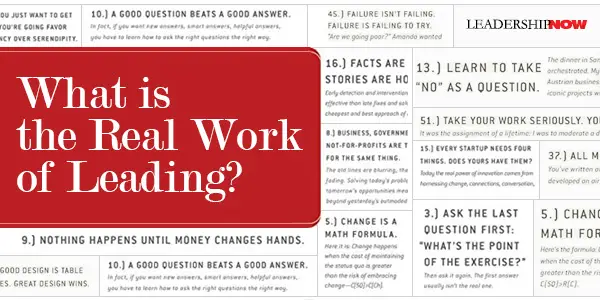 I WOULD HOPE by now you have had a chance to read through Fast Company co-founder Alan Webber’s Rules of Thumb. He has compiled 52 practical and wise fundamentals of life well lived and work well done.
I WOULD HOPE by now you have had a chance to read through Fast Company co-founder Alan Webber’s Rules of Thumb. He has compiled 52 practical and wise fundamentals of life well lived and work well done.
For a taste, consider Rule #41: If you want to be a real leader, first get real about leadership. Getting real about leadership involves four things: how leaders are, what leaders do, how leaders act, and what leaders leave behind them. How Leaders Are. Leaders are both confident and modest, they’re authentic and they are good listeners. He quotes Ron Heifetz, “Too many leaders die with their mouths open.” He adds, “Leaders who need to talk all the time create companies where people simply stop listening.” What Leaders Do. Leaders are coaches. They attract and grow talent. They lead by example. Maintaining high standards themselves, they challenge people to do their best work. “After a real leader has moved on, the people who worked for him or her always say, ‘I learned more and did more than I ever thought I could.’” How Leaders Act. Real leaders guide. They don’t dictate. “Real leaders create an agenda, offer criteria, and describe a strategy to take the company ahead.” And they learn from their mistakes. What Leaders Leave Behind. Leaders leave behind “a passion for the business, a love of the company, and the commitment to leave it healthier and stronger than he or she found it.” They leave a team of great leaders. They articulate sound values and instill them into the culture of the business. And perhaps most importantly, they make more leaders. “The real leader is the one who makes more leaders at all levels of the organization. Leaders practice leadership to cultivate more leaders.” 
Posted by Michael McKinney at 08:59 PM
09.16.09

The Application of Love LeadershipI wanted to share with you an excerpt from John Hope Bryant’s book Love Leadership. The subtitle – The New Way to Lead in a Fear-Based World – says it all. Bryant is the founder of Operation HOPE, a non-profit provider of economic tools and services that has as its long range objective to literally “drive itself out of business.”Bryant says we have “lost our story line;” too focused on the me instead of the we, we have become indifferent. He describes the opportunity to lead he found, this way: In inner cities today, you’ll often find a liquor store right next to a check casher, next to a pawn shop, next to a rent-to-own store, next to a payday lender. If misery loves company, then this is a pile-on. There’s simply a super-abundance of predatory businesses, and many people have lost hope. They are poor in spirit: they’re not skeptical—they’re cynical; they have low self-esteem and negative role models; their get-up-and-go has got up and went. So they go to the check-cashing service to forfeit their today, and go to the payday lender to forfeit their tomorrow. And because they don’t believe they’ll have a tomorrow, they go to the liquor store to forget about their yesterday.
Posted by Michael McKinney at 07:34 PM
09.07.09

What Is Your Platform?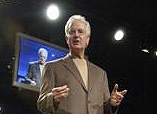 He lists seven practical ways you can invest your life in the lives of others:
Dale Murphy (Major League Baseball All-Star and founder of I Won't Cheat Foundation) is a sports celebrity who seeks to leverage his achievements on the playing field into a positive influence on the lives of others, especially young people. People in the sports world who are conscious of their influence often speak of their “platform.” In the literal sense, a platform is an elevated stage from which a person can speak and be heard by the crowd below. A sports celebrity has a platform of fame, which he or she can use to influence fans, young people and society at large.
Posted by Michael McKinney at 09:50 AM
08.28.09

IBM's Robert Sampson on Values-Based LeadershipRobert Sampson, general manager of Global Public Sector at IBM, delivered a speech to the Industrial College of the Armed Forces, on the power of values to change the world. He says, “Technologies, no matter how game-changing they are, come and go. What really matters in industry and in government is individual character.”Sampson relates the story of an IBM computer scientist named Arun Hampapur who was driven to enhance the value derived from surveillance systems, to illustrate the value of creating a culture in which people seek to innovate not just for the sake of innovation, but to apply themselves to the kind of innovation that changes society: Arun Hampapur began studying the video surveillance systems in New York and Chicago. As Arun saw it, these systems had an inherent problem: They could ingest data, but they could not react to real-world incidents in a timely way. You could only respond to a criminal event once it already happened. That wasn’t good enough for Arun.
Posted by Michael McKinney at 01:16 AM
08.24.09

A Leader Builds CommunityIt’s easy to lead the people who think you can do no wrong. It’s easy too, to get taken in by their flattery. But a leader is responsible for everyone they lead – their core supporters and those at the fringe that may have their doubts. A leader builds community. A leader is inclusive.In Driving Results Through Social Networks, Cross and Thomas report that “high performers tend to occupy network positions that bridge otherwise disconnected clusters of people.” As a result they can seize the opportunities found in the “white space” between subgroups. A diversity of voices is essential to a leader. It is not uncommon to find that your most crucial collaborators are not commonly categorized as the high performers and regarded as "in-sync" with you. Instead, we have all seen that these highly valuable people, often found on the fringes, play an important role in making the high performers successful. A leader must be able to motivate these potential partners to join with them as well. Jagdish Sheth, a chaired professor of marketing at Emory’s Goizueta Business School notes, “One big mistake is when the new leader rewards the people who supported him on the way up, while phasing out the people who did not. Instead, a CEO must realize that he or she is the leader of the company, not a clique, just as the president of the U.S. leads the nation, not just the Democrats or the Republicans.” Where there is leadership, there is a sense of community.
Posted by Michael McKinney at 08:00 AM
05.22.09

The 14 Questions Every Board Member Needs to Ask
THE question of who’s running the organization is a critical one in this economic environment. Many boards are being asked to do what they were never prepared to do. The challenges and pressures are immense. In a critically important book for directors—Owning Up—world-renowned adviser Ram Charan says the economic downturn is a wake-up call to corporate boards. “Boards need to own up to their own accountability for the performance of the corporation.” Increasingly, "governance now means leadership, not just over-the-shoulder monitoring and passive approvals. Boards must fiercely guard their companies against the threats of rapid decline and sudden demise, while at the same time helping management seize the opportunities that tumultuous change presents but are hard to see in the daily fray of running the business. The board that does both turns governance into a competitive advantage." And all of this without micromanaging. It’s quite a balancing act. [Charan: “Asking questions of an operating nature is not in itself micromanaging, as long as the questions lead to insights about issues like strategy, performance, major investment decisions, key personnel, the choice of goals, or risk assessment.” Why and how is key.] Charan offers fourteen questions that “get to the heart of the unique issues that boards are facing now.” I think the questions are as insightful and provide as much food for thought as the answers they might evoke: Question 1: Is the Composition of the Board Right for the Challenge?
In good times, not enough consideration has been given to question one. Does the board have enough depth of knowledge or experience to ensure the organization stays on track? “Directors as a group must have the specific skills and perspectives needed to carry out their responsibilities.” And these skills must evolve with the times. “If the composition of the board is not appropriate, it is the failure if the [governance] committee. The board must empower the committee to actively shape the board composition.” Bad directors drive out good directors. It’s time for a check-up. Charan’s questions help boards do just that. Additionally, while squarely aimed at directors, Charan’s questions serve a wider audience of leader’s as well. The questions speak to any leader of the need to “own up” to the responsibilities found in their own context. Are we up to the challenge in the area we have chosen to lead? Are we dealing with the issues? Are we trying to identify the issues early and get ahead of them? Are we learning so that we are better able to perform? Are we aware of our impact? All of these questions speak to the need for personal accountability. Addressing Charan’s questions is the way forward. 
Posted by Michael McKinney at 10:03 AM
05.21.09

Three Questions Every Leader Should AskRobin Ryde explains in Custom-Built Leadership that there are three questions that will bring clarity to your leadership mandate. They will provide “a personal manifesto for how you will lead. They open up and provide entry to a place where your priorities, personal preferences and ambitions can be properly examined.”How Long Have I Got? This is a question not just about tenure, but the legacy you wish to leave. This will help you to determine your priorities. Your time frame will determine your pace and help you to determine what skills and resources will be of the greatest value to you. How Grand Is My Plan? This question has to do with your ambition and encompasses three key considerations: your appetite for taking on varying degrees of ambition, your freedom to operate, and your inheritance (it’s rare that we inherit positions of leadership as a clean slate). Timing will certainly affect your level of ambition. How Broadly Will I Lead? As a leader you will certainly operate within a system. The question is how far will you travel into the domains that affect your issues that stand outside your formal locus of influence. Ryde pragmatically discusses each of these questions and candidly describes the rewards and pitfalls of the kinds of decisions we make. This book is an important read for anyone taking on a new leadership task or looking to recalibrate the task they are currently in. Ryde writes, “A long-term leadership strategy requires a very different approach to a short-term campaign. Leadership on a grand scale calls upon a different set of skills to a business-as-usual plan. Leaders who wish to influence a broad range of people and institutions need to develop different qualities to those with a narrower engagement plan.”
Posted by Michael McKinney at 01:56 AM
05.06.09

Ten Leadership Skills You Need For An Uncertain World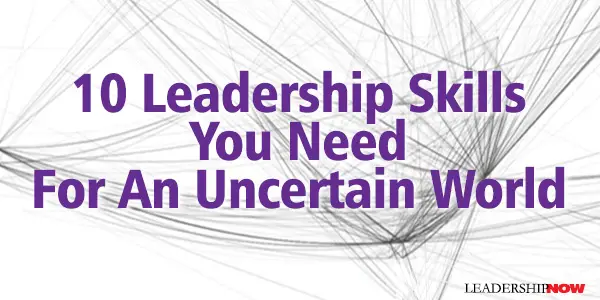
UNCERTAINTY is a part of life. Uncertainty is a call for leadership. Creating clarity from uncertainty is a leader’s stock in trade. Unquestionably some periods of time are more demanding than others. Times like these call on leaders to take a broader view of who and why they are leading and the impact they are having on the world around them. While this is very demanding for any leader, it is also more meaningful. In Leaders Make the Future, futurist Bob Johansen reports that volatility, uncertainty, complexity and ambiguity will only get worse in the future. “Solvable problems will still abound, but top leaders will deal mostly with dilemmas which have no solutions, yet leaders will have to make decisions anyway.” Johansen emphasizes ten leadership skills that will help leaders to cope and thrive in the volatile decade ahead. “We need not passively accept the future. Leaders can and must make a better future.” Although it’s “hard to even think about the future if you are overwhelmed by the present … looking to distant possibilities can provide new insight for the present.” The ten skills he lays out move from the instinctual to the complex and build on each other. Here is a summary of Johansen’s work for you to think on:1. Maker Instinct: The ability to exploit your inner drive to build and grow things, as well as connect with others in the making. Future leaders will need both a can-do and a can-make spirit. The maker instinct is what separates the leaders from the powerless. 2. Clarity: The ability to see through messes and contradictions to a future that others cannot see. Leaders are very clear about what they are making, but very flexible about how it gets made. How can you as a leader, create and communicate with clarity in confusing times – without being simplistic? 3. Dilemma Flipping: The ability to turn dilemmas – which, unlike problems, cannot be solved – into advantages and opportunities. We must be able to nurture the ability to engage with hopelessness, learn how to wade through it to the other side, and flip it in a more positive direction. Think Roger Martin’s concept of the “opposable mind.” How can you remake a situation with no solution? 4. Immersive Learning Ability: The ability to immerse yourself in unfamiliar environments; to learn from them in a first-person way. Immersive learning requires active attention, the ability to listen and filter, and to see patterns while staying centered – even when overwhelmed with stimuli. Leaders can’t absorb everything, so they must filter out extraneous information and learn how to recognize patterns as they are emerging. 5. Bio-Empathy: The ability to see things from nature’s point of view; to understand, respect, and learn from nature’s patterns. It is big-picture thinking that respects all the multiple interrelated parts and nonlinear relationships, as well as cycles of change. 6. Constructive Depolarizing: The ability to calm tense situations where differences dominate and communication has broken down – and bring people from divergent cultures toward constructive engagement. The next decade will be characterized by diversity and polarization. The temptation is to pick sides, but that is rarely a good strategy. 7. Quiet Transparency: The ability to be open and authentic about what matters to you – without advertising yourself. This begins with humility. Leaders who advertise themselves and take credit for their own performances will become targets. Are you self-promoting? 8. Rapid Prototyping: The ability to create quick early versions of innovations, with the expectation that later success will require early failures. Fail early, fail often, and fail cheaply. Accept failures as important ingredients to success and learn from them. 9. Smart Mob Organizing: The ability to create, engage with, and nurture purposeful business or social change networks through intelligent use of electronic and other media. Leaders are what they can organize. Can you organize smart mobs using a range of media? 10. Commons Creating: The ability to seed, nurture, and grow shared assets that can benefit other players – and sometimes allow competition at a higher level. Can you create commons within which both cooperation and competition may occur? 
Posted by Michael McKinney at 09:30 AM
04.20.09

How to Hit the Ground Running
STAKES are high. Whether you are just starting out, trying something new, or just starting each day with the understanding that you need to be putting your best foot forward, you need to know how to get up to speed, make the right decisions, and produce the right results fast. You need to hit the ground running. If you could sit and learn from some of America’s best CEOs, you could discover the right steps to take to ensure your success while avoiding many of the pitfalls that come from learning from one’s own experience. In Hit the Ground Running, Jason Jennings has made that possible. He has selected ten CEOs that created more economic value for their companies than all of the other CEOs of America’s top one thousand companies during the study period. They made the decisions that allowed them to achieve great results on issues we can all relate to by adhering to, sometimes, counterintuitive principles. From interviews and observation, Jennings has compiled these principles into ten lessons from each of these CEOs that if applied, will help you to hit the ground running. Rule 1: Don’t Deceive Yourself—You Will Reap What You Sow Let the Golden Rule guide every decision. Richard Smucker says, “In matters of style, swim with the current but in matters of principle, stand like a rock.” Rule 2: Gain Belief Leaders gain belief by being authentic and humble, getting rid of regal trappings, proving their worthiness, asking others for belief, and surrounding themselves with others who are also trusted. "I need everyone to respect and support one another and work with each other. Everything else is B.S." says Fred Eppinger of the Hanover Group. Rule 3: Ask for Help Howard Lance CEO of Harris Corporation “has a keen sense of humor and doesn’t have a problem generating a laugh even at his own expense.” He says, “Sometimes you have to take the veneer and let people see you for who you really are and share a chuckle or two.” To “hit the ground running" requires that you admit that you don’t have all the answers and engaged the assistance of others when assuming new duties. Rule 4: Find, Keep, and Grow the Right People Ronald Sargent’s strategy at Staples is to promote from within, move people around, identify rising stars, make everyone an owner, communicate with your workers and make diversity your priority. Promoting from within “creates a career culture that encourages people to stay longer and stretch their skills.” Rule 5: See Through the Fog Pat Hassey, CEO of Allegheny Technologies told Jennings, “It’s the job of the CEO to see through the fog and to be a destination expert. People want to know where the company is headed, what their future holds, the opportunities that exist for them, and what their role is going to be. And they don’t want to wait forever to find those things out.” (See page 97 for Hassey’s well-thought-out Team Rules that all team members have to agree to part of a Hassey-led team.) Rule 6: Drive a Stake in the Ground Jennings writes, "Driving stakes into the ground allows a leader to provide a clear vision about what the company is, where it’s headed, and how it’s going to get there so it can hit the ground running. But it isn’t for the faint of heart. Once you’ve driven a stake in the ground you have to talk about it and promote it relentlessly.” Mike McCallister, CEO of Humana, says, “The problem with most businesses is that instead of driving a stake in the ground, they stick a toe in the water and when it gets hard or boring they start thinking about it too much, begin questioning their decision and pull their toe out, changing things, and starting all over again.” Rule 7: Simplify Everything "Oversimplify everything! Sit down and ask, `If I could start with a blank sheet of paper today and create the best answer, what would I do?'" says Jeff Lorberbaum, CEO of Mohawk Industries. Rule 8: Be Accountable “Setting a personal example of accountability is where many leaders fall short,” writes Jennings. “Instead of starting by being accountable themselves, they use the threat of accountability as a tool to drive others.” Rule 9: Cultivate a Fierce Sense of Urgency Keith Rattie, CEO of Questar says, “You must have a sense of urgency—if one doesn’t exist, the CEO’s job is to create one. The mindset needs to be ‘We’re not as good as we know we have to be.’” Rattie adds that it will be time for him to leave when he loses the “sense of urgency and the belief that we have to be better tomorrow than we are today… it’ll be time to get somebody else in the chair who will bring a new pair of eyes and fresh thinking to the job.” >Rule 10: Be a Fish Out of Water The CEOs interviewed don’t fit the typical picture of what a CEO should be. They have been described as “humble, authentic, accessible, highly ethical, compassionate listeners and truly, believable committed to doing the right thing for all stakeholders.” Jennings skillfully weaves the thoughts from these business leaders into coherent and practical lessons. You will find all kinds of great advice in this book, much of it delivered in an almost off-the-cuff manner that belies its value. But it makes this insightful and crisply written book great reading. 
Posted by Michael McKinney at 11:09 PM

More Useful Ideas from Hit the Ground Running by Jason Jennings
THESE quotes are from Hit the Ground Running: A Manual for New Leaders by Jason Jennings. Ronald Sargent CEO of Staples, warns, “I think a leader has to do something big, new, and different within the first one hundred days and make sure that it’s properly communicated to everyone. If people don’t know what’s going on, they’ll assume nothing is going on.” “The three most important observations I made early on in my career,” says Pat Hassey of ATI, “were that most people are loyal and want to do a good job and be successful, that offering a sincere thank you goes a long way, and that a soft response is always better than a harsh one.” Hassey also remarked, “I promised I’d never let myself get into a position where I’d stop growing. Everybody has a question, an idea, and an opinion, and if you take the time to listen, you’ll end up with a better business. There’s no such thing as a dumb question or idea.” Mike McCallister, CEO of Humana: "We try to treat all of our people like they are adults, which sounds like straightforward common sense, but it's amazing how many businesses don't." Goodrich CEO Marshall Larson: “The one thing I did know is that if all leaders in the company thought like me and acted like me, we’d end up with groupthink and make on hell of a big mistake someday and march off the side of the cliff like lemmings.” Goodrich CEO Marshall Larson: "Any CEO who thinks he can pull all the strings that make things happen is kidding himself.” 
Posted by Michael McKinney at 11:08 PM
03.09.09

Strategic Presence: The Power that Fuels LeadershipTony Jeary, author of Strategic Acceleration: Succeed at the Speed of Life, is a coach to some of the world's top CEOs. In his book he brings together practical ideas to help you get out of your own way. A critical aspect of getting things done through others is presence – your presence. To influence others you need to know how they perceive you and adjust your communication with them accordingly. Here, Tony discusses what he calls strategic presence:The goal of leadership is to produce superior results on purpose and that makes leadership a results contest. The challenge of leadership is to persuade and motivate those they lead to produce the results they want. When people voluntarily and enthusiastically do what their leaders ask them to do and the desired results are achieved, leaders are considered to be effective and successful! The question is how do leaders really get others to voluntarily and enthusiastically produce the desired results? There are many parts to this puzzle, but there is none greater than a condition I describe as Strategic Presence. Here is a great story that illustrates Strategic Presence and also illuminates its effect. A student from a foreign country was enrolled in the middle of a school year. During the first day of class, the other kids in the class were doing what kids do. There was a lot of giggling and staring and posturing for the new arrival. The new student was dressed in a way that did not meet the expectations of a few of the other children and eventually one of them (the class clown) began to make jokes about the new student's appearance. As the scene was progressing toward chaos, the teacher was about to intervene when a girl stood up and told everyone to stop picking on their new classmate. The girl reminded them that it was scary to be new in a school and they needed to be kind to the student and make them feel welcome She reminded them they should treat this new person as they would want to be treated if they were in a new country and a new school. After class, the teacher called the girl aside and said, "That was a very brave thing you did. Why did you do that?" The girl replied, "Because that is what my Mom and Dad would expect me to do!" This story powerfully illustrates the essence and the effect of what I call Strategic Presence. The girl had merely done what she knew her parents would want her to do. Her parents had succeeded in creating a positive presence in her mind, which gave her the willingness and courage to do what she did. Most importantly, the presence of her parents was so authentic that they did not have to be physically present to inspire their daughter's good behavior. Leaders create impressions that exist in the mind of every person they lead. It is a presence that defines the perceptions people have of their leaders and what they believe about them. It is this overall persona that I am referring to when I use the term Strategic Presence and there are two types: Positive and Negative. Leaders are constantly creating and presenting images of influence that produce both. The most important fact about Strategic Presence is that it produces two possible reactions in others. It either produces voluntary cooperation or it produces various forms of resistance. If leaders generate positive Strategic Presence, people will be more likely to support what they want, most of the time. However, if perceptions of leadership are negative people will substitute resistance for cooperation. The possibilities of how people will respond to Strategic Presence are limited to cooperation or resistance. There is not much middle ground between them. As someone once said, "you are either for us against us!" It is easy to see why creating an authentic, positive strategic presence is critical for the execution of a vision. Creating positive Strategic Presence is not a strategy of manipulation. The positive strategic presence leaders project must be authentic. Failing the test of authenticity means the very image leadership hopes to establish will be perceived as deceptive and disingenuous, or worse. People are very perceptive and they will see through efforts to project a phony persona for the purposes of manipulating their behavior. So, why shouldn't a leader's strategic presence just be allowed to be what it is?" That is a great question and the answer is simple. Many leaders are misunderstood and create perceptions that really don't match their intent. So, understanding how Strategic Presence is created will minimize the possibility of being misunderstood. So, how is strategic presence is created? What are the things about leadership that speaks the loudest about it? What creates the perceptions that combine to produce Strategic Presence? There are two components that contribute to strategic presence: values and behavior. Our values are established by what we believe to be right, wrong, true, false, acceptable, unacceptable, appropriate and inappropriate. Let's face it, we have all developed deep, strong opinions about many things as we live our lives. Our opinions spring forth from your values and your values influence what we actually do. Our values and beliefs impact 5 categories of that drive our behavior, and it is our behavior that creates Strategic Presence. The five categories that drive behavior are:
Posted by Michael McKinney at 05:54 PM
01.26.09

Attributes of a Boeing Leader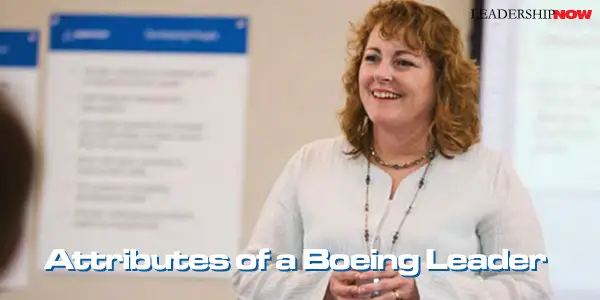
WHEN Ginger Barnes spoke to employees at a leadership development program at the Boeing Leadership Center, she said: Leadership is all about leaders teaching leaders and about relationships. We can execute the daylights out of anything, so “finds a way” and “delivers results” have always been strong traits. Where we need to improve is in the areas of “charts the course,” “sets high expectations” and “inspires others.” That is the case just about anywhere you go. To strengthen the culture of leadership and accountability within the company, Boeing defined its expectations for leaders as: A Boeing Leader:
Posted by Michael McKinney at 01:30 PM
01.16.09

Jean-Marie Dru On Leadership
I do not believe much in natural leadership. The majority of chief executives I know were not necessarily destined for that path. They have been molded by the events they have lived through and the people they have met. The concept of leadership thus evolves into a much narrower question: How can you make sure you will be in the right place at the right time? To people wishing to enter the advertising business, I always explain that the first quality they will need is tenacity. Mere talent is not much use in the face of the countless obstacles that will get in the way of the best performance. Success is born of determination rather than just ambition. Ambition relates to strategy, whereas determination is linked to execution. Adapted from How Disruption Brought Order by Jean-Marie Dru
Posted by Michael McKinney at 09:08 AM
12.22.08

The Age of the Empty SuitIn Peggy Noonan’s weekend column in the Wall Street Journal, she delivers another fine essay, Who We (Still) Are: A little perspective for the pessimistic “age of the empty suit.” She writes: A sober observation came from a Manhattan woman who spoke, on the night Mr. Madoff was arrested, and as word spread through a Christmas party, of the general air of collapse in America right now, of the sense that our institutions are not and no longer can be trusted. She said, softly, ‘It's the age of the empty suit.’ Those who were supposed to be watching things, making the whole edifice run, keeping it up and operating, just somehow weren't there.For several decades we have been systematically dismantling guideposts. This leads us to empty suits. When truth becomes whatever we want it to be, when all truth becomes opinion, when all opinions are equal, then the truth is nothing; it is a empty shell. Living on such a wide avenue is a road going nowhere. Far too many people and organizations have been accomplices to the crisis we face. In accepting unwarranted short-term gains, we have distorted our role in this world. “Going forth each day with a sense of deep time” requires a truth outside ourselves and building on our inheritance with a mind to those to come after us. We are all soberly reminded of this now. Often it takes a crisis of jaw-dropping proportions for us to face these often inconvenient truths. While we're at it, perhaps we also need to address the questions we're asking. Questions in search of magic pills will come up empty. It’s time to face up to the hard work of filling the empty suit with substance.
Posted by Michael McKinney at 12:24 AM
10.27.08

Weeding Out the Leaders We NeedIn Time magazine this week, Michael Kinsley writes that we don’t just need a good man in the White House this time, we need a great man. He thinks both candidates have the seeds of greatness, but “unfortunately”—and this is what caught my eye—“our current political system seems designed to weed out precisely the qualities that are most needed at the moment.” He suggests that at a time like this we need astringency, not empathy. Feeling our pain won’t get it done. We need leaders willing to tell people what they don’t want to hear. “It's not comforting people about their current situation and reassuring them it will get better. It's telling them that the situation is likely to get worse and that only their efforts can determine how soon it will start getting better. Astringent leadership is Churchill calling on Britons to ‘brace ourselves to our duties.’” But he’s right. Who wants to put that in the White House? We vote for people that tell us that they will fix everything and not bother us. We vote for people that don’t make us take responsibility—who can place the blame somewhere else—who will level the playing field at someone else’s expense—smooth talk over straight talk. History teaches us that this always comes at a cost. It’s problematic for both leaders and followers. Both get their roles wrong and both pay a price. Kinsley writes: We have lucked out several times in our history when implausible characters showed unexpected greatness when it was needed: a country lawyer from Illinois, a spoiled patrician in a wheelchair, to name two obvious examples. Even more miraculous (though troublesome for democracy), both Lincoln and F.D.R. were elected by promising more or less the opposite of what they did in office. Lincoln said he'd preserve the institution of slavery. F.D.R. said he'd balance the federal budget.Can we expect this fortuitous turn of events again?
Posted by Michael McKinney at 10:56 AM
08.06.08

Can You Lead With Kindness?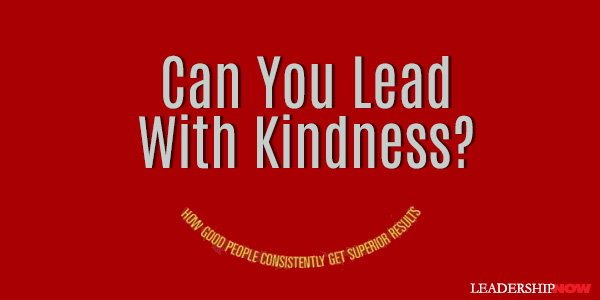
Bill Baker and Michael O’Malley have done a service with their book, Leading With Kindness. As awkward as that title might seem at first blush, the authors aren’t suggesting that kind leaders have a soft personality, or are sissies, or are well liked at all times. (“You can be hard-nosed and kind.”) Leading with kindness is not a hot-tub leadership where the participants pass the torch singing Kumbaya. In fact they write, “They muddle through life much like the rest of us, mostly unnoticed except by those around them who are keenly aware that they are in the presence of someone special.” (That last sentence reminds me that great leaders are not great because they are super-human. Instead, they are ordinary but growth-oriented people with character that have chosen to make a commitment to a bold course of action that is in the best interest of those they serve despite the odds.) The authors add: The fact is, kindness isn’t always nice. It pushes others to do better; it asks them to try out things that they are uncertain they can accomplish; it requires them to engage in activities that they are not sure they will like. Another fact is this: Folks don’t always take kindly to kindness. Leaders, even great ones, cannot save everybody. Armed with that knowledge, you can safely leave the dust-jacket on when you read the book and confidently move on absorbing the many great insights the book has to offer. The book is research-based, practical and realistic. They suggest that:
Baker and O’Malley ascribe six attributes and behaviors to leading with kindness:
In the end, it gets down to character, maturity and a genuine respect for other people. Kindness is a way of viewing the world and it can only come from within. 
Posted by Michael McKinney at 01:58 PM
05.29.08

Change the Way You See YourselfThe authors that brought you Change the Way You See Everything have taken the principles of asset-based thinking and applied them more specifically to you – the individual – in Change the Way You See Yourself. Like its predecessor, this book too is a feast for the eyes. I enjoy the graphics, but the message they convey is vital to your personal development.Asset-based thinking is a way of looking at yourself that emphasizes what is working in your life and the strengths you possess. It is a way of freeing yourself from negative and unproductive thinking. It allows you to focus on what you can do and not what you can’t do (as often seems to be our default mode of thinking). They write that with asset-based thinking, “you use surprise, serendipity, and even setbacks to make the journey more interesting and more worthwhile. You are more confident in who you are, where you are going, and how to get there.” In the section on power they invite us to look at it in a new way. Authors Kathryn Cramer and Hank Wasiak write: When it comes to power, most people think of accumulating material wealth, status, authority, knowledge, and expertise. These are potent external sources of power. AS such, they provide you with control over a vast array of resources – from money, to land, to market share, to intellectual property. While building large reservoirs of external power may be useful, it is not enough for getting results. There is another source of power equally important and often more vital to your leadership and success.  Leadership sage Warren Bennis once said, “A point of view is worth 50 IQ points.” He knew That when you live by the power of your convictions you stand taller, sit straighter, and speak more confidently. You raise the level of your game. Others know you as a “force of nature” – someone who will not be deterred and who doesn’t give up. Related Reading:
Posted by Michael McKinney at 10:40 AM
04.21.08

Maxwell’s Gold: Lessons Learned From a Lifetime of Leading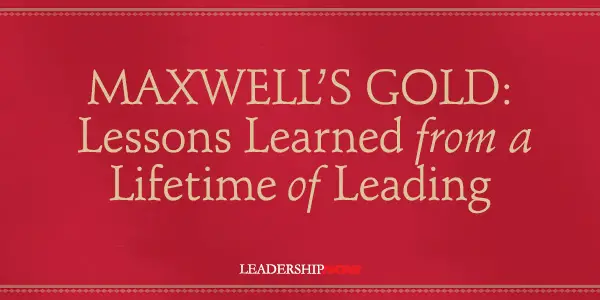
IN Leadership Gold, John Maxwell looks back on 60 years and distills what he has learned about leadership to date. And he stresses that he is still learning. It contains 26 important lessons about leadership and human relationships that are well worth reviewing. It’s a mentoring-style book. He says that leadership can be learned by anyone, but it’s not easy. Leadership is demanding and complex. He writes:

Posted by Michael McKinney at 10:35 AM
03.12.08

Understanding People Must Include Their IdentitiesMichael Maccoby states in a must read book, The Leaders We Need, that to lead in the global enterprise you'll need to know even more about people. It has always been so, but in past, one was able to get away with not getting to know those you were leading. The place to begin is to find out where they are at. He writes:By satisfying the demands of identity groups, leaders don’t necessarily gain willing followers. But if these identities are not respected, leaders will be less willingly followed, possibly resisted.
Posted by Michael McKinney at 08:32 AM
03.10.08

The Great Leadership Lessons Don’t Change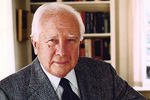 The American historian Samuel Eliot Morison liked to say that history teaches us how to behave—that is, what to do and what not to do in a variety of situations. History is the human story. Jefferson made that point in the very first line of the Declaration of Independence: “When in the course of human events…” The accent should be on “human.”He also says that we need to be developing leaders at all levels: We need leaders and not just political leaders. We need leaders in every field, in every institution, in all kinds of situations. We need to be educating our young people to be leaders. And unfortunately, that’s fallen out of fashion.The interview contains a lot of good material and is available for free on the Harvard Business web site.
Posted by Michael McKinney at 08:51 AM
03.04.08

Five Tips from Atsutoshi Nishida on Overcoming a Crisis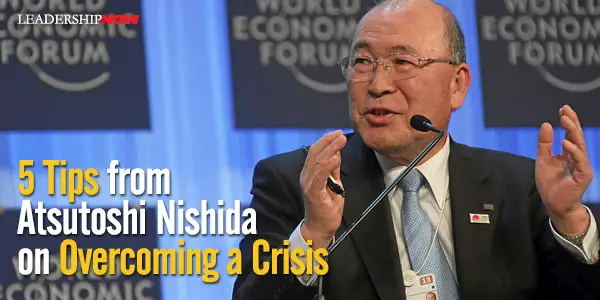
THE Wall Street Journal interviewed Toshiba Chief Executive Atsutoshi Nishida who recently pulled the plug on the company's HD DVD business. From that interview came the following wisdom regarding crisis leadership in particular but good ideas to keep in mind regarding the daily crises we often face in the minutia of our day.
That fifth step is important to keep in mind as it helps you keep things moving forward rather than getting bogged down in your current situation. Things change. Most things are cyclical. He explained the balance between practicality and enthusiasm in decision making. I don't operate just on logic. I'm practical, but I also have enthusiasm, which is the side of me that's not practical. If you have that in addition to a strong will to achieve your goals, then you can overcome any adversity. For example, I used logic to rationally make the decision to quit HD DVD, but my enthusiasm allows me to move forward. Enthusiasm too helps us to reframe our problems in a way that is constructive. This is not naïve optimism, but an informed optimism that reflects the reality of the situation.
Posted by Michael McKinney at 01:10 PM
02.29.08

Aristotle on Virtuous LeadershipJames O’Toole surveys the works of Aristotle in Creating the Good Life, and creates a practical framework that can be used to evaluate leadership in our own time. This excerpt is from a section regarding community leadership:Aristotle says a leader also needs practical wisdom. Practical wisdom has “nothing to do with calculating magnitudes,” nothing to do with science, theory, disciplinary knowledge, or knowledge of facts in any way. It is concerned “neither with eternal and unchangeable truth nor with anything and everything that comes into being (and passes away again). Instead, it deals with matters where doubt and deliberation are possible.” In particular, practical wisdom is not concerned with the way things are but with “how things can be other than they are.” In other words, it is about how conditions in society and organizations could be made better. And “it implies the use of one’s faculty of opinion in judging matters” relating to what is right and wrong for a group, or society as a whole.  Aristotle concludes that virtuous leaders in the Periclean mold are rare, but their scarcity is not due to a shortage of leadership capacity in the human race. Instead, he believes the virtue manifested by those rare leaders is an acquired trait; he believes leaders are made, not born. Indeed they are self-made. At all times, the conscious goal of a just leader is to help followers achieve what is good for them, which, on occasion, may be something different from what they think they want. Hence, in addition to effectiveness, leadership has a moral dimension: the capacity to discern and provide justice.
Posted by Michael McKinney at 08:52 AM
02.06.08

Do You Want to Change the World?
JAMES KOUZES and Barry Posner are the authors of the classic The Leadership Challenge. In A Leader’s Legacy, they make an important point about leadership and passion: When people talk about leadership, they often use the word passion. And when we think about passion we tend to think of emotions like enthusiasm, zeal, energy, exuberance, and intensity. Well, all those attributions might be true, but when you look up the word passion in any dictionary that includes origins you’ll see that it comes from the Latin word for suffering. Passion is suffering! A passionate person is someone who suffers and a compassionate person is someone who suffers with, and shares the suffering of, others—and wants to take action to alleviate this condition. Nearly every act of leadership requires suffering—and often for the leader a choice between one’s personal success and safety and the greater welfare of others. We’re asking you to understand that nothing great comes without costs. 
Posted by Michael McKinney at 01:27 PM
02.04.08

Charles Handy: Are Leaders Born or Made?Charles Handy, in another thought-provoking distillation of his thoughts, Myself and Other More Important Matters, ponders the idea of getting to the bottom of who we really are and the difficulty of seeing ourselves as others see us. Throughout our lives we all play many parts and in a sense, become different people. Can we become something different from what we see ourselves as being to this point? Can we become a leader? Handy weighs in on this:One of the debates in psychology is whether we have a core identity that is sitting there in our inner self, waiting to be revealed, or whether our identity only evolves over time. One of the perennial questions that bug organizations is a derivation of that debate – are leaders born or made? The truth, as in most things, is probably a bit of both. The battery of personality tests that purport to show whether we are introvert or extravert, whether we like structured situations or a bit of chaos, are based on the idea that our real identities are formed by early adulthood and that a good life is about finding situations that fir our characteristics. There is some intuitive truth on this….We can’t escape our genes.Leadership is a possibility we can all explore. It is something we can develop if we choose to. What combination of strengths and weaknesses we have to manage will of course vary from person to person, as we are all different; we are born with different genes. And this is as it should be. Leadership development is a highly personal experience that requires self-knowledge and a willingness to confront those areas where need to improve that will make us effective with people. The traits that will make you a better leader are the same traits that will give you the capacity for success in all areas of your life. Above all, our leadership is reflected in our character. At the same time, leadership training offers the opportunity to examine our thinking in an environment where mentors are available to help us to interpret what we find and guide us to the appropriate changes we need to make in our lives. But no training will, of and by itself, make one a leader. That’s an inside job.
Posted by Michael McKinney at 08:22 AM
01.23.08

Looking for Tomorrow’s Leaders
The complete interview is available on the HBR web site and is worth the visit.
Posted by Michael McKinney at 09:04 AM
01.16.08

The Other Side of Leadership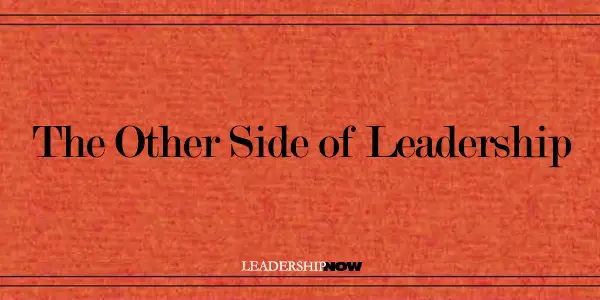
IT may seem counter-intuitive, but great followers make great leaders. In Reinventing Leadership, Warren Bennis wrote, "Good leaders should also be good followers. If you're coming up within an organization, you must be a good follower or you're not going to get very far. Leaders and followers share certain characteristics such as listening, collaborating, and working out competitive issues with peers." Echoing this thought, authors Chris Brady and Orrin Woodward, stress the importance of becoming a Performer in leadership development—the need to create a record of performance. That is to say, you need to become a great follower, a great contributor. In their excellent book, Launching a Leadership Revolution, they wrote:The quickest, most assured way of gaining that track record of performance is to absolutely master the patterns of success already established in an organization. It should be the goal of every leader striving to become a Performer that the entire organization notices his abilities with the proven patterns. This will give him a platform and the experience to help others accomplish similar results. That is the route to influence. As the Marquis of Halifax wrote in 1693, “When a Gentleman hath learnt how to obey, he will grow very much fitter to command.”
Posted by Michael McKinney at 11:44 AM
12.03.07

Keys to Spotting a Flawed CEO These warning signs reflect a lack of humility. Unfortunately, humility is a characteristic that is widely misunderstood. Consider the comment from Cathie Black, President of Hearst Magazines, quoted on the PINK magazine website. She said, "Humility and modesty are valuable personal qualities, but they won't do much to advance your position in the workplace." If you think humility is synonymous with timidity, weakness, or reticence, then perhaps her comment holds some merit. But that is not humility. Humility is about a proper self respect—neither thinking too highly or too little of ourselves—it is about a healthy respect of other people and teachability; all of which will help you advance in any situation. Michael Watkins wrote in his excellent "guide for new leaders," The First 90 Days, "When a new leader derails, failure to learn is almost always a factor." Other than just not having the know-how to systematically diagnose an organization, he says some leaders have “learning disabilities.” Failure to make an attempt to understand the organization, a compulsive need to take action and preconceived ideas of what is “right,” all stem from a mismanaged ego. Here are the warning signs presented by Dr. Leap:
Posted by Michael McKinney at 12:01 AM
10.26.07

Is CEO the Job Right For You? Look Before You Leap The leap to CEO from any other position is a big one. Ram Charan writes, “The job of a CEO is more intellectually, socially, politically, and psychologically demanding than ever. And it is much more challenging than other jobs leading up to it.” The Wall Street Journal reported this week in A Different Animal Seeks the No. 1 Post; Often, It’s Not No. 2, that “the gap between No. 1 and No. 2 in a company is often bigger than many realize. CEOs not only perform different tasks from their second-in-commands—who typically focus on running operations—but they have to act differently too. That means the two roles often demand very different personality traits, say people who have been there.” WSJ author, Phred Dvorak, continues, “The very talents that make a great chief operating officer—like finicky attention to detail—can get in the way when you are in the top seat. CEOs are supposed to strategize, not micromanage.” Murray Martin, Pitney Bowes CEO, told Dvorak, “He can understand how executives with more retiring personalities wouldn’t like the transition. One of the biggest differences between the two jobs [COO/CEO] is how much time is spent on external affairs.” We have seen people taking positions in organizations across the board—business, politics, religion—who like the idea—the trappings—but can't handle the pressure and responsibility. They complain, “Why don't they just leave me alone?” But that’s part of the job. Perks only come with responsibility. The CEO job is certainly one where you need to count the cost as there is a dramatic shift in expectations, but any leadership position should be weighed before you accept it. Is CEO the job right for you?
Posted by Michael McKinney at 09:07 AM
10.12.07

Leading When Things Aren’t Going Your WayIn Bo’s Lasting Lessons, authors Bo Schembechler and John Bacon relate a story from Bo’s early days coaching. He learned a lesson about leading when the heat is on from his boss from his boss and mentor Ara Paraseghian that he carried with him the rest of his life. Here's that excerpt:The following season, 1956, I left Doyt [Perry] 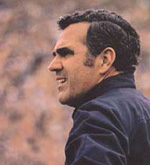 and Bowling Green—with his blessings—to become an assistant for Ara Parseghian at Northwestern University.
and Bowling Green—with his blessings—to become an assistant for Ara Parseghian at Northwestern University.
Ara was not a big ego guy, he was great with players, he was a wonderful motivator, and he understood the game so well he could come up with things no one else had thought of. He was probably the most imaginative coach I’d ever seen, always adapting his plays to his players instead of the other way around like most coaches do. Heck, we used to call his practice field “The Laboratory,” because that’s where he’d try every trick in the book on Mondays, testing this and experimenting with that, just to see what might work that Saturday. Before Ara arrived, Northwestern hadn’t had a winning season in five years, but in his first year Northwestern went 4-4-1, and everyone was encouraged. But in Ara’s second season, 1957, everything went to hell. We lost nine games—every single game we played! For a coach, that’s just about the most difficult situation you have to face. We could keep our opponents down to one or two touchdowns, but we couldn’t score for our lives. And I was working with the offense! Losing creates all kinds of other problems too—poor morale, nagging injuries, lackluster effort. The players were spending more time in the PR office than in the weight room. It was just a mess. I never experienced anything like that in all my years of coaching—and thank God for that. I learned an awful lot from Ara in my first year at Northwestern, but I learned a heckuva lot more from him that second season, when he lost ‘em all. And what I learned was how a real leader leads when things aren’t going his way. Ara treated the staff as though we were winning every game. He never gave the slightest inclination that we were the problem. He not once blamed any assistant or any player fro any loss we suffered that year. NOT ONCE. “Stick with it, guys, and we’ll get through this,” he’d tell us. “We’re going to be okay.” We all kept busting our butts for Ara, working past midnight, doing everything we could to get that guy a victory. I’m not saying there wasn’t some bitching among the players. When you’re losing every game, every player thinks he deserves more playing time. But I promise you this: There was a whole lot less bitching on that team than I’ve heard on teams that won half their games—and there was absolutely no, but no, bickering among the coaches. And that wasn’t even the most impressive thing Ara did that year. Stu Holcomb was Northwestern’s athletic director, and his son Chip was a backup quarterback on the varsity. In the middle of this losing streak, Stu kept cranking up the pressure for Ara to start his son. At one of our staff meetings, Ara laid the situation on the table. Then he asked us point-blank: “What do you think?” The thing is, there wasn’t anybody on the staff pounding on the table to make a quarterback change just because we were losing. We knew there had to be a ton of pressure on Ara to put Stu’s son in, but our quarterback wasn’t the problem. And that’s exactly what we told him when he asked us. He just nodded. Another coach—maybe most coaches—would have caved in to their boss just to save their hides. But Ara held firm. He didn’t change quarterbacks, or even consider doing it. And every one of us who walked out of the coaches room that day felt the same way I did: Ara Parseghian is a stand-up guy. He’s a leader. I want to work for this guy! And that’s why that losing season didn’t break Ara’s back: Because he’s a confident guy, and he knew he could coach. His staff remained dedicated to him and his program the entire season. You’d think my two years at Northwestern would have been a horrible experience, but it wasn’t. It was a great experience, because Ara had put together a stellar staff—they’re all still good friends of mine, especially Alex Agase—but mostly, it was because Ara was there. The result? Put this down: Ara Parseghian lost every game that year, but the next year his team went 5-4—Northwestern’s first winning season in eight years. When Ara took the Notre Dame job five years later, in 1963, he left Evanston as one of only three coaches in the last century of Northwestern football to post a winning record. And of course, from there he won two national titles and Coach of the Year at Notre Dame. Don’t tell me he didn’t deserve it. But that 0-9 year? He didn’t get any rewards for that, but let me tell you: THAT was the most impressive year of his coaching career.
Posted by Michael McKinney at 11:02 AM
10.10.07

Shogun Yoritomo-Tashi on Leading by Example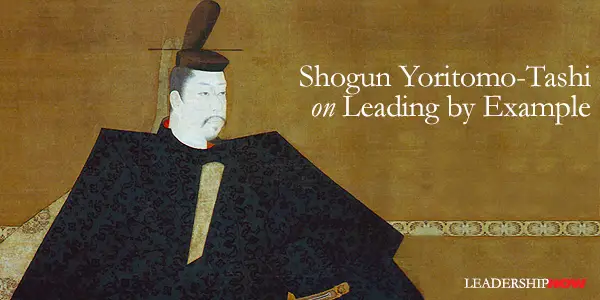
ANCIENT Shogun Yoritomo-Tashi believed that the art of influencing others was the key to success. The Japanese statesman and philosopher believed that the spirit of the individual continuously exerts influence, even as the flower also exerts influence by spreading its fragrances in the air. But just as the blossom can not tell whether its fragrance spreads, so none of us can say how far our influence may reach. From his writings we have his take on the dynamics of influence by example: The reciprocal influence which individuals exercise on one another is the cause of many evils difficult to conjure.… The influence of example is considerable. One of the greatest obstacles to the doing of good actions is the timidity based on the fear of responsibility, which haunts mediocre minds.
Posted by Michael McKinney at 08:51 AM
10.08.07

5 Leadership Lessons: Bo's Lasting Lessons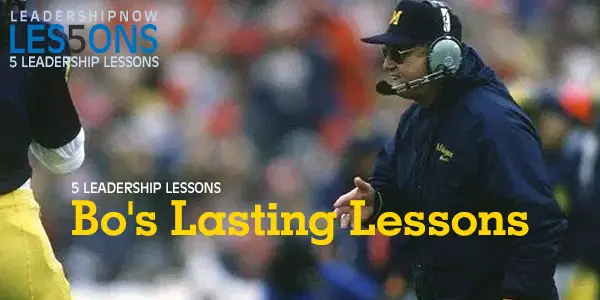
Bo Schembechler's book, Bo’s Lasting Lessons, written with John Bacon is an engaging, hands-on, first-person account of the winningest head coach in Michigan football history and fifth on the all-time list, only behind coaching legends Paul 'Bear' Bryant, Amos Alonzo Stagg, Glen 'Pop' Warner, and Woody Hayes. The lessons found here are easily applied anywhere.

Posted by Michael McKinney at 06:01 PM
09.28.07

Being a Role Model: Who's Watching You? We all hear about how baseball imitates life, which held especially true for my dad. He used to say that everything that happens in baseball happens in life and everything that happens in life happens in baseball. He certainly taught us about life through baseball. But I also have to admit that as a young man with a limited view of the world, baseball and life became one for me and it was difficult to see beyond playing the game. Did you ever stop to think about how your life would unfold or imagine how you would like your life to turn out? One of those reflective pauses happened in my life when I was around 18 years old. I thought I had it all figured out, I would play big league baseball until about 45 and then worry about the rest of my life after that. It took me a little while, but I did come to realize that baseball was just one part of my life with the possible exception of this weekend, of course. This was never more clear to me than when we had children. I realized that the secret of life is life, and a bigger picture came into focus. Games were and are important, but people and how you impact on them are most important. While we all work to develop into productive people for our own happiness, it is also vital that we do so for the good of society as a whole. As I came to know the importance of my role in the development of my children, I began to sense the impact I could have on other kids. It is all about coming to the realization that we all have within us the power to develop and pursue almost anything we set our mind to, and that is the message and opportunity we want to pass to all children. We are the ambassadors for the future, just as a baseball player wants to leave his mark on the game and leave it a little better than he found it, we should all try to make this world a better place for the next generation. When I realized that I could use baseball to help make life better especially for the kids, baseball became a platform. By trying to set a good example, I could help influence young people in positive and productive ways. And some of this became apparent to me in my earliest playing days. So as my major league career unfolded, I started playing a little more attention to my actions. I remember when Kenny Singleton showed me a tape of me throwing my helmet down after a strikeout and all he said was, "How does that look?" I remember learning about a family who saved their money to come to Baltimore to see me play. I got thrown out in the first inning and their little boy cried the whole game. I remember how I reacted with anger when dad was fired after an O-and-six start, and after each of those events and others, I vowed to act better the next time. Yes, these were only little things, but as dad used to say, if you take care of all the little things, you'll never have a big thing to worry about. As the years passed, it became clear to me that kids see it all, and it's not just some of your actions that influence, it's all of them. Whether we like it or not as big leaguers, we are role models. The only question is will we be positive or will it be negative. Should we put players up on a pedestal and require them to take responsibility? No. But we should encourage them to use their influence positively, to help build up and develop the young people who follow the game. Sport can play a big role in teaching values and principles. It can be a huge developmental tool for life. Just think—teamwork, leadership, work ethic and trust are all part of the game and are also all factors in how we make the most of our lives. So an essential part of the job of every player and of all people for that matter is to help the young people of today learn these lessons so they can live better lives tomorrow.
Posted by Michael McKinney at 12:30 PM
09.26.07

Lord Sharman on Helping People GrowLeading By Example is a concise little book of interviews with top leaders from various fields. Each interview in this new Harvard Business School series is followed by a list of takeaways. Here is an excerpt by Lord Sharman, chairman of the Aegis Group, on investing in people by understanding their strengths and nurturing them like a gardener with prized plants.I’m very fond of gardening myself, and I’m fond of gardening examples. To some degree, developing people in an organization is impossible. You can’t develop them; they develop themselves, and so your job is like that of a head gardener. You figure out what the various microclimates are around the place, and then you figure out the qualities of the plants that you need to go into those microclimates. Similarly, you select the people based on their strengths and place them in those jobs. I’ve seen notes of appraisal interviews, which say that two-thirds of the interview is spent talking about what the guy’s not good at. Now, that’s great—I can’t imagine anybody coming out of an interview like that feeling anything other than very depressed.
Posted by Michael McKinney at 09:15 PM
09.24.07

Lessons from the Prophet Jonah
TWO DAYS AGO, on Yom Kippur — a day about braking wickedness — at synagogues around the world, a book about breaking wickedness — the book of Jonah — is read. In the Jerusalem Post, the dean of the Schechter Rabbinical Seminary, Einat Ramon draws a perspective on leadership and responsibility from the book of Jonah that I had not read before. He writes:
Trivia: Jonah was told to go to Nineveh. Nineveh today lies across the Tigris River from the modern Iraqi town of Mosul.
Posted by Michael McKinney at 08:42 AM
08.24.07

Louis Nizer: A Leader Wears Many Hats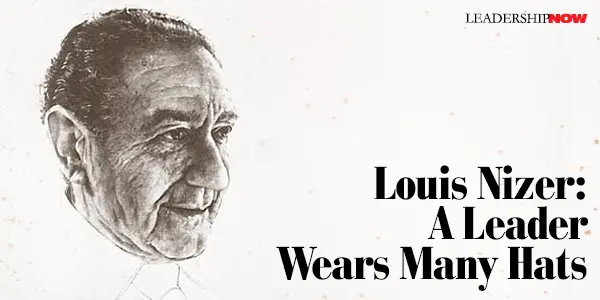

It took as much energy to unify our comrades as to prepare our own brief. A lawyer, particularly when he deals with eminent co-counsel, whose talents and achievements warrant strong egos, must be a consummate diplomat. Those words cause me to take a step back. Any leader would be strengthened by applying these concepts in their own arena. 
Posted by Michael McKinney at 09:18 AM
08.06.07

Quiet Sacrifice Leaders also understand the meaning of quiet sacrifice. This is something I have had to do several times in my career and will, I am sure, have to do again. Well put. Nothing great comes without costs.
Posted by Michael McKinney at 06:51 AM
07.30.07

In A World Of Accelerating Change, It Takes Bold Leadership What does he mean by bold leadership? In terms of a government's leadership style, Bush noted that it is critical for an administration to rethink what they are doing. “A lot of times, the way we do things is because we have been doing it that way before, not because it is rational, not because it improves the human condition or creates the chance for people to pursue their dreams, but because we have been doing it that way. So in a world where change is happening a lot, whether the government is changing or not, it is important for leadership to have a healthy disrespect for the status quo. You won't change everything but the things that don't work need to be changed and without leadership, this won't happen." This thought is echoed in Jim Tompkins’ book, Bold Leadership for Organizational Acceleration. In it, he addresses three important aspects of bold leadership—the inspirational leadership that drives an organization, outsourcing those areas outside your core competencies, and the importance of a Plan B. Tompkins states. "Leaders must not only be bold if they want to thrive today, but they must also develop bold companies—encouraging boldness in all aspects of the organization." To do this, “Leaders must, therefore, teach others how to be leaders. Their strategies must be flexible and innovative. They must challenge the established view of a leader as someone who leads and demonstrate that leadership means inspiring others to lead. They must have the courage and spirit to move from wherever they are to further their abilities to lead others into getting extraordinary things done. In other words, these leaders must practice Inspirational Leadership."To make this happen Tompkins suggests that leaders look at the big picture to locate and deal with those “parts of the picture that are just filling up canvas and not adding value to the subject.” Tompkins adds something that I think underscores the importance of this point. “Actually, it is not enough just to look at the big picture. If your picture is in a frame, you need to look at the frame too. Is it possible that the frame is the important part and the picture inside it needs to be changed or removed? ... Or is the frame that holds the picture rotting or overpowering the picture so that it is totally lost?” Perhaps it’s time to look at what we are doing and ask if we need to be doing it differently or if we need to be doing it at all.
Posted by Michael McKinney at 04:00 AM
07.18.07

The Importance of Competence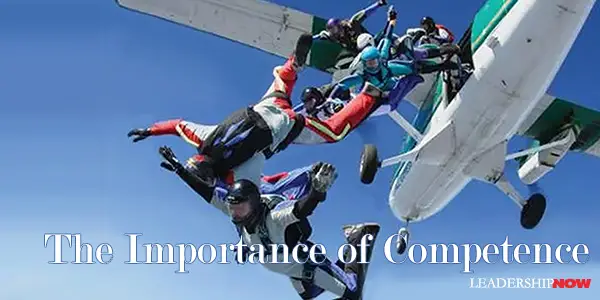
COMPETENCE alone can’t make a leader, but it can undo one. While inaction is a prime problem facing many organizations (and individuals, for that matter), there’s the very real possibility that one is doing the wrong thing. An incompetent leader has almost unlimited opportunities to be ineffective. Knowing what to do—professional competence—is vital. Being competent doesn’t mean that a leader knows how to do everything, but rather that they know what to do and how to get it done. Even the most brilliant leader who tries to go it on their own is setting themselves up for failure. A good leader will know where their strengths and weaknesses lie and thus know what kind of expertise they will need to surround themselves with. Most leaders have gotten to their station in life through their own competence, but that becomes lost on followers unless the leader’s competence is occasionally revealed by action. 
Posted by Michael McKinney at 09:52 AM
06.22.07

Corrupt Leadership: Tyranny of the Self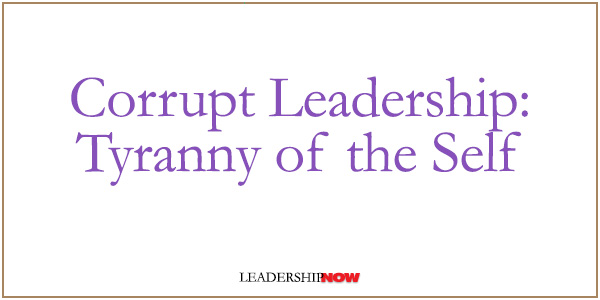
POWER CORRUPTS. Well . . . it can and too often does. The exercise of power — causing some to submit to the will of others — is necessary in any functioning state, organization or relationship. This power may shift, but it always exists. Power is not evil, but one should be cautious about the form it takes. Power controlled by the ego is something to be fearful of. Power tempered by humility and character is a gift. Bertrand de Jouvenel wrote colorfully about power in his 1949 book, On Power: Its Nature and the History of its Growth, “The leader of any group of men . . . feels thereby an almost physical enlargement of himself . . . Command is a mountain top. The air breathed there is different, and the perspectives seen there are different, from those of the valley of obedience.” With this kind of power should come understanding, without it, it is a slippery slope to self-delusion and tyranny. Power with out humility and compassion is ignoble
As part of their Fail States Index project, FundForPeace.org has been running a poll asking readers what they feel is the most critical cause of state failure. It’s not always easy to determine the source of failure. There is a tendency to allow oneself to fall into the abyss of dense complexity and deep subjectivity. Fortunately, there is no space for that here. The current results of the poll show corruption to be the overwhelming reason for failure. I would agree. Lack of education too, certainly limits one’s thinking and responses to life’s issues including corruption in government. LaBrent Chrite, professor at the University of Michigan Business School wrote, “Leadership and governance provide the predominant factor behind the dissonance or variance in progress seen across developing countries.” Corruption is ultimately the result of a total breakdown in leadership. It's wrong thinking and a wrong perspective on the part of the leader. In a corrupt culture, leaders have set the pace by looking after themselves instead of looking after their responsibilities. They have fallen to the tyranny of their own mind — belief in only one’s self. James Hillman wrote in Kinds of Power, “This kind of power, which makes us both effective and blind, goes deeper than merely being set on our ways. It is the tyrannical rule of style, the style of our thinking and working and connecting, the style of our words and gestures, and as it all fits together into the integrated personality, consciousness becomes tyrannical. We drink to escape from this tyrant; divorce, fall in love, quit jobs, move residences, go bankrupt, shoot rapids, hang-glide, fight our children—anything to escape the cruel and unusual punishment inflicted by the absolutism of successful rule. Everything has been subordinated to the one tyrannical pattern. All otherness is gone. One has become totally oneself and now suffers from totalitarian rule.” Are we tyrannized by our own mind?
Posted by Michael McKinney at 10:33 AM
06.20.07

Calls for Leadership: The Failed States Index 2007The Fund for Peace and Foreign Policy Magazine has just released the Failed States Index. It is a sobering survey of 177 countries ranked in order of their vulnerability to violent internal conflict and societal deterioration. It is based on 12 social, economic, political, and military indicators. (You can click on the map above to view a larger image detailing the status of various nations of the world, including your own.)The third annual Index found the greatest improvements over the last year in Liberia, Indonesia, Democratic Republic of the Congo and Bosnia. Unfortunately, the risk of failure is running higher than last year in Lebanon, Somalia, Equatorial Guinea, and Niger. Although these countries may seem world's away, their problems have consequences for all of us. Failing States have one thing in common—bad leadership. Foreign Policy concludes, “Many states must endure poverty, corruption, and natural disasters. But, for the weak, there is nothing more costly than a strongman calling the shots.” Billions in foreign aid and security are no match for bad leadership. Effective leadership can reverse a states slide to failure. Three editorials from the last two days, speak to the leadership issue behind these problems. First, here are some comments from The Daily Star in Lebanon titled, “If Lebanon becomes a failed state again, failed leadership will be to blame:” Lebanon's slide downward on the scale toward failure was more pronounced than that of any other country in the world. Who or what is to blame for the fact that Lebanon is once again rapidly on its way to becoming a basket case? Yes, the war with Israel created problems, but the leaders of Lebanon have compounded those "difficulties" and transformed them into an utter disaster. Leaders on both sides of the political divide are guilty of playing solely to their respective supporting audiences and ignoring everyone else. Not one has risen to the challenge of being a leader for all the Lebanese. [There exists a] paralyzing impasse that has been brought on by their political leaders' shared predilections for hubris and maximalism.From AllAfrica Global Media, we have this opinion from Nurudeen Jattau in Nigeria: It is needless to say that the tragedy of the contemporary nation-state of Nigeria is the seeming absence or the lack of visionary leadership in all spheres of governance. This precisely, is the singular reason why analysts are agreed that Nigeria may never reach anything close to its full potential as a nation. All things considered, and whichever way the pendulum swings, we must understand and appreciate the fact that leadership is invariably a means to an end, and not an end in itself.Consider finally, an editorial by Fouad Al-Obaid in the Kuwait Times: If one studies history and the civilizations that preceded us, one will most certainly not come across common names. However leaders on the other hand, do end up in the pages of history for several reasons. They do so when their failure is total and their incompetence is obvious to all. Just as much as they do so when their bravery, their tactics, their leadership capability along with their capacity to move minds and hearts in the most turbulent times is put to test and they succeed.Foreign Policy would agree with Mr. Al-Obaid. They write that effective leadership doesn’t necessarily make a leader popular. “But then, such leadership is exactly what more failing states need: a head of state who chooses continued reforms over his own power and recognition.” I am reminded of something John Lukacs wrote in 1993, “The great and enduring problems are political, not economic. They involve the lust for power, not for money. (But then, this has been true of mankind ever since Adam and Eve, misunderstood by Adam Smith as well as by Karl Marx.)” You don't have to look too hard to find applicable lessons here for any leadership role we find ourselves in.
Posted by Michael McKinney at 08:47 AM
06.13.07

Andy Stanley on Communication and Leadership "Here's an incredibly important principle. You cannot communicate complicated information to large groups of people. As you increase the number of people, you have to decrease the complexity of the information. Congregational rule, when you're trying to make a complicated decision, works against the principle. So consequently, the guy with the microphone and the clearest message always wins. The most persuasive person in the room is going to win. Whether right or wrong." He was asked about criticisms that some churches seem so corporate in their leadership structure with the pastor as CEO. He says there is a sound principle behind the structure: “‘Follow me.’ Follow we never works. Ever. It's ‘follow me.’ God gives a man or a woman the gift of leadership. And any organization that has a point leader with accountability and freedom to use their gift will do well. Unfortunately in the church world, we're afraid of that. Has it been abused? Of course. But to abandon the model is silly.” I would add that we can find many that are afraid of that concept outside the church as well. It's often why we see leadership theory taking strange twists and turns in the literature today. Learning to operate without abusing the influence or power that goes with leadership at any level, requires a proper perspective as to why you are leading in the first place.
Posted by Michael McKinney at 03:10 AM
06.08.07

The Key to Presidential Courage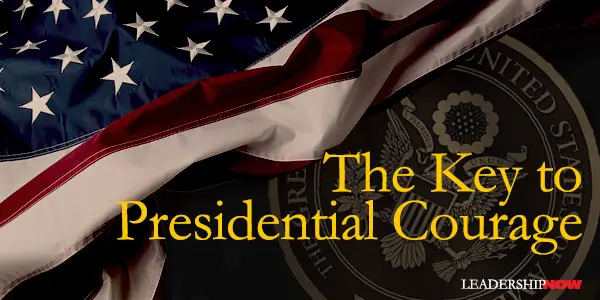
HISTORIAN Michael Beschloss, gave an engaging and entertaining talk to the Los Angeles World Affairs Council a couple of nights ago about his book, Presidential Courage. 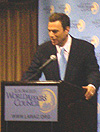 Beschloss said that in effect, Adams said, “I wanted more than anything to get a second term so that I had a chance in history to be the equal of General Washington. Now that’s gone. But, I can go back to Massachusetts and I can feel that my sacrifice was for something important. And I still have my wife Abigail (to whom he was so close) and my children and my farm and my books and my old veteran friends from the revolution.” Adams lived on for 26 more years; long enough to see his son John Quincy elected to be the sixth President. Bescholoss found his attitude a significant key to courage. Adams had a life beyond the Presidency. “We’ve got to look at candidates for President this year and next, and if you want someone who is capable of presidential courage, I would say one thing to look for is: Is this someone who is desperate to be President and hang-on almost at all costs or is this someone who if there is a moment requiring presidential courage—where they have to give it all up—has something else in his or her life—a family or other interests or even better yet, convictions (they can feel that they gave it up for doing the right thing)? The question was raised concerning the difference between courage and betrayal. We speak of courage on the one hand, but what is going on when a President betrays people by doing something that people do not like or different from what they said they would do. Beschloss responded, “In these stories, you will see where Presidents do tell American’s that it’s a good thing to do things that they may not first approve of, but it is not something that is wildly different from something they said in the campaign. They’re moving public opinion just somewhat beyond where it’s willing to go at the moment.” For example: Of the nine presidents I write about, only one had to pay the price of losing reelection and that was John Adams. Everyone else was a good enough politician or a good enough educator that they were able to continue. For instance, FDR, in trying to get a third term could say to Americans, “Well, you may be disturbed by my building up our defense, but think of it this way. Maybe it’s the best way to scare off Hitler if we’re really strong with 50,000 airplanes and so on.” Or in Abraham Lincoln’s case, he stuck to the Emancipation [Proclamation]. But rather than just say, “Well, I’m going to be a courageous guy, and I’ll just go down in flames,” he was such a good educator that he said to Americans, “You may not like the idea of fighting the Civil War also to free the slaves, but since I’ve declared the Emancipation, 200,000 African-Americans have come across enemy lines from the South and they’re all working hard in our Union War effort. If I now dispense with the Emancipation, they’d sit on their hands and we’d lose the war.” 
Posted by Michael McKinney at 02:34 AM
06.04.07

Up the OrganizationJossey-Bass has released a commemorative edition of Robert Townsend’s (1920-1998) leadership classic, Up the Organization: How to Stop the Corporation from Stifling People and Strangling Profits. Originally published in 1970, this candid and provocative book deserves to be re-read every year. Here's a sample of Townsend's straightforward and practical advice:On People: Why spend all that money and time on the selection of people when the people you’ve got are breaking down from under-use. Get to know your people. What they do well, what they enjoy doing, what their weaknesses and strengths are, and what they want and need to get from their job. And then try to create an organization around your people, not jam your people into those organization-chart rectangles. On Delegation: Many people give lip service, but few delegate authority in important matters. And that means all they delegate is dog-work. A real leader does as much dog-work for his people as he can: he can do it, or see a way to do without it, ten times as fast. And he delegates as many important matters as he can because that creates a climate in which people grow. On Leadership: True leadership must be for the benefit of the followers, not the enrichment of the leaders. In combat, officers eat last. Most people in big companies today are administered, not led. They are treated as personnel, not people. On Rewards: Rewarding outstanding performance is important. Much more neglected is the equally important need to make sure that the underachievers don’t get rewarded. This is more painful, so it doesn’t get done very often.  On Compromise:Compromise is usually bad. It should be a last resort. If two departments or divisions have a problem they can’t solve and it comes up to you, listen to both sides and then, unlike Solomon, pick one or the other. This places solid accountability on the winner to make it work. On Compromise:Compromise is usually bad. It should be a last resort. If two departments or divisions have a problem they can’t solve and it comes up to you, listen to both sides and then, unlike Solomon, pick one or the other. This places solid accountability on the winner to make it work.
Robert Townsend served as the president and chairman of Avis Rent-a-Car from 1962 to 1965 during its celebrated turnaround. You may remember the infamous the "We Try Harder" advertisign campaign that helped to tranform it into a world-class organization.
Posted by Michael McKinney at 08:33 AM
05.31.07

The Leader as Coach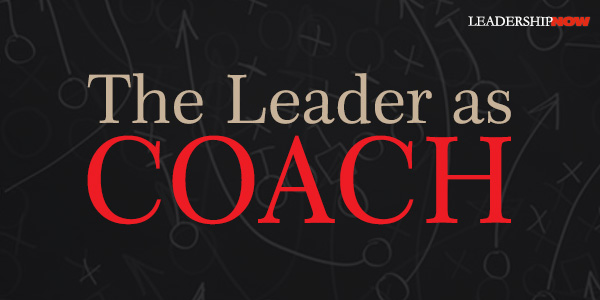
CONSULTANT David Noer makes an insightful comment in Learning Journeys about coaching others: The great teachers of my life gave me a precious gift. It was not a tool, process, or technology; it was something deeper and more profound. They helped me understand that what really matters when helping people or organizations through change and transition is not technique but authenticity, vulnerability, and empathy. They taught me that connecting with others at the warm, messy, and unscientific level of the human spirit is a prerequisite for any methodology or process. I learned that technique without a grounding in empathy and vulnerability is sterile and artificial. I learned, as Larry Porter, one of my many great teachers, once said, “In the final analysis, the only tool worth a damn is our own warm body.”Heart is a distinction of great leaders. We need to have deep convictions about helping others to succeed. The connecting with others grounded in empathy and vulnerability that Noer writes about is not something we can work up. It comes as the result of our own struggles and growth. It is through our own struggles that we come better prepared to help others. Sometimes we look down on people who are struggling. That’s not only ignorant, it’s arrogant. Remember they’re growing. It’s an amazing process. (If we knew better, we might even be struggling with the same thing they are.) We can’t see ourselves as the great teacher imbued with special knowledge and wisdom. We can’t make it about our need to be helpful as often happens. We are a facilitator of their growth. If we’ve been growing, we can often help them to see their situation differently. A well-placed comment or thought can help them to make new connections in their worldview. I think being there is half the battle. It’s difficult at times to truly focus on another person’s aspirations and needs, but you can’t lead without it.   
Posted by Michael McKinney at 10:31 AM
05.29.07

The New Golden RuleDo we need a new Golden Rule? It’s not uncommon to find in modern literature, the call for a new golden rule. Is the Golden Rule adequate in today’s world?The Golden Rule says, “Do unto others as you would have them do unto you.” Some would say that this just isn’t enough: in our global village, we need to consider cultural differences and the desires of others. This thinking suggests that we humans have never found ourselves in a multicultural setting before now. The new Golden Rule goes something like this: Do unto others as they would have you do unto them. The need for a change really reflects a narrow view or understanding of the original intent of the Golden Rule.  In fairness, calls for a new rule points to the very real need to explain the intent of the original. That it should and would need to be explained properly to each succeeding generation is a fact of life. In fairness, calls for a new rule points to the very real need to explain the intent of the original. That it should and would need to be explained properly to each succeeding generation is a fact of life. It should be noted that the term “Golden Rule” does not come from the Bible. However, the Bible does say that whatever you want men to do to you, do also to them. The rule has been stated in many ways for millennia. Almost 4000 years ago, written on papyrus, we have from the Egyptian story, The Tale of the Eloquent Peasant, "Do for one who may do for you, that you may cause him thus to do." Similarly, the Roman statesman and philosopher Seneca instructed leaders to "Treat your inferiors as you would be treated by your superiors." (Epistulae morales ad Lucilium 47:11) Clearly, human nature hasn’t changed much. Rules are tools designed to get our thinking and behavior to a place that we might not naturally go to on our own. As a rule, the Golden Rule is no different. It is an attempt to guide us to the thinking behind the rule so that it is manifested in our behavior. The Golden Rule is an introduction to a lesson on responsibility, awareness, ethics and outgoing concern for others. The principle the rule is trying to get at is one of selfless service to others. We naturally look at things from our own vantage point. So it’s not surprising that we look at the rule selfishly as well—from our own viewpoint. The rule has within it the implicit instruction to treat others thoughtfully—in the same manner of outgoing concern—as you would like them to treat you. Certainly none of us would want others to treat us in a way that shows disregard for our personal needs and feelings. The principle of the Golden Rule is selflessness. It is not meant to imply that you should do for others exactly what you want them to do for you. It’s not about you. This rule is about how to treat others. It’s not a manipulative behavior to get others to do something for you. It’s an approach to how you should be treating others regardless of how they treat you. It’s not a training behavior to get others to do a specific act for you. “I did this for you, so now you should do this for me.” We are to treat others—in the same manner—as we would like to be treated by anyone we come into contact with. The Golden Rule is a lesson that can hardly be introduced to children soon enough. It’s a prescript that should be followed throughout life. This is a tall order, but something every leader should strive to develop. It is the essence of service and servant leadership. Properly understood, the Golden Rule encompasses cultural and personal differences. Certainly, the intent of modern literature on this issue is to jog our thinking from a self orientation to an other orientation in our dealings with others. As is, the Golden Rule, if practiced, would go a long way to improving our relationships.
Posted by Michael McKinney at 09:05 AM
05.17.07

Artists as Leaders of Society Cutietta began by asking the graduates how they would have an impact on today’s world with degree in music performance. He stated, “Whether people know it or not, our society looks to its artists for a type of leadership that is not found elsewhere. When artists speak people listen. I think subconsciously, society believes that artists possess a certain type of wisdom, a certain outlook on the world, a certain trustworthiness that is seldom found elsewhere." By way of example, he mentioned the world-class cellist Mstislav Rostropovich who died last month. Rostropovich was a defender of human rights in the former Soviet Union. Cutietta noted, “He used his music and his fame to be an inspiration to many artists and writers to think and act independently. His call was heard and respected by artists and non-artists alike because people inherently feel that artists, by their very nature, have something important to say.  “When the Berlin Wall fell (November 1989) Rostropovich used his music to highlight the importance of this event. He held an impromptu solo concert at the base of the wall. But he didn’t play flamboyant, celebratory fanfares, he performed Bach. What a great choice. What other music could capture the depth of emotions, the implications and complexities that the collapse of the wall really meant? No words could have captured that moment in time with the expressive subtleties as that solo performance. “Likewise, could we even imagine the civil rights movement without the songs that moved us to tears and action, the Viet Nam war without many of the protest songs, or Bernstein’s Mass, or Yo-Yo Ma using his influence to highlight the impact Asia has had on Western art music. “For some reason too many musicians are silent. I fear that something has changed and artists don’t see themselves as leaders of society. “If artists abandon this role, the leadership paradigm loses its balance of power. For our future to remain bright, we need artists to be leaders to help envision the positive future that can be, by helping point out the present that shouldn’t be.” Has this degree prepared you for the real world? Cutietta asked. “I hope not. If that is all it has done, then you and your teachers have wasted your time. The more important question is whether your degree prepares you to change the real world; to make it a better place for all of us to live in.” Cutietta believes that their degree has prepared them to make an impact on the world because he told them, "you understand perfection. You understand hard work. You understand self-discipline. You understand working intimately with others towards a goal. And without a doubt, the most important thing you understand is the importance, the power, and meaningfulness of pure beauty. “All of you share a very real and a very unique responsibility to lead, to be a leader and to make a difference; To use your phenomenal talent and training not just for self-serving gains, not just to become famous, but to truly make a difference.” NOTE: The Colburn School has a great concert hall – Zipper Hall – but it also works as a good meeting venue for less than 400 people at a reasonable price. So, if you’re in downtown Los Angeles and need a place to meet you might check it out. It’s situated across from Disney Concert Hall and the LA Music Center.
Posted by Michael McKinney at 08:54 AM
05.16.07

Solid Connections in a Liquid WorldDr. Ralph Shrader, Chairman and CEO of Booz Allen Hamilton, recently stated that “we have to get beyond our human tendency to want a fixed certain state. It simply doesn’t exist.” To be effective in this kind of environment we need solid leadership and solid linkages with other people. While the typical response would be to demand more, he contends that less is more. “Less is more solid.” “When it comes to leadership, I believe less instant is more thoughtful.” Leaders need to communicate a clear vision and clear set of priorities. This mean that everyone needs to not only understand where we are going and why we are going there, but what trade–offs should be made to achieve the most important priorities. When push comes to shove our followers “need to know what comes first—whether it is expediency, economy, or an overarching principle.” Solid leadership in a liquid world also requires a common understanding and consistent measures of success. You can choose metrics that can position you in the best light, “but in reality, it only hurts [your] ability to build the institution because it can mask true performance.” Additionally, solid leadership in a liquid world requires “informed—but timely and unambiguous—decision making.…Leadership attention is perhaps the scarcest resource in today’s highly networked world….Therefore we as leaders need to focus our attention on the most important matters. My strategy on focusing attention is to be minds on, but hands off. By minds on, hands off, I mean that leaders are responsible for everything important—but we don’t have to actually do everything important.” This requires that we slow down to think. “Thoughtfulness and clarity cannot be compromised.” Finally, Shrader brought out another important element in his speech for making solid connections in a liquid world—personal linkages. “Less virtual is always more personal and more powerful.” We need to use technology for what it does best—store, retrieve, compute, and mine data—and use people for what we do best—imaging, design, dream, and relate. At the end of the day, one of us, not an information system must make all the big decision. We’re the ones who need to be minds on.
Posted by Michael McKinney at 09:59 AM
05.14.07

Alias Smith and Jones on Leadership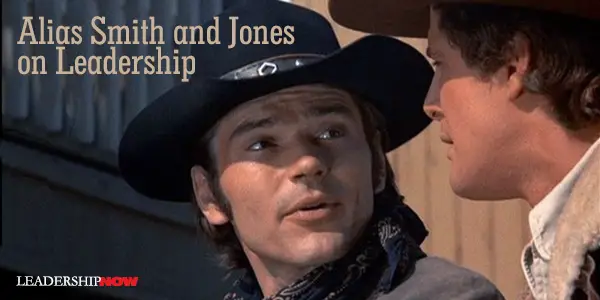
Hannibal Heyes to Kid Curry: “Listen, when the leader of the gang tells him to do something, don’t he have to do it?” Curry: “Yeah, that’s my understandin’.” Kyle (gang member): “But, what makes you such a great leader Hayes is that you never tell no man to do no thing you wouldn’t do yourself.” Heyes to Curry: “You wanna be leader?” Curry: “After you!”
Posted by Michael McKinney at 09:19 AM
05.09.07

Lucky in Leadership "Aside from effective management of politics, there’s a certain amount of luck involved in being a successful leader. I don’t think anybody talks about that, but the truth is, any leader could be pumping gas instead of running a company. Sometimes your best plans go to hell, and you still manage to be the last one standing. We can call that skill or street smarts or panache, but to me we should cut to the chase and acknowledge that it’s pure luck."
Posted by Michael McKinney at 08:59 AM
05.07.07

What It Takes to Lead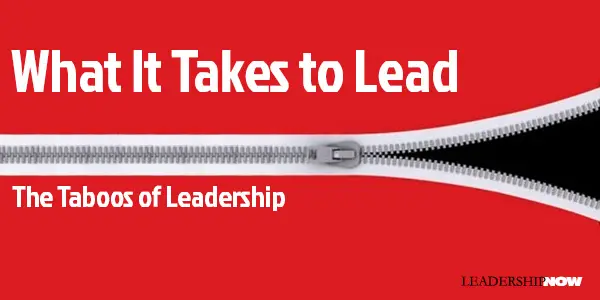
TONY SMITH believes that much of the leadership literature today dances around what it really takes to lead because there are some areas that are politically incorrect or just too difficult to talk about. As a result we have created a “sanitized, air-brushed, or glorified picture of leadership that masks or disguises reality” and we never really get at what leaders do and why they do it. Through his frame of reference, that of executive coach and advocate, he adds great value to our understanding of the realities of leadership even if at times, his conclusions derail when trying to understand leadership at any other level that that of the CEO. In his new book, The Taboos of Leadership his observation that “leaders who are successful never quite fit the theories we apply to them and are always messier and more complex than we would predict” is quite true. It is an aspect that is missing from or far too understated in most leadership literature. Perhaps that explains why international leadership expert Manfred Kets De Vries, wants to put the leader on the couch.Smith writes: There is nothing tidy or clean about leadership. It’s messy, but so is the rest of life. He asks ten taboo-braking questions: What does it take to lead? Does charisma matter? Is being political a bad thing? Do women make better leaders? What about the trappings of power? Should the leader play favorites? Do leader’s really want to groom a successor? Should a leader’s work be their life? Should leaders put aside their own motivations and interests and serve only the motivations and interests of their people? Do leaders cultivate loneliness deliberately? He left out a direct discussion of followers and authority. These are two areas that are misunderstood as often as they are poorly executed. The proliferation of “leaderless organization” literature will attest to that fact. Instead of sugar-coating or dismissing these topics, we should seek a better understanding of these vital and necessary issues. Smith suggests: “Perhaps we should know, or at least recognize, the risk-reward ratio of leadership a little better before we judge our leaders, or decide to become one ourselves.” That point can’t be emphasized enough. 
Posted by Michael McKinney at 12:28 AM
04.30.07

A Pyrrhic Victory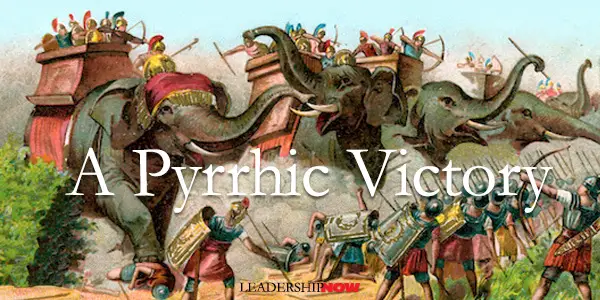
IN 279 BC, 40,000 Romans battled for two days against 40,000 Greeks and their 20 war elephants in the hills of southeastern Italy near Asculum. The Greeks were under the command of King Pyrrhus. According to the great Carthaginian general Hannibal, he was the greatest general the world had seen since Alexander the Great. The first day of battle accomplished little. The two sides fought an indecisive battle. Over the next day, the Romans were forced back, but Pyrrhus was unable to capture their camp. Finally, at the end of the day, seeing the futility of continuing, the armies separated. The Romans had lost 6,000 men and the Greeks 3,500 including many officers. It was a costly victory for Pyrrhus. At dawn the next morning, in response to congratulations for his victory over the Romans, the historian Plutarch relates that Pyrrhus confessed, “one more such victory would utterly undo him.” The battle had been won at too high a cost. Although they never defeated Pyrrhus on the field, the Romans were able to win a war of attrition. Henceforth, no soldier would cheer a Pyrrhic victory. We, too, have battles to fight from time to time. Some battles though can be won at too high a cost. As Pyrrhus admitted, some battles can literally undo us. If we are not careful we can let situations and our ego get the best of us. We can undermine our purpose of serving and lifting up those we lead. Winning an argument can destroy our influence and cost us a relationship. In Pearls of Wisdom, Joyce Brothers wrote, “There is a rule in sailing where the more maneuverable ship should give way to the less maneuverable craft. I think this is sometimes a good rule to follow in human relationships as well.” Relationships are what leadership is all about. As the leader, we are the more maneuverable ship. Being immovable or stubborn, just because we are right, doesn’t move us closer to our goal. It is up to us to step back, bend, or give way and let the other person pass. Later we might try a different tack if it is really that important to make the point. Hitting a difficult person head on is rarely the appropriate action. When we come up against conflict, we must ask ourselves if winning this one is really that important. How will winning affect my ability to work with this person? What is motivating me to win? We don’t need to fight every battle. We should choose battles that in the final analysis will strengthen our relationships and improve our effectiveness.
Posted by Michael McKinney at 09:53 AM
04.08.07

Lee Iacocca’s 9 C's of Leadership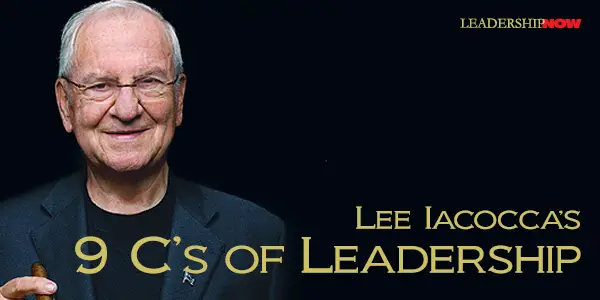 LEE IACOCCA'S polemic,Where Have All the Leaders Gone?, will be released on April 17th. In the meantime you can read chapter one Had Enough? in our Reading Room. Included in chapter one he presents his 9 C's of Leadership you will find briefly illuminated below:
LEE IACOCCA'S polemic,Where Have All the Leaders Gone?, will be released on April 17th. In the meantime you can read chapter one Had Enough? in our Reading Room. Included in chapter one he presents his 9 C's of Leadership you will find briefly illuminated below:
1. A leader has to show CURIOSITY. He has to listen to people outside of the "Yes, sir" crowd in his inner circle. He has to read voraciously because the world is a big, complicated place. If a leader never steps outside his comfort zone to hear different ideas, he grows stale. If he doesn't put his beliefs to the test, how does he know he's right? The inability to listen is a form of arrogance. It means either you think you already know it all, or you just don't care. 2. A leader has to be CREATIVE, go out on a limb, be willing to try something different. You know, think outside the box. Leadership is all about managing change -- whether you're leading a company or leading a country. Things change, and you get creative. You adapt. 3. A leader has to COMMUNICATE. I'm not talking about running off at the mouth or spouting sound bites. I'm talking about facing reality and telling the truth. 4. A leader has to be a person of CHARACTER. That means knowing the difference between right and wrong and having the guts to do the right thing. Abraham Lincoln once said, "If you want to test a man's character, give him power." 5. A leader must have COURAGE. I'm talking about balls. (That even goes for female leaders.) Swagger isn't courage. Tough talk isn't courage. Courage is a commitment to sit down at the negotiating table and talk. 6. To be a leader you've got to have CONVICTION -- a fire in your belly. You've got to have passion. You've got to really want to get something done. 7. A leader should have CHARISMA. I'm not talking about being flashy. Charisma is the quality that makes people want to follow you. It's the ability to inspire. People follow a leader because they trust him. That's my definition of charisma. 8. A leader has to be COMPETENT. That seems obvious, doesn't it? You've got to know what you're doing. More important than that, you've got to surround yourself with people who know what they're doing. 9. You can't be a leader if you don't have COMMON SENSE. THE BIGGEST C IS CRISIS. Leaders are made, not born. Leadership is forged in times of crisis. 
Posted by Michael McKinney at 01:46 PM
04.04.07

Tyranny of the Urgent
IT IS EASY to succumb to the tyranny of the urgent. There is always something competing for our attention. Worse still, we might find we have to deal with what Michael Watkins calls pyromaniacs—those people like to create fires for you to put out. The only way out is to get some perspective. In White Hat Leadership, author Ty Warren writes about the importance of making time to disengage: Part of preparing to lead is recognizing when to step away to recharge. Most of us have experienced the benefits of taking time away from the office (or family) for a few days, then returning with new energy and a better perspective. The urgent will always be with us. How we handle it will determine how effective we are. Once we begin to let the urgent take over the important we loose perspective and get sucked into a cycle that perpetuates the problem and drains us. Without direction, we mistakenly find ourselves trying to compensate by going twice as fast. We must take time out to think. The perspective you gain will help you to handle everything you do better. Are you part of the problem? Do you create fires for others to put out? Take the “Are you a pyromaniac?” quiz.
Posted by Michael McKinney at 04:51 PM
03.30.07

I appreciated Umpqua president and CEO Ray Davis' comment in his book, Leading for Growth concerning the true function of a leader:
|
|||||||||||||||||||||||||||||||||||||||||||||||||||||||||||||||||||||||||||||||||||||||||||||||||||||||||||||||
|
September 11th is a tragedy that struck all of us. It caused us to look deeper inside ourselves to see what we had and what we lacked. As any crisis reveals, leadership is something that is built over time and not something you dream up on a moments notice. A lot of character was revealed and developed that day.
|
Posted by Michael McKinney at 10:35 AM
Permalink
| Comments (0)
| Leadership
, NewsWire

Of course, we know that all living languages change. They must to survive. Language never is what it was in the good old days. The real question is what constitutes change and what is decay.Interestingly enough over on the Christianity Today Blog they have been debating for months as to whether a young poet should have been allowed to use the F-word throughout the public recitation of her poem at church. Oddly, the debate is all over the place. I know the poet’s pastor thought that he was being caring, loving and accepting, but in the end he failed her. He was disrespectful to the young girl by allowing her to recite the poem with all of its profanity intact.
There is abundant evidence that the American people are growing more worried about language decay—an increase in casual profanity, rudeness and incivility in our expression.
The Associated Press reported recently that three-fourths of Americans say they encounter profanity in public either occasionally or frequently, and a majority agreed they encounter it noticeably more often than 20 years ago.
Words that once were shocking to hear in public now are heard commonly on television and radio, in music and movies, at work and on the street.
Are we on an irreversible downward slope?

Posted by Michael McKinney at 10:23 AM
Permalink
| Comments (0)
| Leadership

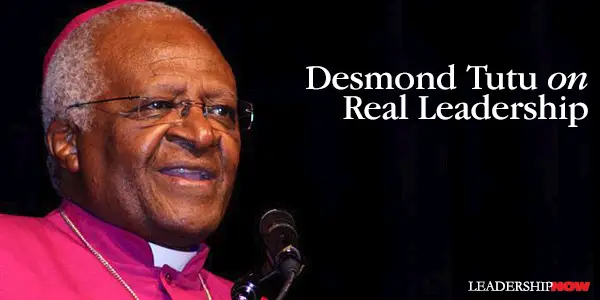
Desmond Tutu, South African cleric and recipient of the 1984 Nobel Peace Prize, gave a speech recently at the Harold Wolpe Memorial Lecture in Cape Town. Here are some of his edited comments from that speech on Real Leadership:
I thought it might not be entirely inappropriate to talk about leadership—true, real leadership.
There is an episode in the Christian Gospels when the disciples of Jesus were bickering about leadership positions. So Jesus called them together to give them a profound lesson on true greatness real leadership, and it turned out to be one of the most paradoxical statements ever. Just listen:
"And when the other ten apostles heard it, they began to be indignant with James and John. But Jesus called them to Him and said to them. You know that those who are recognized as governing and are supposed to rule the Gentiles lord it over them, and their great men exercise authority and dominion over them. But this is not to be so among you; instead, whoever desires to be great among you must be your servant. And whoever wishes to be most important and first in rank among you must be slave of all. For even the Son of Man came not to have service rendered to Him, but to serve, and to give His life as a ransom for many." (Mark 10: 41-50)
Now, what kind of advice is that? Totally unrealistic, sentimental, and utopian. They would make mincemeat of you in a hard-nosed cynical world where it is dog-eat dog, survival of the fittest, and devil take the hindmost, and everyone for himself in a setting of cutthroat competition. But is that kind of success really what people, in fact, admire, indeed revere?
The leader is there for the sake of the led. The formula Jesus propounded clearly was not so utopian and unrealistic. Almost all who have become outstanding leaders have demonstrated this remarkable attribute of selfless altruism. The leader is there not for what he/she can get out of this exalted position. No, the real, the true leader knows the position is to enable the leader to serve those she leads. It is not an opportunity for self-aggrandizement, but for service of the led.
Integrity: People look up to their leaders for inspiration; they somehow believe they embody their best ideals, attributes, and characteristics. This is how they want to believe they would be at their best.
They want their leaders in a way to be a Colossus without blemish, a paragon of virtue, of impeccable moral standards, not an idol with feet of clay.
There surely is conduct which might be tolerated in a lesser mortal, but that would be anathema in the Head of State. We speak of gravitas, of in our language shadow, isthunzi, a presence. We want to experience our head of state as being presidential. He/she is not an ordinary person.
Humility: Almost paradoxically, we also are attracted to a head of state who is humble and approachable, not arrogant and aloof.
People want their leader, as it were, to have charisma, to be regal and exalted, dignified, almost godlike as expressing the best about their idealized corporate consciousness and identity. But they also want them to be people of flesh and blood, not remote, but down to earth in touch with them, aware of their aspirations, anguish, needs and know where the shoe pinches.
No human being is infallible: Most politicians seem to have a massive allergy to admitting they might have been wrong. I suspect most of us find humble pie unappetizing. We do not like to admit that we made a mistake. It is our peculiar hubris.
A leader leads by leading: A true leader whilst eager to carry his constituency with him whenever possible, sometimes has to take a stand that is not too popular with his followers. But the real leader then demonstrates his mettle by leading through leading. It requires courage to do this, but the leader recalls that the tortoise makes progress only when it sticks its neck out. Leadership can be a lonely vocation.
Bishop Charles Albertyn used to tell us this story, In this establishment, there are only two rules. Rule No. 1 - The boss is always right. Rule no. 2, in case the boss is wrong, refer to rule No. 1. It may seem as if the kind of leader who uses this style is always in charge, things happen, everybody dances attention. But in fact, it is self-defeating. It allows resentment and anger to build up in those who have been humiliated by the apparently decisive boss and then one day even the worm will turn.
![]()
Posted by Michael McKinney at 02:09 AM
Permalink
| Comments (0)
| Leaders
, Leadership

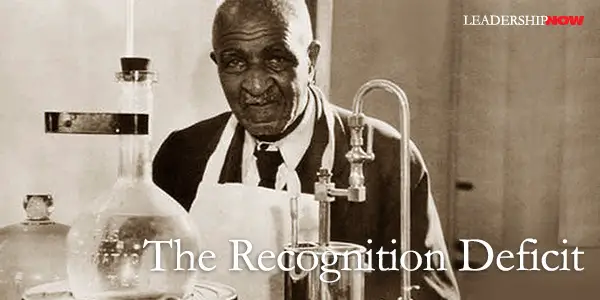
GEORGE WASHINGTON CARVER wrote, "How far you go in life depends on your being tender with the young, compassionate with the aged, sympathetic with the striving, and tolerant of the weak and the strong. Because someday in life you will have been all of these."
Understanding and encouragement will take people further than almost anything else you can do for them. Followers want recognition for their contribution. It is one of those things that have incredible leverage. The small investment on your part is greatly exceeded by the impact it has on someone’s life. Not only in that person’s life but the lives of those they come into contact with. It has a rippling effect.
Considering its value, it’s amazing how little it is done. Frankly, if it were considered more of a priority in the leader’s agenda it would happen more. Yet without it, any leader’s effectiveness is diminished. It has to become an integral part of what we do. In Why Should Anyone Be Led by You? the authors comment:
There are some particularly aggressive corporate cultures where the imperative is to “just do it.” Recognition is for wimps. All our experience is that effective leaders find ways to break through those barriers.
During his long tenure as CEO and chairman of GE, Jack Welch was well known for his handwritten notes. [D]espite his colossal workload, Welch made the time to jot down a few well-chosen words of recognition. He knew how important it was. The great thing about a handwritten note, of course, is that it is both highly personalized and lasting.
Do you make people feel that their contribution is important? That they personally matter to the goals of the organization? It is what will make your efforts more effective.
Everyone is in need of encouragement. Actress Celeste Holm summed up the issue well, “We live by encouragement and we die without it; slowly, sadly, angrily.”

Posted by Michael McKinney at 10:26 AM
Permalink
| Comments (0)
| Leadership

"There are many people who think they want to be matadors, only to find themselves in the ring with two thousand pounds of bull bearing down on them, and then discover that what they really wanted was to wear tight pants and hear the crowd roar."If, however, you do make the choice to leap into the ring, it's because of your love of the challenge, the adventure, and that love is what makes the fear of the "sport" worthwhile. Not only do you accept the fear as part of the experience, the fear—in large part—creates and defines the experience. Extreme would not be extreme without fear. And fear would not be worth it without the love of the game.

Posted by Michael McKinney at 08:32 AM
Permalink
| Comments (0)
| Leadership


Posted by Michael McKinney at 04:48 AM
Permalink
| Comments (0)
| Leadership

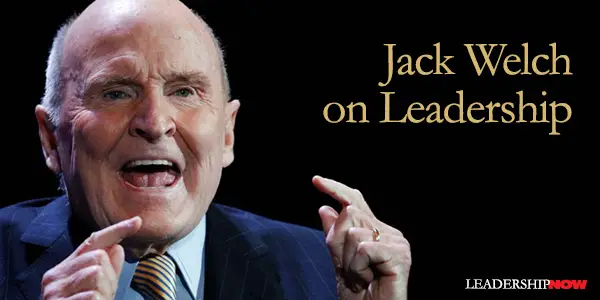
JACK WELCH revealed some lessons on leadership in a keynote address to the executives at the FranklinCovey Symposium in Dallas. Here is a recap as presented by Training Magazine:
"Great leadership development is the heart and soul of every company. Now more than ever, companies shouldn’t be afraid to take risks by promoting tomorrow’s leaders into these roles today. It’s wonderful to have an organization that is dynamic and changing and getting fresh blood into management positions. Fresh eyes sometimes see fresh opportunities. Will they be ready? Maybe they won’t all be trained perfectly, but they will be able to grow into their job if you give them the right support systems. When I left GE, my successor was 46 years old, and his direct reports averaged 38 years old. That’s great stuff.
One thing that is key to remember is that leadership is inclusive, not exclusive. When you have a problem, I think you need to engage as many people as you possibly can into solving the problem.
The idea that there’s just one right view is absolutely crazy. When you’ve got a crisis, you’ve got to reach every level of your organization and find every place where knowledge may live. It’s part of what I called a “role-model atmosphere” at GE.
Leadership is not about dictating, it’s about empowering employees so that they recognize their ability to take action. And highlight it when they do. When somebody had a great idea at GE, we’d fly that person in to showcase the idea. You should always be showcasing your people’s great ideas. That’s part of a role model atmosphere and it works. People need to feel that their contributions are important. Always give them voice and dignity. That’s what leaders do. And that’s how leaders build leaders. But implementing that and making that real is a lot harder than just saying it.

![]()
Posted by Michael McKinney at 10:42 PM
Permalink
| Comments (0)
| Leadership


| New Rules | vs. | Old Rules | |
|---|---|---|---|
| 1 | Agile is best; being big can bite you. | Big dogs own the street. | |
| 2 | Find a niche, create something new. | Be No. 1 or No. 2 in your market. | |
| 3 | The customer is king. | Shareholders rule. | |
| 4 | Look out, not in. | Be lean and mean. | |
| 5 | Hire passionate people. | Rank your players; go with the A's. | |
| 6 | Hire a courageous CEO. | Hire a charismatic CEO. | |
| 7 | Admire my soul. | Admire my might. |
Posted by Michael McKinney at 09:32 PM
Permalink
| Comments (0)
| Leadership

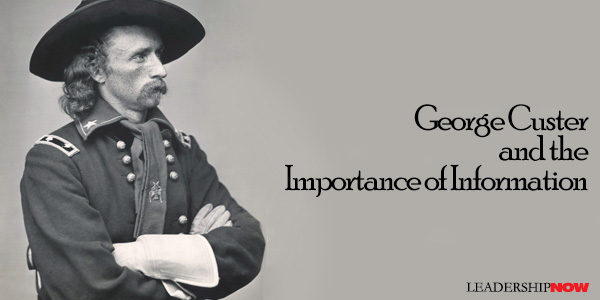
ONE-HUNDRED Thirty years ago on June 25, 1876 on the banks of the Little Big Horn River, the Battle of the Little Big Horn also known as Custer's Last Stand took place. It was reported that on the banks of the Little Big Horn River was the largest concentration of Indians from six tribes that history has ever recorded. It has been estimated that there were anywhere between ten to fifteen thousand Indians with over 2,500 warriors. Custer was in no position to pick a fight. Sadly, he decided to ignore that information.
Leaders live and die on good information. Getting it is only half the battle. The other half is listening to it. Far too many leaders find themselves talking when they should be listening. Paying attention to information is especially important when it suggests that things are not what they seem to be. Custer's pride, unfortunately, cost him and those around him their lives.

Posted by Michael McKinney at 03:47 PM
Permalink
| Comments (0)
| Leaders
, Leadership


It's clear from the footage why some teams succeed and others struggle. Wilson only studied teams that completed the race, but even among finishers the differences are stark. On the top squads, every team member participates in decision-making, and everyone takes a leadership role at some point in the race. On the lower-performing teams, by contrast, one person often dominates discussions. "It's very, very clear in the interaction patterns how these top teams are so successful," Wilson says.Below are several of the 10 leadership skills of an endurance racer that Ms. Clark lists in her article:
Many adventure racers assume that Adamson's charismatic leadership is the key to Nike's success. In fact, when Wilson shows his students a video clip of Nike, they struggle to identify the team's leader. Teammates Danielle Ballengee, Mike Kloser and Tobin all share the role. A charismatic leader can actually hurt an adventure racing team, Adamson says, by convincing his teammates to do something they don't want to do.
In high-pressure situations, however, multiple people often need to assume leadership roles. If there's only one leader, he or she is bound to get tired, says [Rich] Brazeau, Primal Quest's CEO, who also participates in adventure races.
Posted by Michael McKinney at 09:40 AM
Permalink
| Comments (0)
| Leadership

Posted by Michael McKinney at 12:02 PM
Permalink
| Comments (0)
| Leadership


But there's more to it. "That's the way the system works." It's a strange thing for a man to say who has been convicted of 19 separate criminal charges. Reduced to words on a page, you can imagine the tone to be bitter or accusing. But it's not. Nor is it gallows humor, a tip of the hat to the prosecutors who won their case, but something more poignant.It’s easy to blame the system, but the system isn’t something outside ourselves, some vast unseen force putting pressure on us to do things we don’t want to do. We are the system. It works that way because we work that way. It won’t change until we do. Adding more laws can’t protect us from ourselves. What is lacking here is character and the integrity to maintain right principles even at a personal loss. Gimein continues and address the spirit of the law:
It is a supremely characteristic statement, and it evokes the essence of what went wrong at Enron. Skilling had a startling confidence in what he thought of as "the system," a strange and even endearing belief in the mechanisms -- the letter and only the letter -- of the law.
But what made Enron possible was not a lack of rules. It was an unwillingness to think about regulation and responsibility in any but the most legalistic terms.The Skilling Trap is that trap you fall into when you don’t see beyond the letter of the law. Sadly most laws are in place because we substitute what’s legal for what’s ethical. They are not the same. It’s a tug of war we have all experienced. Ethical addresses what should I do. Legal is about what do I have to do. If legal is the only consideration then caution is the watchword. Ethics is about principles and responsibilities.
[T]here's little question that the source of all the crimes of which he was convicted was the basic dishonesty of trying to keep the company's stock afloat so he could make more money.
No question, the parade of executives in handcuffs will have some deterrent effect. But the evidence that any of this will make executives more accountable and more honest rather than just more careful is thin. Contemporary business culture accepts outsized compensation as a given and takes for granted the notion that chief executives have no special responsibilities more pressing than ensuring a fabulously wealthy retirement. In such a culture it's certain that when the market next crests and crashes, hundreds of corporate executives will at least toy with ways to make the numbers look good until they can get their own money out. After Enron, those who go that route will be more cautious in interpreting the law. Can that prevent the next wave of scandals? No, because no reading of securities law is so careful that it avoids the Skilling trap: When you try to keep to the letter of the law while undermining the spirit, you are likely to violate the letter in the end.
Posted by Michael McKinney at 10:06 AM
Permalink
| Comments (0)
| Ethics
, Leadership

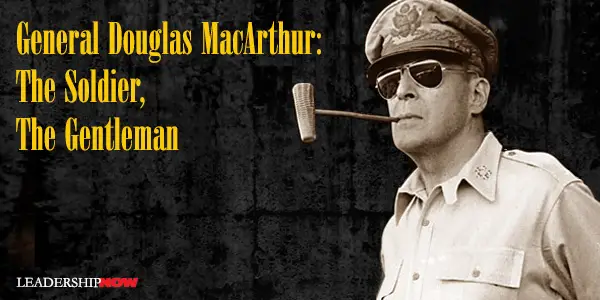

Of all his traits, Ganoe believes “the one that made the greatest impact was his unwavering aplomb, his astonishing self-mastery. I had seen men who were so placid or stolid they were emotionless. But MacArthur was anything but that. His every tone, look or movement was the extreme of intense vivacity. . . . As he talked, so he walked jauntily, without swagger. His gait and expression were carefree without being careless.” He possessed “a gifted leadership, a leadership that kept you at a respectful distance, yet at the same time took you in as an esteemed member of his team, and very quickly had you working harder than you had ever worked before in your life, just because of the loyalty, admiration and respect in which you held him. Obedience is something a leader can command, but loyalty is something, an indefinable something, that he is obliged to win. MacArthur knew instinctively how to win it.” He was, the adjutant concludes, “all contradiction. He commanded without commanding. He was both a patrician and plebeian. I could close my eyes and see him in his toga, imperiously mounting his chariot, and the next minute clad in homespun, sitting on the narrow sidewalk of Pompeii and chatting informally with a slave.”
But the toga fitted him best. “To him the word gentleman held a religious meaning. It was sacredly higher than any title, station, or act of Congress. It was an attitude of life to be cherished in every gesture and spoken word. It comprehended and excused no letdown in its execution. . . . Flying off the handle, berating or bawling out were cardinal sins, which I not once saw him give way to. In times of stress or stinging irritation, his voice grew low, falling to a deep bass and intoning, with a control so strong, it held motionless everyone within its sound.”
Posted by Michael McKinney at 12:20 AM
Permalink
| Comments (0)
| Leaders
, Leadership


The tragedy for those who value their reading time, is that Rousseau and Shakespeare said it all much, much better. In the 5,200 years since the Sumerians first etched their pictograms on clay tablets, come to think of it, human beings have produced an astonishing wealth of creative expression on the topics of reason, passion, and living with other people. In books, poems, plays, music, works of art, and plain old graffiti, they have explored what it means to struggle against adversity, to apply their extraordinary faculty of reason to the world, and to confront the naked truth about what motivates their fellow human animals. These works are every bit as relevant to the dilemmas faced by managers in their quest to make the world a more productive place as any of the management literature.All leadership issues are human. Leadership is not a science. It is an art. This idea of the NEW leadership is nonsense. Contexts change and will continue to change but leadership principles are constant. Leadership is about people and relationships. People have had to deal with the same issues since time began. Leadership deals with philosophical issues in ever changing contexts. While certain generalities can be made (reduced to percentages if you must) most leadership issues must be viewed more individually than generally, more philosophically than scientifically. Having laws that govern something doesn't make it a science.
Beyond building skills, business training must be about values . . . But, as anyone who has studied Aristotle will know, “values” aren’t something you bump into from time to time during the course of a business career. All of business is about values, all of the time. Notwithstanding the ostentatious use of stopwatches, Taylor’s pig iron case was not a description of some aspect of physical reality—how many tons can a worker lift? It was a prescription—how many tons should a worker lift? The real issue at stake in Mayo’s telephone factory was not factual—how can we best establish a sense of teamwork? It was moral—how much of a worker’s sense of identity and well-being does a business have a right to harness for its purposes?
Posted by Michael McKinney at 12:52 AM
Permalink
| Comments (0)
| Leadership

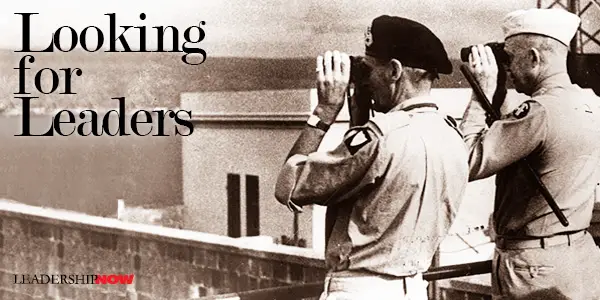
This is a long tough road we have to travel. The men that can do things are going to be sought out just as surely as the sun rises in the morning.In a letter to a friend and fellow commander Vernon E. Prichard, Ike took up the theme of leadership he had discussed in his letter to Scrappy Hartle just two days earlier. “Fake reputations,” he wrote, “habits of glib and clever speech, and glittering surface performance are going to be discovered and kicked overboard.” Those who remain are people capable of “solid, sound leadership,” possessed of “inexhaustible nervous energy to spur on the efforts of lesser men, and iron-clad determination to face discouragement, risk and increasing work without flinching.” Those who remain are the people who also possess “ a darned strong tinge of imagination—I am continuously astounded by the utter lack of imaginative thinking among so many of our people that have reputations for being really good officers.” Finally, those who escape being kicked overboard are those who are most dedicated and “able to forget . . . personal fortunes. I’ve relived two seniors here because they got to worrying about ‘injustice, ‘ ‘unfairness,’ prestige.’”—Letter to Vernon E. Prichard
August 27, 1942
Posted by Michael McKinney at 09:51 AM
Permalink
| Comments (0)
| Books
, Leadership
, Leadership Development

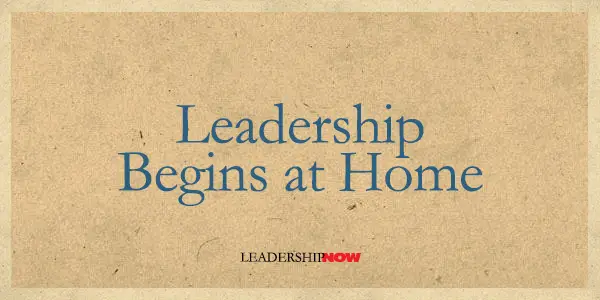

I tell young people, "It feels good to be a leader!" Success and failure are part of the adventure of life. Young people need to see that good leaders are important in their community—and there are great rewards for being a good leader. Those rewards include a sense of satisfaction and a feeling that what you are doing is meaningful and significant. You don’t always win when you lead, but that’s okay. Young people should be rewarded and encouraged for stepping up and leading, no matter whether they succeed or fail.Krog added some additional thoughts that apply in any leadership training. “What is negatively affecting leadership across the country is the use of polls to gauge public opinion. Good leadership takes a longer-term view of issues that may or may not be popular. Polls force governments to make popular, short-term decisions to stay in power. And sometimes leadership involves championing ideas that are not so popular.”


Posted by Michael McKinney at 12:08 AM
Permalink
| Comments (0)
| TrackBacks (1) | Leadership
, Leadership Development

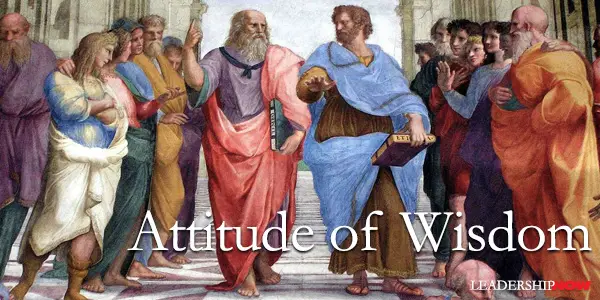
AMERICAN essayist Norman Cousins wrote, “Wisdom consists of the anticipation of consequences.” Wisdom is about the thinking through of thoughts, behaviors and actions and seeing their relationships. It is seeing how things are connected. It is easy to get so caught up in what we are doing that we operate as though we are in a vacuum. Yale University professor Robert Sternberg explained that one reason smart people are sometimes inexplicably stupid is that they think they have overcome the problem of consequences.
Understanding how everything is connected is a daunting task, but it shouldn’t cause us to stop dead in our tracks full of indecision. We still have to function. Professors Pfeffer and Sutton suggest in their book Hard Facts, that we must travel through life with an attitude of wisdom. That attitude is described as the ability to act with knowledge while doubting what you know. They point out that this attitude or approach is the single most important quality that a leader, advisor, or team can have for practicing evidence-based management.
This attitude enables people to act on what they already know while at the same time doubting what they know. It means they can do things now, as well as keep learning along the way. It implies a certain degree of humility to make it work. You really have to be able to get out of your own way. Professor Karl Weick said, “Argue like you’re right, but listen as if you’re wrong.” From Hard Facts:
Practicing evidence-based management means adopting beliefs and designing settings that enable people to keep acting with knowledge while doubting what they know, and to openly acknowledge the imperfections in even their best ideas along the way.
A lot of experience often holds people back from adapting this attitude. An old example holds true here: A person may say, “I have 20 years of experience.” But it’s not 20 years of experience. It’s 1 year repeated 20 times. That is to say, we live our lives in such a way that we aren’t really learning. We’re repeating. While wisdom requires that we arrange what we observe and know, and create meaning from it, it also requires that we consider what we need to unlearn as well.
![]()
Posted by Michael McKinney at 12:27 AM
Permalink
| Comments (0)
| Leadership
, Thinking


"You have got many great hazards, and one of them is in this White House. I have been watching this thing a long time. I have seen people in the White House try to build a fence around the White House and keep the very people away from the President that he should see. That is one of your hazards. The special interests and the sycophants will stand in the rain a week to see you and will treat you like a king. They'll come sliding in and tell you, you're the greatest man alive—but you know and I know you ain't."
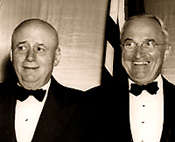
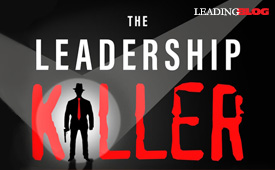

Posted by Michael McKinney at 12:37 AM
Permalink
| Comments (0)
| Leadership


 WE often equate the telling of the truth with the statement made by Jack Nicholson's character in the film A Few Good Men: “You can’t handle the truth!” It’s true. People don't often want to hear the truth. The problem is that as a general rule, the truth is not communicated in a way that is productive and helpful, kind and supportive. It usually comes across as an attack.
WE often equate the telling of the truth with the statement made by Jack Nicholson's character in the film A Few Good Men: “You can’t handle the truth!” It’s true. People don't often want to hear the truth. The problem is that as a general rule, the truth is not communicated in a way that is productive and helpful, kind and supportive. It usually comes across as an attack.
In The Managerial Moment of Truth, authors Bruce Bodaken and Robert Fritz claim that “truth is one of the most important competitive advantages there is in building a business.” It’s vital for creating an organization of learning individuals. Knowing what’s going on in reality gives organizations a better chance of success. “Without perceiving reality, it is next to impossible to succeed because invariably decisions are made in a vacuum.”
The phrase managerial moment of truth refers to that moment when the leader has the choice to ignore or call attention to something that has occurred. They observe, “Too often, managers think they have only one of two unpleasant choices: to have a contentious confrontation or to avoid addressing the situation. Whichever path they choose, real or lasting change rarely happens.”
They caution that telling the truth isn’t the same as “spouting our opinions or sharing our feelings. Groups that really tell each other the truth are the ones that ask each other questions, seriously seek to understand opinions that are different than their own.”
The authors developed a practical procedure that has been used successfully at Blue Shield of California where Bodaken is Chairman, President and CEO. It's a way of telling the truth and getting to the bottom of an issue without hurting people. The technique has four steps:
1. Acknowledge the Truth — Entails the awareness that there is a difference between what you expected and what was delivered and the decision to do something about it.
2. Analyze How it Got to be that Way
3. Create an Action Plan
4. Establish a Feedback System
The idea is to deal with these moments while they are small issues and before there is a need for a full-blown confrontation. Truth telling is a powerful agent of change. This system gives people the best chance to learn in a positive and safe environment. In the end facing reality is a lot easier than all the fancy footwork required in avoiding it.
Great leaders are also great mentors. Greatness is hard to achieve without a substantial amount of learning built into the fabric of the organization. Mentorship is the most direct path to learning because it is done within the context of real work set against the realities of the world.

Posted by Michael McKinney at 12:19 AM
Permalink
| Comments (0)
| Books
, Leadership

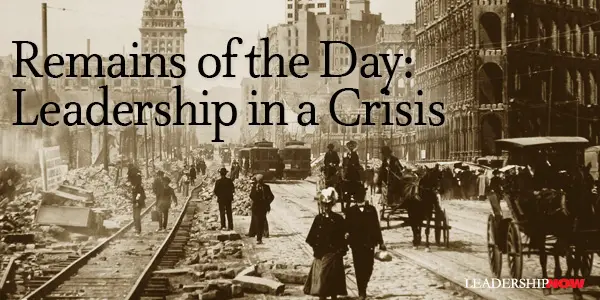


![]()
Posted by Michael McKinney at 12:16 AM
Permalink
| Comments (0)
| Leadership

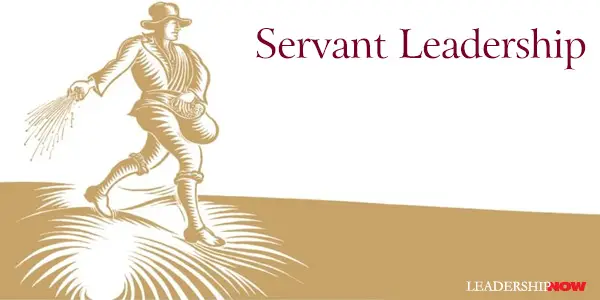
IN Peter Temes' remarkable book, The Power of Purpose, he gets to a fundamental point of servant leadership right from the get-go. He writes:
Imagine the man or woman who looks at the world and understands, this is when I should push, here is the opportunity to reshape the world in some small way, and knows too when to say, here is when I must step back, here is when my desire has to yield to patience. The real power lies in being able to see both visions.
He’s writing about the balance between ambition on one hand and humility and patience on the other. Being able to read a situation is fundamental to this balance and it comes from having both self-knowledge and a quality best described as mindfulness. This is the essence of servant leadership; an outward focus.
(By the way, if you are interested in looking into the topic of mindfulness, Mindfulness by Harvard professor Ellen J. Langer is well worth your time.)

![]()
Posted by Michael McKinney at 09:30 AM
Permalink
| Comments (0)
| TrackBacks (1) | Books
, Leadership





